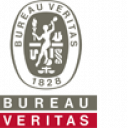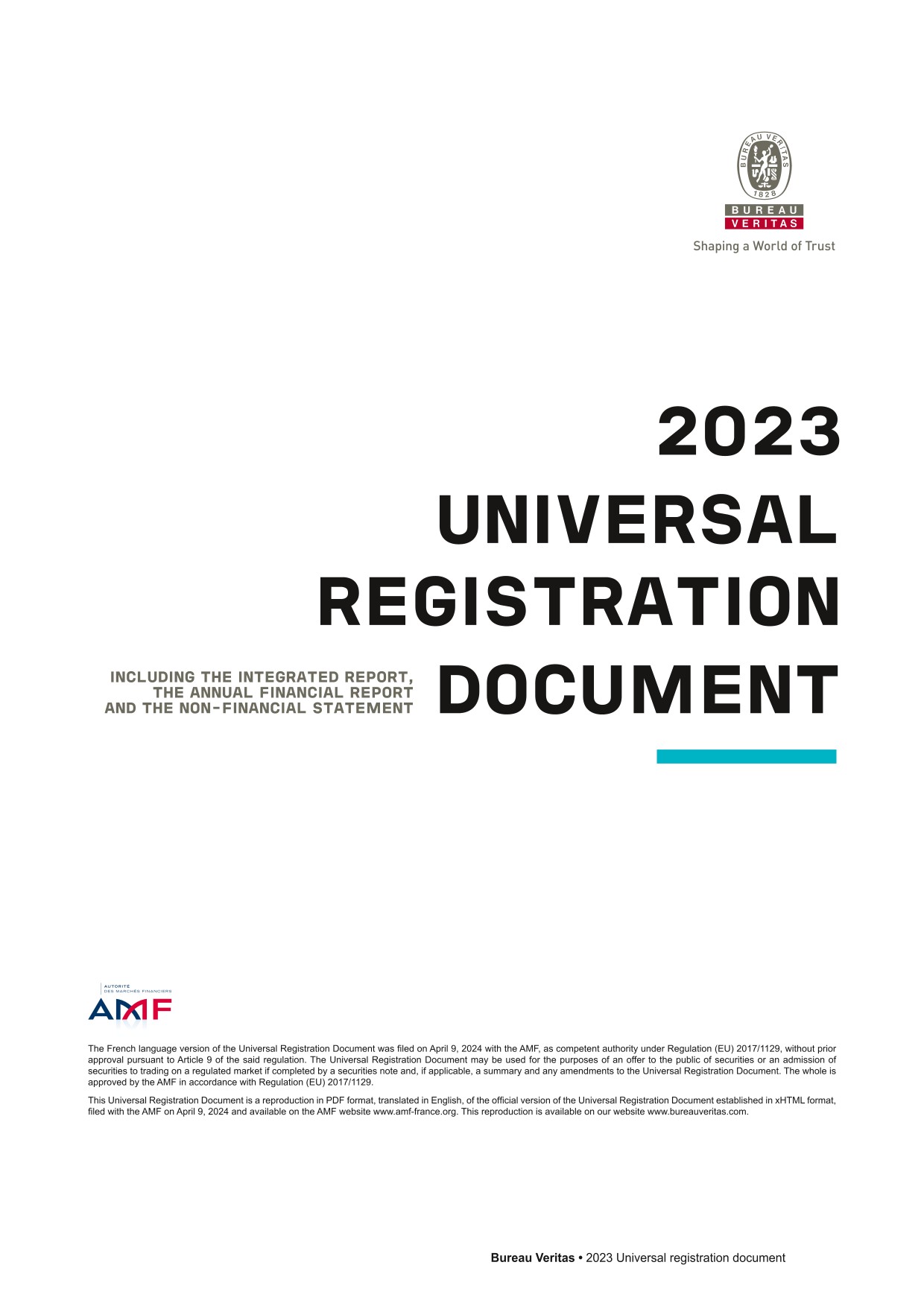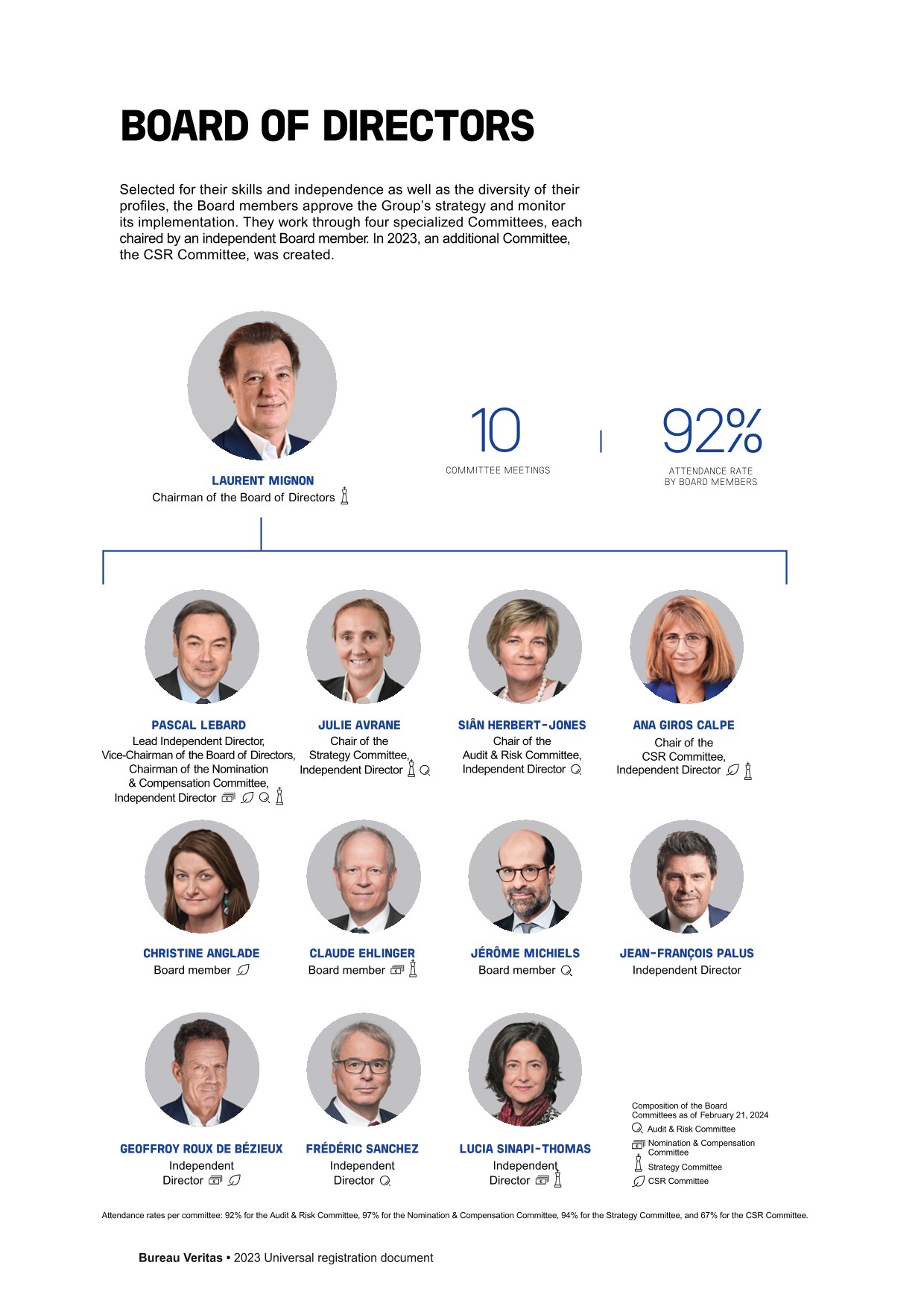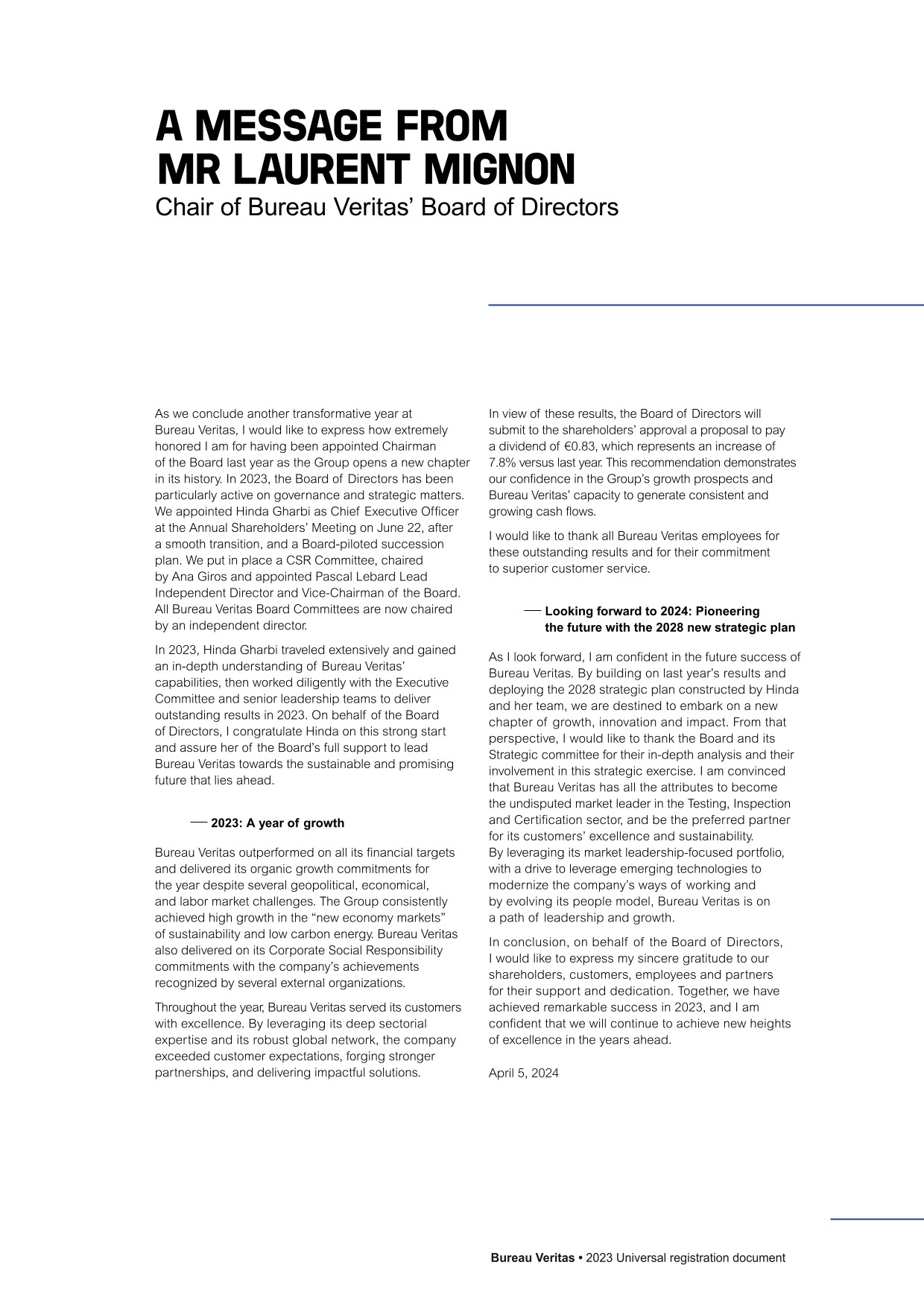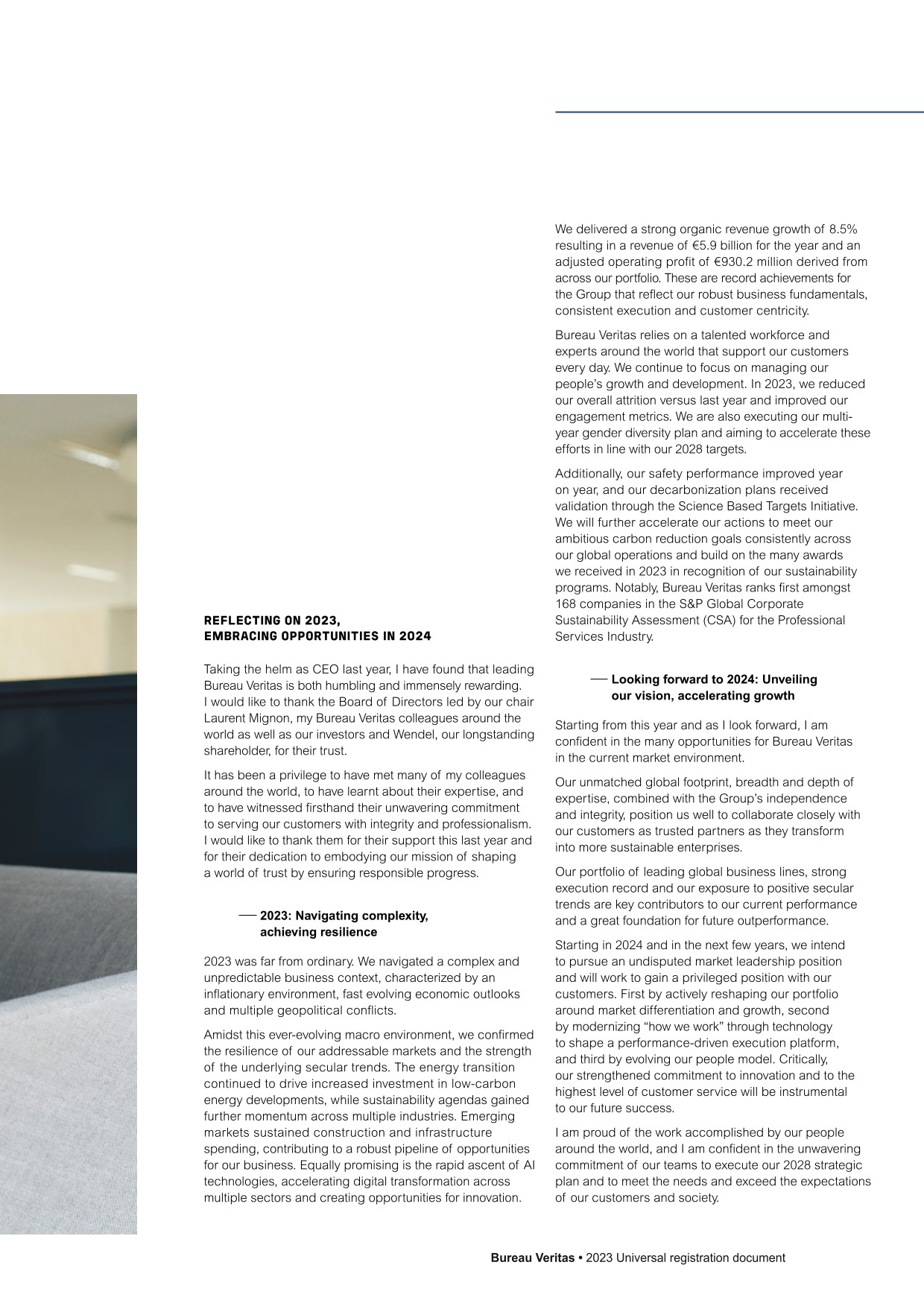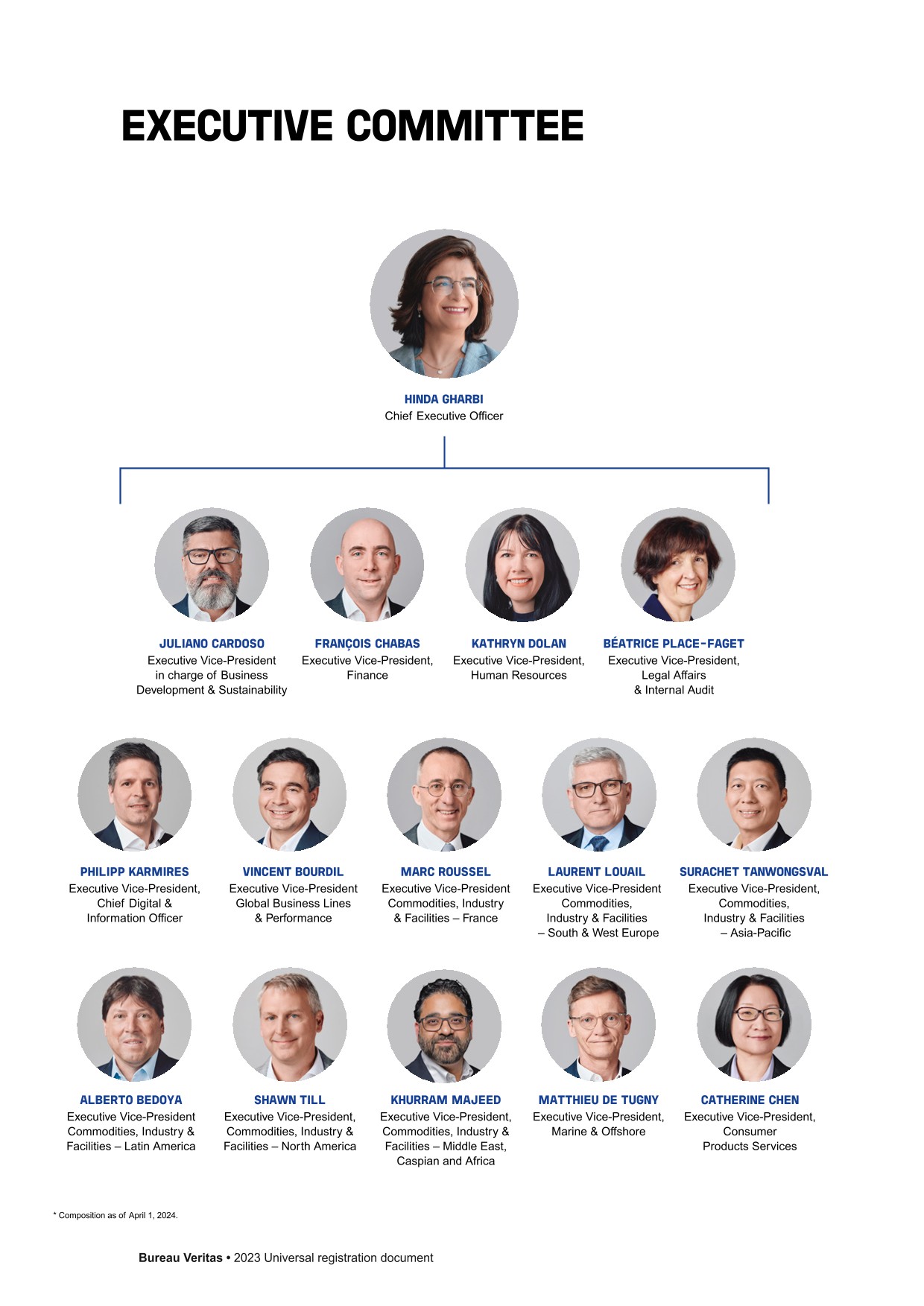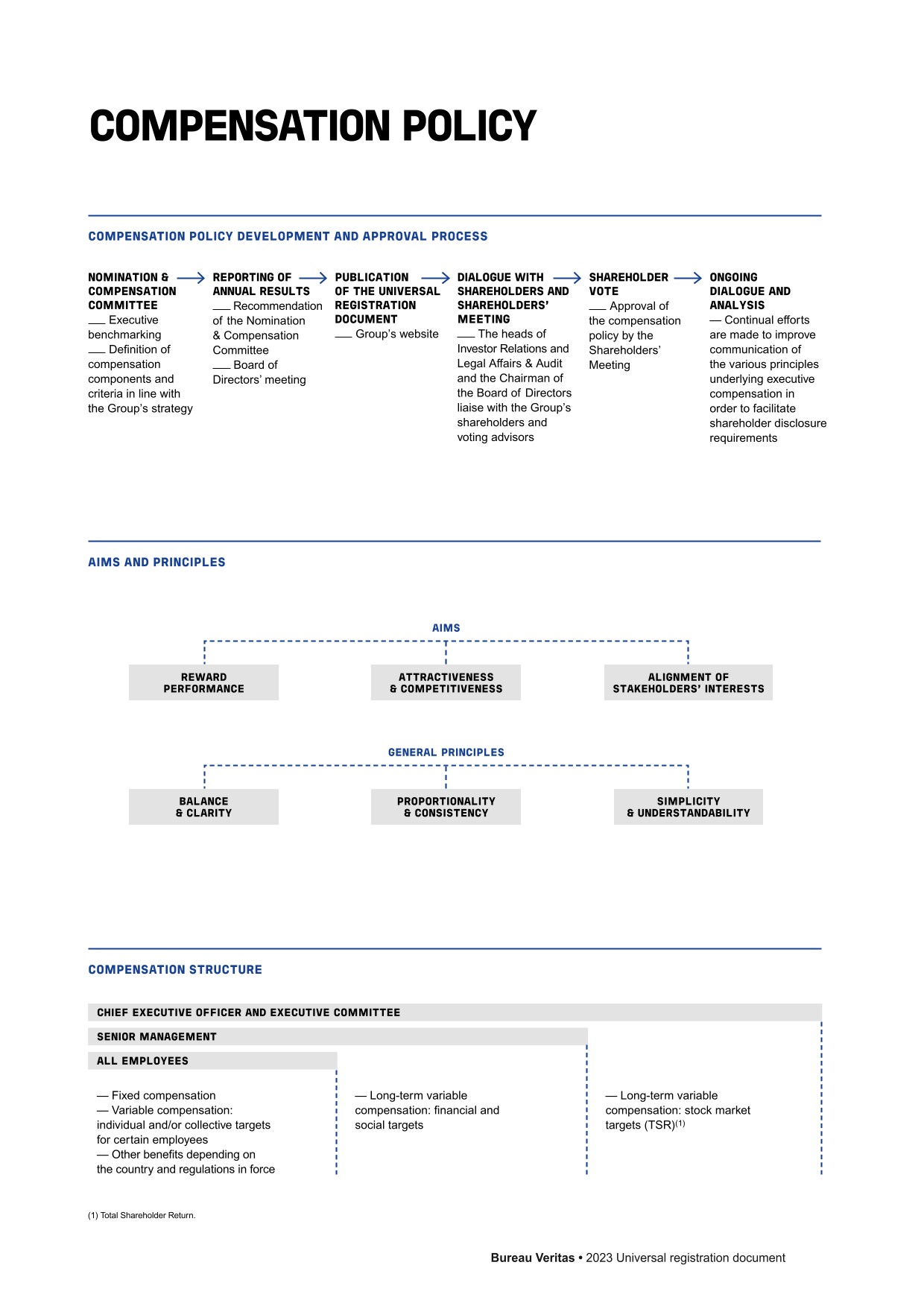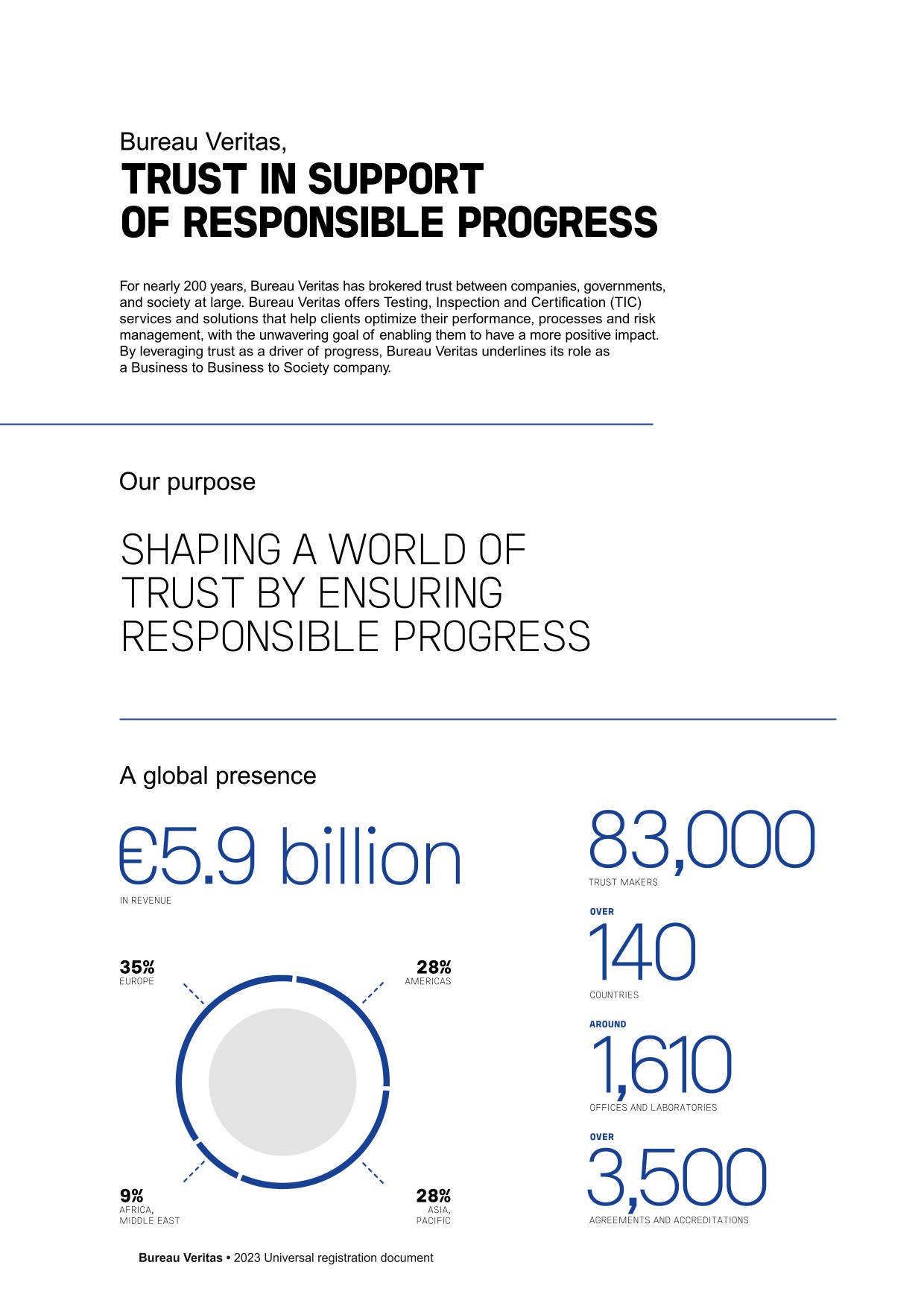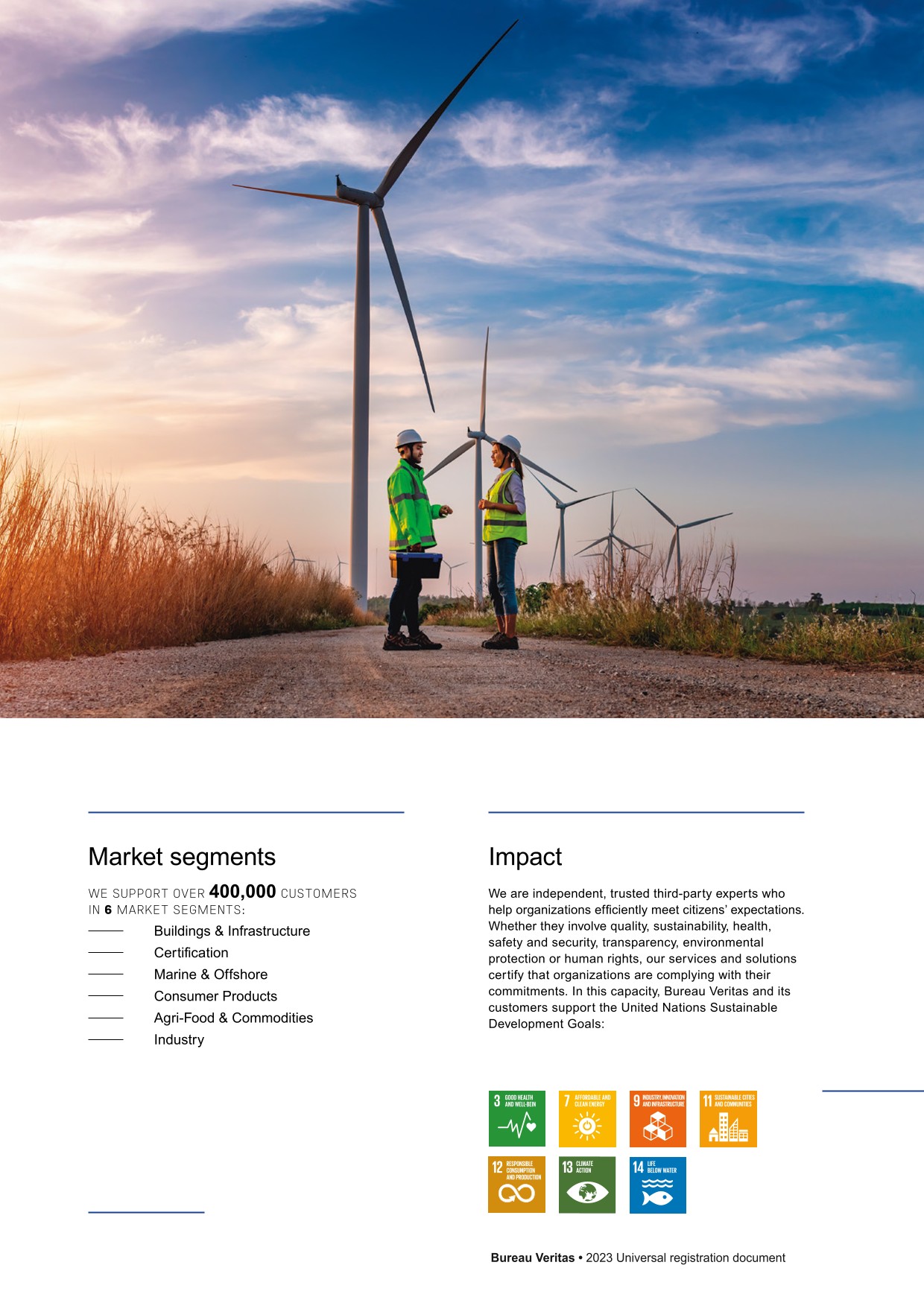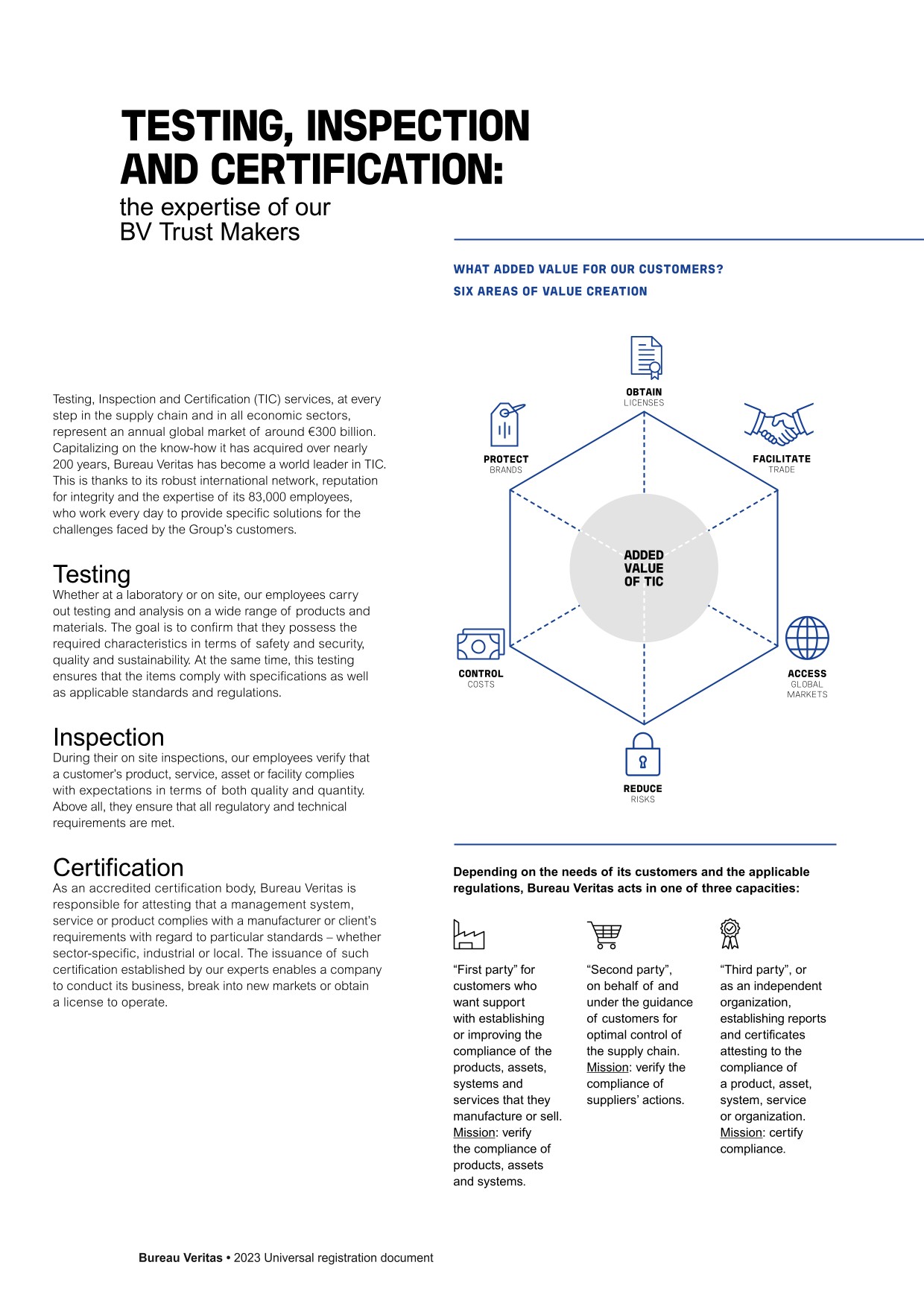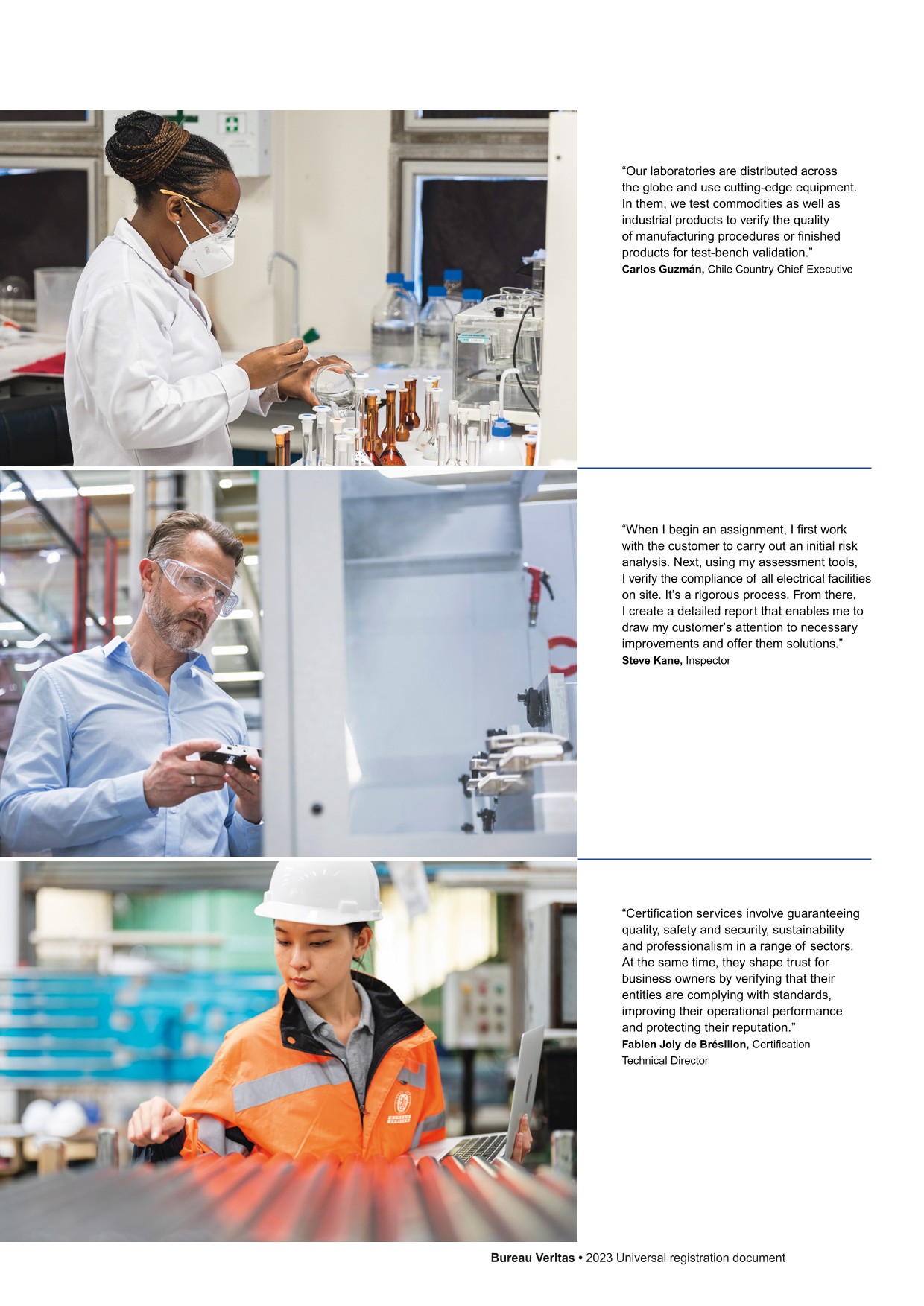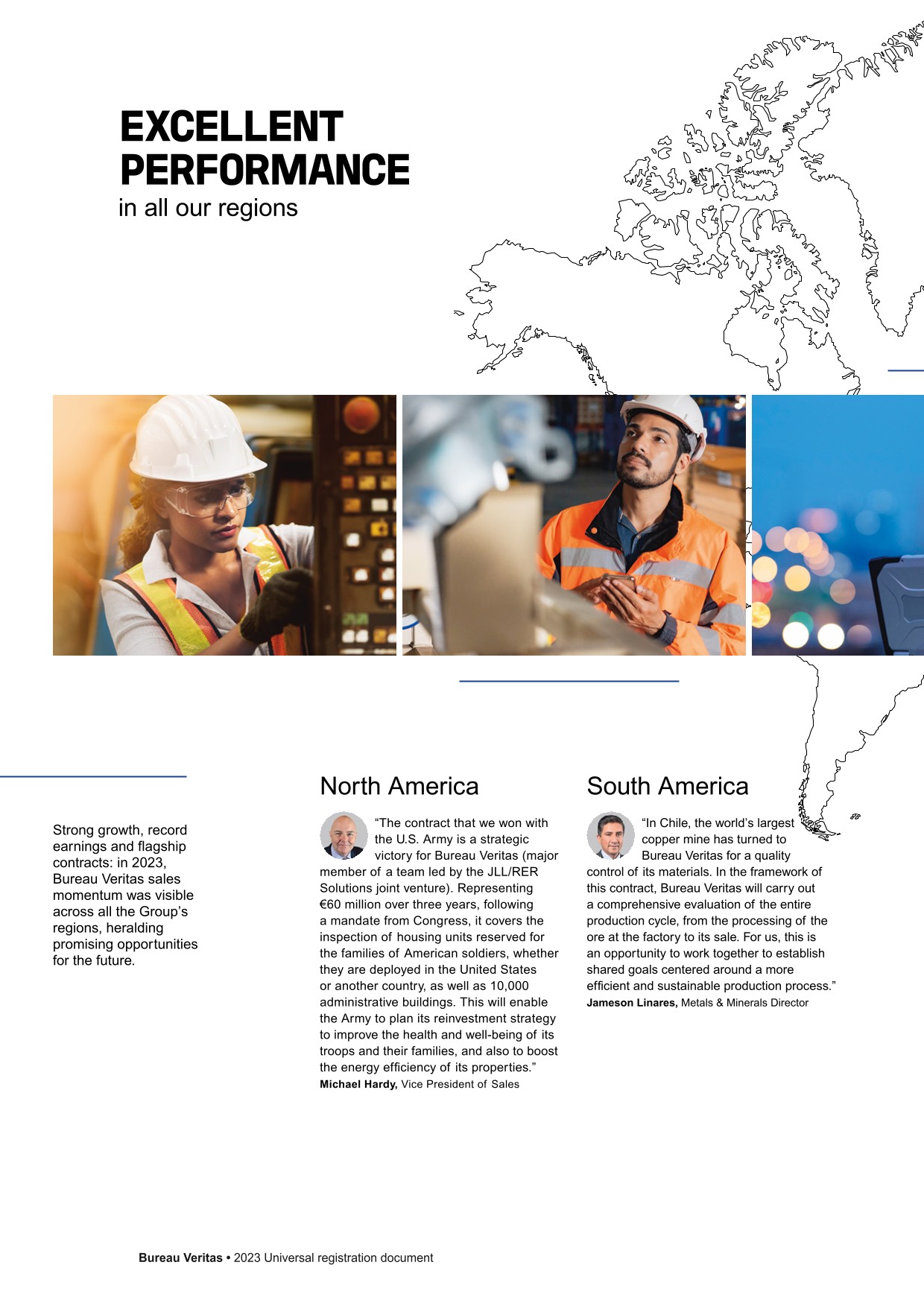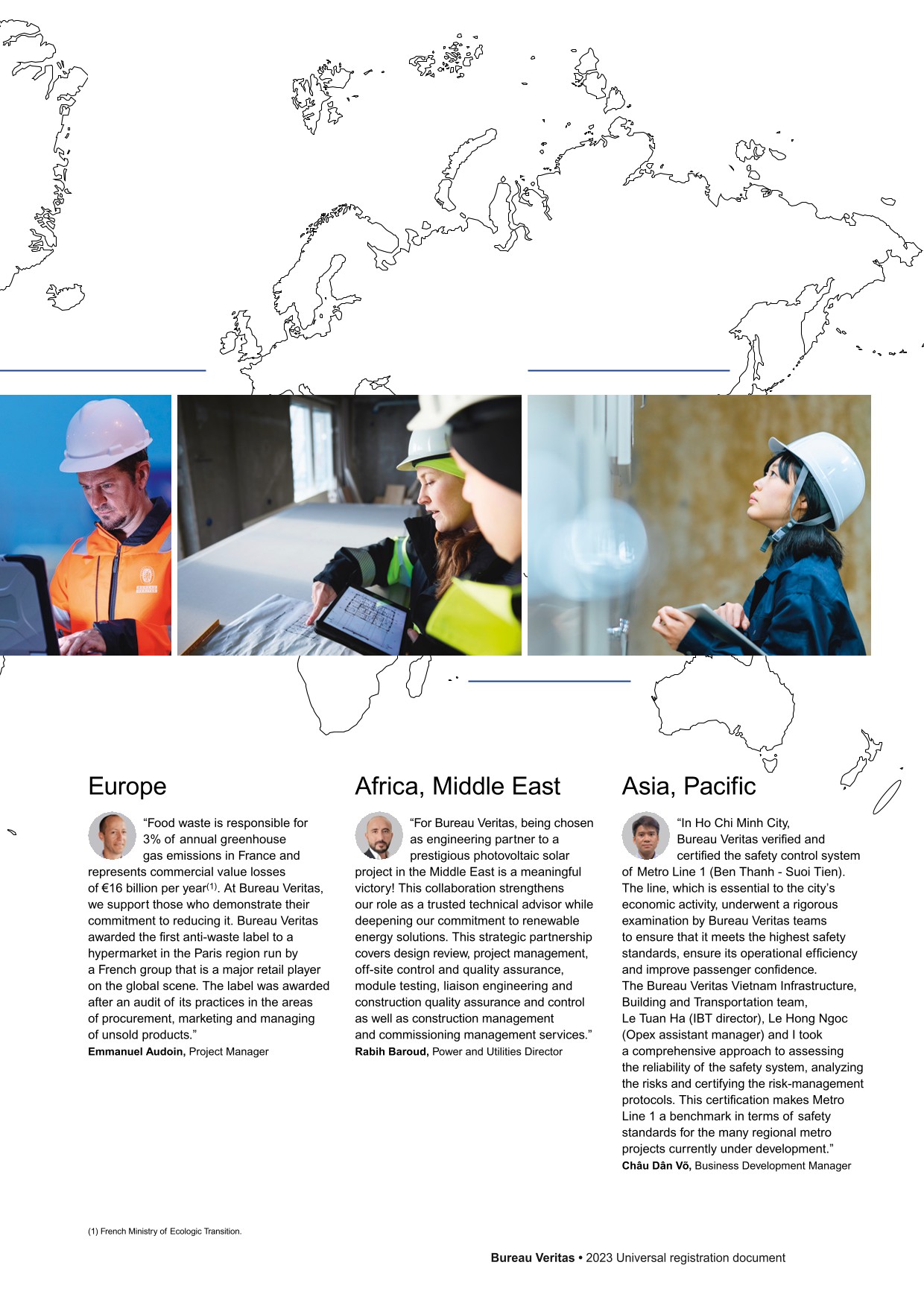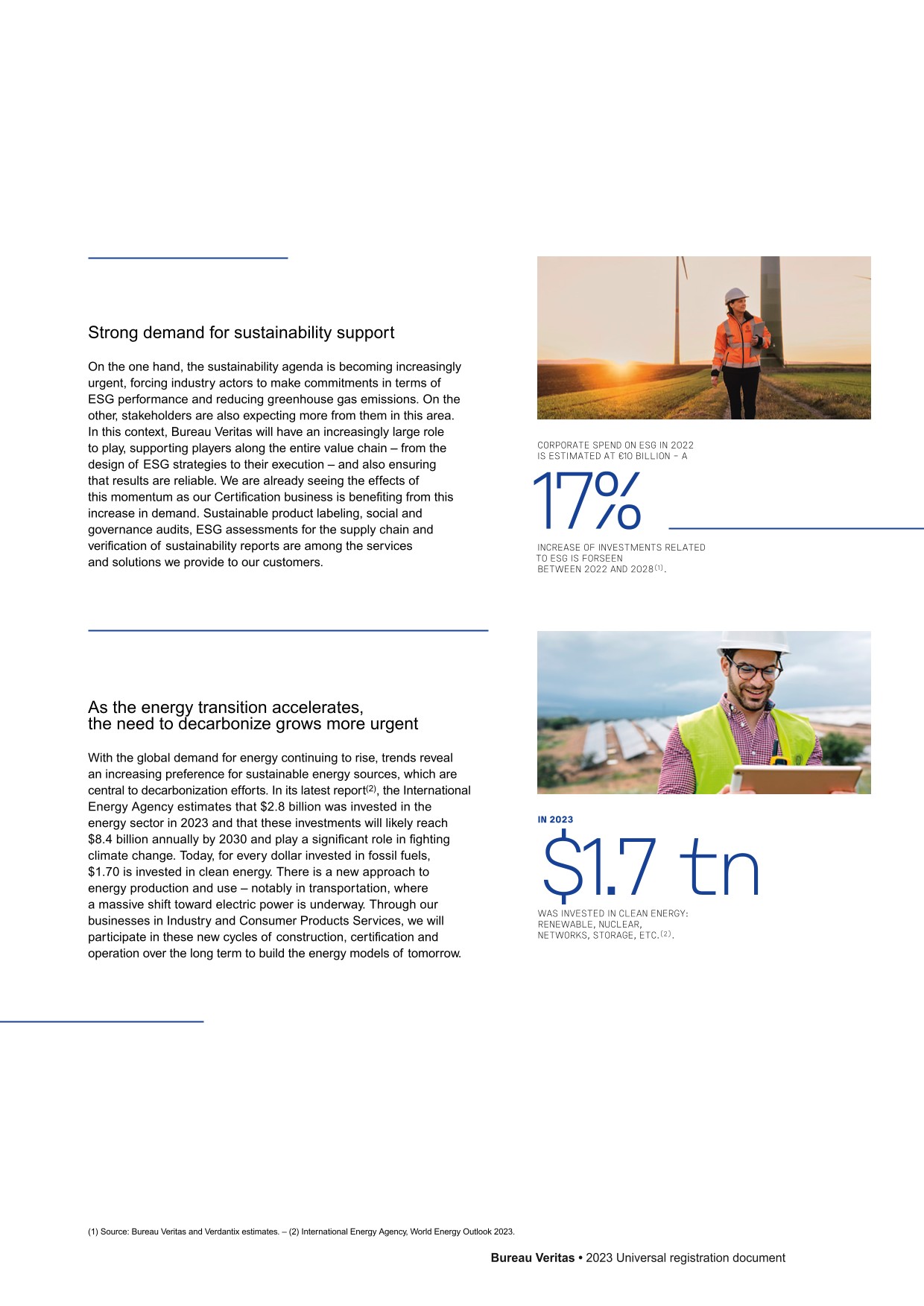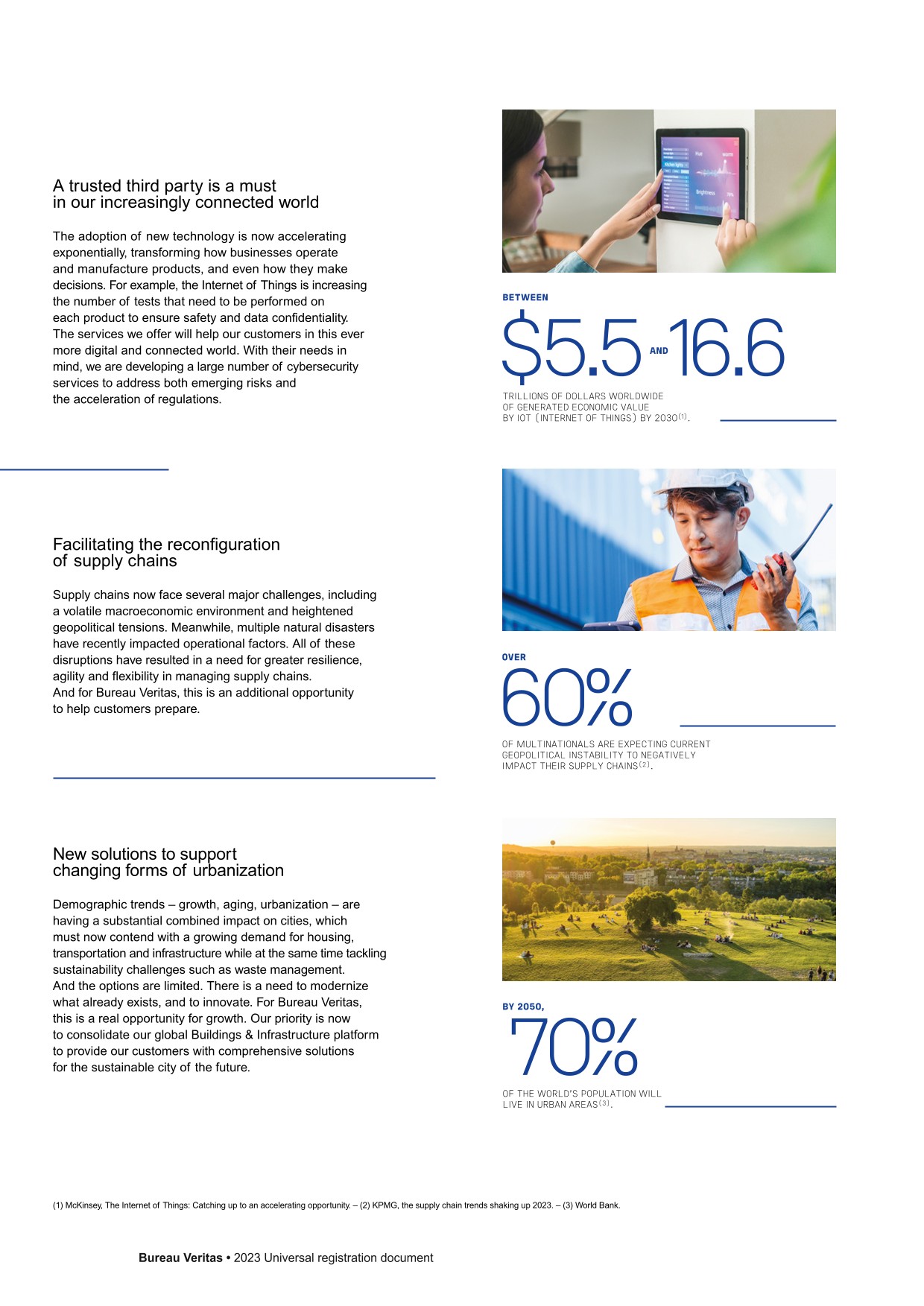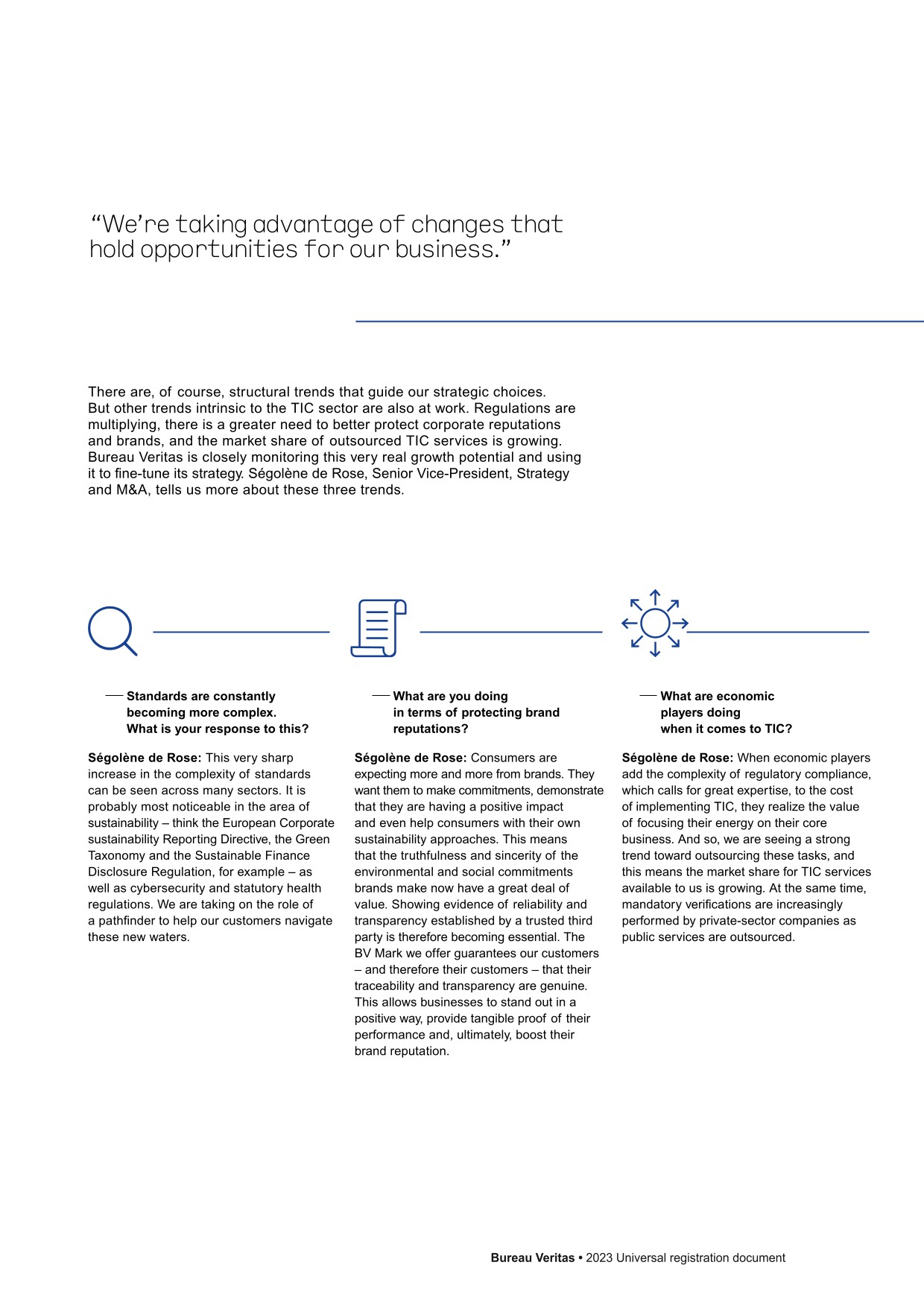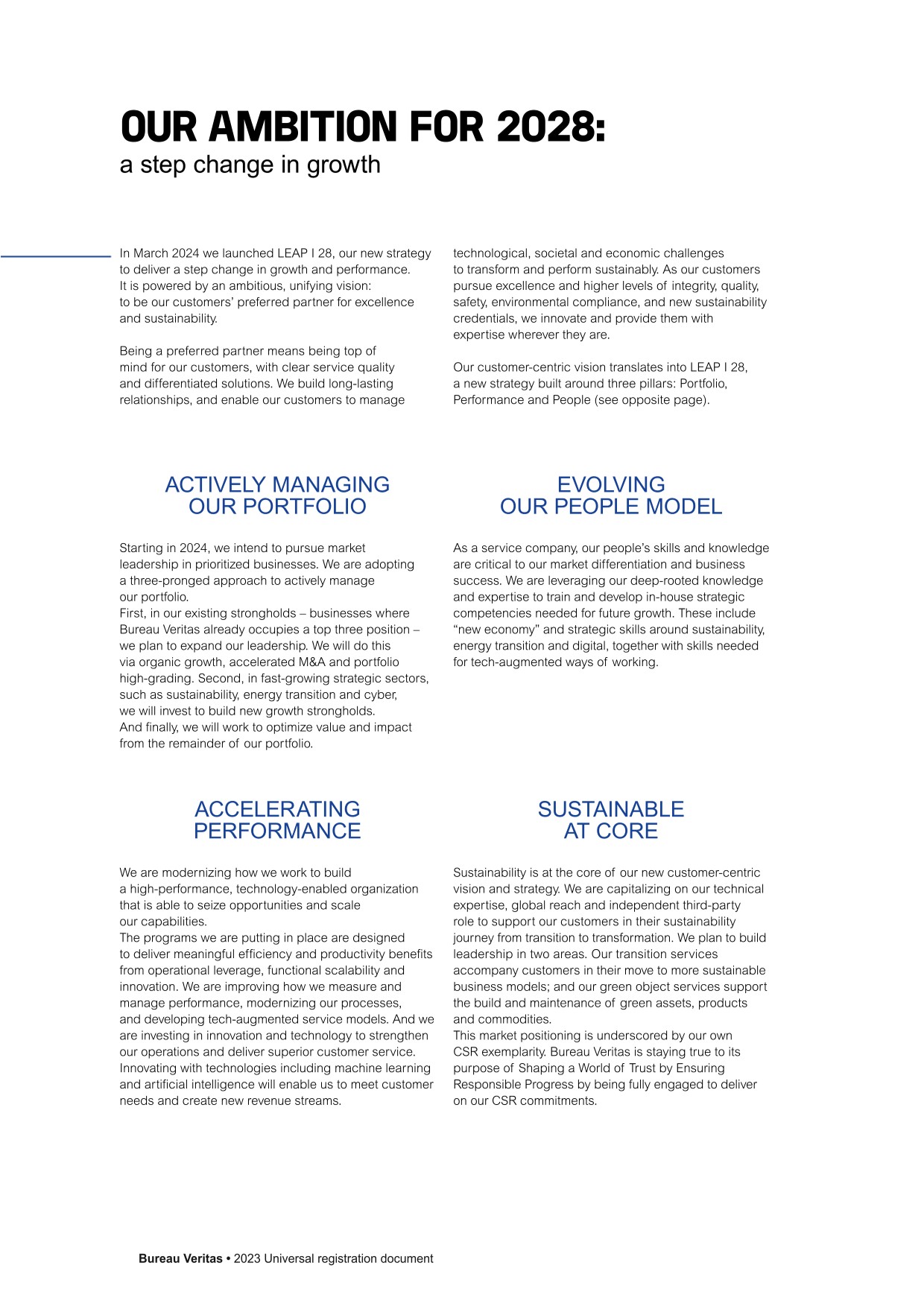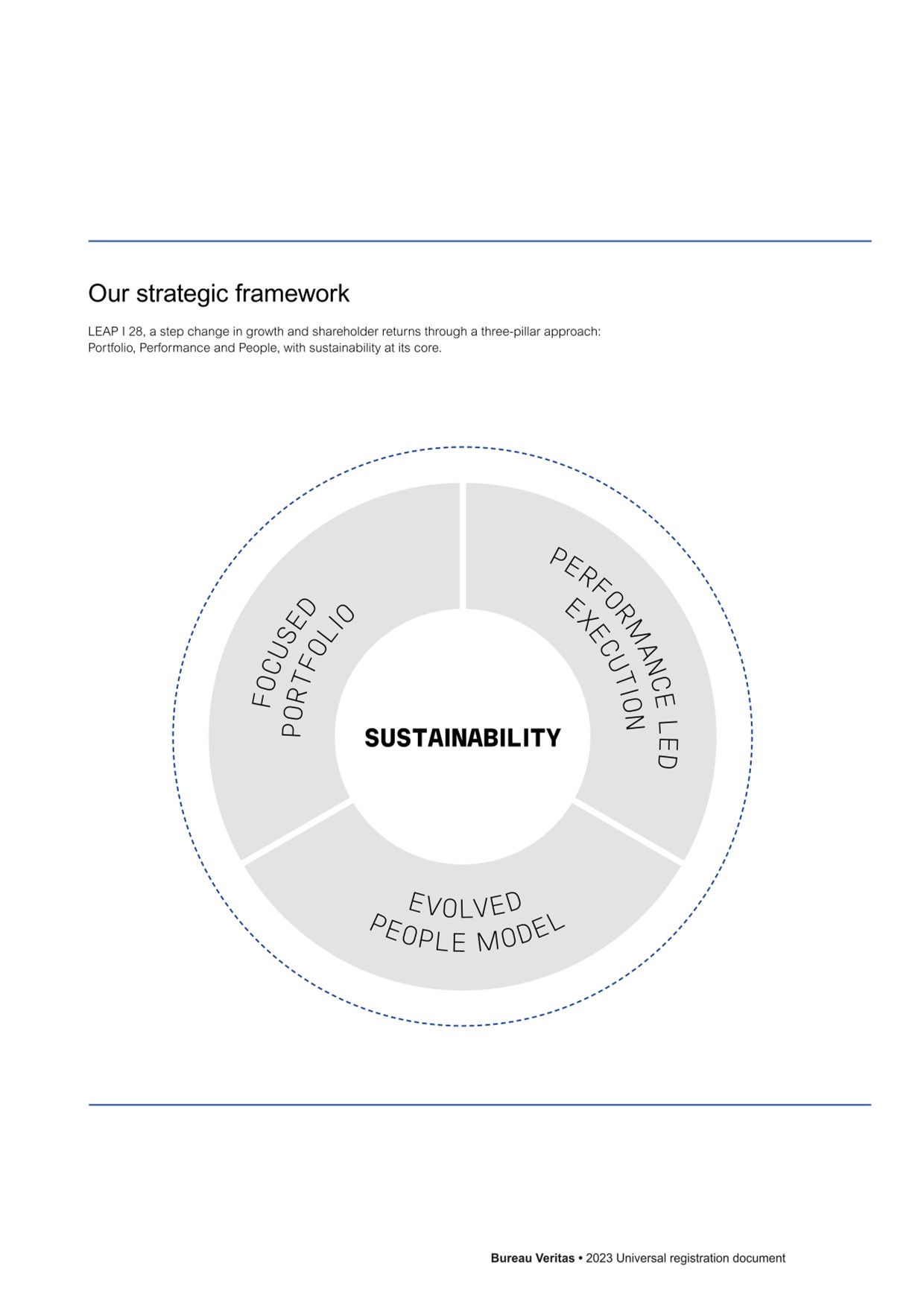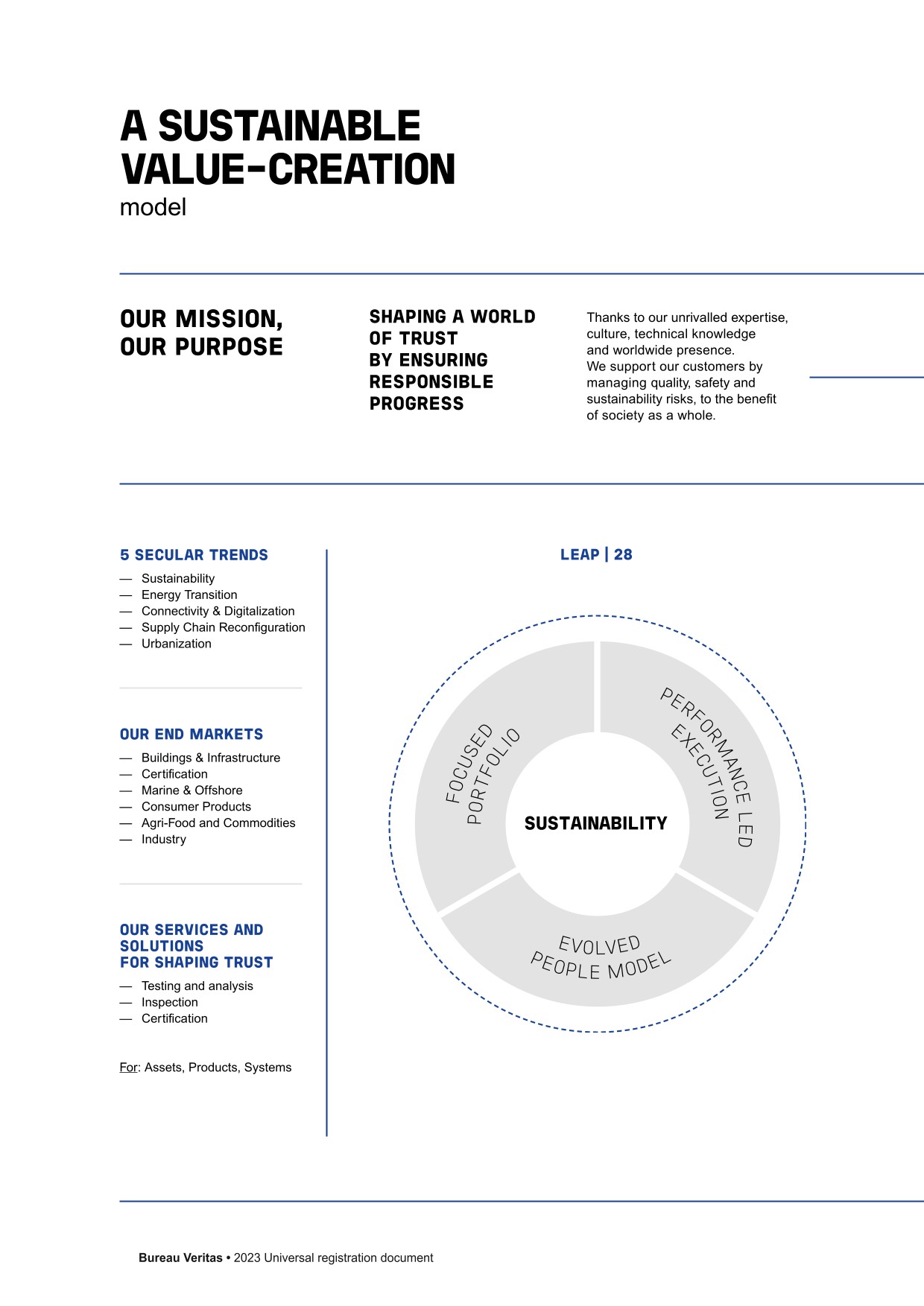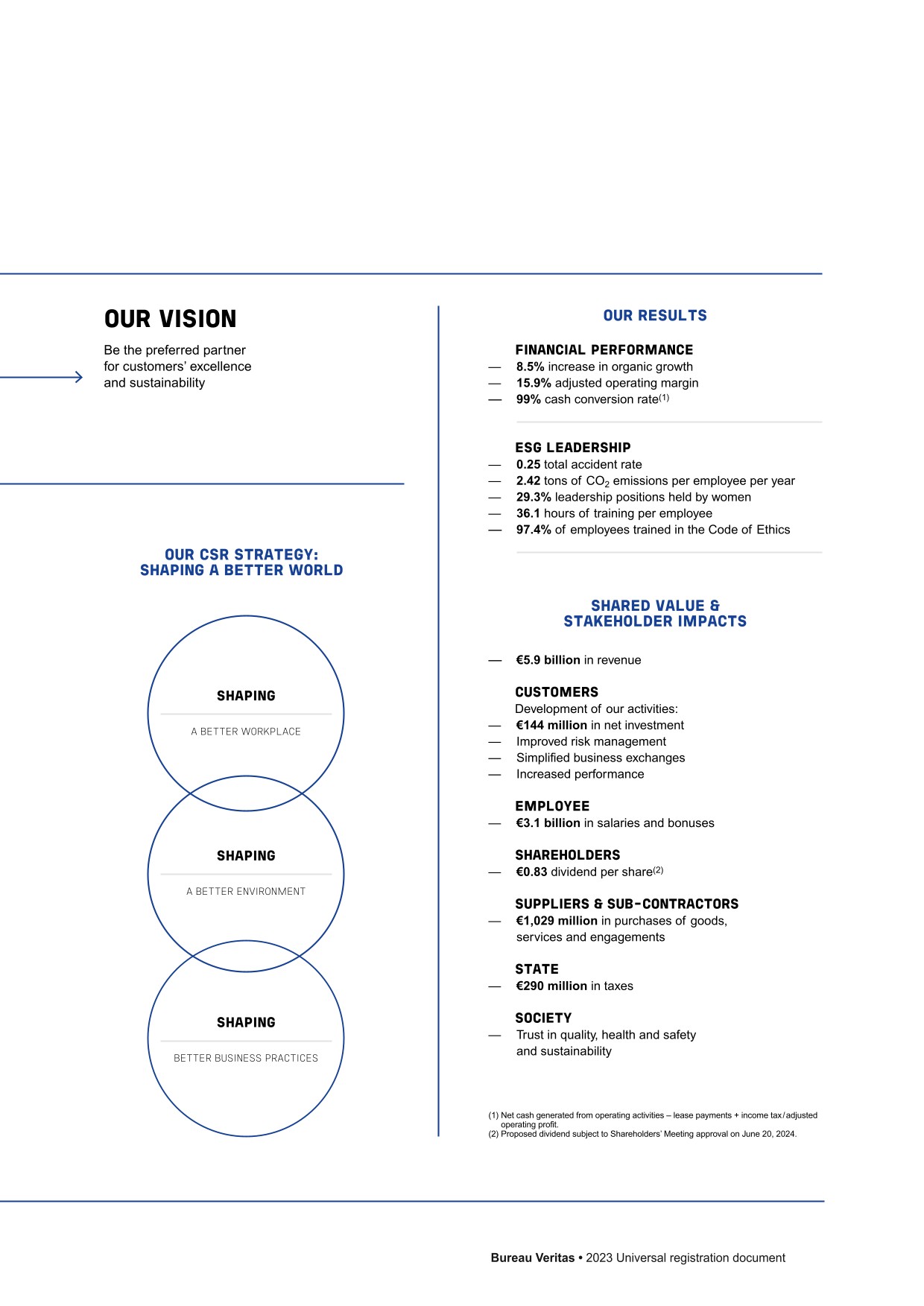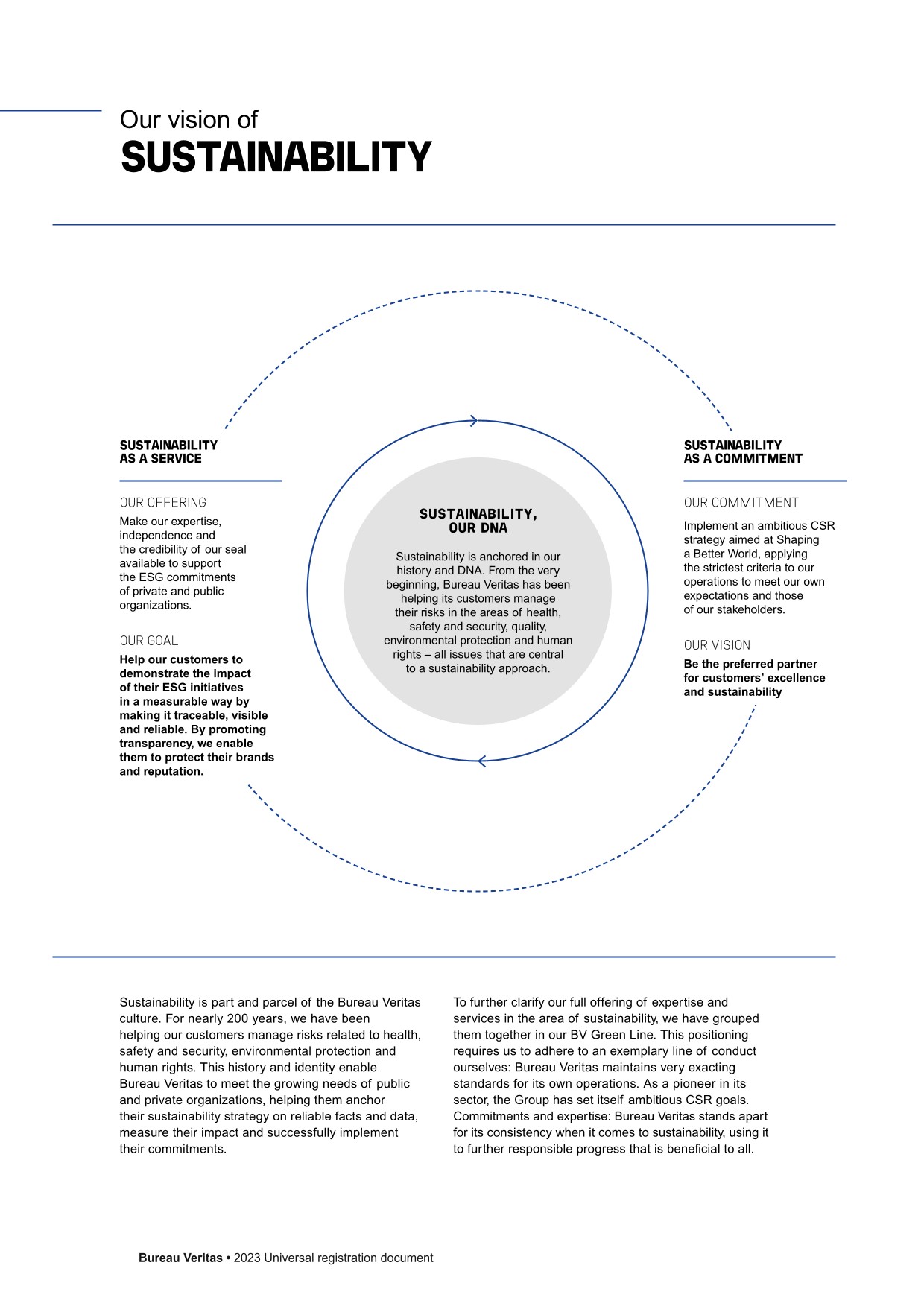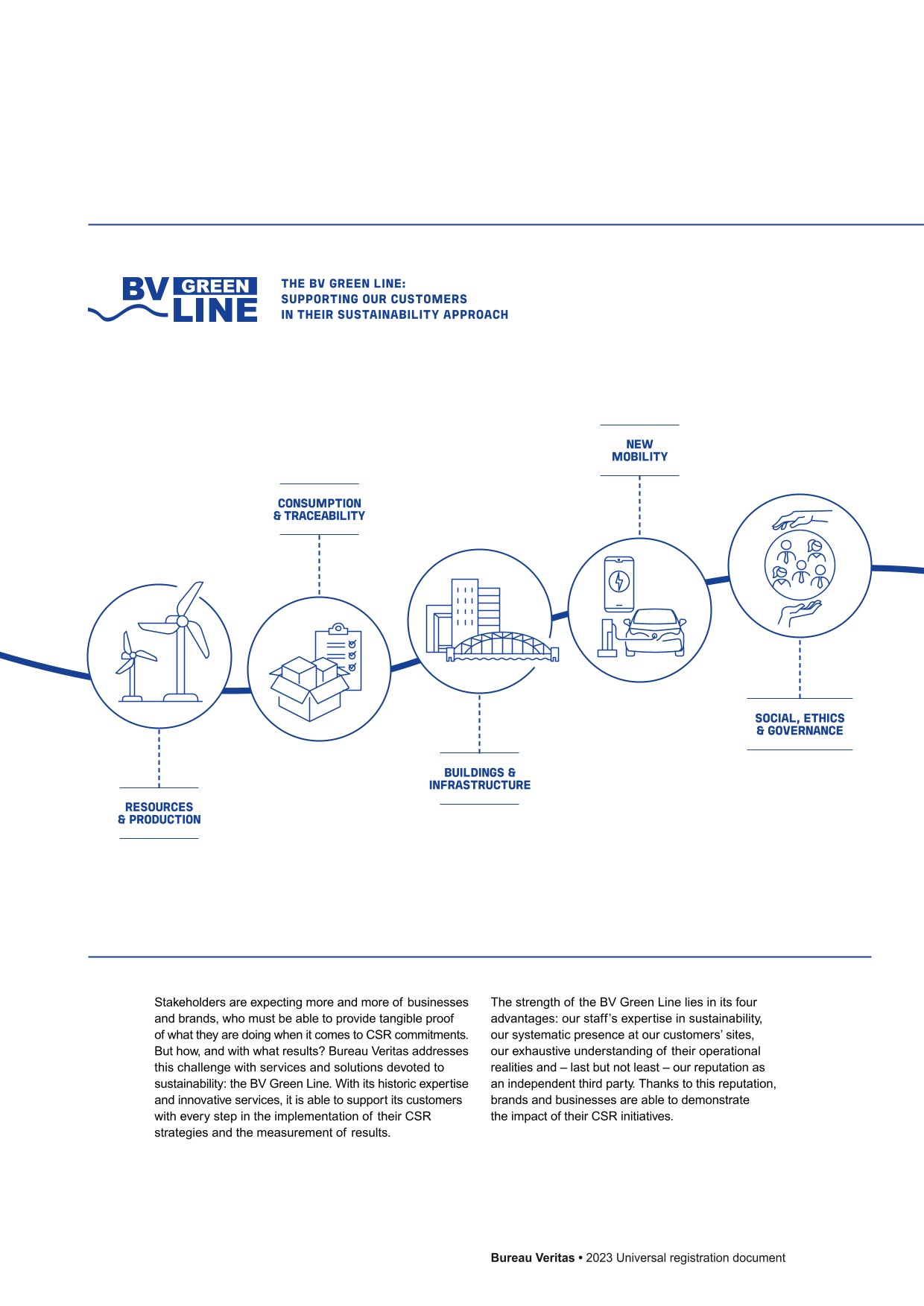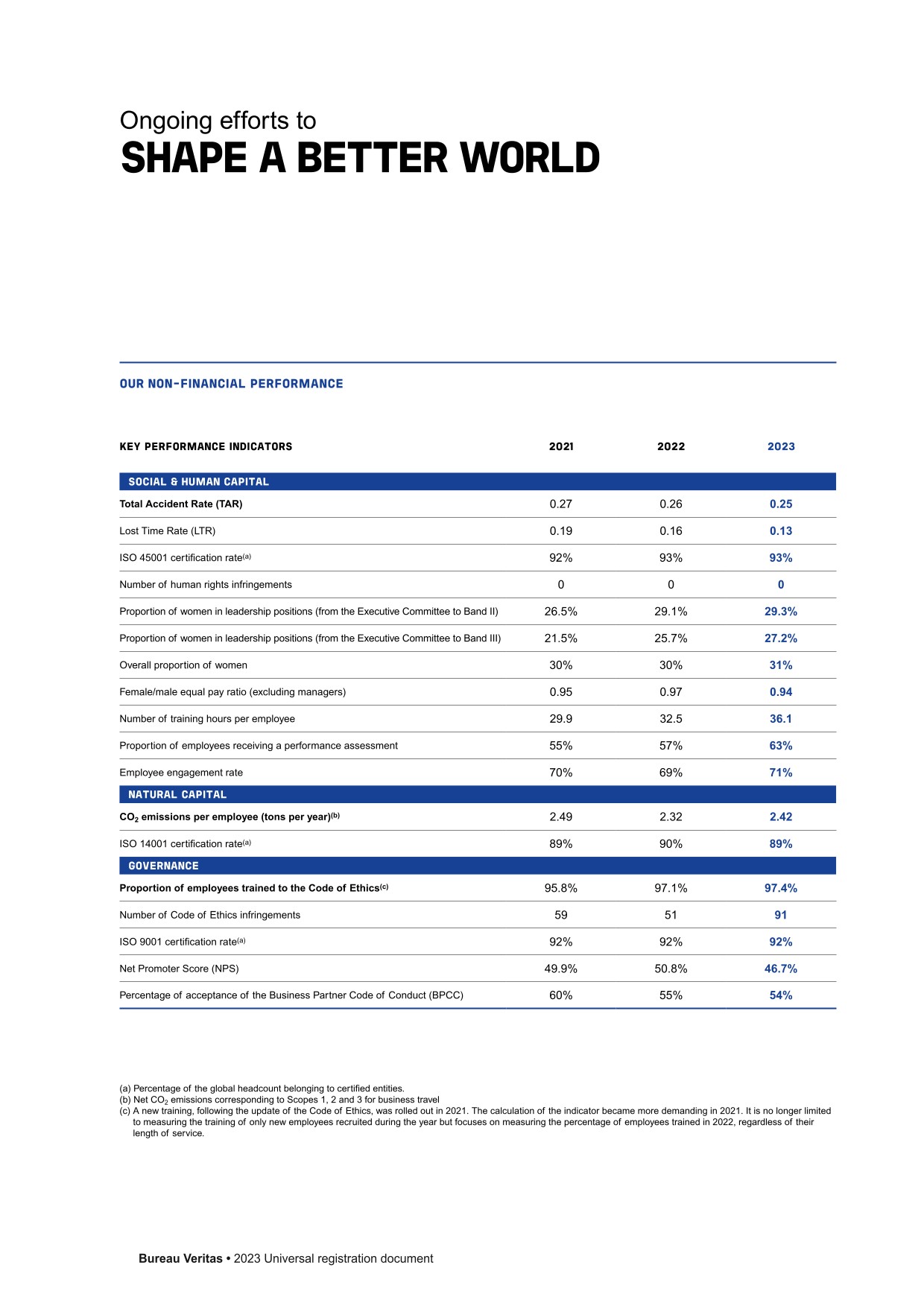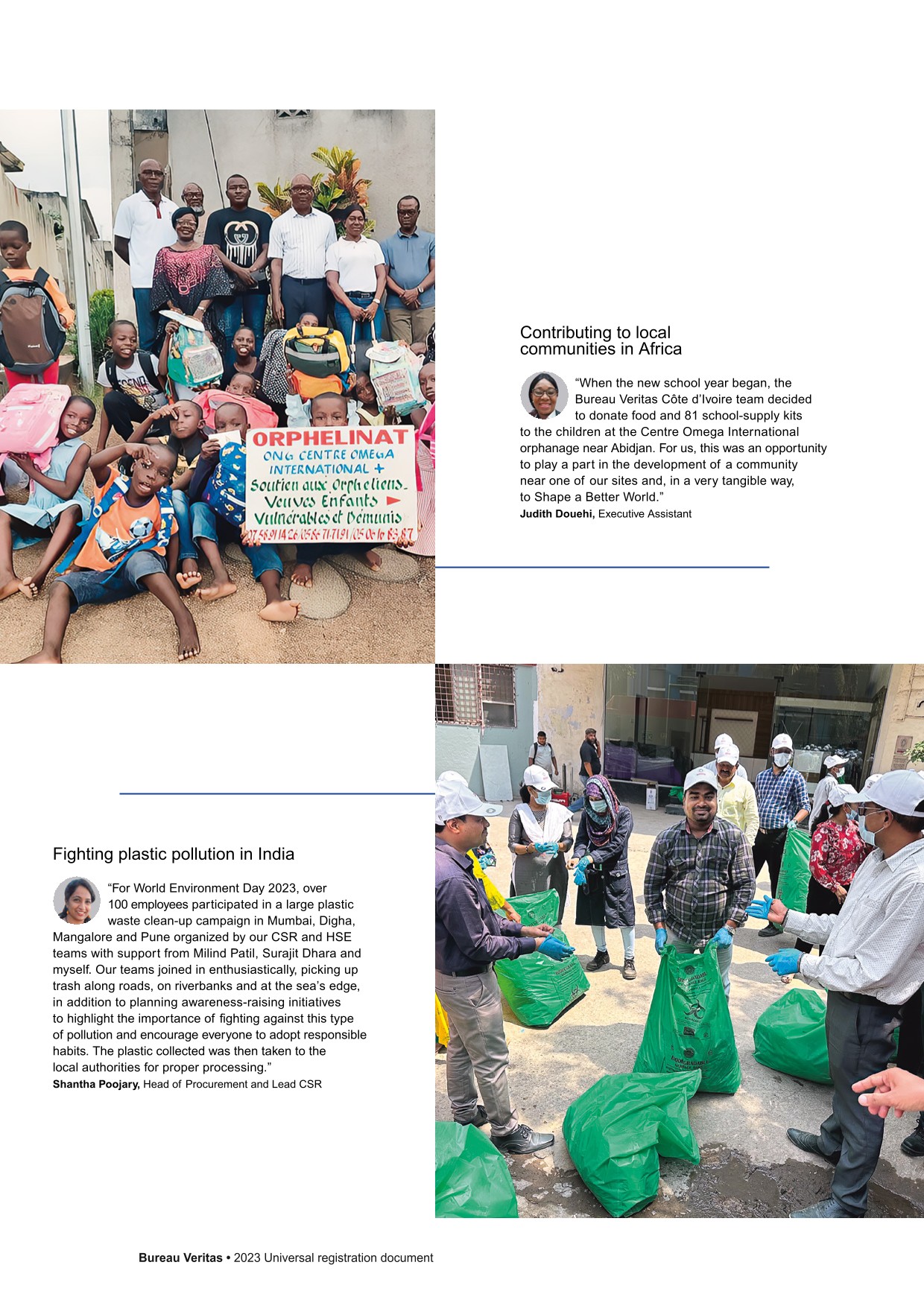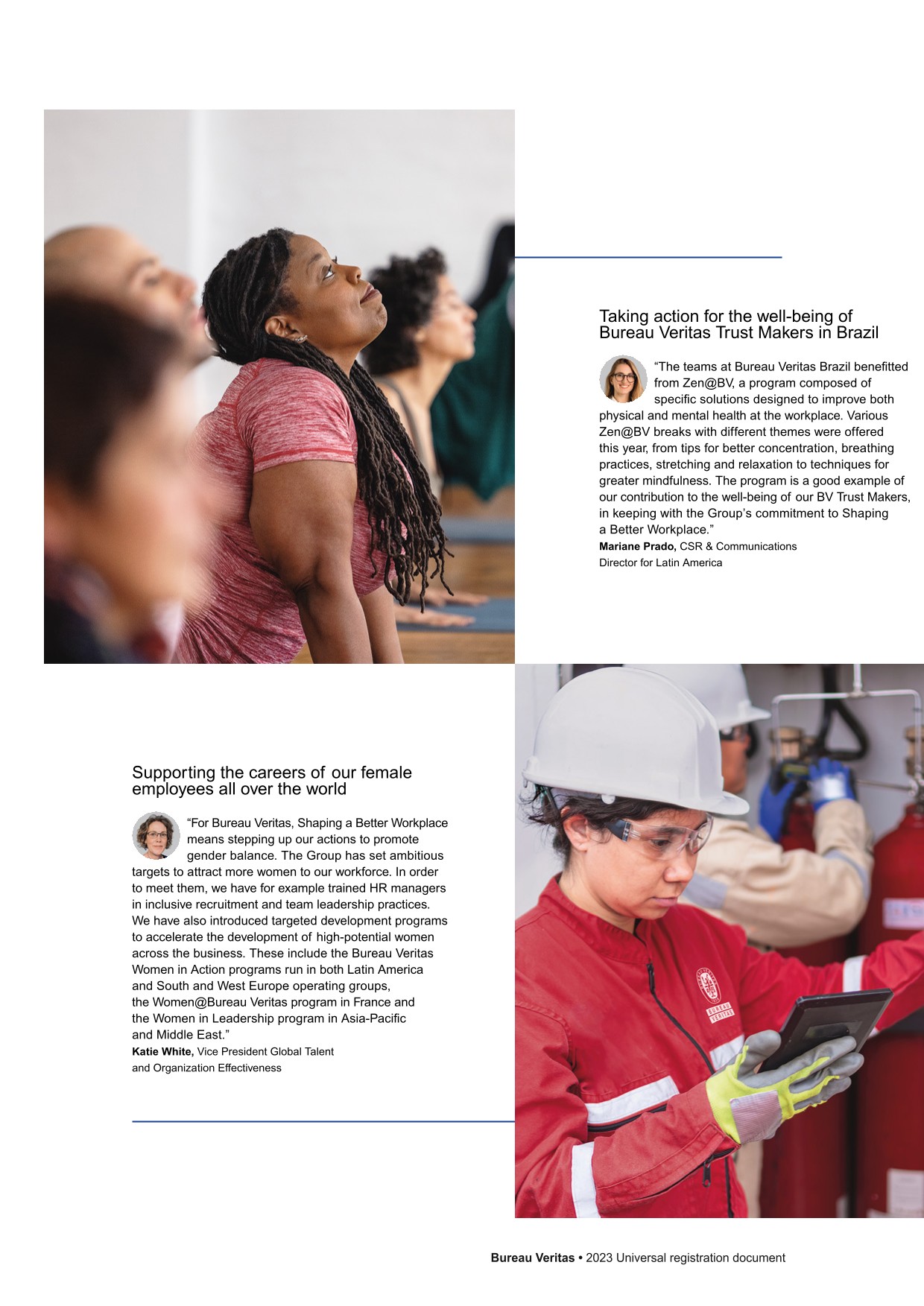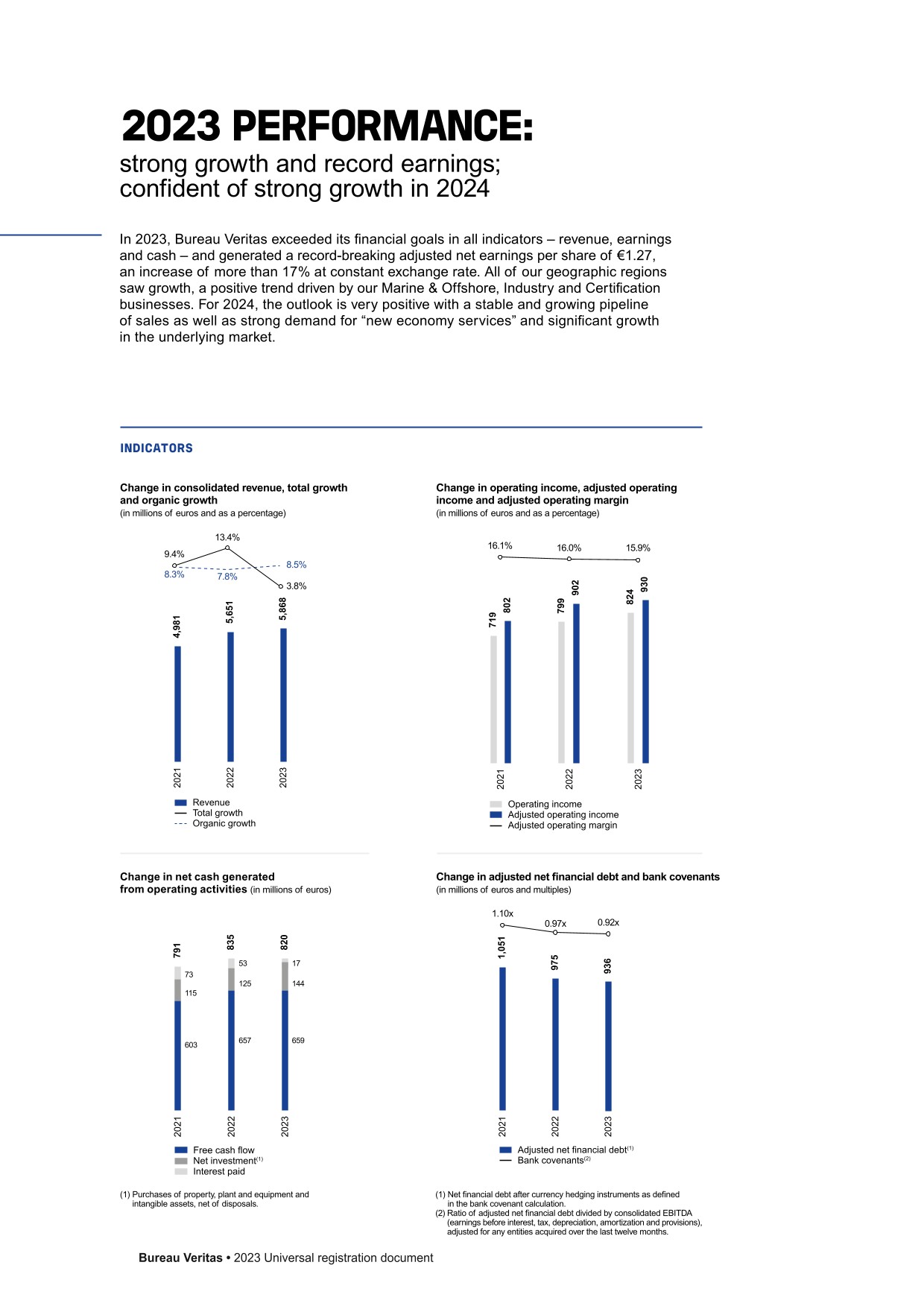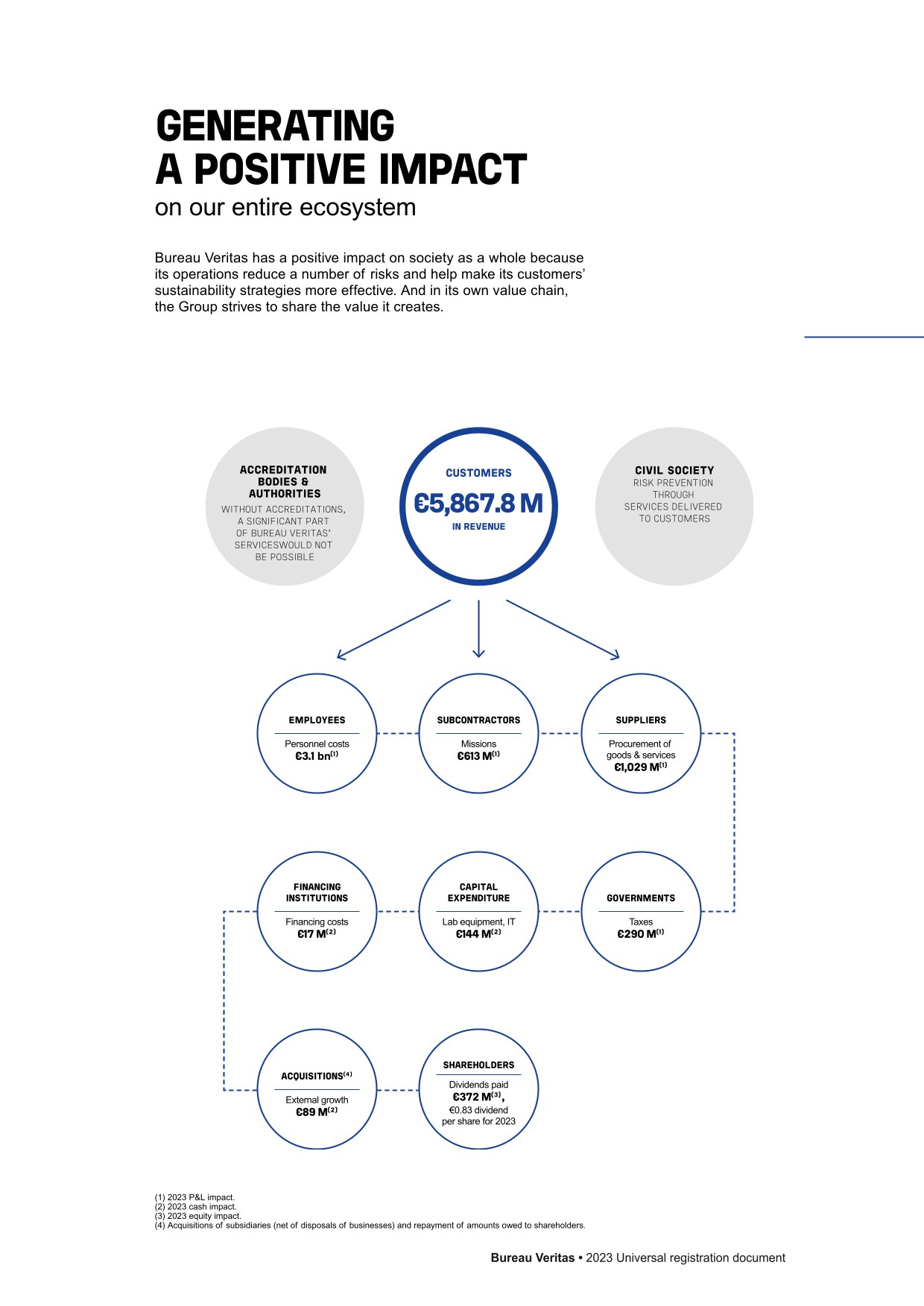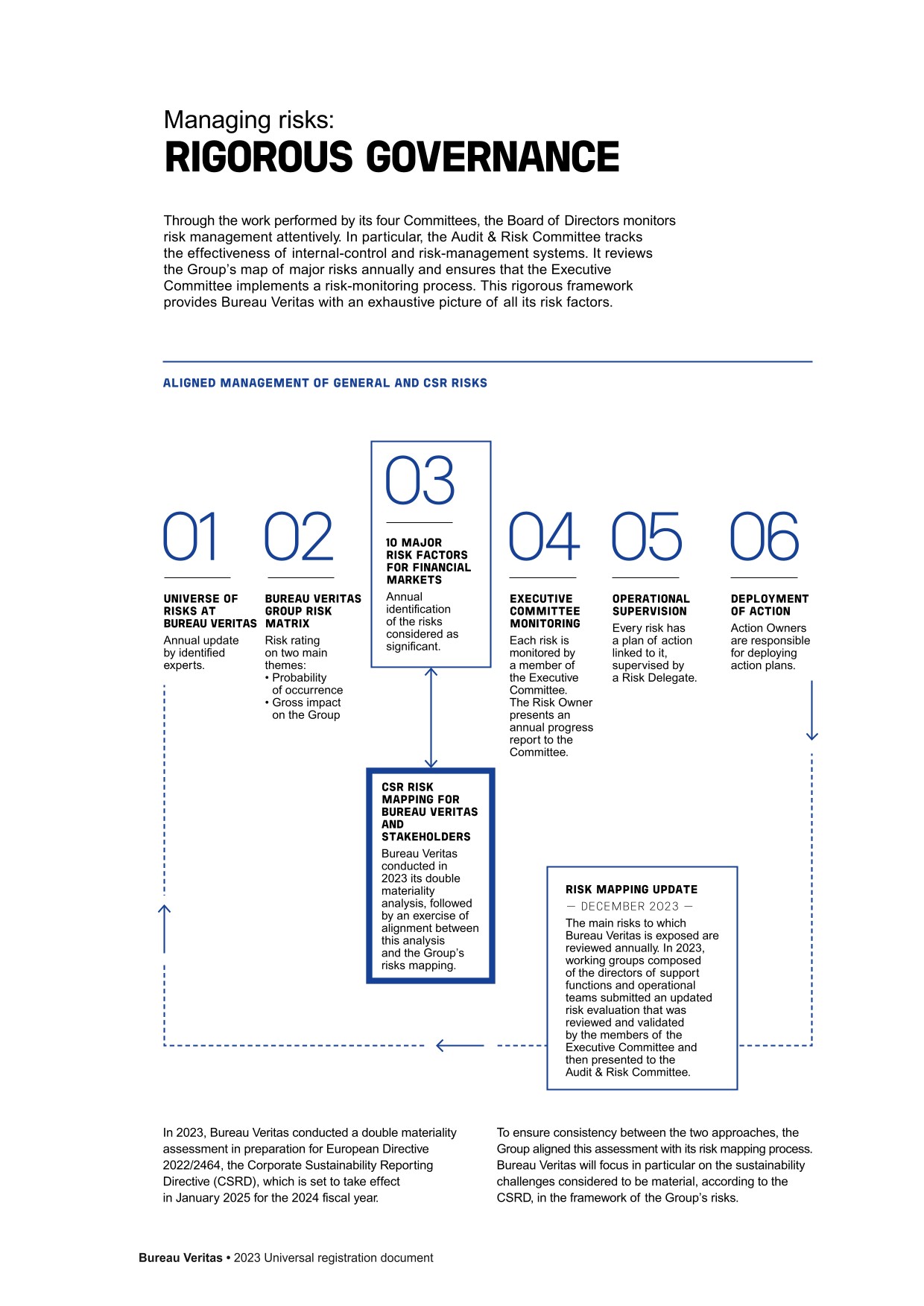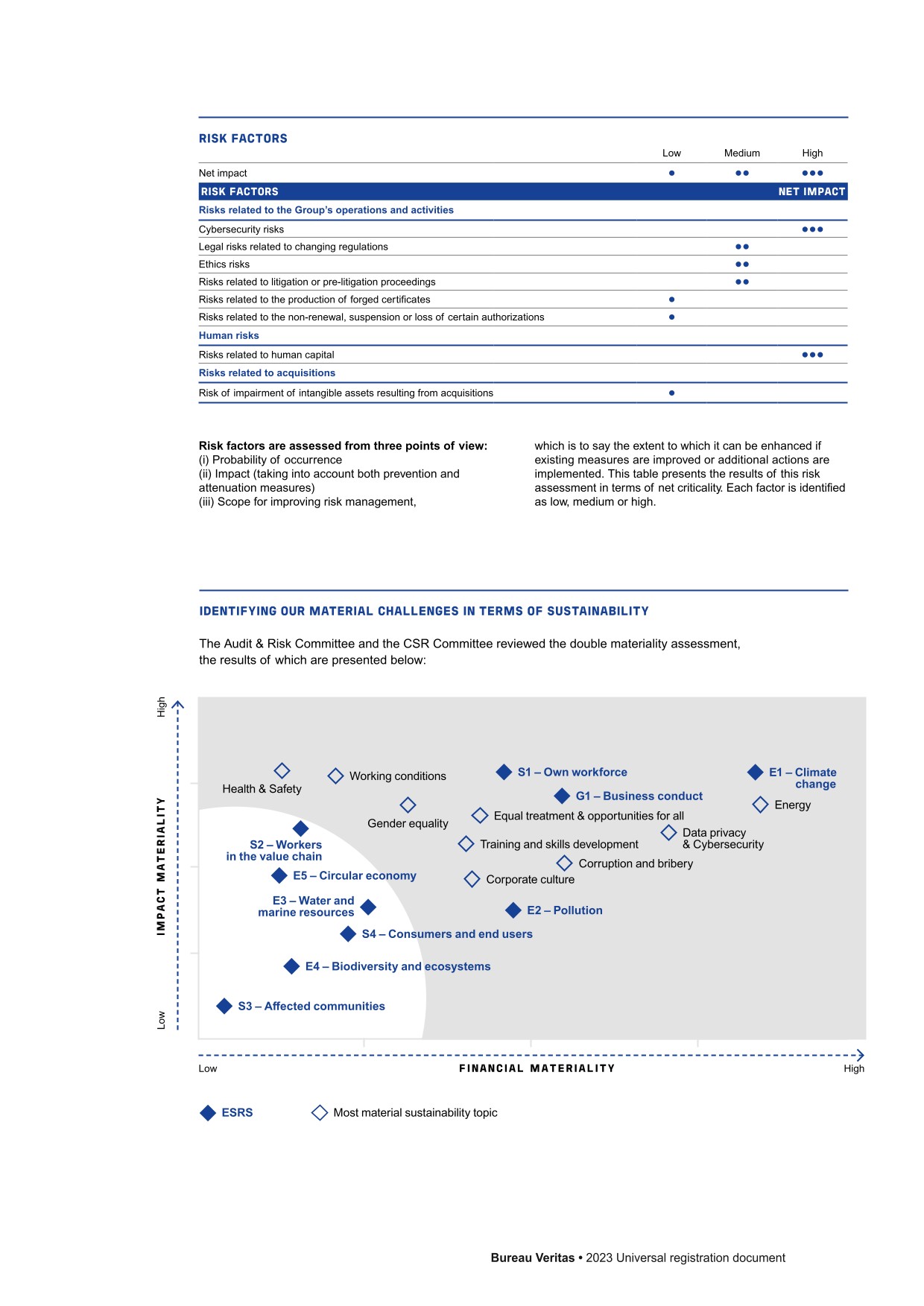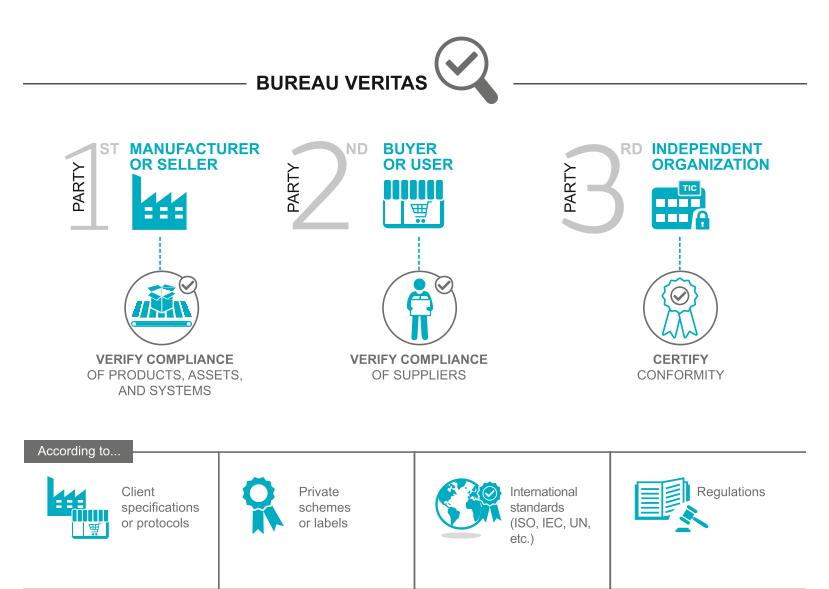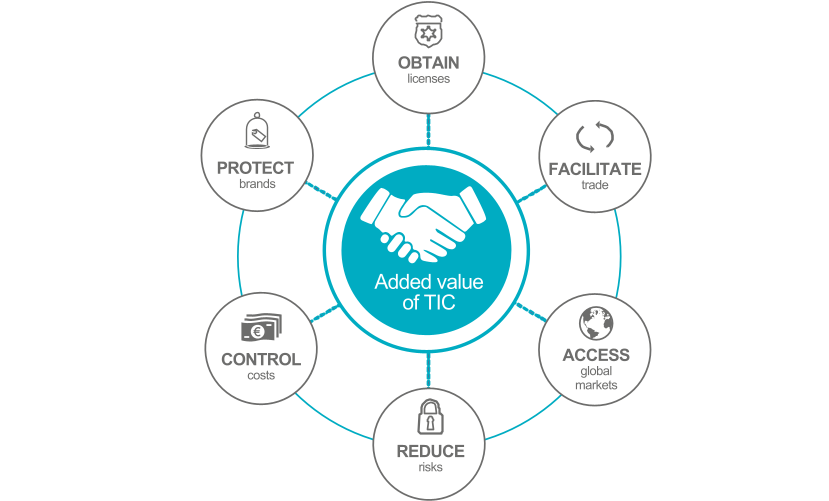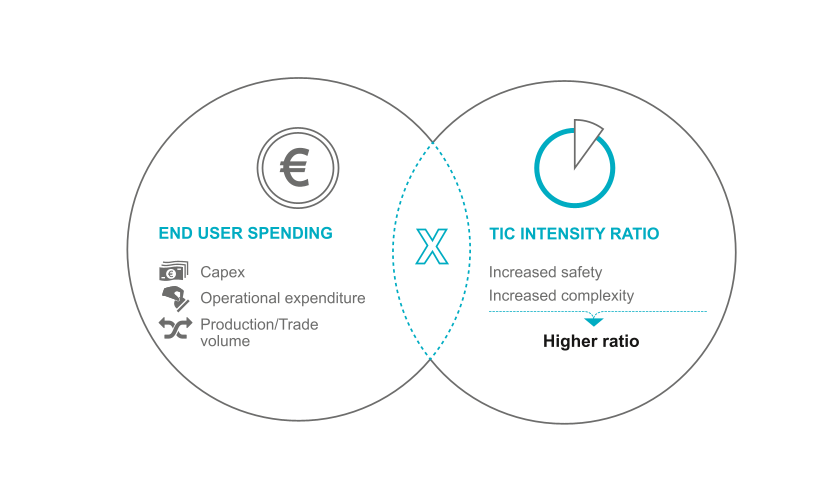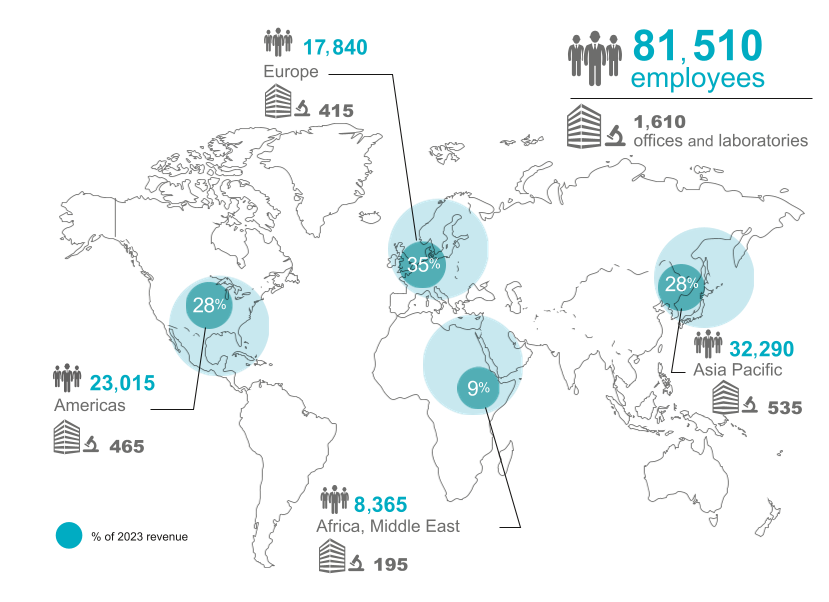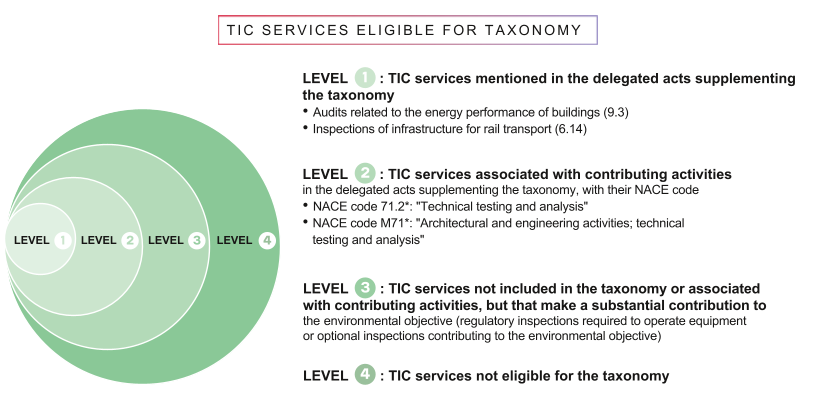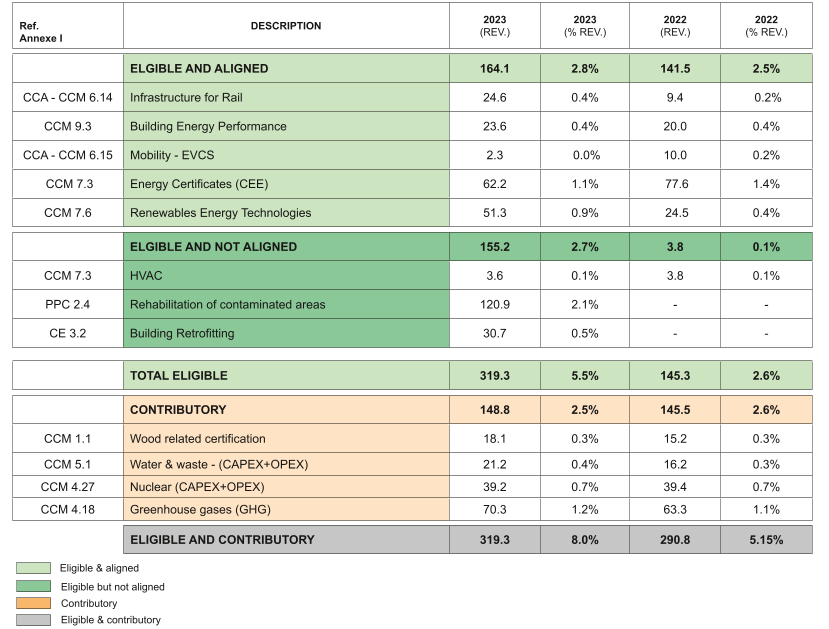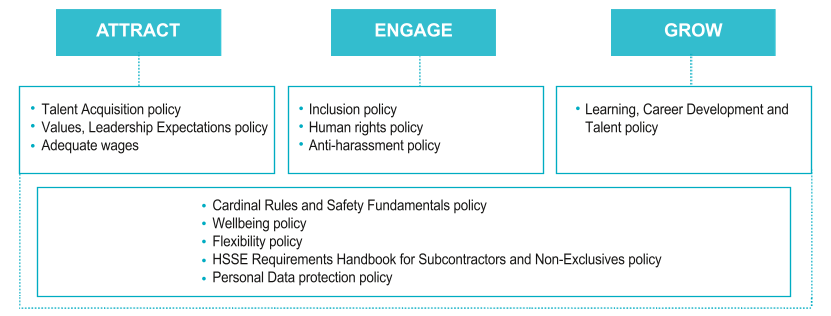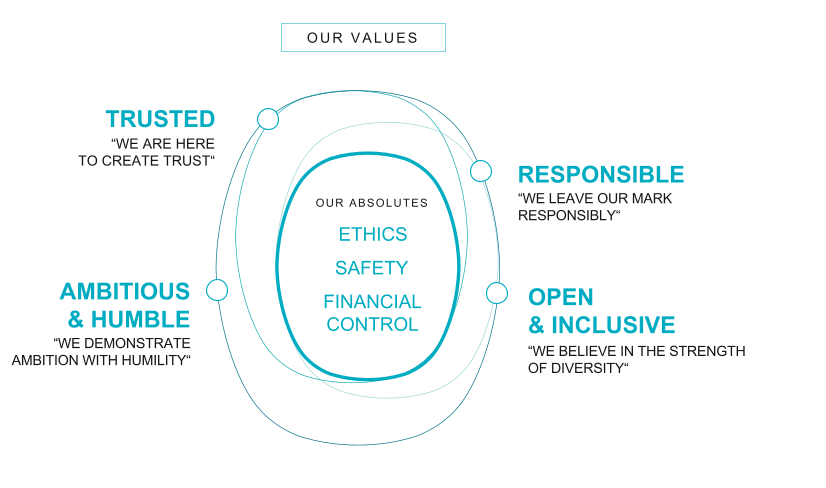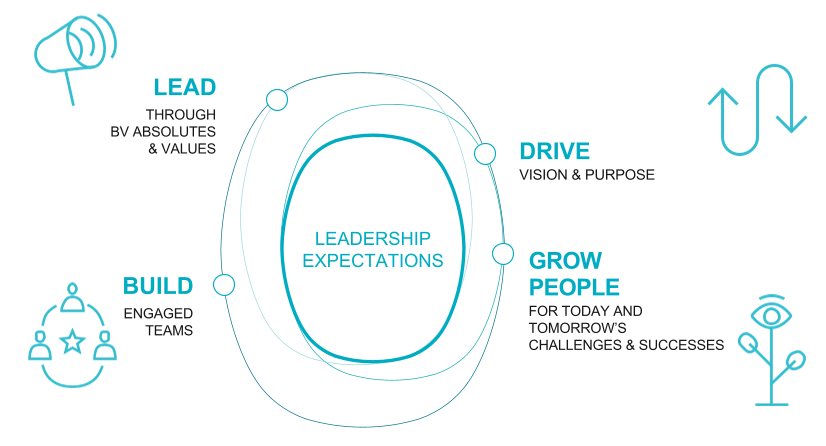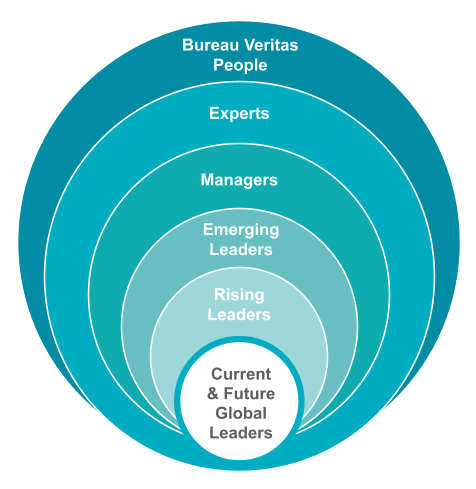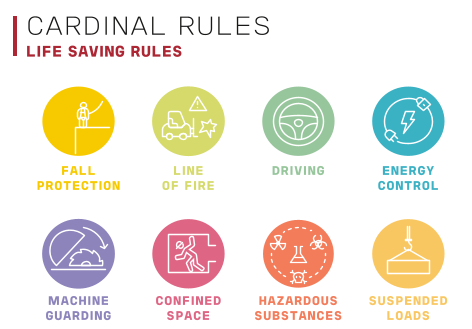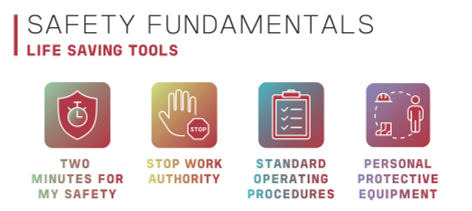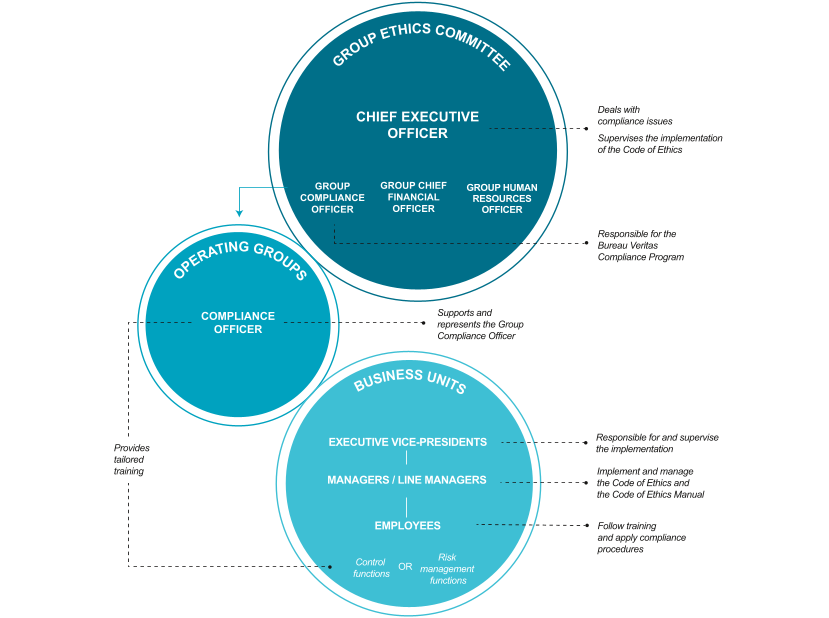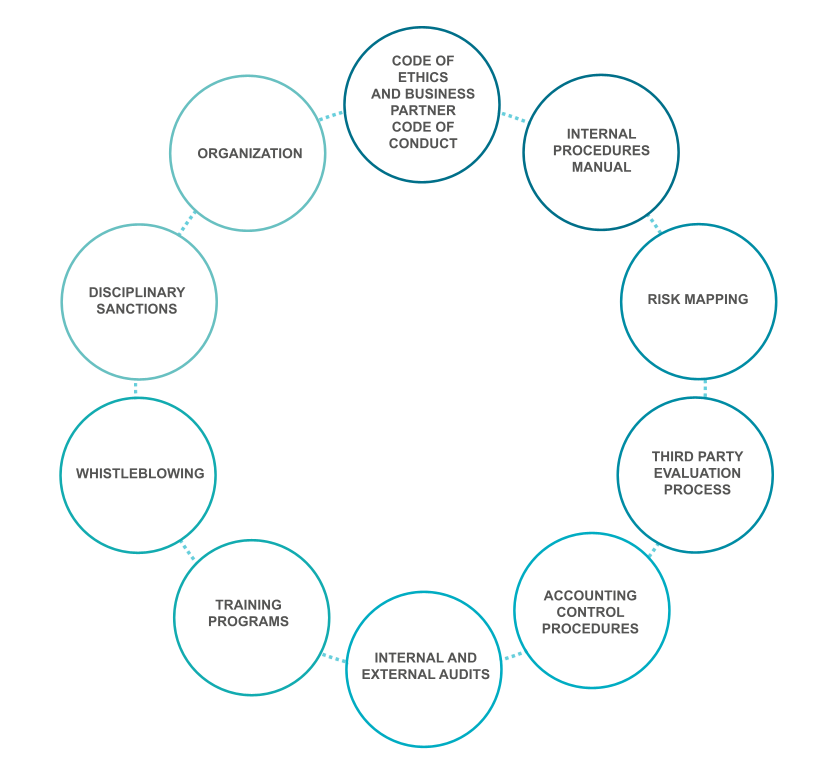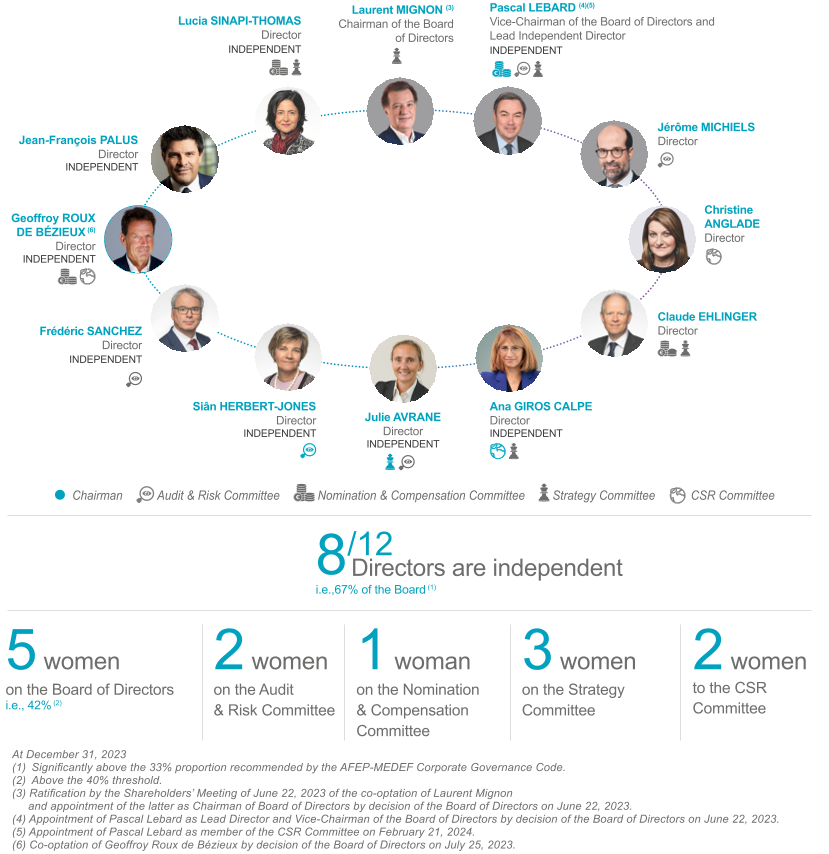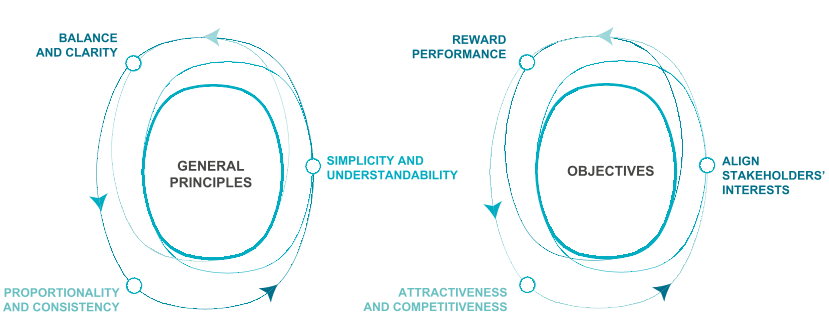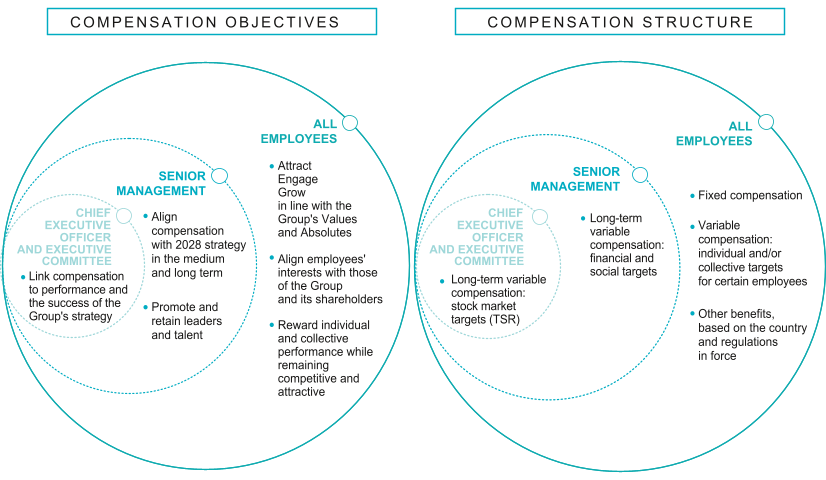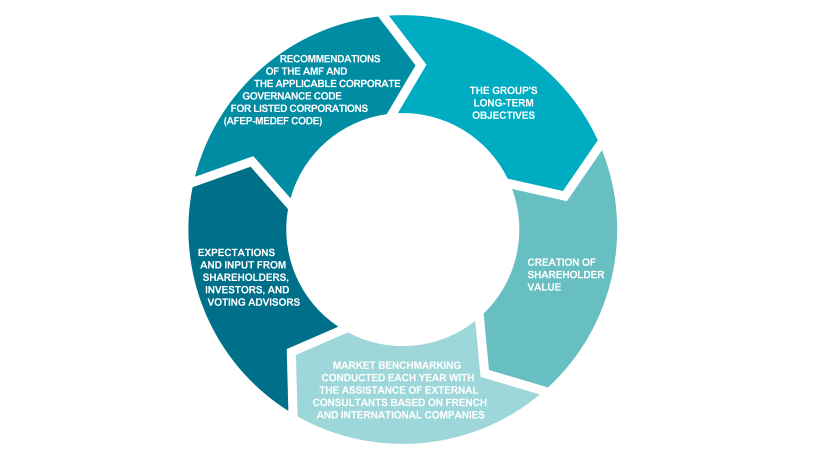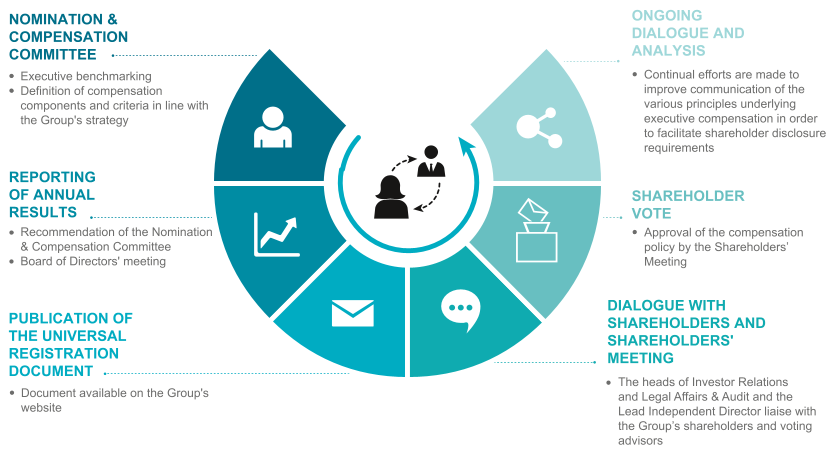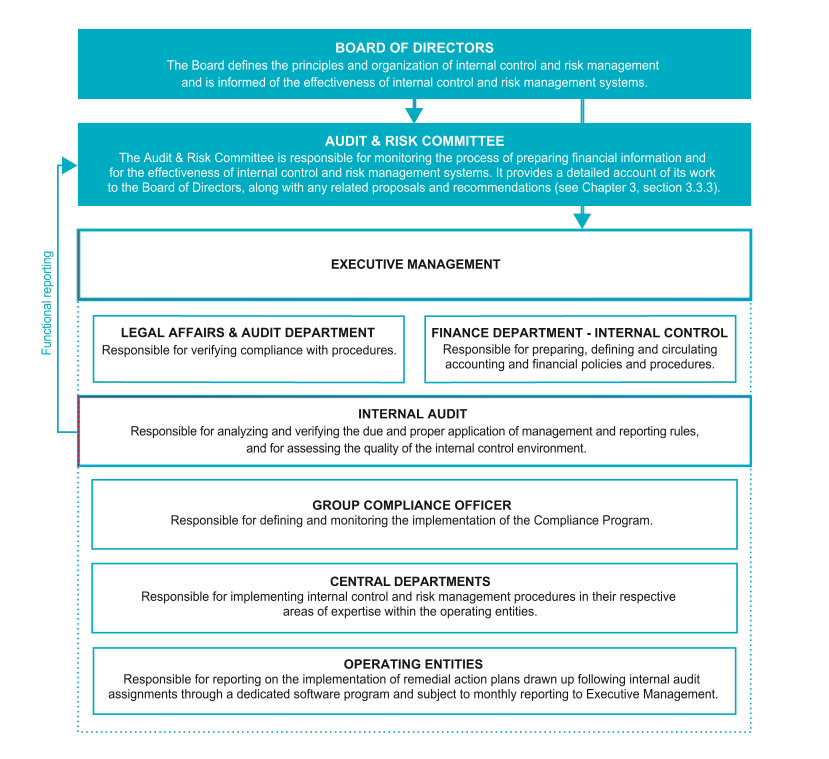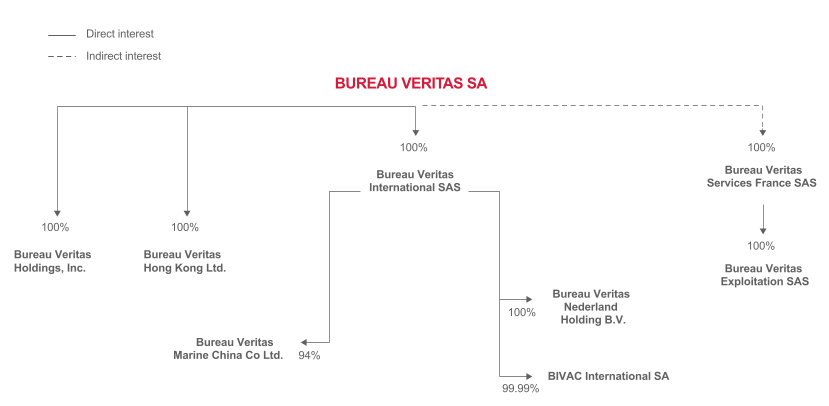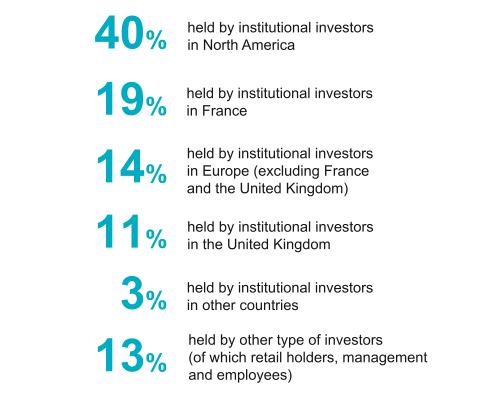URD 2023
-
Presentation
of the Group1.1General overview of the Group
Mission
Bureau Veritas is a world leader in Testing, Inspection and Certification (TIC) services. The Group helps strengthen trust between companies, authorities and consumers. Its mission is to reduce its clients’ risks and improve their performances. It also supports its clients with their innovations in the areas of quality, health, safety and sustainable development.
Bureau Veritas is recognized for its expertise, impartiality, integrity and independence, acquired over its 190 years of existence.
The services provided by Bureau Veritas are designed to ensure that products, assets and management systems conform to given standards and regulations in terms of quality, health, safety, environmental protection and social responsibility (QHSE).
Depending on its clients’ needs and on applicable regulations, standards or contractual requirements, Bureau Veritas acts:
- ●as a “third party”, independently issuing reports and conformity certificates for products, assets, systems, services and organizations;
- ●as a “second party”, on behalf of and upon the instructions of its clients to ensure better control of the supply chain; or
- ●as a “first party”, on behalf of clients seeking support in ensuring or improving the conformity of their products, assets, systems and services.
Obtaining a license to operate
Companies must prove that they are compliant with a large number of standards and regulations. Bureau Veritas helps them by providing its in-depth expertise on the standards applicable to their businesses. As an independent third party, Bureau Veritas verifies that companies comply with these standards. This allows them to conduct and develop their businesses in compliance with local and international regulatory requirements and thereby to obtain and maintain the necessary licenses to operate issued by public authorities.
Facilitating trade
International trade relies on third-party players who certify that the goods exchanged comply with the quality and quantities stipulated in commercial contracts. Bureau Veritas plays a key role in these transactions by testing materials, verifying that goods comply with contractual specifications and validating quantities. Exchanges of commodities, for example, are based on certificates issued by companies such as Bureau Veritas.
Accessing global markets
Capital goods and mass consumer products must meet national and international standards before being sold on the market in a given country. These standards act as technical trade barriers within the meaning of the WTO. Companies design and manufacture their products and equipment in accordance with the standards of different countries. They call on Bureau Veritas to carry out tests and optimize their test plan, with the aim of getting their products to market faster.
Reducing risks
Managing risks relative to quality, health, safety, environmental protection and social responsibility improves the efficiency and performance of organizations. Bureau Veritas helps its clients to identify and manage these risks, from project design to completion and decommissioning.
Controlling costs
Second- and third-party testing, inspection and auditing methods allow companies to determine the true condition of their assets. This enables them to launch new projects and products with the assurance that costs, timing and quality are under control. During the operational phase, inspections help optimize maintenance and extend the useful life of industrial equipment.
Protecting brands
The huge rise in the use of social networks has transformed how global brands are managed. Brands may quickly find themselves impacted by a malfunction in one of the links in their supply or distribution chain. Bureau Veritas helps companies better manage these risks, by conducting analyses as a highly reputed independent global player.
-
1.2History
1828: Origins
-
1.3The TIC industry
To the Group’s knowledge, there is no comprehensive report covering or dealing with the markets in which it operates. As a result, and unless otherwise stated, the information presented in this section reflects the Group’s estimates, which are provided for information purposes only and do not represent official data. The Group gives no assurance that a third party using other methods to collect, analyze or compile market data would obtain the same results. The Group’s competitors may also define these markets differently.
1.3.1A market estimated to be worth close to €300 billion
Services related to quality, safety, performance, sustainability and responsibility are termed as Testing, Inspection, and Certification (TIC). TIC tasks range from on-site tests and supply chain inspections to data verifications. They can be carried out at any supply chain stage, in all sectors, and by various private or public parties.
The TIC market size is tied to the value and risk of products or assets. The "TIC intensity" corresponds to the fraction of an item's value dedicated to controlling this asset or product. Typically, this fraction ranges from 0.1% to 0.8%. The TIC market's value is determined by multiplying the TIC intensity by the amount spent on goods and products by manufacturers, operators, buyers and sellers.
-
1.4Group’s strategy and objectives
1.4.1Key competitive advantages
The Group benefits from an efficient international network
Bureau Veritas boasts a vast global network with more than 1,600 offices and labs in almost 140 countries across the world.
Countries with established economies, such as France, the US, Canada, Japan, the UK, Spain, Italy, the Netherlands, Australia, and South Korea, feature a prominent presence of Bureau Veritas. These nations have strong regulatory frameworks, and the Group is recognized for its technical prowess and modern production techniques.
In rapidly developing economies, like China, Brazil, Chile, Colombia, the United Arab Emirates, and India, Bureau Veritas has secured strong footholds for a sustainable growth. The Group has fostered a significant local presence over time in these regions and continues to grow by inaugurating new offices and labs.
The scale of the Group’s network is a core asset, offering value and differentiation on both commercial and operational levels.
- ●On the sales front, this vast network empowers Bureau Veritas to cater to key accounts. This enables securement of significant international contracts, which are becoming an increasingly substantial portion of its activities.
- ●Operationally, the Group capitalizes on its scale to enhance profitability. Economies of scale arise from shared office spaces, back-end operations, IT resources, and the distribution of costs associated with innovating in new services and standardizing inspection procedures over a broader base.
With a regional hub organization in pivotal countries, Bureau Veritas efficiently distributes knowledge, technical aid, and sales teams throughout areas. In the future, the Group envisions fortifying this hub-centric network structure, leveraging the benefits of scale.
A strong image of technical expertise and integrity
Bureau Veritas has built a successful global business based on its long-standing reputation for technical expertise, high quality and integrity. This reputation is one of its most valuable assets and is a competitive advantage for the Group worldwide.
Technical expertise recognized by authorities and by many accreditation bodies
Throughout its history, the Group has honed expertise across diverse technical fields and developed a comprehensive understanding of regulatory landscapes. At present, Bureau Veritas holds accreditation from numerous national and global delegating authorities and accreditation bodies, either as a second or third party. The Group persistently works to uphold, refresh, and broaden its array of accreditations and approvals. Regular inspections and audits by these bodies ensure the Group’s procedures, staff qualifications, and management systems adhere to the necessary standards, rules, and regulations.
Quality and integrity embedded in the Group’s culture and processes
Bureau Veritas places paramount importance on values like integrity, ethics, impartiality, and independence. These core values not only shape the brand’s reputation but also enhance its value to clients. In 2003, with the guidance of the TIC Council (an international body representing independent testing, inspection, and certification firms), these values were at the heart of the efforts in the TIC profession. This collaboration culminated in the creation of the Group’s inaugural Code of Ethics, released in October 2003 and regularly updated since then.
A profitable growth model supported by strong cash generation
Bureau Veritas’ financial structure is built on a robust foundation that hinges on four essential characteristics:
- 1 .Dual growth drivers: The financial model leverages two primary streams for growth:
- ●organic growth,
- ●supported by strategic acquisitions.
- 2 .Profitable growth model: Bureau Veritas’ historical adjusted operating profit margin stands at circa 16%. It signals the Company’s ability to effectively manage its operations and maintain profitability even in challenging circumstances.
- 3 .Steady cash flow generation: over the last half-decade, the Group has consistently delivered free cash flow above €600 million. This is due to the significant efforts deployed to monitor and optimize its cash flow and liquidity, especially when it comes to working capital requirements.
- 4 .Rigorous capital allocation strategy: Bureau Veritas operates with a strict capital allocation philosophy.
-
1.5Presentation of business activities
1.5.1Marine & Offshore
Group revenue
Group adjusted operating profit
A portfolio offering high value-added services to a loyal client base
Bureau Veritas verifies that ships and offshore facilities comply with classification rules, mainly as regards the robustness and reliability of equipment. This mission is usually carried out together with the regulatory certification mission essential for operating ships. Marine insurance companies require such certificates to provide coverage, and port authorities also check that valid certificates exist when ships come into port. It is also essential for operators to make sure that their offshore facilities are in line with applicable safety and quality standards, as well as regulatory requirements.
Bureau Veritas Marine & Offshore services help clients comply with these regulations. They also help them reduce risk, extend asset lifecycles and protect the marine environment.
The Group is involved from the construction phase, approving drawings, surveying the shipyard and inspecting materials and equipment. Experts then make regular inspections throughout the vessel’s lifetime to provide ongoing oversight. Bureau Veritas provides a range of technical services, including asset integrity management. On behalf of its clients, the Group monitors any changes in regulations, identifies applicable standards, and liaises with the authorities. It also informs them about the compliance process and carries out design and execution reviews.
The Group has diversified its services: first by providing loss adjustment and risk assessment for the offshore industry and later marine accident investigations, pre- and post-salvage advice and the refloating of vessels. In 2018, it created Bureau Veritas Solutions Marine & Offshore (BV Solutions M&O). In 2023, 40% of Bureau Veritas Marine & Offshore revenue was generated by the certification of ships under construction, while the remainder was generated by the surveillance of ships in service and complementary services.
Bureau Veritas is a member of the International Association of Classification Societies (IACS), which brings together the largest international classification societies. Together, these companies classify around 90% of the world’s ships. The rest of the world’s fleet is either classified by small companies or not classified at all.
Worldwide network
To meet the needs of its clients, the Marine & Offshore network has 2,900 experts in 90 countries. In addition to 19 local design approval offices (located near its clients), the Group’s network of 180 control stations gives it access to qualified surveyors in the world’s largest ports. This means that inspections can be conducted on demand and without the delays that could be detrimental to the ship’s business and owner.
The worldwide fleet continues to expand
Maritime trade has been on the rise since the early 2000s, except in 2020 due to the Covid-19 pandemic. In 2023, orders for new ships and renewal of the worldwide fleet continued to see good momentum, above the trends observed since 1996. Demand is mainly for LNG carriers and container ships, as orders for bulk carriers and tankers decline.
Bureau Veritas classifies a wide range of vessels
Bureau Veritas is the world leader in terms of the number of classified ships and ranks number five worldwide in terms of tonnage with a greater market share in 2023. The Group has expertise in all segments of maritime transport, spanning different types of vessel including bulk carriers, oil and chemical tankers, container ships, gas carriers, passenger ships, warships and tugs. It also has expertise in offshore facilities designed for the exploration and development of coastal and deep-water oil and gas fields (fixed and floating platforms, offshore support vessels, drill ships, subsea equipment). Bureau Veritas also holds the leading position in the market for highly technical ships such as liquefied natural gas (LNG)-fueled vessels, LNG or liquefied petroleum gas carriers, and other types of specialized vessels and equipment.
Bureau Veritas supports the maritime industry in its various advances and innovations, from Arctic shipping to LNG supply chains. It also supplies new solutions and ratings to ensure on-board safety and supports technologies ranging from alternative fuels to on-board autonomy.
A diversified and loyal client base
- ●shipyards and shipbuilders around the world;
- ●equipment and component manufacturers;
- ●ship owners;
- ●oil companies and Engineering, Procurement, Installation and Commissioning (EPIC) contractors involved in the construction and operation of offshore production units;
- ●insurance companies, P&I (Protection & Indemnity) clubs and lawyers.
Changes in the order book
Changes in the Group’s in-service fleet
A changing market
A changing regulatory environment
International regulations applicable to maritime safety and environmental protection are evolving rapidly, providing classification companies with growth opportunities and momentum. These include:
- ●Reduction in greenhouse gas (GHG) emissions: with the introduction of new regulations adopted under the aegis of the International Maritime Organization (IMO) and the European Union, new and existing ships must improve their energy performance. Bureau Veritas can play a crucial role in certifying compliance with the new EEXI and CII standards.
- ●The EU’s “Fit for 55” package: these measures set out a roadmap for achieving the European Union’s goal of reducing GHG emissions in the EU by at least 55% by 2030 as part of the European Green Deal. Bureau Veritas offers audit, inspection and certification services to help maritime companies comply with these requirements.
- ●The Ballast Water Management (BWM) Convention adopted under the aegis of the IMO: this entered into force in 2017 and gives classification societies a greater role in verifying the effectiveness of ballast water management systems.
- ●Ship recycling: the Hong Kong international convention and European regulations in this area offer opportunities for ship recycling inspection and certification services. Under the EU’s Ship Recycling Regulation (applicable at the end of 2018 for new ships and as from January 2021 for existing ships), ships are required to have on board an Inventory of Hazardous Materials (IHM).
- ●Regulations applicable to ships for inland navigation transporting hazardous materials: Bureau Veritas is one of three classification societies recognized by the European Union.
- ●Cyber resilience: the IACS (International Association of Classification Societies) unified requirement concerning the on-board integration of computer-based systems came into force in 2016. It has since been rounded out by new rules for cyber resilience of on-board systems and equipment.
- ●A “safety case” system for the offshore industry: this development requires the expertise of an independent body which Bureau Veritas can provide.
- ●Monitoring, Reporting and Verification (MRV) and Data Collection System (DCS): the EU and IMO have introduced regulations on the monitoring, reporting and verification of carbon dioxide emissions and on the collection of ships’ fuel consumption data. These rules are designed to further drive decarbonization efforts in the maritime sector.
- ●The Polar Code and ban on heavy fuel oil: the “Polar Code”, or “IMO Guidelines for Ships Operating in Polar Waters” came into effect in January 2017. The IMO’s ban on the use of heavy fuel oil in the Arctic region has also been in place since January 1, 2024.
All these factors require technical and regulatory know-how, which is at the heart of Bureau Veritas’ expertise. As a classification and certification company, the Group is well positioned to help maritime companies navigate this complex and fast-changing regulatory landscape.
A Green Line of services and solutions dedicated to the protection of the maritime environment and that meets the industry’s decarbonization imperatives
Bureau Veritas plays a key role in supporting the maritime industry in its energy transition. In the face of major challenges in terms of the environment and greenhouse gas emissions, the Group is actively committed to steering the maritime industry towards solutions that are both sustainable and environmentally friendly.
The maritime industry recognizes the importance of propulsion technology choices in the current climate emergency. The deadlines set by the IMO from 2023, then 2030 and 2050, entail difficult decisions for ship owners. By the end of 2023, approximately 50% of orders for new ships were based on dual-fuel systems. LNG, with its potential to reduce emissions, is seen as a particularly critical transition fuel. Methanol is also emerging as a relevant option, particularly for container ships.
Offshore markets, meanwhile, are focusing on gas projects, not least because of geopolitical changes in Europe. These developments open up new opportunities over the coming years. In order to maintain current production levels and replace older infrastructure, investments continue to be made in the offshore oil sector. The market has also seen a significant rise in investments from oil companies in offshore projects for both fixed and floating wind farms. Considerable investments were made in wind farm installation and maintenance vessels.
As an independent body, Bureau Veritas plays an essential role in assessing new technologies for ship owners, shipyards and suppliers. It offers critical expertise from the earliest stages of design through to delivery, and throughout the assets’ lifecycle.
Through its Green Line offer, Bureau Veritas provides a wide range of services to support the shipping industry, such as:
- ●developing and implementing standards for new alternative propulsion solutions and fuels, validating their sustainable origin, developing dedicated infrastructures and providing project assistance;
- ●reducing the risks associated with new projects through approvals in principal (AiP), which are designed to provide an independent opinion on the risks and reliability of the design;
- ●voluntary sustainability initiatives, through the Sustainable Ship ratings, which recognize efforts to reduce pollution and emissions, protect marine ecosystems, recycle ships and improve well-being on board;
- ●onshore & offshore wind lifecycle solutions;
- ●engineering services for sustainability performance and sustainable construction in shipyards;
- ●responsible fishing practices;
- ●crew and passenger safety, and on-board health, safety and hygiene protocols;
- ●electrifying sea-going vessels.
Bureau Veritas Marine & Offshore recently published two white papers, the first on alternative fuels (“Alternative Fuels Outlook”) and the second on the decarbonization of the shipping industry (“Decarbonization Trajectories – Sharing Expertise: Realistic Approaches to Shipping’s Decarbonization”). These papers are designed to guide and raise awareness of the challenges facing the shipping industry.
In 2024, the decarbonization of shipping will undoubtedly be at the heart of the industry’s major challenges. Bureau Veritas will continue to support its ship owner, shipyard and charterer clients in transitioning to cleaner energy, lending invaluable technical expertise to solutions for today’s and tomorrow’s world.
Development of a higher value-added digital service offering
Efficiency is at the heart of digital classification
The digital revolution in the maritime industry is gathering momentum. Bureau Veritas Marine & Offshore is at the forefront of this revolution, reinventing the role of technology in classifying ships and offshore facilities. By leveraging new tools including digital twins, drones, remote virtual tours, artificial intelligence and cloud platforms, the Group can help its clients make safer, more effective, data-driven decisions.
- ●3D classification, which is bringing the design review and monitoring process for the construction of new vessels and offshore facilities into the digital age using a 3D model. By using 3D models, all stakeholders – ship owners, shipyards and Bureau Veritas – can work together more effectively. This real-time collaborative platform offers unrivaled efficiency, enabling rapid adjustments and dynamic exchanges;
- ●remote inspection techniques, whose adoption in the form of drones and other smart devices (exploration robots, remote-controlled vehicles, etc.) is a real advancement. They improve safety by avoiding inspectors having to access hazardous areas, and also increases inspection accuracy;
- ●predictive models, which represent the future of maintenance. Optimized, predictive inspection schemes enable maintenance decisions to be based on specific, dedicated risk analyses. The “BV Machinery Maintenance” solution is an example of how technology can improve maintenance processes in real time, saving time and money;
- ●costs associated with inspections, including for example travel, can be considerably reduced thanks to remote and augmented reality inspections. This means they can be carried out in a safer, more flexible and effective manner.
Intelligent navigation is a driver of decarbonization in the shipping industry
The introduction of smart functions on-board ships enables better supervision and transparency, key drivers in the transition to a more sustainable shipping industry. Through reduced emissions and improved maintenance, smart ships will help facilitate compliance with international regulations and reduce operating costs.
Classification societies play an important role in facilitating the transition to smart shipping, by helping industry players adopt new data-driven processes.
Through its SMART ratings, Bureau Veritas recognizes the importance of this transition and strives to help its clients on their path towards safer, more connected and more environmentally friendly navigation.
The Group is aware of the need for its clients to be able to access durable digital platforms to guide them through their decarbonization and digitalization strategies over the long term. This is what prompted the collaboration between Bureau Veritas and OrbitMI, a maritime software company whose integration platform provides connected information. This technology facilitates effective decision-making by offering a range of simple digital solutions for collecting, reporting and tracking data during maritime operations.
Partnering with our clients beyond the regulatory and compliance field
Developing strong value-added services remains an important growth driver for the Group and its businesses.
Bureau Veritas Solutions Marine & Offshore (BV Solutions M&O) is a separate and independent organization providing clients with specialist technical advice. In this era of energy transition, many players in the shipping industry are looking for solutions to design and operate in a more sustainable way. As an independent consultant, BV Solutions M&O offers engineering and modeling services that enable clients to evaluate and compare various solutions. This entity’s international expansion, most recently in Australia and South Korea, is a response to the growing demand for these types of services.
Particularly in demand are risk and feasibility studies relating to the integration of new fuels such as hydrogen, ammonia and methanol, as well as vessel propulsion systems. These energy alternatives are at the heart of current debates on decarbonizing the shipping industry. In developing expert technical services focused on GHG strategy studies for a variety of stakeholders – from ship owners to banks – BV Solutions M&O uses a global fleet management approach and various management scenarios. These issues are crucial to the industry’s ability to make informed decisions.
-
1.6Accreditations, approvals and authorizations
To conduct its business, the Group has numerous Licenses To Operate - LTO (hereafter “Authorizations”), which vary depending on the country or business concerned: accreditations, approvals, delegations of authority, official recognition, certifications or listings. These Authorizations may be issued by national governments, public or private authorities, and national or international organizations, as appropriate.
Marine & Offshore (M&O) division
The Group is a certified founding member of the International Association of Classification Societies (IACS), which brings together the 11 largest international classification societies. At European level, Bureau Veritas is a “recognized organization” under the European Regulation on classification societies and a “notified body” under the European Directive on marine equipment. Bureau Veritas currently holds more than 150 delegations of authority on behalf of national maritime authorities.
-
1.7Research and development, innovation, patents and licenses
Bureau Veritas is actively engaged in research and innovation to bolster its market positioning and explore new opportunities. The Group’s major initiatives include:
- ●Technological partnerships: the Group partners with manufacturers and start-ups to jointly develop innovative solutions. These partnerships can result in the implementation of cutting-edge technologies such as artificial intelligence (AI) and blockchain.
- ●Strategic alliances: agreements are signed with various companies focused on specific technologies and segments. In 2023, for example, Bureau Veritas entered into a partnership with a US maritime software company (OrtbiMI) to develop joint digital solutions and facilitate their market launch. The aim is to help shipping companies in their digital transformation and decarbonization efforts.
- ●Cybersecurity: involvement in the work of the European Cyber Security Organisation underlines the importance of this issue, in line with the European Commission’s objectives.
- ●Collaborative projects: involvement in projects funded by institutions such as the Single Interministerial Fund and in European calls for projects underscores the Group’s commitment to large-scale initiatives. Bureau Veritas has joined CLEANHYPRO, for example. This project:
- ●is a consortium of 28 partners from original equipment manufacturers (OEMs) and research and technology organizations,
- ●is co-funded by the European Union, and its primary mission is to spearhead innovation in electrolysis technologies and materials. Bureau Veritas’ remit is to develop a quality label for electrolyzer batteries, offering transparency on technology and product quality. Product quality covers reliability, the effects of aging, efficiency and durability criteria;
- ●Hydrogen and renewable energies: by joining the Hydrogen Council and actively participating in ISO and IEC standardization committees, the Group is demonstrating its intention to support and shape the future of clean energies.
- ●Digitalization: the Group is aware of the need to transition to more digital offerings and is therefore stepping up efforts to develop new concepts such as future inspection/audit services.
- ●Continuous innovation: in light of fast-paced changes in the TIC market, the Group is constantly investing to adapt and meet emerging client needs. Bureau Veritas is resolutely forward-looking, harnessing a proactive approach to research and innovation to stay at the forefront of its industry. Initiatives include:
- ●development of innovative artificial intelligence (AI) for new inspection techniques (shape recognition AI and 3D technologies) and for the use of technical rules and data (natural language-processing AI);
- ●revamp of production tools to form a collaborative digital platform open to clients, leveraging product lifecycle management solutions (partnership with ARAS Innovator);
- ●ongoing development of classification services to support the digitalization of maritime shipments through intelligent ratings, developed together with clients and digital solution suppliers.
-
1.8Information systems
- ●Defining the Group’s technological architecture. The department sets the standards for applications and infrastructure across all businesses and geographical areas;
- ●Selecting and managing integrated solutions for all Group units. These solutions include messaging, collaboration tools and various systems such as ERP finance, client management, Human Resources and production;
- ●Guaranteeing the availability and security of all of the Group’s infrastructures and solutions;
- ●Managing the Group’s overall relationship with its main suppliers of equipment, software, telecommunications and services.
The department is supported by six regional centers: North America, Latin America, Europe, France/Africa, Asia, and the Middle East/Pacific. These centers provide various services to the countries in their respective regions.
A Global Shared Service Center has also been set up in India to pool certain support processes. In 2023, operating expenses and running costs for the Group’s information systems represented 4% of the Group’s revenue.
1)After the June 2013 four-for-one stock split.2)At February 29, 2024.3)TAR: Number of accidents with and without lost time x 200,000/Number of hours worked.4)Proportion of women on the Executive Committee in Band III (internal grade corresponding to a management position) in the Group (number of full-time equivalent women occupying a management position/total number of full-time equivalents occupying a management position).5)Compound Average Growth Rate.6)At constant currency.7)(Net cash generated from operating activities – lease payments + corporate tax)/adjusted operating profit. -
Non-Financial
Statement
(NFS)2.1General information
Details on Bureau Veritas’ Non-Financial Statement (NFS) appear in the three following sections of this Universal Registration Document (URD):
- ●chapter 1 presents the Bureau Veritas Group and its business model;
- ●chapter 2, which describes the Group’s sustainability policies, is also known as the Sustainability Report;
- ●chapter 4 presents risk management.
Since 1828, Bureau Veritas has acted as trust maker between companies, governments and society. It is an independent, impartial guarantor of its clients’ word.
Identity
Bureau Veritas is a world leader in laboratory testing, inspection and certification services. Created in 1828, the Group has approximately 82,000 employees located in more than 1,600 offices and laboratories across the globe. Bureau Veritas helps its clients improve their performance by offering services and innovative solutions in order to ensure that their assets, products, infrastructure and processes meet standards and regulations in terms of quality, health and safety, environmental protection and social responsibility.
Bureau Veritas is a Business to Business to Society service company that contributes to positively transforming the world we live in. We work closely with our clients to address the critical challenges they face and to link these to the emerging aspirations of society. We work with companies to build and protect their reputations, supporting them as they forge the foundations of trust that are built to last.
-
2.2Environmental information
2.2.1Taxonomy
This Taxonomy reporting complies with Regulation (EU) No. 2020/852 of the European Parliament and of the Council of June 18, 2020 on the establishment of a framework to facilitate sustainable investment, and with Delegated Regulation (EU) No. 2021/2178 of the Commission of July 6, 2021, amended by the Delegated Regulation (EU) 2023/2486 of June 27, 2023, specifying the content and presentation of information to be disclosed.
2.2.1.1Background
The Taxonomy regulation aims to direct funding to activities that significantly contribute to one or more of the Taxonomy’s six following environmental objectives:
- ●climate change mitigation;
- ●climate change adaptation;
- ●sustainable use and protection of water and marine resources;
- ●transition to a circular economy;
- ●prevention and reduction of pollution;
- ●protection and restoration of biodiversity and ecosystems.
Delegated acts set the technical review criteria for determining the conditions under which an economic activity may claim to make a substantial contribution to one or more of the objectives of the Regulation, and for determining whether it does any significant harm to any of the other environmental objectives.
- ●they make a substantial contribution to at least one of the six environmental objectives;
- ●they do no significant harm to any of the other environmental objectives;
- ●they comply with minimum social safeguards; and
- ●they comply with the technical screening criteria set by the European Commission.
2.2.1.2Reporting methodology
TIC Council, the professional association of compliance verification bodies, has published a guide on Taxonomy reporting for the TIC (testing, inspection, certification) sector. This guide specifies which services are Taxonomy-eligible. It was updated in 2023 to cover all six environmental objectives.
- ●services eligible for the Taxonomy:
- ●Level 1: TIC services explicitly mentioned in the delegated acts of the Taxonomy;
- ●services not eligible for the Taxonomy:
- ●Level 2: TIC services implicitly included in Taxonomy-eligible activities;
- ●Level 3: Other TIC services contributing substantially to one or more environmental objectives;
- ●Level 4: TIC services that do not contribute to environmental objectives.
Eligible services
Ref. Economic activity
Economic activity
Eligible TIC Services
CCA 6.14
Infrastructure for rail transport
Services delivered to electric rail infrastructure:
- ●Regulatory technical control and safety inspections;
- ●Project management and asset management;
- ●Rail component and structure tests.
CCA 6.15
Infrastructure enabling road transport and public transport
Services related to road and public transport:
- ●Regulatory technical control and safety inspections;
- ●Project management and asset management;
- ●Material, component and structure tests.
CCM 6.14
Infrastructure for rail transport
Services delivered to electric rail infrastructure:
- ●Regulatory technical control and safety inspections;
- ●Project management and asset management;
- ●Rail component and structure tests.
CCM 6.15
Infrastructure enabling low-carbon road transport and public transport
- ●Electrical vehicle charging station (EVCS) inspections. Electrical urban transport infrastructure control and PMA; Hydrogen fueling station inspections.
CCM 7.3
Installation, maintenance, and repair of energy efficiency equipment
- ●HVAC installation/equipment periodical inspections;
- ●Technical control of energy efficiency works;
- ●Refrigerant fluid expert certification.
CCM 7.6
Installation, maintenance, and repair of renewable energy technologies
- ●Control and inspection of wind, hot water and photovoltaic solar projects.
CCM 9.3
Professional services related to energy performance of buildings
- ●Assessment of building energy performance.
CE 3.2
Renovation of existing buildings
- ●Structural diagnosis – Asbestos inspections;
- ●Waste categorization – Safety plans.
PPC 2.4
Remediation of contaminated sites and area
- ●Environmental testing.
CCA: climate change adaptation
CCM: climate change mitigation
CE: circular economy
PPC: pollution prevention and control
WTR: water and marine resources
2.2.1.3Bureau Veritas 2023 reporting
The Taxonomy reporting is prepared by a Committee spanning the Finance, Operations, Systems and CSR functions. The Committee reviews and validates the reporting method used and verifies the data collected.
Bureau Veritas’ reporting complies with the recommendations of the Taxonomy Reporting Guide issued by TIC Council, the professional association of compliance auditors.
- ●the 2023 report covers the proportion of turnover, capital expenditure (Capex) and operating expenditure (Opex) associated with eligible/not-eligible and aligned/non-aligned activities;
- ●activities that would be eligible under both climate change mitigation and climate change adaptation are reported only under climate change mitigation, to avoid any risk of being counted twice;
- ●eligibility: only level 1 activities are reported as eligible;
- ●alignment:
- ●SC (substantial contribution):
- ●SC criteria are met for the activities with which TIC services are associated,
- ●because of the difficulties involved in collecting SC data owing to the large number of clients concerned; only activities without SC criteria are considered aligned in this report;
- ●DNSH (do no significant harm):
- ●none of the reported activities do any significant harm to the other environmental objectives (Article 17 of the Taxonomy Regulation),
- ●the DNSH requirements for the activities with which TIC services are associated apply only when relevant, as recommended in the European Commission FAQ of December 19, 2022,
- ●the DNSH requirements listed in Annex A (“Generic criteria for DNSH to climate change mitigation”) of the Delegated Act for Climate Change Mitigation apply;
- ●Minimum safeguards:
- ●the minimum safeguards fall into four categories;
- ●human rights
- Bureau Veritas’ Human Rights Policy and the Duty of Care Report ensure that Bureau Veritas respects human rights in its operations, subsidiaries and value chain (see sections 2.3.1.2-B-m – Human rights and 2.4.4 – Duty of Care Plan, of this Universal Registration Document),
- ●corruption
- Bureau Veritas’ Code of Ethics, which undergoes regular internal and external audits, ensures that Bureau Veritas complies with anti-corruption expectations (see section 2.4.1 – Business conduct, of this Universal Registration Document),
- ●tax
- Bureau Veritas ensures that its businesses comply with laws and regulations on tax evasion, and strives to conduct its business in strict compliance with applicable tax regulations (see section 2.1.2.5 – Tax evasion, of this Universal Registration Document),
- ●fair competition
- Compliance with fair competition practices is covered by Bureau Veritas’ Code of Ethics, which undergoes regular internal and external audits (see section 2.4.1 – Business conduct, of this Universal Registration Document);
- ●human rights
- ●Bureau Veritas conducts its business in accordance with the OECD Guidelines for Multinational Enterprises and the UN Guiding Principles on Business and Human Rights, including the principles and rights set out in the eight core conventions cited in the International Labor Organization’s Declaration on Fundamental Principles and Rights at Work and the International Bill of Human Rights (Article 18 of the Taxonomy Regulation). See sections 2.1.3.1 − Strategy, business model and value chain, 2.4.1 – Business conduct and 2.3.1.2-B-m – Human rights, of this Universal Registration Document,
- ●no criminal conviction.
- ●the minimum safeguards fall into four categories;
- ●SC (substantial contribution):
This report is presented according to the requirements of Annex 8 of the EU Taxonomy Regulation and Delegated Regulation (EU) No. 2020/852 of the Commission.
Turnover
- ●turnover is taken from the Group’s management tool (FLEX), for traceability of the amounts declared. The eligibility of each case is examined through criteria defined for three attributes: 1/ the nature of the service, 2/ the client’s market, and 3/ the object on which the service is provided;
- ●the eligibility and alignment criteria used are those defined in the TIC Council 2023 Guidelines.
Taxonomy-eligible and -aligned Turnover by environmental objective
Share of total, eligible and aligned Turnover
Proportion of total Turnover
- ●the 2023 Taxonomy reporting covers all six environmental objectives presented in 2.2.1.1 – Background, of this Universal Registration Document. This scope differs from the 2022 reporting, which only covered the climate change mitigation and adaptation of environmental objectives.
- ●The Taxonomy reporting coverage rate is 80%; it was 57% in 2022. This rate corresponds to the proportion of Bureau Veritas’ Turnover that has the three attributes necessary to be analyzed with regard to the Taxonomy eligibility criteria in the Group’s ERP. Thus, in 2023, 20% of Bureau Veritas’ Turnover could not be analyzed and the corresponding activities were deemed ineligible, in accordance with a Note from the Commission that prohibits extrapolation. Taxonomy-eligible Turnover is therefore underestimated in 2023.
Capex
In 2023, capital expenditure related to assets or processes associated with economic activities that could be considered environmentally sustainable under Annexes I and II of the Taxonomy regulation include:
- ●office, laboratory and vehicle leases (IFRS 16):
- ●amount of office and laboratory leases signed in 2023;
- ●company vehicle leases signed in 2023.
Capex breakdown
Capex
2023 amount
(in €m)%
2022 amount
(in €m)%
Office or laboratory leases
95.4
29%
92.2
29%
Equipment and company vehicle leases
49.9
15%
41.2
13%
Total eligible Capex (numerator)
145.3
44%
133.4
42%
Property, plant and equipment (land, buildings or equipment)
132.9
41%
109.7
35%
Intangible assets (software, patents, etc.)
48.9
15%
73.0
23%
Total Capex (denominator)
327.1
100%
316.1
100%
Capex is made available to Bureau Veritas businesses indiscriminately. Office and laboratory leases have been classified in category 7.7 (Acquisition and ownership of buildings) of Annex I. Leases of company vehicles have been classified in category 6.5 (Transport by motorbikes, passenger cars and light commercial vehicles). As we do not have the means to quantify the proportion of aligned Capex, Bureau Veritas considers that all of this Capex is non-aligned.
Opex
Opex encompasses operating expenditure related to assets or processes associated with economic activities that could be considered environmentally sustainable, including the following:
- ●research and development for €4.9 million;
- ●short-term leases for €51.5 million;
- ●maintenance and repair of assets for €114.8 million.
Opex breakdown
This operational expenditure accounts for less than 5% of operational costs (salaries, sub-contractors and purchasing). It is not material for Bureau Veritas business model. Consequently, it will not be reported according to the exemption rule set out in article 1.3.1.2 of Commission delegated regulation (EU) 2021/2178 of July 6, 2021.
(in €m)
Salaries (a)
Sub-
contractors (b)Purchasing (c)
Op. Costs
(a)+(b)+(c)Opex/Op.
costs (%)2023 Operational costs (Op. Costs)
2,533
613
1,029
4,175
1.4%
Turnover
Year N
2023
Substantial contribution criteria
DNSH criteria ("Does No Significant Harm”) (h)
Economic activities (1)
Code(s) (2)
Turnover (3)
Proportion of turnover, year N (4)
Climate change
mitigation (5)Climate change
adaptation (6)Water (7)
Pollution (8)
Circular economy (9)
Biodiversity (10)
Climate change
mitigation (11)Climate change
adaptation (12)Water (13)
Pollution (14)
Circular economy (15)
Biodiversity (16)
Minimum safeguards
(17)Proportion of
taxonomy-aligned (A.1)
or taxonomy-eligible
(A.2) turnover, year N-1
(18)Category (enabling
activity) year N-1 (19)Category (transitional
activity) (20)(€M)
%
YES; NO; N/EL
YES; NO; N/EL
YES; NO; N/EL
YES; NO; N/EL
YES; NO; N/EL
YES; NO; N/EL
YES/NO
YES/NO
YES/NO
YES/NO
YES/NO
YES/NO
YES/NO
%
M
T
A – Taxonomy-eligible activities
A.1. Environmentally sustainable activities (Taxonomy-aligned)
Infrastructure for rail transport (Annex I-6.14)
Technical control and inspection of rail transport infrastructure
CCM 6.14
24.6
0.4%
YES
NO
NO
NO
NO
NO
YES
YES
YES
YES
YES
YES
YES
0.2%
M
Professional services related to energy performance of buildings (Annex I-9.3)
Audits of building energy performance
CCM 9.3
23.6
0.4%
YES
NO
NO
NO
NO
NO
YES
YES
YES
YES
YES
YES
YES
0.4%
M
Infrastructure enabling low-carbon road transport and public transport (Annex I-6.15)
Inspection of electric vehicle charging stations
CCM 6.15
2.3
0.0%
YES
NO
NO
NO
NO
NO
YES
YES
YES
YES
YES
YES
YES
0.2%
M
Installation, maintenance and repair of energy efficiency equipment (Annex I-7.3)
Issuance of energy saving certificates
CCM 7.3
62.2
1.1%
YES
NO
NO
NO
NO
NO
YES
YES
YES
YES
YES
YES
YES
1.4%
M
Installation, maintenance, and repair of renewable energy technologies (Annex I-7.6)
Inspection of renewable energy production facilities
CCM 7.6
51.3
0.9%
YES
NO
NO
NO
NO
NO
YES
YES
YES
YES
YES
YES
YES
0.4%
M
Turnover of environmentally sustainable activities (Taxonomy-aligned) (A.1)
164
2.8%
2.8%
0%
0%
0%
0%
0%
YES
YES
YES
YES
YES
YES
YES
2.5%
o/w enabling
164
2.8%
2.8%
0%
0%
0%
0%
0%
YES
YES
YES
YES
YES
YES
YES
2.5%
M
o/w transitional
0
0%
YES
YES
YES
YES
YES
YES
YES
0%
T
A.2. Taxonomy-eligible but not environmentally sustainable activities (not Taxonomy-aligned) (g)
EL; N/EL (f)
EL; N/EL (f)
EL; N/EL (f)
EL; N/EL (f)
EL; N/EL (f)
EL; N/EL (f)
Installation, maintenance and repair of energy efficiency equipment (Annex I-7.3)
Inspection of heating, ventilation and air conditioning equipment
CCM 7.3
3.6
0.1%
EL
N/EL
N/EL
N/EL
N/EL
N/EL
0.10%
Remediation of contaminated sites and areas (Annex III-2.4)
Environmental testing
PPC 2.4
120.9
2.1%
N/EL
N/EL
N/EL
EL
N/EL
N/EL
0%
Renovation of existing buildings (Annex II-3.2)
Renovation of buildings
CE 3.2
30.7
0.5%
N/EL
N/EL
N/EL
N/EL
EL
N/EL
0%
Turnover of Taxonomy-eligible but
not environmentally sustainable activities
(not Taxonomy-aligned) (A.1)155.2
2.6%
0.1%
0%
0%
2.1%
0.5%
0%
0.1%
Taxonomy-eligible turnover (A.1 + A.2)
319.2
5.4%
2.9%
0.0%
0.0%
2.1%
0.5%
0.0%
2.6%
B – Taxonomy-non-eligible activities
Taxonomy non-eligible turnover
5,549
94.6%
Total (A + B)
5,868
100%
Capex
Year N
2023
Substantial contribution criteria
DNSH criteria (‘Does No Significant Harm”) (h)
Economic activities (1)
Code(s) (2)
Capex (3)
Proportion of Capex,
year N (4)Climate change
mitigation (5)Climate change
adaptation (6)Water (7)
Pollution (8)
Circular economy (9)
Biodiversity (10)
Climate change
mitigation (11)Climate change
adaptation (12)Water (13)
Pollution (14)
Circular economy (15)
Biodiversity (16)
Minimum safeguards
(17)Proportion of
taxonomy-aligned (A.1)
or taxonomy-eligible
(A.2) capex, year N-1
(18)Category (enabling
activity) year N-1 (19)Category (transitional
activity) (20)€M
%
YES; NO; N/EL
YES; NO; N/EL
YES; NO; N/EL
YES; NO; N/EL
YES; NO; N/EL
YES; NO; N/EL
YES/NO
YES/NO
YES/NO
YES/NO
YES/NO
YES/NO
YES/NO
%
M
T
A – Taxonomy-eligible activities
A.1. Environmentally sustainable activities (Taxonomy-aligned)
Infrastructure for rail transport (Annex I-6.14)
Technical control and inspection of rail transport infrastructure
CCM 6.14
0
0%
YES
NO
NO
NO
NO
NO
YES
YES
YES
YES
YES
YES
YES
0%
M
Professional services related to energy performance of buildings (Annex I-9.3)
Audits of building energy performance
CCM 9.3
0
0%
YES
NO
NO
NO
NO
NO
YES
YES
YES
YES
YES
YES
YES
0%
M
Infrastructure enabling low-carbon road transport and public transport (Annex I-6.15)
Inspection of electric vehicle charging stations
CCM 6.15
0
0%
YES
NO
NO
NO
NO
NO
YES
YES
YES
YES
YES
YES
YES
0%
M
Installation, maintenance and repair of energy efficiency equipment (Annex I-7.3)
Issuance of energy saving certificates
CCM 7.3
0
0%
YES
NO
NO
NO
NO
NO
YES
YES
YES
YES
YES
YES
YES
0%
M
Installation, maintenance, and repair of renewable energy technologies (Annex I-7.6)
Inspection of renewable energy production facilities
CCM 7.6
0
0%
YES
NO
NO
NO
NO
NO
YES
YES
YES
YES
YES
YES
YES
0%
M
Capex of environmentally sustainable activities (Taxonomy-aligned) (A.1)
0
0%
0.0%
0%
0%
0%
0%
0%
YES
YES
YES
YES
YES
YES
YES
0%
o/w enabling
0
0%
0.0%
0%
0%
0%
0%
0%
YES
YES
YES
YES
YES
YES
YES
0%
M
o/w transitional
0
0%
YES
YES
YES
YES
YES
YES
YES
0%
T
A.2. Taxonomy-eligible but not environmentally sustainable activities (not Taxonomy-aligned) (g)
EL; N/EL (f)
EL; N/EL (f)
EL; N/EL (f)
EL; N/EL (f)
EL; N/EL (f)
EL; N/EL (f)
Installation, maintenance and repair of energy efficiency equipment (Annex I-7.3)
Inspection of heating, ventilation and air conditioning equipment
CCM 7.3
0
0.0%
EL
N/EL
N/EL
N/EL
N/EL
N/EL
0%
Remediation of contaminated sites and areas (Annex III-2.4)
Environmental tests
PPC 2.4
49.9
15.3%
N/EL
N/EL
N/EL
EL
N/EL
N/EL
13%
Renovation of existing buildings (Annex II-3.2)
Renovation of buildings
CE 3.2
95.4
29.2%
N/EL
N/EL
N/EL
N/EL
EL
N/EL
29%
Capex of Taxonomy-eligible but
not environmentally sustainable activities
(not Taxonomy-aligned) (A.1)145.3
44.4%
44.4%
0%
0%
0%
0%
0%
42.2%
Taxonomy-eligible Capex (A.1 + A.2)
145.3
44.4%
44.4%
0%
0%
0%
0%
0%
42.2%
B – Taxonomy-non-eligible activities
Taxonomy non-eligible capex
181.8
55.6%
Total (A + B)
327.1
100%
Opex
Year N
2023
Substantial contribution criteria
DNSH criteria (‘Does No Significant Harm”) (h)
Economic activities (1)
Code(s) (2)
Opex (3)
Proportion of Opex,
year N (4)Climate change
mitigation (5)Climate change
adaptation (6)Water (7)
Pollution (8)
Circular economy (9)
Biodiversity (10)
Climate change
mitigation (11)Climate change
adaptation (12)Water (13)
Pollution (14)
Circular economy (15)
Biodiversity (16)
Minimum safeguards
(17)Proportion of
taxonomy-aligned (A.1)
or taxonomy-eligible
(A.2) Opex, year N-1
(18)Category (enabling
activity) year N-1 (19)Category (transitional activity) (20)
€M
%
YES; NO; N/EL
YES; NO; N/EL
YES; NO; N/EL
YES; NO; N/EL
YES; NO; N/EL
YES; NO; N/EL
YES/NO
YES/NO
YES/NO
YES/NO
YES/NO
YES/NO
YES/NO
%
M
T
A – Taxonomy-eligible activities
A.1. Environmentally sustainable activities (Taxonomy-aligned)
Infrastructure for rail transport (Annex I-6.14)
Technical control and inspection of rail transport infrastructure
CCM 6.14
0
0%
YES
NO
NO
NO
NO
NO
YES
YES
YES
YES
YES
YES
YES
0%
M
Professional services related to energy efficiency of buildings (Annex I-9.3)
Audits of building energy performance
CCM 9.3
0
0%
YES
NO
NO
NO
NO
NO
YES
YES
YES
YES
YES
YES
YES
0%
M
Infrastructure enabling low-carbon road transport and public transport (Annex I-6.15)
Inspection of electric vehicle charging stations
CCM 6.15
0
0%
YES
NO
NO
NO
NO
NO
YES
YES
YES
YES
YES
YES
YES
0%
M
Installation, maintenance and repair of energy efficiency equipment (Annex I-7.3)
Issuance of energy saving certificates
CCM 7.3
0
0%
YES
NO
NO
NO
NO
NO
YES
YES
YES
YES
YES
YES
YES
0%
M
Installation, maintenance, and repair of renewable energy technologies (Annex I-7.6)
Inspection of renewable energy production facilities
CCM 7.6
0
0%
YES
NO
NO
NO
NO
NO
YES
YES
YES
YES
YES
YES
YES
0%
M
Opex of environmentally sustainable activities (Taxonomy-aligned) (A.1)
0
0%
0%
0%
0%
0%
0%
0%
YES
YES
YES
YES
YES
YES
YES
0%
o/w enabling
0
0%
0%
0%
0%
0%
0%
0%
YES
YES
YES
YES
YES
YES
YES
0%
M
o/w transitional
0
0%
YES
YES
YES
YES
YES
YES
YES
0%
T
A.2. Taxonomy-eligible but not environmentally sustainable activities (not Taxonomy-aligned) (g)
EL; N/EL (f)
EL; N/EL (f)
EL; N/EL (f)
EL; N/EL (f)
EL; N/EL (f)
EL; N/EL (f)
Installation, maintenance and repair of energy efficiency equipment (Annex I-7.3)
Inspection of heating, ventilation and air conditioning equipment
CCM 7.3
0
0%
EL
N/EL
N/EL
0%
Remediation of contaminated sites and areas (Annex III-2.4)
Environmental tests
PPC 2.4
0
0%
N/EL
N/EL
N/EL
0%
Renovation of existing buildings (Annex II-3.2)
Renovation of buildings
CE 3.2
0
0%
N/EL
N/EL
N/EL
0%
Opex of Taxonomy-eligible but
not environmentally sustainable activities
(not Taxonomy-aligned) (A.1)0
0%
0%
0%
0%
0%
0%
Taxonomy-eligible Opex (A.1 + A.2)
0
0%
0%
0%
0%
0%
0%
B – Taxonomy-non-eligible activities
Taxonomy non-eligible Opex
56.4
0%
Total (A + B)
56.4
0%
-
2.3Labor-related information
2.3.1Own workforce
2.3.1.1Strategy
Interests and views of stakeholders
The interests, views and rights of the Group’s stakeholders inform the strategy and business model of Bureau Veritas through a number of priorities. These priorities help achieve a workforce for the Group that can meet the growth objectives through the creation of innovative solutions, the provision of expert advice and knowledge and the uncompromising application of ethical standards in the delivery of services to the Group’s customers. These priorities are also reflected in the Group’s human resources strategy and inform the three key components of this strategy: attract, engage, and grow.
The three components of the Group’s human resources strategy ensure the execution of the strategy through policies, processes, systems and initiatives, which reflect the interests, views and rights of the Group’s workforce. It includes:
- ●the provision of secure and sustainable employment;
- ●creating a diverse workforce and inclusive culture;
- ●on-going training and career development;
- ●highly engaged members of the workforce;
- ●a safe workplace;
- ●the respect of human rights, including labor rights.
Material impacts, risks and opportunities and their interaction with strategy and business model
Actual and potential material impacts, risks and opportunities related to the Group’s workforce
Challenges
for Bureau VeritasImpacts
for stakeholdersFinancial risks
for Bureau VeritasFinancial opportunities
for Bureau Veritas- ●Ensure equitable treatment and opportunities for all
- ●Adapt working conditions for employee work-life balance and career evolving expectations
- ●Achieve gender balance in a traditionally male, technical environment
- ●Provide appropriate health & safety conditions to the workforce considering it is often exposed to safety conditions at clients’ sites
- ●Develop skills and learning to adapt to the most recent technologies, regulations and client needs
- ●Manage and align the non-employee workforce with the Group policies and processes
- ●Maintain a competitive wage policy
Risk of negative impacts are:
- ●safety accidents at work;
- ●stress at work due to workload;
- ●exposure to corruption or unethical behaviors;
- ●non-respect of human rights principles;
- ●lack of engagement.
Positive impacts are:
- ●ensuring equitable treatment for women and men;
- ●work-life balance for workers;
- ●establishment of a diverse and inclusive working environment;
- ●processes for safe working conditions reducing accident and illness;
- ●personal development of employees and access to new career opportunities;
- ●providing non-employees with better work conditions aligned with Bureau Veritas standards.
- ●Reputational risk impacting the ability to attract clients and talent
- ●Risk of social claims arising from employees
- ●Lack of attractiveness of Bureau Veritas and risk of having an unstable workforce
- ●Decreased productivity and commitment of the workforce
- ●Loss of expertise needed to respond to market needs and deliver a high-quality service
- ●Lack of qualified resources to deliver ESG-related services
- ●Reduced recruitment costs
- ●Higher productivity and better quality of service to customers
- ●Enhanced Company brand
- ●Reputation and attractiveness of the Group
- ●More secure and accelerated business growth
- ●More business opportunities in relation to social and sustainability audits
- ●the need for the Group to have a highly skilled workforce to meet the changing needs and expectations of its customers;
- ●the competitive advantage in productivity the Group receives from having a workforce that is highly engaged;
- ●innovation and creativity from the Group’s workforce that it leverages to develop solutions for its customers and its own operations that are enabled through a diverse workforce;
- ●a strong organizational and employer brand the Group utilizes to attract and retain members of its workforce and its customers to meet its growth plans through an inclusive, consultative, and safe culture.
Members of the Group's workforce to whom these impacts, risks, and opportunities primarily relate are its employees and non-employees.
- ●Employees have mainly permanent contracts. Due to the specificity of certain activities, Bureau Veritas also uses fixed term, and non-guaranteed hours employment contracts.
- ●Non-employees of the Group's workforce are not significant in number relative to employees and are not managed centrally. They provide to Bureau Veritas additional capacity when facing a peak of activity and additional expertise for specific technical requirements. These non-employees are mainly sub-contractors participating in the delivery of the Group's services. Regardless of where they provide their services, they do so under the responsibility of Bureau Veritas’ Management, and they apply Bureau Veritas’ policies and processes.
The Group currently does not consolidate central records of these non-employees. For this reason, the information provided in section 2.3.1 − Own workforce, of this Universal Registration Document relates to employees only, unless otherwise stated.
2.3.1.2Impacts, risks and opportunities management
I- Policies & Actions
The management of the impacts, risks and opportunities for the workforce of the Group is undertaken through the design and execution of the Group’s human resources strategy. This strategy has three core components, ‘attract’, ‘engage’, and ‘grow’.
Key policies within these three components that manage these impacts, risks, and opportunities include:
A. Attract
a. Strategic Workforce Planning and Employer Branding
In order to provide and maximize secure employment for its workforce, the Group needs to continuously attract qualified and skilled individuals to meet the Group’s operational and growth needs. The Group’s strategic workforce planning uses talent analytics with data sourced from the Group’s talent assessment, development, and succession planning processes. This data helps show the key capabilities and profiles needed to achieve the growth ambitions in Bureau Veritas’ strategy. These capabilities and profiles include:
- ●sales specialists and leaders of sales teams to drive organic growth;
- ●sustainability experts and managers to design and market new services;
- ●digital skills to support the transformation of services offerings;
- ●cybersecurity specialists to offer enhanced cybersecurity reviews and consulting;
- ●change specialists to contribute to enterprise transformation programs;
- ●more diverse talent with a focus on achieving greater balance among managers relative to gender, generation, and nationality.
The above talent analytics insights have influenced the approaches used by talent acquisition teams to recruit new hires, including:
- ●selecting and leveraging talent sourcing platforms;
- ●strengthening partnerships with external talent search providers;
- ●training talent acquisition teams and managers;
- ●enhancing the Group’s employer branding strategy, as a distinctive employer brand that focuses on the opportunities available to people in the workforce of the Group to make concrete and valuable contributions to Bureau Veritas that impact the sustainable growth of the communities where the Group operates. The Group’s employer brand, known as “LEAVE YOUR MARK” will continue to evolve and be enhanced in the future through placing increased emphasis on the opportunity the Group’s people have to make a lasting difference to our communities;
- ●digitalization of talent attraction processes, including leveraging artificial intelligence;
- ●introduction and/or expansion of early careers programs, in France, where the Group recruited 232 students as interns in 2023 and in India, where Bureau Veritas recruited 22 graduate trainees as part of its information technology career program.
The “LEAVE YOUR MARK” employer brand is used in global and local channels to attract talent to the Group in targeted social media, such as LinkedIn, Facebook, Instagram, Twitter, Spotify and Deezer with new “dynamic” job advertisements and new joiner “GIFs”. The brand has also been used in training for recruiters and hiring managers to attract talent, in the Group’s website, in specialist recruitment forums, in sponsoring special events at leading engineering and business schools/universities and in awareness programs for external recruitment partners.
The Group’s employer branding and talent attraction, assessment and selection processes also aim to recruit individuals who consistently display the Group’s values (below) which are expected to be displayed by all employees in everyday actions and words.
b. Decent wages
The Group regularly carries out compensation surveys to ensure that its competitive positioning is maintained, enabling it to attract the right applicants, retain its people, and to compensate employees according to their level of performance for the roles they hold.
Bureau Veritas also has profit-sharing agreements and savings plans, such as in France where all employees participate in profit-sharing based on local labor law. In addition, employees who have worked for the Group for more than three months are entitled to contractual profit-sharing proportional to their seniority. An agreement to convert the Company savings plan into a Group savings plan was signed with the Works Council on July 19, 2007, enabling all Group companies that constitute “related companies” (within the meaning of article L. 3332-15, paragraph 2, of the French Labor Code) to join the Group savings plan. The plan spans seven mutual funds in which €197,738,561 was invested as of December 31, 2023. Bureau Veritas contributes to the savings of its employees by paying a top-up contribution, up to a maximum of €1,525 per employee and per calendar year.
B. Engage
a. Employee feedback
The Group conducts regular surveys to obtain feedback from its employees and then takes action based on the results of these surveys. These surveys include:
- ●an annual employee engagement survey;
- ●onboarding surveys sent to new recruits;
- ●exit surveys sent to employees who are about to leave Bureau Veritas;
- ●special topic surveys, such as on diversity, equity & inclusion.
b. Inclusive Culture and Diverse Workforce
The Group’s commitment to building, through equity, a sustainably diverse workforce with an inclusive culture is illustrated by multiple policies and initiatives, including:
- ●the Bureau Veritas Inclusion Policy, Anti-harassment policy, and Code of Ethics;
- ●one of the four BV Values, “Open & Inclusive” (below), reflects the Group’s belief that employees can only reach their full potential if they are able to express themselves freely and openly and if the actions and behaviors of Bureau Veritas’ employees encourage such expression. Employees are evaluated each year as part of their performance assessment on their effective demonstration of all Bureau Veritas values;
- ●managers are further expected to enhance the Group’s inclusive culture by demonstrating the Leadership Expectations, Two of them specifically target the on-going development of its inclusive culture: “Lead through Bureau Veritas Absolutes and Values” and “Build Engaged Teams”. Managers are evaluated each year as part of their performance assessment on their effective demonstration of all Bureau Veritas Leadership Expectations;
- ●all managers and team leaders are required to complete the “Leading Inclusive Teams@BV” program that includes core learning on: (i) inclusive behaviors to remove unconscious bias; (ii) attracting, assessing, and selecting talent using inclusive words and actions; (iii) preventing harassment and awareness of relevant policies and their application;
- ●learning programs and awareness on special topics, such as women’s health or menopause awareness sessions for employees and managers in the United Kingdom;
- ●membership of associations, such as Association Française des Managers de la Diversité in France, that provide resources to promote diversity and inclusion;
- ●Bureau Veritas is a signatory of the “Charte de la Diversité” in France;
- ●the Group’s Global Inclusion Calendar which is based in part on the United Nation’s International Days and is supplemented by additional local days. The days in the calendar are celebrated by employees and are used as an opportunity to learn how to improve the diversity of the workforce and the Group’s inclusive culture.
c. Gender balance
For Bureau Veritas, achieving greater gender balance is a key business priority for which strategies have and will continue to be implemented to meet the Group’s ambitious gender balance goals. These strategies include:
- ●accelerated leadership development programs for high potential women in all regions of the world, including these examples:
- ●Women in Leadership – Asia Pacific and the Middle East. This program identifies high potential women who, over a six-month period, undertake group and individual assessments and learning on priority topics to accelerate their development in collaboration with Roffey Park Institute. This learning is complemented by individual executive coaching that strengthens participants’ capabilities, as agreed by participants and their coaches and managers,
- ●Women@BV in France. This program is designed to accelerate the development of high potential women and includes mentoring from senior leaders, guest speakers on priority topics, and tools to develop one’s leadership style. It also aims to increase access to the TIC industry for women through partnership with, “Elles bougent”, which includes inviting teenage girls to the Group’s offices to learn about career options, requiring shortlists with at least one woman wherever possible;
- ●all employees in the Group are provided maternity protection from workplace risks as an application of its Cardinal Safety Rules, and maternity protection from dismissal based on local laws and regulations;
- ●extended paid parental leave beyond local law in several countries:
- ●in the United Kingdom, paid maternity and paternity leave exceeds that required by local law: for maternity leave, the first six weeks are paid at 100% (vs. 90% required by law) and weeks seven to 16 are also paid at 100% (vs. 152 GBP per week required by law); for paternity leave, two weeks are paid at 100% (vs. 152 GBP per week required by law),
- ●in Australia, paid parental leave is provided to any employee who is the primary caregiver of a newborn or recently adopted child, once he or she has 12 months’ seniority. Paid leave is six weeks at the employee’s basic rate of pay, with a further two weeks’ pay if the employee returns to the business for at least one month. In addition, employees who are not the primary caregiver can use five days of accrued “personal leave” (sick and career leave) when the child comes home,
- ●in the United States, Bureau Veritas offers parental (maternity) leave benefits providing two-thirds of an employee’s basic salary for a period of up to 13 weeks if there is an underlying medical condition,
- ●in India, parental leave benefits are extended to fathers in the form of five days paid leave,
- ●in Spain, employees are provided childcare contributions in the form of cash allowances in the following situations: the birth or adoption of a child, for children of school age between 6 and 16 years of age, children who have a disability, and “large families”; paid leave: up to five additional paid days beyond the minimum legal requirement of 12 weeks for a mother if she transfers part of her maternity leave to the father;
- ●the offices of Bureau Veritas in a number of countries, including in France and Spain, provide dedicated breast-feeding rooms for women;
- ●Bureau Veritas in the United Kingdom provides awareness and training for employees on menopause in order to provide better support to employees who are experiencing menopause;
- ●in Europe, the Group holds the Gender Equality European and International Standard (GEEIS) certification in three key countries (Spain, Italy and Poland) after examination of the relevant criteria, including ensuring specific people policies and practices were in place;
- ●Bureau Veritas is a signatory of the United Nations Women’s Empowerment Principles in order to reinforce its commitment, and support its strategies, to advance gender equality and women’s empowerment in the workplace and more broadly within society;
- ●the Group’s Chief Executive Officer, Hinda Gharbi, is an Executive Interviewer for the "WeQual Awards” which identify and showcase world-class executive women, ready for progressing to Group Executive Committee positions. Hinda Gharbi is also a mentor as part of the mentoring program of “Observatoire de la Mixité”. Additionally, Hinda Gharbi is a mentor as part of the new organization “Equaleaders” whose purpose is to promote greater gender balance in governing bodies in France;
- ●Bureau Veritas’ Executive Vice-President, Marine & Offshore, Matthieu Gondallier de Tugny, is a founding member of the Global Maritime Forum’s Diversity Study Council whose mission is to develop a Global Charter for Diversity & Inclusion for the maritime industry with the objective of enabling women’s access to, and advancement within, the maritime industry;
- ●the Group’s Vice-President Sales & Marketing – France & Africa, Nathalie Brunel, is a member of the board of the association “Elles bougent” which aims to attract more women to pursue careers in engineering.
d. Creating a racially and ethnically diverse company
- ●The Group is also very committed to enhancing the ethnic and racial diversity of its workforce, and to ensuring its workplace culture enables all people, regardless of their ethnicity and race to thrive. Bureau Veritas operates in 140 countries with 159 nationalities represented among its employees. The Bureau Veritas values, leadership expectations, and Group policies all support the commitment to improve Bureau Veritas’ ethnic and racial diversity, which apply at all levels, including the most senior leadership roles. For example, the Group Executive Committee includes a range of nationalities (Australian/Tunisian, Brazilian, British, Chinese, Canadian/USA, French and Peruvian), with 42% of members having non-European nationality.
- ●The Group continues to increase the capacity of individual managers to create a workforce of diverse ethnicity and race, and a workplace culture where everyone has equal opportunities to succeed and progress their careers. Initiatives taken to support this include:
- ●training programs on inclusive leadership and effective interviewing,
- ●evaluation of managers’ demonstration of the BV Values and Leadership Expectations,
- ●local events to celebrate and recognize differences, and the inclusion of the Week of Solidarity with the Peoples struggling against Racism and Racial Discrimination in the Group’s global inclusion calendar,
- ●tracking and reporting nationality data for the total workforce and for the management workforce in order to close gaps over time between these two workforces.
e. Providing employment pathways to people with a disability
The Group is constantly seeking ways to create a workplace that increases access to employment for people with disabilities. Beyond the Group’s HR policies in this area, specific initiatives undertaken in 2023 included:
- ●in France, Bureau Veritas holds an agreement on the employment of persons with disabilities, and accreditation from the Directions régionales de l’économie, de l’emploi, du travail et des solidarités (DREETS). Initiatives to increase access to employment for people with disabilities in France included: internal communication campaigns with expert consultants to build awareness among all employees; training programs through simulated situations, such as on using sign language; recruitment campaigns on websites such as “Mission Handicap” and “Hello Handicap”, and participation in recruitment events using the theme "Mardi du handicap"; Bureau Veritas has joined the board of TREMPLIN, a student support association for people working and studying with disabilities; individual coaching to build skills in people with disabilities, in association with TREMPLIN; individual meetings between each employee with a disability and the Diversity and Inclusion Manager after probation periods; in South Africa, Bureau Veritas partners with training providers to fund learning for people with disabilities to increase their access to employment;
- ●in Brazil, the People with Disabilities program provides a dedicated recruitment and development “talent pool” for people with disabilities;
- ●in China, Bureau Veritas employees participate in a program in order to learn how to work effectively with people with a hearing disability;
- ●in Spain, Bureau Veritas holds the “Bequal Certification”, which assesses companies’ recruitment and human resources policies, office accessibility, and the retention and rehabilitation of workers with disabilities.
f. Building an LGBT+ Inclusive workplace
Bureau Veritas is a supporter of the Partnership for Global LGBTI Equality, an initiative of the United Nations Office of the High Commissioner for Human Rights, BSR, and the World Economic Forum. It is through this and other initiatives that the Group aims to attract and engage talent who identify as LGBT+ by creating a workplace where they can feel free to fully and openly contribute in their roles and progress their careers. Examples of other initiatives include:
- ●pride month is included in the Group’s Global Inclusion Calendar and LGBT+ events are held across a number of countries to celebrate Pride Month. The events promote Bureau Veritas’ inclusive culture for all employees, particularly those who identify as LGBT+, encourage more people to support the LGBT+ community, and educate employees on how they can create a more LGBT+ inclusive workplace;
- ●awareness programs available and promoted to all employees globally, such as the “LGBT+ at work – why it matters?” round-table discussion with Bureau Veritas employees and facilitated by an external specialist;
- ●the development of an image for employees’ email signatures that shows the Bureau Veritas Value, “Open & Inclusive” with a rainbow background;
- ●employee resource groups for LGBT+ employees and allies, such as the LGBT+ Diversity Group in the United Kingdom;
- ●providing employees with the option to record their gender as “non-binary”, and reporting this to the Group’s management;
- ●in Spain, the Group participated in the “EMIDIS” program, an initiative of the Federal LGBT+ institute in Spain that provides a diagnosis of the support and inclusion that organizations’ policies and practices provide to people identifying as LGBT+. Subsequent to undertaking the diagnosis, an action plan was developed to close identified gaps;
- ●having started with the United Kingdom, the Group records and reports employees who volunteer to identify as LGBT+, with the aim of increasing the coverage of this reporting to more countries over time. This data is used for the purpose of helping increase the representation of people identifying as LGBT+ in the workforce, and to understand where and how to improve the inclusive element of its culture.
g. Creating a generation-inclusive workplace
The development of talent across all generations is critical given the significant number of employees at Bureau Veritas within different age groups and is achieved through multiple initiatives, including:
- ●targeting potential external recruits across multiple generations is important to Bureau Veritas. LEAVE YOUR MARK, the Group’s employer brand, communicates its employment value proposition to multiple generations through the link it draws between employee expertise and concrete benefits to society. Additional data on employee engagement, voluntary attrition, and learning and development by age group is also tracked and reported by age group/management level. This is reported and tracked in order to monitor any differences between age groups and to put in place strategies to eliminate such differences;
- ●in France, recruitment teams have deployed a campaign targeting individuals who are starting or reorienting their careers, including leveraging more digital channels;
- ●in Japan, in order to retain older talent, the Group offers a continued employment program for those who have reached the local retirement age (63), which includes offering part-time work options.
h. Supporting military veterans’ access careers
- ●Bureau Veritas values the recruitment of veterans through the technical, professional, and leadership skills they bring. The Group also believes it has a responsibility to enable more employment pathways to individuals who have served in the armed forces.
- ●In the United States, Bureau Veritas has an agreement with “RecruitMilitary.com”, the exclusive agency for the “Soldier for Life” program of the United States Army that helps veterans’ transition to employment. In addition, the Group’s recruitment teams in the United States have a targeted strategy of creating and maintaining relationships with “Transition Officers” in the military in order to enhance Bureau Veritas’ brand as an employer of choice for veterans.
- ●In the United Kingdom, in 2023 Bureau Veritas was confirmed as holder of the Gold award under the Ministry of Defense Employer Recognition Scheme, in recognition of its induction program targeting British army veterans and the opportunities this gives them to build a second career. This award has now been held by the Group for six years and in part reflects the numerous options available to veterans to organize their work by giving them a role as mentors or consultants, or by offering them part-time work solutions.
i. Providing support for People of First Nations
- ●In Canada, Bureau Veritas sponsors the “Nations2Nations” events, which is a key way of supporting indigenous rights and raising awareness of opportunities to do business with Aboriginal peoples.
- ●In Australia, Bureau Veritas partners with different First Nations groups, such as the Waalitj Foundation and local communities, to attract more applications from people from First Nations communities. The Group also holds a “Reflect Reconciliation Action Plan” endorsed by Reconciliation Australia.
j. Supporting social mobility, including assistance for refugees
- ●In the United Kingdom, as part of our efforts to recruit more people from diverse backgrounds, Bureau Veritas partners with colleges and institutions in areas that are economically and socially disadvantaged, such as Hopwood Hall College, in order to encourage candidates from these areas to apply for open roles in the Group. In addition, as part of Bureau Veritas’ volunteering initiatives, the Group collaborates with the charity, “ReachOut”, where employees of Bureau Veritas mentor disadvantaged young people in the community.
- ●In France, the Group’s Vice President Sales & Marketing, Nathalie Brunel, is President of the association “Créé Ton Avenir” which aims to build confidence and ambition in young people, especially the most vulnerable, to identify and pursue their professional dreams.
- ●The Group also undertakes steps to provide support to displaced people and refugees. An example of this is people coming from and in Ukraine. This assistance was given with overall coordination from Poland and supplemented by active support from neighboring countries including Hungary, Romania, and Slovakia. The assistance itself includes providing free accommodation to employees and their families upon arrival in countries outside Ukraine, the coordination and supply of transport, and partial coverage of the cost of rental accommodation in Ukraine.
k. Support for carers and other family responsibilities
- ●Globally, Bureau Veritas’ Flexibility Policy provides a framework on when, where, and how employees can work to support their needs outside the workplace, such as in situations where they are carers. In addition, paid leave is provided in some countries specifically for employees who have caring responsibilities.
- ●In Spain, employees are provided up to 30 working days of paid leave to assist first degree relatives (children, parents, parents/son/daughter in law) when hospitalized.
l. Support an inclusive and harassment-free workplace and diverse workforce
- ●The Group has specific policies that are aligned with relevant to internationally recognized instruments, including the UN Guiding Principles on Business and Human Rights. These policies in relation to its own workforce, including employees and non-employees, explicitly address trafficking in human beings, forced labor/compulsory labor and child labor. The Group also has a workplace accident prevention policy and management system. These include the Human Rights Policy, Anti-discrimination Policy, the Inclusion Policy, Cardinal Rules and Safety Fundamentals and the Code of Ethics of the Group. The following grounds for discrimination are specifically covered in the Inclusion policy of the Group: racial and ethnic origin, color, sex, sexual orientation, gender identity, disability, age, religion, political opinion, national extraction or social origin.
- ●These above-mentioned policies are implemented through specific procedures to ensure discrimination is prevented, mitigated and acted upon once detected, as well as to advance diversity and inclusion in general. The Group treats all claims of discrimination and harassment with the utmost seriousness and commits to investigating all claims swiftly and to taking appropriate action as a result of the findings of the investigations. Bureau Veritas is also committed to ensuring, through on-going training and communications, that employees are aware of what constitutes discrimination and harassment and how to lodge claims where they believe it has taken place – this includes providing an independent whistleblowing channel that is operated by a third party.
- ●The Group has specific policy commitments related to the inclusion of, and increasing the representation of, women in its workforce. The commitments include targets to achieve greater representation of women in the workforce and at senior and executive management levels to be achieved through targeted recruitment, development and engagement strategies.
- ●Training on the Group’s Code of Ethics, which includes its zero tolerance regarding harassment and its commitment to building a diverse workforce and inclusive culture, is mandatory for all employees. In addition, all managers are required to undertake the program “Leading Inclusive Teams@BV” that reinforces each manager’s role to create a workplace that is free of discrimination and harassment. The above global initiatives are reinforced by local examples, such as mandatory training on sexual harassment for managers in India and mandatory training for managers on labor law and employee psychological and associated occupational hazards in France.
m. Support human rights of the Group’s workforce
The Group’s policies in relation to its own workforce explicitly prohibit trafficking in human beings, forced labor or compulsory labor and child labor. The Group also has a comprehensive workplace accident prevention policy and management system.
The policies of Bureau Veritas and their deployment are aligned with relevant internationally recognized instruments, including the UN Guiding Principles on Business and Human Rights and the OECD Guidelines for Multinational Enterprises on Responsible Business Conduct.
- ●freedom of association and the right to collective bargaining: Bureau Veritas respects the right of all employees to form or join trade unions and to bargain collectively, in accordance with local laws. A non-discriminatory policy is applied in respect to union membership and activity in areas such as employment, promotion transfer or dismissal. Bureau Veritas encourages open and honest communication in its workplaces where employees can speak with their managers about their ideas, concerns or issues and to work together to deal with work condition issues.
- ●prevention of human trafficking and forced labor: Bureau Veritas prohibits the use of all forms of forced labor including involuntary prison labor, indentured labor, bonded labor, military labor, slave labor or any form of human trafficking, in all of its operations. Bureau Veritas operates in full compliance with all applicable laws relating to working hours, wages including those related to minimum wages, overtime and benefits. Workers are free to withdraw from any employment relationship, subject to reasonable prior notice. Prevention of child labor Bureau Veritas prohibits the employment of anyone under the age of 16 in all of its operations and is committed to combating any exploitation of children. Workers under the age of 18 are not asked to work on dangerous jobs that may affect their health and safety;
- ●elimination of discrimination and remuneration inequalities: Bureau Veritas fights against all types of discrimination, harassment and any other disrespectful or inappropriate behavior, including unfair treatment or retaliation of any kind in the workplace or in any work-related circumstance. Decisions on recruitment, appointments, training, compensation and advancement are exclusively based on qualifications, performance, skills and expertise, all without regard to race, ethnicity, color, visible differences, religion, sex, heritage, socioeconomic status, age, sexual orientation, marital status, medical condition, disability, political opinion, gender identity or any other legally protected status. Bureau Veritas is also committed to identifying remuneration inequities based on gender and taking action to remove them. Processes to identify such inequities and take action include regular analysis and reporting, followed by the development and execution of local action plans to address identified gaps;
- ●support for diversity and inclusion: Bureau Veritas supports and promotes diversity and inclusion in all its workplaces;
- ●provision of a safe and secure workplace: Bureau Veritas is committed to providing a safe and healthy workplace, free from violence, harassment, intimidation and other unsafe or disruptive conditions, to minimize the risk of accidents and injury and to reduce exposure to safety, health and security risks, for all its employees. Bureau Veritas Health and Safety program complies with applicable laws and regulations. It includes provision of appropriate personal protective equipment to workers, establishing safety procedures and training programs on workplace hazards and ensuring policies and procedures are in place to deal with any emergency situations;
- ●protection of privacy: Bureau Veritas is committed to the right of privacy and freedom of expression and takes all reasonable measures to endeavor to protect employees against unauthorized access, use, destruction, modifications or disclosure of their personal information and data. Bureau Veritas processes employee personal data in accordance with our global privacy policy and applicable laws and regulations. Security safeguards for employee data are provided as needed and are maintained with respect for employee privacy and dignity.
The Group has processes and mechanisms to monitor compliance with the UN Guiding Principles on Business and Human Rights, ILO Declaration on Fundamental Principles and Rights at Work and the OECD Guidelines for Multinational Enterprises. These processes and mechanisms include:
- ●partnering policy: Bureau Veritas is committed to endeavoring to ensure that its partners such as agents, intermediaries, joint venture and consortia members, implement the Human Rights and Labor policy. Bureau Veritas may decide to stop its activities with clients, governments or local communities who do not respect human rights;
- ●whistleblowing policy: Bureau Veritas supports a policy of encouraging our people to “speak out” if they witness anything that happens within our business that they believe goes against our Code of Ethics. This is supported by an external Alert Line enabling people to report issues online, via e-mail or by telephone, giving their name or not as they choose.
Reporting for employees: if any employee has any questions about this human rights policy or wishes to report any alleged violation of this policy, he or she can raise those questions or make his or her report through existing processes which are set forth in the Bureau Veritas Code of Ethics. Bureau Veritas is committed to investigating and addressing issues raised by employees as appropriate and to maintaining confidentiality to the extent reasonably practicable and as required under applicable law throughout any such process. No sanctions or other forms of retaliation will be inflicted upon a Bureau Veritas employee for reporting a violation of this policy.
Reporting by external persons: all reports raised by external persons like customers, communities, suppliers or subcontractors are investigated and addressed according to the existing processes, including the external Alert Line set forth in the Bureau Veritas Code of Ethics, maintaining confidentiality to the extent reasonably practicable and as required under applicable law throughout any such process.
C. Develop
a. Learning Strategy, Professional and Leadership Development
The Group’s Learning Strategy aims to build its people’s skills and mindsets to contribute to the Bureau Veritas’ growth objectives by preparing the workforce of the future. The learning strategy’s foundations, reflected in the diagram below include:
- ●learning needs analysis using agreed competency frameworks (technical; sales, digital/innovation, sustainability; and leadership);
- ●identify learning needs addressed through the design and development of solutions based around on-the-job experiences, connections with others, and formal learning;
- ●solutions deployment and inclusion in individual learning plans for employees (see paragraph on MyDevelopment@BV below);
- ●solution evaluation to maximize their business impact, including using the “Kirkpatrick” model and using the Group’s learning management system.
In order to build a strong and diverse pipeline of talent for its managerial roles, the Group uses a talent strategy to identify, assess, and develop talent. This includes identifying talented individuals who are allocated to talent pools. The pool to which employees may be assigned is based on an assessment of their potential for future roles, which includes an assessment against the “Leadership Expectations” of the Group. The Leadership Expectations of the Group and the talent pools of Bureau Veritas are shown below:
These people are then provided targeted development programs to ensure there is a strong pipeline of talent in place.
- ●Developing competencies in alternative fuels
- The Group’s Marine & Offshore division identified a need to develop deeper expertise to advise clients on energy transitions to support decarbonization. A new team was established, the Gas Expertise Team, with a mission to develop and implement learning and training for surveyors on gas as LNG takes priority as an energy transition fuel. In addition, a continuous internal webinar series is offered to educate and raise awareness for employees on the new technologies, rules, developments and skills related to the future of shipping. These leverage emerging white papers, technology reports, and technical rules on all alternative fuels.
- ●Building sustainability fundamentals
- The Group offers its “Sust’Enablers” learning platform that provides curated learning on priority sustainability topics, such as the energy transition, sustainable supply chains, and sustainable cities. The platform also serves as an important channel to share content, enhance sustainability awareness and knowledge within the Company, and help employees understand what sustainability means concretely for their roles.
- ●Effective communication to support career growth and international project management
- In order to build the capabilities of our current and future managers to lead projects across borders and to accelerate their development for larger, more complex roles that cover multiple geographies, Bureau Veritas deploys this program to improve managers' communication skills. The program includes a digital language platform for participants to enable them to learn and/or improve their skills in priority languages through online resources and conversational classes. Each participant undertakes a language assessment of which the outcome influences the learning activities offered to each of the participants whose content is further customized based on their centers of interest, such as leadership, influencing, negotiating, project management, and diversity & inclusion.
- ●Top Talent Development Program
- In 2023, the Group conducted its Top Talent Development Program, in conjunction with University of California, Berkeley, whereby high potential current leaders participated in a development program designed to prepare them for more complex and global leadership roles. The program comprises two modules delivered on campus with three key themes: “Leading High Performance Teams”, “Leading a Global Business” and “Leading Self”. and included peer-learning, coaching, guidance from Berkeley faculty, and meetings with business leaders/innovators in Silicon Valley. In addition, a process to cascade learning to participants’ teams was put in place. One of the outcomes of the first module was a working group on “Innovation” to expand and scale Innovation at Bureau Veritas.
- ●Leading Teams@BV
- In order to build a consistent foundation of competency and knowledge among all managers and team leaders, the Leading Teams@BV program is deployed, including to new promotees. In addition to participating in a group workshop, participants complete a development handbook to capture key learnings to apply to their day-to-day activities and receive every month two online courses to continue their learning journey. The key themes of the program are:
- ●how to apply the BV Values and Leadership Expectations;
- ●the leader’s role in executing the Bureau Veritas strategy, including:
- ●driving vision and purpose,
- ●building engaged teams, and
- ●growing people.
- ●One Young World
- A number of Bureau Veritas high potential young leaders participate in the yearly “One Young World” summit. Some 2,000 young leaders from 190 countries gather to listen to and interact with more than 100 counselors who cover topics such as Ethical Leadership, Climate Change, Ocean regeneration, Health, Conflicts & Wars, Girls’ Education, Disability, Women in STEM, LGBT+, Refugees, and Modern Slavery. The participants attend plenary and training workshops in which they exchange and network with other young leaders. This is a unique experience to learn and reflect on the world’s most current trends and to understand the role participants can play to shape the world’s future.
- ●Expand Your Horizon – Part II
- This virtual program prepares high potential leaders from all parts of the globe to transition to their next role and focuses on building the Bureau Veritas’ Leadership Competencies in participants with three main learning objectives: think strategically to connect trends with the Company strategy and business; think “out of the box” and foster a culture of creativity and performance in teams; lead change and transformation with agility to drive engagement. The program comprises virtual-classes that are complemented by e-learning and dialogue groups with fellow participants.
- ●“Revenue Storm”: Strengthening sales capabilities – LATAM and EMEA
- This program builds competence in selling to existing and potential clients while using Bureau Veritas’ sales resources and methodologies, and also includes learning on how to cross-sell effectively. The program is delivered virtually to key managers and sales specialists through multiple learning channels, including virtual classrooms, capability assessments and personalized feedback, and best practice sharing based on experiences of applying the learning in real-life selling situations.
- ●Development Center – Europe & Africa
- This program targets the development of individuals in the Rising Leader talent pool and combined a number of learning experiences, including 360⁰ assessments, feedback/coaching, mentoring, and seminars. The center also develops team innovation projects with on-going support from the Group’s management, a number of which have resulted in enhanced and new services offered to Bureau Veritas’ clients.
- ●Star Program – Greater China
- The program is a suite of leadership development initiatives comprising three programs to accelerate leadership capabilities at different levels. The program design includes group workshops, mentoring, project simulations, and leadership style assessment and development tools. This is a key investment that is building the bench strength of the Group’s leadership in Greater China.
- ●Targeted development for all managers and team leaders
- Professional development for all managers and team leaders in the Group is provided through assigning targeted leadership development programs to build priority competencies for the Group and for individuals’ personal aspirations using MyDevelopment@BV. Programs are selected from a catalogue of 150 courses in 17 different languages focusing on leadership and management, sales and negotiation, project management, and personal efficiency. For people in the accelerated development talent pools, an extra catalogue with more than 3,000 courses is used to assign targeted learning.
- ●Digital and mobile learning for everyone
- The Group’s learning platform, MyLearning, continues to be enhanced in order to provide more targeted learning to all connected employees that is accessible anywhere, anytime. Priority programs that are undertaken based on a learning needs analysis included enhanced cyber security training for all IS/IT users; SalesForce implementation and refreshers for sales data specialists and; improved onboarding for new recruits through the program “Discovering Bureau Veritas, its culture & employer brand”.
- ●Learning Week and Keep Learning
- Bureau Veritas organizes a “Learning at Work Week” where all BV employees are expected to attend a webinar on a new priority topic and commit to applying three key learnings. Facilitated by external partners and internal experts, the topics are selected based on an analysis that determined priority enterprise-wide learning needs: understanding sustainability, influence and negotiation, effective use of social media theory, and coaching others. On-going quarterly sessions have subsequently been held on additional priority topics.
- ●Selling and delivering sustainable services
- Bureau Veritas developed “Clarity®”, which is a part of the Group’s Green Line of services and solutions provided to clients seeking to enhance their trusted sustainability commitments and progress. In order to build greater subject-matter expertise in sustainable services, employees are trained via virtual classroom programs. To maximize the competencies built from the programs, the design of the program includes simulated sales and service delivery using the digital platform that underpins the service offering.
b. Technical learning, vocational skills and externally recognized qualifications
Bureau Veritas operates across a large number of fields and so its technical training is essential to ensure that employees can work with full knowledge of current and emerging standards and regulations, inspection methods (sampling, analysis, non-destructive tests, measurements, etc.), technical characteristics of items inspected (products, processes, equipment, etc.) and safety standards. The Technical departments of each division monitor employee qualifications and skills, which are also audited by relevant accreditation bodies (COFRAC, IACS, UKAS, etc.). A significant portion of the formal training hours recorded reflects technical skills development, highlighting Bureau Veritas’ commitment to technical excellence.
Bureau Veritas also collaborates with a number of external schools, higher education institutions, and training organizations to enable employees to learn key vocational skills and acquire externally recognized qualifications and certifications. Examples include:
- ●Australia, where the Group pays the study costs and provides employees time away from work for traineeships that lead to certificates and diplomas in laboratory techniques issued by Labtech Training Victoria (LTT);
- ●China, where employees attend a program in conjunction with Tianjin University to certify them in project management;
- ●India, where technology specialists have access to learning leading to certifications, including in Agile methodology, Azure, SharePoint and Angular;
- ●the United Kingdom, where the Marine & Offshore division collaborates with Robert Gordon University to provide scholarships/work experience in mechanical and electrical engineering;
- ●France, where employees are given the opportunity to study for certificates in Agile and Scrum methodologies, and contract management.
c. Onboarding
The Group’s new recruits are provided with a structured new employee experience that aims to maximize their productivity. and sense of belonging that includes:
- ●“Moments that Matter” that are clearly defined experiences for new recruits;
- ●digitalization of processes wherever possible;
- ●guidelines and training for managers/HR teams to communicate with new recruits;
- ●the identification, training, and assignment of “BV Buddies”;
- ●learning for new recruits during their first year that is job-specific plus “Welcome to Bureau Veritas” training on the organization, culture and employer branding modules on:
- ●the Cardinal Safety Rules,
- ●the Bureau Veritas Compliance Program covering its Code of Ethics, travel security, data protection, IS/IT user charter, and driving safely,
- ●the BV Absolutes, BV Values and Leadership Expectations, in order to reinforce the expectations the Group has of all employees,
- ●the LEAVE YOUR MARK employer brand and the role that all employees and managers play in shaping and enhancing it,
- ●the Group’s Human Resources policies.
d. Career development and internal mobility
Bureau Veritas is committed to providing a culture and supporting processes that optimize the performance and development of all its employees. Through MyPerformance@BV and MyDevelopment@BV (both described below), employees and their managers undertake specific processes each quarter of the year. These include an annual evaluation of the BV Values, plus a similar evaluation of the BV Leadership Expectations for all managers/team leaders. MyPerformance@BV includes the following fundamental components:
- ●management by objectives: setting objectives that align with business strategy and with personal career ambitions;
- ●reviewing and re-setting objectives as needed in response to market conditions;
- ●multidimensional performance appraisals: evaluating performance based on feedback from multiple people;
- ●basing annual performance evaluations with mid-year check-ins on (i) achieving objectives and (ii) how objectives were achieved relative to the BV Absolutes, Values, and Leadership Expectations;
- ●effectively giving and receiving constructive feedback.
- ●agile conversations: regular career development conversations to meet changing personal and business needs and aspirations (at least once a year);
- ●a digital record of agreed and reviewed development objectives;
- ●solutions proposed to help the employee meet development objectives, such as special projects, stretch assignments, mentoring, and formal training;
- ●a career management framework that provides personalized solutions.
Bureau Veritas Career Development Framework
Key steps
Resources
Examples
Identify
- ●Identify the future roles, responsibilities, projects, etc. of interest to employees to advance their career.
- ●Validate the need for these roles, responsibilities, projects at BV.
- ●Internal circulation of job opportunities, talent reviews, advice from mentors and managers, talent pools to guide careers towards management or expert tracks.
- ●MyDevelopment@BV career progression conversations.
- ●Mentoring conversations for members of special groups such as Women@BV.
Assess
- ●Assess the skills needed for the roles, responsibilities, projects etc., of interest to employees against their existing skills.
- ●Multi-source (including 360⁰) feedback.
- ●Technical skills and qualification. assessments by experts.
- ●BV Leadership Expectations.
- ●BV Leadership Competencies.
- ●Four Dimensions of Leadership & Talent Assessment© by Korn Ferry.
- ●Bureau Veritas leadership potential assessment tool as part of talent reviews.
Develop
- ●Develop plans to close identified skill gaps.
- ●Specific functional/technical courses of study and expert supervision for qualifications.
- ●Leadership development programs.
- ●Surveyor certifications and qualifications
- ●Leading Teams@BV.
The Group believes internal mobility is critical for people development. Employees are encouraged to apply for new roles, express an interest in new projects, take on different responsibilities, etc. These opportunities are facilitated through various channels and supported by through the Group’s Global Mobility Policy, including:
- ●structured questions in MyDevelopment@BV conversations between employees and managers and online fields in SuccessFactors on geographic/functional mobility preferences;
- ●training of managers on how to hold engaging career planning and development meetings;
- ●sharing employee profiles as part of talent reviews and succession planning;
- ●recruitment: virtually all job offers are advertised internally firstly using the Group’s internal job vacancies portal;
- ●internal communications: appointments to new senior positions and promotions are announced via the Group’s intranet, “One BV”.
D. Safety & well-being
Managing occupational health and safety risks is paramount for Bureau Veritas, as a significant part of its activities are conducted at the premises of clients or their suppliers.
In addition, the Group faces a wide variety of hazards in its own work-spaces and operates in a very large scope of geographies with various levels of maturity and enforcement by local regulators. Ensuring every worker arrives home safe and sound is non-negotiable for the Group and essential to its business. That is why Safety in Bureau Veritas is an absolute. It does not change with time, priorities, pressure or economic climate. Working safely is the only way Bureau Veritas operates.
In October 2023 the Group reviewed its HSW (Health, Safety & Well-being) statement, setting up the highest expectations on these topics. The statement was signed by the new CEO and was distributed to all entities and translated into various languages.
Bureau Veritas has an integrated (ISO 9001, 14001 and 45001) and certified management system that is audited regularly by a third-party organization. At the Group level, with the support of the operational network, the QHSE manual is updated and global standards are issued on a regular basis, influenced by management reviews, incident reviews, audit findings and an overall assessment of the program.
The Group has set itself the goal of increasing its ISO 45001 coverage. In practical terms, this means having more employees working in entities with certified management systems ensuring that a long-term continuous improvement process is in place, and ultimately leading to the improvement of work conditions and the reduction of work-related accidents.
Motor vehicle accidents
The most significant risk is related to motor vehicle accidents. Bureau Veritas employees use company cars or motorcycles and the Group has launched a motor vehicle policy for:
- ●motorcycle reduction programs and limitation on horse power;
- ●journey management and fatigue control;
- ●excessive driving management;
- ●enhanced training for frequent drivers.
Communication and employee engagement
Ensuring that the Bureau Veritas workforce remains committed to its absolutes and takes the right decisions at the right time, is crucial. The Group deployed a Safety communication campaign on World Safety Day dedicated to its Cardinal Rules, to refresh and update the tools and the rules to work safely.
During the year the Group launched several safety alerts consecutive to incident investigation to set corrective and preventive actions.
Toolbox talks were deployed to raise awareness and promote good communication between management and employees in the field on safety issues, Bureau Veritas employees around the world must take part in a minimum of six “toolbox talks”. Depending on the business segment, local regulatory requirements and local management choices, these talks can run for 15 to 30 minutes and cover health, safety and security subjects such as fall protection, motorcycle use, and working in confined spaces for example.
HSSE Training
During 2023, the Company released several training modules to educate on how to behave and protect against high-risk conditions. Having a conscientious workforce is vital in a business where our workers have a great deal of autonomy and can make decisions without direct supervision. In 2023, Bureau Veritas increased the volume of training hours by 23% compared 2022 (Total HSE training hours in 2023: 1,062,000).
QHSE audit Program
The implementation of effective audit programs is crucial to ensuring that field/lab operations are being carried out in line with the Group´s expectations. In a post pandemic world, the Company has re-started in-person audits to ensure a healthy management system after so many years of remote audits. In 2023, the Group performed 206 QHSE internal audits performed by its QHSE internal auditors and received 44 external QHSE certification audits carried out by its certification body, covering ISO 9001, ISO 45001, and ISO 14001.
Machine Guarding
After a serious incident in Mozambique the Group has launched a global campaign to eliminate all unsafe machines in its locations. The Group developed a machine guarding training in multiple languages, a machine guarding checklist and a platform to collect and manage all the machine guarding data. Operations are surveying and retrofitting all the machines.
Systems and technology
As the Company evolved to a more sophisticated management system, the need for granular data increased allowing leaders to be much more informed about risk, allowing highly deliberate actions at an entity/country level. With this said, during the course of 2023 the Company developed a digital platform called NEXUS. This solution is a one-stop shop with all information modules integrated. NEXUS was developed from the ground up by our internal IT specialists in conjunction with QHSE experts and the network at large. This new enhancement allows the organization to consistently track the following programs:
- ●external audits (ISO, 9001, 14001, 45001), corrective action management, scheduling, trend analysis;
- ●internal audits, corrective action management, trend analysis;
- ●incident investigation module with near hits, unsafe conditions and injury reporting, allowing a high level of detail on corrective action completion and trends;
- ●Safety Walks and local inspections & audits. This tool allows local management to define local checklists and plans. It has an enhanced module to configure planning and track execution;
- ●"Two minutes for my safety" checks
- ●Office, Field and Laboratory,
- ●Driving,
- ●Riding,
- ●Travel overseas – high risk countries.
The platform exists in 17 languages and has the goal of creating a global set of dashboards allowing transparency on the execution of the various critical safety programs.
47,119 Safety Walks logged by managers in NEXUS in 2023
236,000 “2 Mins for My Safety” checks performed by workers
Non-employee worker management
For Bureau Veritas the management of its non-employee workers is paramount for the success of our missions. In terms of safety expectations, non-employee workers are managed with the same level of attention as employees. They participate in toolbox talks, communication campaigns and training events. To monitor their performance, the Group performs safety walks on subcontractors, ensuring compliance with standard operating procedures, work methods and PPE use (personal protective equipment). In 2023, Bureau Veritas reported one fatality with an HVAC vendor in Bangladesh.
Well-being
In order to foster well-being in its workforce, Bureau Veritas has developed a Health, Safety, Security, and Well-being Statement setting out the Group’s ambitions and commitments. It has put in place a “Well-being Framework” that includes benchmarking best practices internally and externally under four pillars: physical, emotional, financial, and purpose & community engagement. The Group has also developed a Well-being playbook that helps local operations establish the governance, the planning and the assessment of this framework. In addition, local “Well-being Champions” play a role in designing and deploying initiatives aligned with the framework that continuously enhances the well-being support provided to employees, with guidance at a Group level, so that the maturity of the well-being support and culture of Bureau Veritas continues to improve. In addition, the policies that reinforce the Group’s commitment to employee well-being include:
- ●“Code of Ethics”, which emphasizes that Bureau Veritas must comply with all applicable laws relating to working hours and wages, including those related to minimum wage, overtime, and benefits (local laws prevail over French laws);
- ●“Flexibility Policy”, which provides employees with a framework to choose where, when, and how they work, while reflecting the diverse nature of the Group’s roles;
- ●“Cardinal Safety Rules”, which comprise i) eight rules that must be known and applied without exception anytime and anywhere; ii) preventive measures specific to each activity that must be practiced in all roles; and iii) safe behaviors that require everyone to assess every new workplace, the associated risks, and precautions that should be taken;
- ●“Well-being Policy”, which outlines how well-being awareness-building, communication, and initiatives/benefits are implemented;
- ●“Motor Vehicle Policy” that establishes that any travel (driving and work) longer than 12 hours should be avoided and, if they are unavoidable due to business constraints, alternative solutions should be found.
Pillars
Examples
Physical:
Looking after ourselves, our sleep, nutrition and physical exercise routines contribute positively to our ability to perform.
- ●technology upgrades to enable more effective remote working;
- ●redesigning physical workplaces to ensure employee well-being is optimized;
- ●options for job-sharing and flexibility, including reduced hours at employees’ request;
- ●reimbursement of home office equipment; and
- ●discounted bicycle purchases and free bicycle parking.
Emotional:
Our emotional and mental state of mind has a direct impact on how we feel, how we adapt to changing environments and how we perform.
- ●manager advice and guidelines on leading teams during crises, such as Covid-19, that included building resilience, leading remotely, and the importance of regular employee check-ins and reporting on the health and well-being of employees;
- ●awareness raising and education initiatives (for example, in the United Kingdom around issues impacting women in the workplace such as menopause);
- ●systematic pandemic updates, professional medical advice, and support to employees that are tailored to local contexts (for example in China during Covid-19 food packs and increased communication on how to access employee assistance programs were provided);
- ●mental and physical health awareness campaigns (such as “R U OK” in Australia) and programs, such as mediation and improved sleep classes and subsidized health checks and gym memberships;
- ●customized solutions to individual employees to minimize work absences;
- ●the deployment of local solutions as part of the Group’s Flexibility Policy, such as “Working Mums” in the United Kingdom;
- ●the provision of free women’s sanitary products (in Australia);
- ●employee assistance programs; and
- ●sabbaticals/career breaks.
Financial:
Financial concerns can induce stress and take over our lives; understanding our financial position and options helps reduce this stress.
- ●progressively introducing minimum coverage for health and life insurance for all employees, while also reflecting local conditions;
- ●extending benefits and services to employees for increased support (an example of which are hotlines for employees to obtain specialist advice such as counseling services); and
- ●including well-being and awareness programs (including financial advice) as part of the benefits of insurance policies.
Purpose & Community Engagement:
Finding meaning in our work and being able to give back, as well as working for a company that gives back to society provides a sense of purpose and positively impacts our personal well-being.
- ●employee volunteering in local communities during work hours;
- ●offering pro bono Bureau Veritas services to relevant local charities;
- ●special workplace and community events, such as celebrating World Kindness Day, promoting a daily Kindness Calendar, and campaigns such as “Remain Inspired” that communicate inspirational achievements and connect people in a safe environment.
The Group published a Well-being playbook that helps the local operations establish the governance, the planning and the assessment of this framework. In addition, local “Well-being Champions” play a role to design and deploy initiatives aligned with the framework that continuously enhance the well-being support provided to employees, with guidance at a Group level, so that the maturity of the well-being support and culture of Bureau Veritas continues to improve.
II - Processes for engaging with own workforce and workers’ representatives about impacts
Bureau Veritas is committed to providing multiple processes for engaging with people in its own workforce and workers' representatives about actual and potential impacts on its own workforce. These processes include taking into account perspectives of its own workforces in the decision-making processes that influence such impacts. For example, the perspectives of employees and their representatives are considered when sharing information about planned changes that may impact employees, and these perspectives may influence the planned changes.
Bureau Veritas communicates and negotiates actively with employees and their representatives as a means of continually enhancing the workplace, including by developing collective agreements in many countries. The human resources leaders in the countries and/or regions where the Group operates ensure this communication and negotiation.
Bureau Veritas respects freedom of association, the right to collective bargaining, and the right of all employees to form or join trade unions in accordance with local laws.
The Group endeavors to comply with and promote the International Labor Organization’s (ILO) Declaration on Fundamental Principles and Rights at Work, and its fundamental conventions. The ILO’s fundamental conventions cover various topics, including the Freedom of Association and Protection of the Right to Organize Convention (ILO C87), and the Right to Organize and Collective Bargaining Convention (ILO C98).
The Group applies a non-discriminatory policy in respect of union membership and activity in areas such as employment, promotion, transfer, and dismissal. This also applies to employee representatives through the Group’s compliance with the ILO Convention on Workers’ Representatives.
The Group also has the following policies and procedures in place that reflect its active communication with its employees and their representatives:
- ●the Group aims to inform employees and/or their representatives as early as possible of any reorganizations;
- ●agreements are signed in some countries with employee representatives to support the on-going development of competencies. For example, in France an annual negotiation on the Gestion des Emplois et Parcours professionnel is planned in order to reach an agreement with employee representatives on capability development;
- ●employee representative bodies exist in most of the countries where the Group has significant numbers of employees, including: Argentina, Australia, Belgium, Brazil, Canada, Chile, Côte d’Ivoire, Greater China, Denmark, Finland, France, Germany, India, Indonesia, Italy, Japan, Kazakhstan, Malaysia, Morocco, the Netherlands, Nigeria, Peru, the Philippines, Romania, Thailand, Senegal, Singapore, South Africa, South Korea, Spain, Sweden, Ukraine, the United Kingdom and the United States;
- ●collective agreements covering key HR topics (such as the organization of working hours, compensation policy, working conditions, etc.) have been agreed with employee representative bodies in many of Bureau Veritas’ main markets, including: Argentina, Australia, Belgium, Brazil, Canada, Chile, France, India, Italy, the Netherlands, Nigeria, Peru, Romania, Singapore, South Africa, Spain, Sweden, Ukraine, and Vietnam;
- ●the European Works Council for the Group has 29 representatives from European countries. It is kept informed of the Group’s economic and financial situation and the likely trends in its businesses and divestments. It is also consulted on the employment situation and trends, investments, significant changes in the organization, mergers or discontinued operations, and large-scale redundancies.
III - Processes to remediate negative impacts and channels for own workforce to raise concerns
The Group provides formal means by which its workforce can make their concerns and needs known directly to the Group through established grievance procedures, which includes whistleblowing. Procedures in place that support this and which provide the opportunity for employees both to raise concerns and receive responses from the Group to remediate possible negative impacts include:
- ●an externally managed whistleblowing hotline and website with on-going reviews of its communication and usage;
- ●internal ethics officers;
- ●HR partners assigned to each employee;
- ●access to senior leaders through the Company’s “open door policy”;
- ●local country/division channels that reflect local customs, cultures, etc.;
- ●employee representative bodies, such as works councils (for example, the Comité Social et Économique in France) and Health & Safety Committees.
IV - Taking action on material impacts on own workforce, approaches to managing material risks and pursuing material opportunities related to own workforce, and effectiveness of those actions
The Group prepares action plans and resources to manage its material impacts, risks, and opportunities related to its own workforce. This includes maximizing employment security that the Group considers is a core element of its commitment to being a responsible employer. The Group has put in place a number of policies and dedicated resources to offer and maximize employment security to employees that include:
- ●limiting offering non-permanent employment to roles dedicated to:
- ●specific projects that are unlikely to be repeated,
- ●short-term projects for a few months,
- ●covering peak periods of activity and/or providing highly specialized expertise not available in the regular recruitment market;
- ●mitigating the impact of non-permanent employment by providing:
- ●setting compensation and benefits based on checks on compensation and provision of benefits for non-regular employees relative to regular employees,
- ●priority rights for applications in times of hiring regular roles, reflected in the Group’s mobility policy that require no minimum period of employment for workers in non-permanent roles, whereas workers in permanent roles require 6 months’ employment;
- ●only considers employee lay-offs after an extensive review of alternatives, including a three-level approach:
- ●maximizing redeployment opportunities for employees:
- ●consultation with employees/their representatives on operational changes as soon as practical,
- ●continuous skills evaluation and subsequent development of employees as part of a commitment to on-going training,
- ●internal job search, identification and matching to employees’ skills,
- ●individual employee follow-up, including support to apply for roles;
- ●encouraging flexible work practices:
- ●encouraging employees to take paid and unpaid leave, including the use of local furlough schemes,
- ●reductions in working hours, including overtime;
- ●proposing voluntary redundancy schemes:
- ●investigating early retirement options,
- ●out-placement services including career coaching, skills assessments and development, external job-search support, and counseling and psychological services.
- ●maximizing redeployment opportunities for employees:
Note that due to the differences in employment conditions that are applicable in the countries where Bureau Veritas operates, the resources that are available to take action on material impacts on its workforce vary depending on the country where impacted employees are based.
2.3.1.3Metrics and targets
A. Employee characteristics
Human resources data are captured by local Bureau Veritas offices in a common human resources information system. Data analytics is performed by Bureau Veritas Group human resources department using dedicated resources.
Headcount at December 31, 2023
During the year 2023
Number of employees who left the Group
12,184
Employee turnover rate(a)
10.7%
- ( a )Methodology used to calculate this rate (based on regular employees only):
- (# voluntary leavers during 2023) ÷ [(headcount at January 1, 2023) + (#recruitment during 2023 + # acquired employees during 2023)]
Global Headcount at December 31, 2023
Female
Male
Other
Not disclosed
Total
Number of employees
25,059
56,435
3
14
81,511
Number of permanent employees
20,357
41,662
3
9
62,031
Number of temporary employees
4,702
14,773
-
5
19,480
Number of non-guaranteed hours employees
436
1,097
-
4
1,537
Number of full-time employees
23,306
54,404
3
9
77,722
Number of part-time employees
1,753
2,031
-
5
3,789
Regional Headcount at December 31, 2023 – Europe
Female
Male
Other
Not disclosed
Total
Number of employees
6,303
11,528
2
5
17,838
Number of permanent employees
5,718
10,796
2
4
16,520
Number of temporary employees
585
732
-
1
1,318
Number of non-guaranteed hours employees
44
115
-
2
161
Number of full-time employees
5,397
11,097
2
4
16,500
Number of part-time employees
906
431
-
1
1,338
Regional Headcount at December 31, 2023 – Africa, Middle East
Female
Male
Other
Not disclosed
Total
Number of employees
1,777
6,589
-
-
8,366
Number of permanent employees
1,639
6,122
-
-
7,761
Number of temporary employees
138
467
-
-
605
Number of non-guaranteed hours employees
4
15
-
-
19
Number of full-time employees
1,761
6,553
-
-
8,314
Number of part-time employees
16
36
-
-
52
Regional Headcount at December 31, 2023 – Americas
Females
Male
Other
Not disclosed
Total
Number of employees
7,486
15,524
1
5
23,016
Number of permanent employees
4,138
5,858
1
3
10,000
Number of temporary employees
3,348
9,666
-
2
13,016
Number of non-guaranteed hours employees
83
398
-
-
481
Number of full-time employees
7,036
14,552
1
3
21,592
Number of part-time employees
450
972
-
2
1,424
Regional Headcount at December 31, 2023 – Asia Pacific
Females
Male
Other
Not disclosed
Total
Number of employees
9,493
22,794
-
4
32,291
Number of permanent employees
8,862
18,886
-
2
27,750
Number of temporary employees
631
3,908
-
2
4,541
Number of non-guaranteed hours employees
305
569
-
-
876
Number of full-time employees
9,112
22,202
-
2
31,316
Number of part-time employees
381
592
-
2
975
B. Characteristics of non-employee workers
The Group is currently unable to provide the number of non-employee workers(6) at December 31, 2023. The records of these workers are decentralized without any existing process to report this information globally. Bureau Veritas is working to put in place solutions to report these workers in the future.
C. Coverage of collective bargaining and social dialogue
Coverage Rate
Collective Bargaining Coverage
Social dialogue
Employees – EEA countries representing >10% of total employees
Employees – non-EEA countries based on estimate for regions with >10% of total employees
Workplace representation – EEA countries representing >10% of total employees
0-19%
China
20-39%
40-59%
60-79%
80-100%
France
France
D. Diversity indicator
Employees in top management
% of women at December 31, 2023
One and two levels below administrative and supervisory bodies: “Band I and II”
28.9%
E. Decent wages
In adherence to the reporting guidelines and considering its practices, Bureau Veritas focused on ensuring that its employees receive a wage that at least meets or exceeds the national minimum salary in the respective countries where applicable information is available. As a fundamental aspect of its compensation strategy, the Group acknowledges the importance of remaining aligned with legal requirements and has prioritized compliance with national minimum wage standards.
Within the countries, where Bureau Veritas operates, 100% of its employees receive a wage in accordance with the national minimum wage set by legislation or collective bargaining. However, the Group acknowledges the need to enhance its estimation and recognizes the importance of aligning with international benchmarks and standards for living wages, as outlined by organizations such as the Sustainable Trade Initiative (IDH), the Wage Indicator Foundation, and the Fair Wage Network.
Moving forward, Bureau Veritas is committed to expanding its efforts to conduct comprehensive studies and assessments, taking into account the guidelines provided. This will enable to address any disparities in wages and work towards ensuring that all employees, regardless of their location, receive an adequate wage consistent with internationally recognized benchmarks for living wages. Bureau Veritas' commitment to fair compensation remains unwavering, and we will continually strive to improve the well-being and financial security of its our global workforce.
F. Social protection
In alignment with its commitment to adhere to legal requirements in each country of operation and its existing group policy on life insurance, Bureau Veritas strives to ensure that the employees receive adequate social protection. The primary element of its social protection framework is the provision of a group life insurance policy, guaranteeing a minimum coverage of 12 months' salary in the unfortunate event of an employee's death.
It's important to note that Bureau Veritas approach to social protection is decentralized, relying on compliance with legal requirements specific to each country. Consequently, the coverage may vary based on the prevailing regulations and practices in the respective jurisdictions. While our group policy on life insurance serves as a foundational element, Bureau Veritas acknowledges that in some countries and for certain employee types, complete coverage for all major life events may not be achieved.
Specifically, in some of the 140 countries where Bureau Veritas operates, there may be variations in the coverage for major life events such as sickness, unemployment, employment injury and acquired disability, parental leave, and retirement between employee categories.
As part of its ongoing commitment to employee welfare, the Group is actively reviewing and enhancing its social protection initiatives where necessary, striving to align with international standards while respecting local regulations. The focus remains on providing comprehensive support to our diverse workforce, addressing the unique circumstances of each country and employee type to ensure equitable and robust social protection coverage (sickness, unemployment, employment injury and acquired disability, parental leave, retirement).
G. People with disabilities
Males
Females
Percentage of employees recorded as having a disability at December 31, 2023
4.83%
2.89%
Note this information is provided for employees based in France only. Each country has its local definition(s) and reporting practices for people with a disability based on local customs, laws and regulations which can be significantly different from each other and therefore reporting for the global workforce is not shown.
H. Training and skills development indicators
I. Average amount spent on training and development
Total number of employees reported at December 31, 2023
81,511
Total personnel costs reported for 2023 in euros
3,061,800,000
Average annual cost per employee (total personnel costs for 2023 ÷ total number of employees reported at December 31, 2023)
37,563
Estimated average number of paid hours per employee (based on estimated average of 40 paid worked hours per week)
2,080
Estimated hourly cost per employee in euros (average annual cost per employee ÷ estimated average paid hours per employee)
18.06
Reported total number of learning hours for the Group
2,940,845
Estimated total of cost of training and development in euros (reported total number of learning hours for the Group x estimated hourly cost per employee)
53,111,661
Estimated average cost of training and development per employee in euros (estimated total of cost of training and development/total number of employees reported at December 31, 2023)
652
J. Work-life balance indicators
Family-related leave type
% of employees entitled to this leave type
% of entitled employees who took this leave in 2023 - male
% of entitled employees who took this leave in 2023 - female
Maternity/adoption leave: for employed women directly around the time of childbirth or for women and men for adoption (a)
100%
0
6%
Paternity leave/second parent leave: for fathers or second parents, on the occasion of the birth or adoption of a child (a)
100%
4.2%
0%
Parental leave: leave from work for parents on the grounds of the birth or adoption of a child to take care of that child (b)
100%
0.1%
1.3%
Carers’ leave: leave to provide support to a relative, or a person who lives in the same household, in need of significant care or support for a serious medical reason (c)
100%
0%
0.1%
- ( a )For employees based in Europe.
- ( b )“Congé parental” for employees based in France.
- ( c )“Congé de présence parentale” to support children for employees based in France.
Note: the above data is reported for employees based in Europe (or France only where indicated) due to the complexity of reporting global data given that different countries have family-related leave types that are defined using different criteria.
K. Health and safety indicators
ISO 45001 COVERAGE RATE
TAR: NUMBER OF ACCIDENTS WITH AND WITHOUT LOST TIME X 200,000/NUMBER OF HOURS WORKED
LTR: NUMBER OF ACCIDENTS WITH LOST TIME X 200,000/NUMBER OF HOURS WORKED
ASR: NUMBER OF DAYS LOST X 1,000/NUMBER OF HOURS WORKED
L. Compensation indicators (pay gaps)
Methodological changes are presented in section 2.1.1.2 – Special circumstances disclosures, of this Universal Registration Document.
The gender pay gap analysis encompasses the full employee population at Bureau Veritas, but with limited exclusions derived from data analysis. To enhance the accuracy and relevance of the results, certain exclusions have been applied. These exclusions arise from data anomalies within specific employee categories (non-active employees reported, empty filed status, non-gender identified employees). Upon data analysis, the following employees have also been excluded: employees with null salaries reported, non-manager employees with salaries reported exceeding €150k (inconsistent with level of responsibilities) and employees whose weekly hours are less than eight hours. These exclusions represent 2% of the overall population. When calculating the weighted gap, individuals within bands where there are less than 3 female or 3 male employees are also excluded from the analysis to maintain statistical robustness and to protect employee data privacy when analyzed internally (representing 4% of the population).
The gender pay gap analysis is conducted based on all employees’ gross hourly pay levels. In adherence to regulatory requirements, the Global Ratio will be disclosed. Additionally, to offer a more detailed and insightful perspective, two additional results will be presented: Regular Manager, and Regular Non-Manager. Each result is calculated, taking into account the weighted factors and exclusions identified during the data analysis phase. These outcomes collectively provide a overview of the gender pay dynamics within specific employee categories, facilitating informed decision-making and fostering transparency within the organization.
Employee Level
Average gross hourly female/male employee ratio
Number of employees considered
2025 Target
2023
2022
2021
2023
2022
2021
Group (regular and temporary)
1
0.93
-
-
78,453
-
-
Management gross hourly pay
(Regular - Band I to IV)1
0.91
0.91
0.93
1,021
1,368
1,412
Non-management gross hourly pay
(Regular - Band V and below)1
0.94
0.97
0.95
57,767
46,790
48,030
The scope of employees considered in the presented results table covers more than 94% of the Group's overall employee population.
M. Total compensation ratio
Scope
The scope of the total annual compensation ratio encompasses all employees within our organization, ensuring a comprehensive evaluation of compensation practices. Similar to the gender pay ratio, certain exclusions have been applied to enhance data accuracy (non-active employees reported, empty field status, non-gender identified employees). Upon data analysis, the following employees have also been excluded: employees with null salaries reported, non-manager employees with salaries reported exceeding €150k (inconsistent with level of responsibilities), employees whose weekly hours are less than eight hours, and bonus target reported outside our compensation policies. These exclusions represent 7% of the overall population. However, unlike the weighted approach in gender pay calculations, the exclusions here do not consider statistical representation concerns such as less than 3 males or females within a band. Instead, the exclusions aim to maintain clarity and precision in the analysis.
Methodology
The methodology for calculating the total annual compensation ratio aligns with the French regulations, when defining the highest-paid compensation as that of the CEO of the Company (please refer to chapter 3.7.3.4 – Say on Pay (ex-post vote) and the equity pay ratio table of this Universal Registration Document). Notably, any changes in the CEO's position during the year are factored into the analysis to ensure accuracy and relevance (which was Bureau Veritas’ case in 2023). The compensation of the CEO's role takes into account the paid fixed compensation, bonus, long term incentive plans and benefits-in-kind.
However, for the global ratio, a streamlined approach is adopted. The calculation focuses exclusively on the annual fixed and bonus compensation components for the calculation of the median and average compensation of the employees.
Results
The results of the total annual compensation ratio are presented in the context of our multinational organization operating in 140 countries. It is important to note that the comparison is made between the compensation position of a CEO of a listed multinational company based in France with employees throughout the world. This contextual information is essential for interpreting the compensation ratios across diverse global landscapes, recognizing the intricacies associated with international compensation standards, currency fluctuations, and regional variations in compensation practices.
N. Serious human rights complaints and incidents
Total number of incidents of discrimination, including harassment, reported in the reporting period
9
Number of complaints filed through channels for employees to raise concerns (including grievance mechanisms)
22
Total amount of fines, penalties, and compensation for damages as a result of the incidents and complaints disclosed above, and a reconciliation of such monetary amounts disclosed with the most relevant amount presented in the financial statements
0
Number (including zero) of severe human rights incidents connected to the employees in the reporting period, including an indication of how many of these are cases of non-respect of the UN Guiding Principles on Business and Human Rights, ILO Declaration on Fundamental Principles and Rights at Work or OECD Guidelines for Multinational Enterprises.
0
Total amount of fines, penalties and compensation for damages for the incidents described in (a) above, and a reconciliation of the monetary amounts disclosed in the most relevant amount in the financial statements.
0
-
2.4Governance information
2.4.1Business conduct
2.4.1.1Governance
Role of administrative, management and supervisory bodies
The Board of Directors of Bureau Veritas SA, the Group Executive Committee and the Group Ethics Committee define and monitor rules on business conduct:
- ●the Group’s Board of Directors, through its Audit & Risk Committee, is directly involved in the governance of Bureau Veritas’ compliance actions, and specifically in efforts to counter corruption and influence peddling. In this capacity, the Audit & Risk Committee oversees the definition and implementation of corresponding policies. It approves and monitors the implementation of an annual action plan on continuous improvement in the Group’s Compliance Program. It also monitors data from indicators reported to it in order to gauge the program’s performance in various areas (alert hotline, training, etc.). The Group Compliance Officer submits a half-yearly activity report to the Committee. The Audit & Risk Committee reports regularly on its work to the Board of Directors;
- ●the Group Executive Committee is regularly informed of actions taken under the Compliance Program;
- ●the Group Ethics Committee, comprising the Chief Executive Officer, the Chief Financial Officer, the Human Resources Director and the Group Compliance Officer, oversees the implementation of the Compliance Program and deals with all ethical questions referred to it by the Group Compliance Officer. The Group Compliance Officer provides the Committee with a full yearly report on the implementation and monitoring of the Compliance Program. They meet whenever the circumstances so require.
The areas of expertise and significant professional experience of the members of the Group’s administrative and management bodies are listed in Chapter 3 of the Universal Registration Document.
The legal representative of each legal entity (subsidiary or branch) is responsible for the application of the Code of Ethics and the Compliance Program by the employees falling within his or her authority. To this end, he or she is required to provide a copy of the Code of Ethics to all of his or her employees, ensure that they receive all necessary training, inform them of their duties in simple, practical and concrete terms, and make them aware that any violation of the Code of Ethics constitutes a serious breach of their professional obligations likely to result in disciplinary measures.
2.4.1.2Management of impacts, risks and opportunities
Description of procedures for assessing significant impacts, risks and opportunities
Bureau Veritas’ procedures for identifying material impacts, risks and opportunities are set out in section 2.1.4.1 − Description of procedures for identifying material impacts, risks and opportunities, of this Universal Registration Document.
Following this analysis, applied to business conduct questions, several issues were identified as having material impacts, risks and opportunities:
Challenges
for Bureau VeritasImpact
for stakeholdersFinancial risks
for Bureau VeritasFinancial opportunities
for Bureau Veritas- ●Share the same company values and absolutes among the workforce.
- ●Prevent and detect all forms of corruption and bribery.
- ●Promote ethics and compliance for all activities.
- ●Encourage and protect whistleblowing.
- ●Ensure business partners alignment with Group human rights and climate commitments.
- ●Develop a sustainable procurement culture.
- ●Support policy makers with quality, safety, environment and sustainability expertise.
- ●Better working conditions that reduce risks from external pressure on the workforce.
- ●Appropriate human rights related working conditions for workers in the value chain.
- ●Long-term and sustainable relationship with partners from the value chain.
- ●Effective integration of third-party verification process in policy design.
- ●Trustable certificates, test and inspection reports generating confidence in the safety and quality of products.
- ●Reputational and controversy risk that may impact negatively Group attractiveness and client loyalty.
- ●Penalties and legal actions with risk of losing licenses to operate.
- ●Risk of supplier shortage.
- ●Develop a long standing Corporate image.
- ●Attract and retain talents.
- ●Increase Group attractiveness for investors, candidates and clients.
- ●Trust based and long-term client relations.
- ●Sustainable suppliers' partnerships.
- ●Strengthen third-party added value in new regulations.
- ●corporate culture: ethics is one of the Group’s core values and one of its three “Absolutes.” This commitment promotes talent retention and attraction, and helps to improve brand image as well as better value chain management. This requirement means that failure to comply with the Group’s ethical rules could have a significant impact on relationships with clients and employees;
- ●ethics and compliance, prevention and detection of corruption: Bureau Veritas trains all employees on its Code of Ethics within 30 days of their joining one of the Group’s companies. All serious allegations of violations of the Code of Ethics are investigated internally. Failure to apply procedures relating to the content of items tested, inspected or certified, or the certification of a non-compliant product, could have adverse consequences for the Group’s clients, end users or the environment. Allegations of corruption, whether proven or not, could damage the Group’s reputation (fines, imprisonment, termination of contracts, etc.). By contrast, a good understanding of how to prevent corruption can serve to promote good business practices;
- ●whistleblower protection: Bureau Veritas has a whistleblowing line available not only to employees, but also to third parties, including clients, suppliers and former employees. This makes it a comprehensive detection and prevention mechanism in our compliance program. The system ensures that whistleblowers are protected against any form of reprisals. Resolving cases reported through the whistleblowing line is also a way of reinforcing the Group’s various procedures to prevent the recurrence of similar cases.
Corporate culture and business conduct policies, whistleblower protection, incident investigation, training
Corporate culture
The Bureau Veritas Group’s culture is defined by its “Absolutes,” its values and its leadership expectations.
Bureau Veritas’ business inherently requires independence, impartiality and integrity. For this reason, ethics is one of the three “Absolutes.”
The Group’s Code of Ethics
The Group’s Code of Ethics is based on four key principles. One of them is the Group’s anti-corruption policy.
Prefaced by the Chairman of the Board of Directors, the Chief Executive Officer and the Group Compliance Officer, the Code of Ethics sets forth the principles and rules on which the Group bases its development and long-term growth and builds relationships of trust with its clients, employees and business partners. The Code of Ethics applies to all Group employees and complies with the requirements of the TIC Council.
Disciplinary measures that may lead to dismissal may be taken against any Bureau Veritas employee who fails to comply with the principles set out in the Code of Ethics.
The Code of Ethics is available on the Bureau Veritas website. It is updated regularly, most recently in 2020. The latest update involved a change in writing style and the inclusion of many practical examples, intended to make the Code of Ethics more accessible and easier to read. The Bureau Veritas Code of Ethics is available in 24 languages.
The Group has a zero-tolerance policy for corruption and related conduct. Because of its broad geographical coverage and its business of second- or third-party testing, inspection and certification, Bureau Veritas is potentially exposed to passive corruption risks in the countries most prone to this phenomenon. More generally, all corruption and influence-peddling risks are identified in a specific map, which was updated in 2021. An action plan was drawn up in 2022 and its implementation is regularly monitored.
Whistleblowing system
The Group has established a whistleblowing system with multiple reporting channels (hierarchical channels, compliance officers and a whistleblowing line). The whistleblowing line can be accessed by e-mail, or directly via the Internet, and guarantees anonymous and secure exchanges.
The various reporting channels are detailed in the Code of Ethics. In addition, an information leaflet is available at all Group sites to make employees aware of the existence of the whistleblowing system, how to use it and the guarantees regarding the treatment of reports received, in particular the prevention of the risk of reprisals and the protection of the identity of the whistleblower.
Supplier relationships, payment terms, ESG criteria
The Group’s responsible sourcing strategy is based on its Duty of Care Plan, which covers social and environmental responsibility and ethical business conduct. These principles apply to its supply chain and are an integral part of the BPCC, as well as the general purchasing terms and conditions. Sustainable procurement is an effective lever for sustainable development and social responsibility throughout the Bureau Veritas Group.
Increased engagement with suppliers on responsible purchasing
In 2021, the Group Purchasing department launched the Supplier Relationship Management (SRM) program to provide a full lifecycle understanding of suppliers and to strengthen the win-win partnership outlook with strategic suppliers. It is part of a drive towards continuous improvement in business relationships and closer matching between Bureau Veritas’ needs and suppliers’ offerings. The program involves continuous assessment of supplier relations and tracking of new indicators including CSR and innovations from strategic suppliers. In 2023, the program was strengthened on the following three key points:
- ●inclusion of the SBTi indicator in the CSR assessment criteria for strategic suppliers;
- ●new training courses have been introduced to target team actions and identify suppliers capable of reducing their carbon footprint with a strong social contribution and an innovation project;
- ●workshops bringing together buyers, operational staff and suppliers have been held to find new and more responsible solutions to reduce carbon emissions.
The Bureau Veritas Responsible Purchasing Policy, published in 2021, aims to further the Group’s CSR efforts by setting a framework on the purchasing process for buyers and purchase request issuers. The policy focuses on the following key items for strategic suppliers:
- ●application of BPCC principles;
- ●suppliers are required to share their sustainability and social responsibility ratings with independent external platforms;
- ●focus on innovation projects put forward by strategic suppliers, particularly within the CSR framework;
- ●follow-up of these assessments by buyers using a dashboard methodology with performance indicators.
In addition, all Group purchasers are made aware of the issues pertaining to a responsible supply chain, and receive training on the Group’s Code of Ethics. All new buyers take this training when they join Bureau Veritas, via e-learning included in their induction course.
In addition, buyers include CSR criteria in their assessments, throughout the supplier selection and tendering process. The documents sent to suppliers include a section on responsible sourcing. All suppliers must also agree to the Bureau Veritas Business Partner Code of Conduct or provide evidence that they have an equivalent policy in place.
Finally, to strengthen operational purchasing excellence and prevent risks concerning the respect of ethical, safety, human rights and environmental rules, contracts include new CSR legal clauses.
In 2023, Bureau Veritas adopted a duty of care plan, the details of which are described in section 2.4.1 − Business conduct, of this Universal Registration Document. One of the plan’s aims is to strengthen relationships with suppliers and work together on continuous improvement processes.
Ethics and compliance, detection and prevention of corruption, procedures and organization, governance, proportion of exposed functions trained
The Group Compliance Officer defines, implements and oversees the Compliance Program, assisted by a team at the head office and a network of Compliance Officers within each Operating Group. He or she reports regularly to the Group Executive Committee and the Audit & Risk Committee on the progress made in action plans.
Bureau Veritas detects and prevents compliance risks by means of a compliance program founded on managerial engagement, risk mapping and risk management.
Compliance Program
The Bureau Veritas Compliance Program expresses a corporate governance commitment. It aims to detect, prevent and take corrective action on compliance risks. It includes:
- ●the Group’s Code of Ethics;
- ●the BPCC;
- ●a manual of internal procedures;
- ●a corruption risk mapping process;
- ●a worldwide compulsory training program for all staff (available primarily as an e-learning module and supplemented by local training and awareness-raising initiatives);
- ●a whistleblowing procedure for internal and external ethics violations;
- ●internal and/or external due diligence procedures for business partners;
- ●control procedures, including for accounting, with the allocation of specific accounts for regulated transactions (gifts, donations, etc.);
- ●the annual certification of guidance frameworks and regular control and assessment processes, mainly conducted via an annual self-assessment campaign; and
- ●internal and external audits, including a specific audit for anti-corruption measures.
Compliance risks are prevented by raising awareness through the Code of Ethics and the related training program.
The Bureau Veritas Compliance Program employee training course on the Code of Ethics devotes an entire chapter to anti-corruption. This chapter, entitled “Active anti-corruption,” is one of four modules that all Bureau Veritas Group employees must complete within one month of joining the Company. Refresher training is given every two years. It also involves procedures that include prior checks via an authorization platform for gifts, invitations, sponsorship activities and donations, along with a third-party due diligence procedure on entering into new business relationships.
The Group’s business partners, such as intermediaries, subcontractors, joint venture associates and key suppliers, are contractually bound to apply the BPCC in their dealings with Bureau Veritas. The BPCC includes the main principles and rules of the Code of Ethics, starting with the requirement on preventing corruption, influence-peddling and conflicts of interest
The detection of possible violations includes the above-mentioned whistleblowing system, as well as a monitoring procedure involving several stages of verification, including the due diligence procedures carried out by Internal Audit as part of its annual review of the anti-corruption system.
Regularly reinforced procedures
By applying dedicated internal rules and procedures, the Group takes particular care when selecting its business partners (intermediaries, joint venture partners, subcontractors, main suppliers), assesses its clients and the integrity of their actions, prohibits certain transactions, such as facilitation payments and kickbacks, and restricts others, such as donations to charitable organizations, sponsorships and gifts. After entering into a business relationship, Bureau Veritas monitors all operations and controls payments made in the most sensitive cases. In addition, the financing of political parties is prohibited.
The measures adopted to prevent both corruption and harassment and to comply with anti-trust rules and international economic sanctions are regularly improved. This is achieved by reviewing internal procedures, providing additional training and sending regular alerts through the Group’s network of Compliance Officers.
Each Operating Group has a dedicated manual covering its own specific legal, risk management and ethics issues designed to assist operating managers to comply with the rules applicable to the Group as a whole.
In carrying out its business, Bureau Veritas rolls out specific operational procedures for its inspectors and auditors to ensure the integrity and impartiality of its services.
Awareness and training on procedures
In addition to training in the Bureau Veritas Compliance Program Code of Ethics, training and awareness initiatives on the Group’s various compliance policies have been launched within the Operating Groups. In 2023, more than 120 initiatives were carried out through courses, webinars and newsletters.
Global annual assessments
Each year, the Group carries out a compliance assessment, further to which a declaration of compliance is issued by the legal representative of each entity.
These declarations are then consolidated at the level of each Operating Group, after which an annual declaration of compliance is signed by each Executive Committee member responsible for an Operating Group. These declarations of compliance are sent to the Group Compliance Officer who issues an annual report which is presented to the Ethics Committee and subsequently to the Audit & Risk Committee.
Complying with Bureau Veritas’ ethical principles and rules is also taken into account in managers’ annual appraisals. Each manager is required to confirm compliance with the Group’s ethical standards during his or her annual appraisal. Questions, claims or comments from third parties concerning the Code of Ethics may also be sent directly to the Compliance Officer.
Regular internal and external audits
Compliance with the Compliance Program is periodically reviewed by the internal auditors, who report their findings to the Group Compliance Officer and to the Audit & Risk Committee. Since 2019, Internal Audit teams have carried out a specific annual engagement to ensure the Compliance Program complies with law No. 2016-691 on transparency, anti-corruption and the modernization of economic life throughout the Group. Since 2021, it has carried out a similar engagement at the subsidiary level.
The Compliance Program is subject to a yearly external audit by an independent audit firm, which issues a certificate of compliance to the Group Compliance Officer, who subsequently sends it to the Compliance Committee of the TIC Council, the international association representing independent testing, inspection and certification (TIC) companies. Each year, the Group Compliance Officer presents the findings of this audit to the Ethics Committee and subsequently to the Executive Committee and the Audit & Risk Committee.
Action plan
Substantial work is underway for the consolidation and continuous improvement of certain Compliance Program, control and Internal Audit processes, in response to internal feedback, changes in legislation and shifting expectations expressed by the relevant regulatory agencies.
Further measures were determined following the formation of working groups and were begun in 2022 to factor in the results of the latest corruption and influence-peddling risk mapping exercise, conducted in 2021. The plan comprises 54 actions, split between head office support functions and the seven Operating Groups. The actions address different major Company processes appearing in the mapping (sales, purchasing, etc.).
Head office oversees the implementation of actions aimed at reducing the probability of occurrence or the impact of common risk scenarios considered a priority for several Operating Groups, by improving existing control systems or developing new systems. Eight such actions have been identified.
The Operating Groups steer the specific actions targeting their specific priority risk scenarios. There are a total of 46 such actions, across the seven Operating Groups. The control systems to be strengthened or developed may concern the different risk management stages outlined in the third pillar of the recommendations of the French Anti-Corruption Agency (Agence française anticorruption – AFA).
Progress is monitored periodically by head office with the teams in charge of implementing the action plans in the Operating Groups. Adjustments can be made to the action plans during the briefings. At December 31, 2023, the actions were being deployed at a pace consistent with the schedules set in the plans.
2.4.1.3Metrics and targets
Corruption incidents
The Bureau Veritas Group was not convicted of any offense under anti-bribery and anti-corruption legislation in 2023.
A metric for declarations by Operating Group Compliance Officers on ethics alerts sounded and the findings of investigations carried out on a dedicated platform. Alerts are categorized according to the Code of Ethics.
In 2023, conclusions were reached on 359 alerts submitted during the year or in previous years, breaking down as follows:
- ●51 alerts did not fall within the scope of the Group’s compliance alert system and were transferred to the departments best able to provide an appropriate response;
- ●308 alerts were considered eligible for the system and were verified. Allegations investigated within the system concerned the “Shaping a Better Workplace”, “Shaping Better Business Practices” and “Shaping a Better Environment” policies, and infringements of laws and regulations in the Group’s host countries:
- ●for 217 alerts, it was not possible to substantiate the allegations investigated with tangible, objective evidence directly relevant to the cases reported,
- ●for 91 alerts, it was possible to objectively substantiate non-compliance with the Code of Ethics and/or the laws and regulations in question. None concerned violations of human rights and fundamental freedoms.
The increase in the number of cases of non-compliance with the Code of Ethics is partly explained by the increased use of the whistleblowing line, made possible in large part by a series of information campaigns.
Conclusions on alerts investigated
Breakdown of infringements found
* “Other” concern breaches of the laws and regulations in Bureau Veritas’ host countries (two cases of fuel theft).
For all of the above, the Group has (i) put a stop to the actions or situation in question, (ii) where necessary, updated or implemented measures, procedures or controls to prevent their recurrence, and (iii) taken disciplinary (or contractual) sanctions consistent with the misconduct of the employees (or service providers) concerned.
Infringements by region
Indicators
2023
2022
2021
Proportion of employees trained to the Code of Ethics (a)
97.4%
97.1%
95.8%
Number of Code of Ethics infringements (b)
91
51
59
- ( a )This calculation includes all online and in-person training completed by employees after their first month at the Group. It extends to all of the Group’s employees, regardless of seniority. It does not include interns, students on work-study programs, temporary staff, or employees who have been with the Company for less than one month.
- ( b )Number of instances of Code of Ethics breaches revealed by investigations closed in a given year. These investigations may have been initiated prior to this reference year.
-
2.5Sector-specific sustainability topics
2.5.1Client relationships
Strategy & business model
Consistent with the Group commitment to establishing and fostering strong client relationships and partnerships, Bureau Veritas strategically aligns its business model to prioritize client satisfaction and lasting partnerships. The cornerstone of the Group's strategy lies in providing high-quality services and solutions that meet or exceed regulatory requirements while aiming to exceed customer expectations. By employing cutting-edge technologies, innovation and industry best practices, the Group guarantees the accuracy and reliability of its testing and inspection processes. Additionally, its customer-centric approach involves ongoing engagement and collaboration, fostering transparent communication channels. Bureau Veritas understands that its success is directly linked to the success of its clients. Therefore, Bureau Veritas’ business model emphasizes long-term relationships based on trust and mutual benefit. The Group's commitment to social responsibility extends to providing its customers with the knowledge and support they need for sustainable development while aligning its business objectives with their broader societal impact.
The nature of the services provided by Bureau Veritas systematically brings clients into contact with the Group’s operations, sales, and management or support teams. In this respect, a high‑quality client relationship at all levels of the value chain is essential to secure client satisfaction and growth.
Impact, risk and opportunities management
Challenges
for Bureau VeritasImpacts
for stakeholdersFinancial risks
for Bureau VeritasFinancial opportunities
for Bureau Veritas- ●Service homogeneity of services over time and Geographies
- ●Beyond client’ expectations
- ●Communication
- ●Trust & Reputation
- ●Delayed responsiveness and unavailability in dealing with client needs
- ●Failure to understand the client's expectations or unsatisfactory service provided
- ●Poor quality services (excessively long assignment and execution, insufficient expertise, reporting inaccuracies)
- ●Failure to provide post-assignment follow-up to explain findings
- ●Billing and invoicing inaccuracies
- ●Dissatisfaction, communication breakdowns, loss of trust, and ultimately loss of business and reputation damage
- ●Missed opportunities
- ●Work valorization
- ●Business opportunities & service line extension
- ●Client loyalty and retention
Policies
Quality management is a top priority for Bureau Veritas, and the policies put in place in this regard are based on two key components:
- ●the Group management system, the infrastructure supporting the entities across the globe with standard policies, processes and strategies for continuous improvement; and
- ●the monitoring of the client experience, including client satisfaction surveys.
Operational excellence requires a management system that underpins the Group’s organization and allows Bureau Veritas to disseminate the same standards across the globe and in each of its businesses. The Group’s quality policy is focused on four areas:
- ●providing Bureau Veritas’ clients with premium service, ensuring efficiency and integrity;
- ●satisfying stakeholder expectations;
- ●managing risks; and
- ●incorporating continuous improvement into each employee’s daily activities.
Actions and resources allocated
- ●the QHSE (Quality, Health & Safety, Security and Environment) department manages the overall quality management system adopted by all divisions. It is responsible for developing documentation for the quality management system and for ensuring compliance with quality processes across the Group. The department organizes internal audits to ensure that practices comply with the Group’s quality system and with the requirements of ISO 9001. It also puts into place remedial action plans. Each year, the operating entities review the quality management system falling within their remit. These management reviews are performed in compliance with the requirements of ISO 9001 and encompass an analysis of the results, the progress made and an assessment of the risks and opportunities. In addition, the management system and the implementation of its components are certified to ISO 9001 by an accredited independent international body (outside and excluding the Group’s Certification business);
- ●deployed at the level of the Operating Groups, the Technical, Quality and Risk (TQR) departments are responsible for ensuring that missions are compliant with the Licenses to Operate (LTOs) and meet the technical and organizational standards laid down by supervisory authorities such as government ministries and accreditation bodies. The department validates the approach and methodology used in the Group’s assignments. They also ensure that work is performed by skilled workers and conduct audits to verify that these requirements are duly met. They are consulted upstream to verify compliance with complex service offerings, ensuring the Group’s ability to execute those services to the highest quality standard.
The QHSE and TQR departments are assisted by structural networks of Quality and TQR managers. The compliance of the Group’s processes with regulatory requirements and with the requirements established by accreditation bodies and its clients, as well as the continuous improvement of these processes, allows Bureau Veritas to deliver high‑quality services to society worldwide.
Bureau Veritas has been operating an integrated management system for many years. The system guarantees that common standards will be implemented across the globe to Quality ISO 9001, Environment ISO 14001 and Occupational Health and Safety ISO 45001 standards.
In 2023, Bureau Veritas continued its efforts in excelling the client experience and taking all the necessary measures to satisfy existing clients and attract new business.
Additionally, the Group has rolled out a client complaint management solution (NEXUS) across all its entities. Providing end‑to‑end traceability, this solution involves all stakeholders in the complaints handling process. It also strives to identify the causes of the complaints and effective remedial action plans.
Client satisfaction is a major focal point for Bureau Veritas and is at the heart of its management approach. Besides day‑to‑day dealings between Bureau Veritas teams and their clients, the entities regularly conduct client satisfaction surveys. Results at local and global level enable Bureau Veritas to continue improving client satisfaction.
In 2023, the Group conducted numerous client satisfaction surveys based on the Net Promoter Score (NPS) method. This survey method assesses the potential for clients to recommend Bureau Veritas services to a third party, countered by those who are unwilling to do so. It is used in addition to the satisfaction surveys of the operating entities to help define a pertinent Group‑wide indicator, while giving each entity the scope to design satisfaction surveys more suited to the local business context and needs.
To support the deployment of the NPS method, in January 2020 Bureau Veritas published a new version of its Customer Experience policy, which makes NPS compulsory. The ambition is to include at least 30% of the clients of each Operating Group each year.
Client satisfaction surveys are organized and designed locally by each operating entity to capture client journey feedback. They are customized per business and systematically include two standard indicators: the satisfaction index on a scale of 1 to 10 and the Net Promotor Score (NPS).
Metrics and targets (medium and long-term)
These figures represent Group quality certifications excluding the Certification business, which has an independent accreditation scheme. It excludes also companies acquired in 2023, which have one year to roll out the Group’s management system and be covered by Bureau Veritas Certification.
In 2023, Bureau Veritas issued 570,000 surveys to its clients and expanded its scope, particularly in South and West Europe.
Indicators
2023
2022
2021
2020
Client satisfaction index
86/100
84/100
84/100
86/100
Net Promoter Score (NPS)
46.7 (a)
50.8 (b)
49.9 (c)
48.3 (d)
Scope (% of headcount covered)
70%
60%
50%
Reach (number of surveys sent)
570,000
550,000
150,000
ISO 9001 certification rate (e)
92%
92%
92%
91%
- ( a )2023 scope:
- ●France & Africa: France, Côte d'Ivoire, Mozambique
- Southern and Western Europe: Austria, Belgium, Bulgaria
- ●Latin America: Brazil, Chile, Argentina
- ●APM: Abu Dhabi, Australia, Bahrein, China
- ●North America: US, Canada
- ●CPS division
- ●M&O division: Offshore UK, Malaysia
- ●Certification Global Service Line (53 countries)
- ●France & Africa: France, Côte d'Ivoire, Mozambique
- ( b )2022 scope: France, Africa (5 countries), Southern and Western Europe (6 countries), Latin America, APM (38 countries), US, Canada, M&O and CPS divisions
- ( c )2021 scope: France, Spain, UK, Latin America, Qatar, Abu Dhabi, Singapore, CPS division and the Certification Global Service Line
- ( d )Scope 2020: France, Spain, Canada, CPS division
- ( e )Percentage of Group global headcount belonging to ISO 9001-certified entities
-
2.6Indicators and cross-references
2.6.1Sustainability indicators
The indicators concern the Group’s reporting scope, unless otherwise specified. Indicators for the 2021-2025 strategic plan are shown in bold.
2023
2022
2021
Workforce indicators
Employees
81,511
82,589
79,704
Permanent hires
12,511
15,122
14,219
Rate of permanent hires – Women
32%
32%
33%
Rate of permanent hires – Men
68%
68%
67%
Fixed-term hires
16,951
18,392
18,430
Acquisitions
59
998
211
Voluntary departures
7,981
9,558
9,929
Layoffs
2,684
2,897
2,130
Total attrition rate
14.3%
16.2%
16.2%
Voluntary attrition rate
10.7%
12.4%
13.3%
Internal mobility rate – France (f)
35%
33%
24%
Number of employees recruited on work-study contracts in France (as a percentage of all new hires)
12.3%
12.9%
15.7%
Absenteeism rate
1.5%
1.5%
1.4%
Breakdown of employees by geographical region
Europe
17,838
17,681
17,793
Africa, Middle East
8,366
7,990
7,408
Americas
23,016
24,680
22,698
Asia Pacific
32,291
32,238
31,805
Breakdown of employees by major country
China
12,989
14,993
15,717
France
8,476
8,388
8,337
India
7,321
6,960
6,704
Brazil
6,437
6,206
5,376
United States
4,679
4,955
4,134
Breakdown of employees by age
<30
22.8%
23.3%
24.0%
30-50
58.7%
60.3%
60.0%
50+
18.5%
16.4%
16.0%
Average age
39
39
39
Average age of managers
49
49
49
Breakdown of employees by seniority
Number of employees
81,511
82,589
79,704
Number of managers
1,652
1,684
1,676
Training
Proportion of employees having taken at least one training course
100%
100%
100%
Number of training hours
2,940,845
2,684,748
2,382,907
Number of training hours per employee
36.1
32.5
29.9
Proportion of technical training
47%
57%
59%
Proportion of non-technical training
51%
41%
40%
Proportion of employees receiving a performance assessment
63%
57%
55%
Gender balance
Women on the Board of Directors
42%
42%
42%
Women on the Executive Committee
33%
31%
36%
Women in executive management roles (Band EC-II)
29%
29%
27%
Top management below EC (I-II)
29%
29%
27%
Women managers (Band EC-III)
27%
26%
22%
Women managers (Band EC-IV)
27%
26%
23%
Women managers in revenue-generating roles
21%
19%
18%
Women junior managers (Band IV)
27%
26%
24%
Women in technical positions (SMET)
22%
21%
19%
Total women employees
31%
30%
30%
Share of women in permanent hires
32%
32%
33%
Gender equality – Wages
Gender pay equity ratio, leadership positions
0.89
0.91
0.93
Gender pay equity ratio (excluding leadership positions)
0.94
0.97
0.95
Gender pay equity ratio in total workforce
0.94
-
-
Ethnic and racial diversity (percentage of workforce)
China
16%
16%
18%
France
10%
10%
10%
India
12%
11%
11%
Brazil
8%
8%
7%
Chile
1%
2%
3%
Colombia
3%
1%
2%
Spain
2%
2%
2%
Ethnic and racial diversity (in management)
China
7%
8%
8%
France
32%
32%
32%
India
4%
4%
4%
Brazil
4%
4%
4%
Chile
1%
1%
2%
Colombia
1%
1%
1%
Spain
5%
5%
5%
LGBT+ representation
Percentage of employees identifying as LGBT+ (e)
4.5%
4%
4%
Employment of people with disabilities
Employment rate of people with disabilities in France
3.5%
3.1%
2.8%
Employee engagement
Number of employees invited to take part in the survey
56,000
50,000
38,762
Employee engagement rate
71
69
70
Executive management engagement rate
78
75
78
Senior management engagement rate
75
74
74
Junior management engagement rate
70
69
69
Coverage of engagement rate
79%
77%
49%
Employment contracts
Full-time contracts
95.4%
94.2%
94.0%
Part-time contracts
4.6%
5.8%
6.0%
Permanent contracts
76.1%
74.9%
76.5%
Fixed-term contracts
23.9%
25.1%
23.5%
Long term employee incentives in France
Number of beneficiaries
8,926
8,199
7,726
Total amount of statutory profit-sharing paid (in euros)
16,965,878
16,686,823
7,998,441
Number of beneficiaries
9,047
8,562
7,952
Total amount of contractual profit-sharing paid (in euros)
4,442,454
3,093,072
6,001,809
Safety indicators
Number of accidents
198
204
197
Number of accidents without lost time
92
75
54
Number of lost time accidents
106
127
143
Number of fatal accidents
0
2
0
Number of accidents at subcontractors
8
11
11
Number of fatal accidents at subcontractors
1
2
0
Total Accident Rate (TAR)
0.25
0.26
0.27
Lost Time Rate (LTR)
0.13
0.16
0.19
Accident Severity Rate (ASR)
0.013
0.017
0.022
Number of days lost
2,026
2,622
3,199
Proportion of Group headcount belonging to ISO 45001-certified entities
91%
93%
92%
Environmental indicators(c)
Proportion of Group headcount belonging to ISO 14001-certified entities
88%
90%
89%
Energy consumption
Total energy consumed (MWh)
273,556
273,908
275,734
Energy consumed by laboratories (%)
87%
85%
88%
Energy consumed by offices (%)
13%
15%
12%
Green energy consumed (MWh)
27,015
26,141
11,061
Green energy as a proportion of total energy consumed (%)
9.9%
9.5%
4.0%
Energy consumed per employee (MWh)
3.30
3.44
3.67
Total energy consumption (in MWh) per € million of revenue
46.6
47.1
53.1
Water consumption
Water consumed (cu.hm)
1,076
1,077
1,119
Water consumed/employee (cu.m)
13
13.5
14.9
Waste production
Waste production per € million of revenue (t)
3.42
3.73
5.27
CO2 emissions (c)
Headcount at participating sites
82,899
79,704
75,200
CO2 emissions – Scope 1 (t)
74,412
71,561
71,732
CO2 emissions – Scope 2 (t) market based
74,994
79,856
87,133
CO2 emissions – Scope 2 (t) location based
84,227
87,213
89,293
CO2 emissions – Scope 3 (t) (all categories)
592,278
577,847
509,217
Scope 3 Purchased goods and services (t)
351,282
361,943
305,449
Scope 3 Fuel and energy-related activities (t)
50,057
41,501
42,373
Scope 3 Waste generated in operations (t)
5,828
5,506
8,190
Scope 3 Business travel (t)
82,750
69,954
56,759
Scope 3 Employee commuting (t)
41,449
40,466
38,176
Scope 3 Upstream leased assets
60,911
58,477
58,271
CO2 emissions (t)(a)
207,390
188,575
189,880
CO2 emissions (t)(b)
741,684
729,264
668,082
CO2 emissions offset (t)
2,157
3,573
2,721
Net CO2 emissions (t)(a)
200,673
185,002
187,159
Net CO2 emissions per employee (t)(a)
2.42
2.32
2.49
Net CO2 emissions per € million of revenue (t)(a)
126.3
127.7
132.1
CO2 emissions from energy consumption (c)
CO2 emissions from laboratories (t)
80,342
83,665
90,610
CO2 emissions from offices (t)
10,728
11,131
11,772
Total emissions (t)
91,069
94,796
102,382
As a proportion of total emissions
43.5%
48.6%
51.4%
CO2 emissions from laboratories per employee (t)
2.51
2.51
2.85
CO2 emissions from offices per employee (t)
0.21
0.24
0.27
Total CO2 emissions per employee (t)
1.1
1.19
1.36
CO2 emissions from fuel consumption (t)
88,905
83,565
79,038
CO2 emissions from business travel
CO2 emissions from laboratories (t)
23,271
22,823
21,047
CO2 emissions from offices (t)
85,889
68,521
64,176
Total emissions (t)
109,161
91,345
85,224
As a proportion of total emissions
52.1%
46.9%
42.8%
CO2 emissions from laboratories per employee (t)
0.73
0.68
0.66
CO2 emissions from offices per employee (t)
1.69
1.48
1.48
Total CO2 emissions per employee (t)
1.32
1.15
1.13
Operating indicators
Revenue (in € millions)
5,867.80
5,650.6
4,981.1
Quality indicators
Proportion of Group headcount belonging to ISO 9001-certified entities
90%
92%
92%
Client satisfaction index
86/100
84/100
84/100
Net Promoter Score (NPS)
46.7%
50.8%
49.9%
NPS coverage
70%
60%
50%
Number of surveys sent
570,000
550,000
150,000
Philanthropy indicators
Donations (in euros)
749,000
658,000
548,000
Donations – Education (in euros)
133,500
183,500
196,000
Donations – Healthcare (in euros)
178,000
134,000
132,000
Other donations
437,500
340,500
220,000
Number of hours donated
8,000
9,000
3,700
Sponsorship cost
213,500
240,000
99,000
Total philanthropic initiatives (donations and sponsorship)
962,500
898,000
647,000
Ethics
Number of Code of Ethics infringements
91
51
59
Proportion of employees trained to the Code of Ethics
97.4%
97.1%
95.8%
Proportion of entities compliant with the Human Rights Policy
100%
100%
100%
Number of human rights infringements
0
0
0
Purchasing
Number of buyers reached by SRM training
36
33
0
Percentage of buyers reached by SRM training
24%
22%
N/A
BPCC coverage rate (as a % of sales)
97%
96%
79%
Number of partners having accepted the BPCC
51,564
36,264
32,291
BPCC take-up (rate)
54%
55%
60%
Number of strategic suppliers
71
132
171
Number of strategic suppliers responding to SAQ
112
112
112
Data security
Average number of training operations per internal/external user (d)
5.1
4.8
1
Number of cybermaturity audits performed
8
8
8
Number of vulnerability scans performed
117
80
120
Number of external penetration tests performed
31
15
10
Number of security incidents reported
3
2
1
Number of incidents involving client data
0
0
0
Number of clients impacted by a security incident
0
1
1
Number of fines/penalties related to a security incident and imposed by an authority
0
0
0
Data privacy
Number of “Privacy by Design” audits performed (GDPR)
21
31
23
Number of claims received from clients and third parties
0
0
0
Number of complaints to data privacy authorities
0
1
0
Number of requests received on the exercise of rights portal
383
280
115
CSR services and Taxonomy
BV Green Line
BV Green Line sales (in € millions)
3,564
3,260
2,300
Share of BV Green Line sales in Group sales
55.6%
54.7%
52.1%
Taxonomy revenue
Total revenue (in € millions)
5,867.80
5,650.6
4,981.1
Taxonomy-contributing revenue (in € millions)
148.8
145.5
N/A
Proportion of taxonomy-contributing revenue (%)
2.5%
2.6%
N/A
Taxonomy-eligible revenue (in € millions)
319.3
145.3
184.8
Proportion of taxonomy-eligible revenue (%)
5.4%
2.6%
3.7%
Taxonomy-aligned revenue (in € millions)
164.1
141.5
N/A
Proportion of Taxonomy-aligned revenue (%)
2.8%
2.5%
N/A
Taxonomy Capex
Total capex (in € millions)
327.1
316.1
259.9
Taxonomy-eligible capex (in € millions)
145.3
133.4
103.8
Proportion of Taxonomy-eligible Capex (%)
44.4%
42.2%
39.9%
Taxonomy-aligned capex (in € millions)
0
0
N/A
Proportion of Taxonomy-aligned Capex (%)
0
0
N/A
Taxonomy Opex
Total Opex (in € millions)
171.2
167.1
159.5
Taxonomy-eligible Opex (in € millions)
56.4
56.3
48.8
Proportion of Taxonomy-eligible Opex (%)
32.9%
33.7%
30.6%
Taxonomy-aligned Opex (in € millions)
0
0
N/A
Proportion of Taxonomy-aligned Opex (%)
0
0
N/A
- ( a )Scope 1, Scope 2 (market-based) and Scope 3. Offsets excluded.
- ( b )Scope 1, Scope 2 and Scope 3 concerning all categories. Change in reporting method outlined in section 2.1.1.2.
- ( c )Market-based CO2 emissions in 2021, 2022 and 2023. Location-based CO2 emissions in 2020.
- ( d )Training module, phishing simulation, compliance with Charter.
- ( e )Based on data covering a subset of Bureau Veritas employees in the United Kingdom as of December 31, 2023, representing 41% of all employees in the United Kingdom. The subset mainly covers the most recently hired employees in the United Kingdom, as these records are not yet available for all employees.
- ( f )Number of employees who changed jobs divided by the total number of positions filled during the year.
-
2.7Opinion of the independent third party
Independent third party’s report on consolidated non-financial statement presented in the management report
This is a free translation into English of the original report issued in the French language and it is provided solely for the convenience of English speaking users. This report should be read in conjunction with, and construed in accordance with, French law and professional standards applicable in France.
- ●In our quality as an independent third party, accredited by the COFRAC (Accreditation COFRAC Inspection, n° 3-1681, scope of accreditation available on the website www.cofrac.fr), and as a member of the network of one of the statutory auditors of your entity (hereinafter “Entity”), we conducted our work in order to provide a conclusion expressing a limited assurance on the compliance of the consolidated non-financial statement for the year ended December 31, 2023 (hereinafter the "Statement") with the provisions of Article R. 225-105 of the French Commercial Code (Code de commerce) and on the fairness of the historical information (whether observed or extrapolated) provided pursuant to 3° of I and II of Article R. 225-105 of the French Commercial Code (hereinafter the "Information") prepared in accordance with the entity's procedures (hereinafter the "Criteria"), included in the management report pursuant to the requirements of articles L. 225 102-1, R. 225-105 and R. 225-105-1 of the French Commercial Code (Code de commerce).
It is also our responsibility to express, at the request of the Entity and outside the scope of accreditation, a reasonable assurance opinion on the 6 indicators selected by the Entity, presented as indicators in section "2.6.1 Sustainability indicators" of the management report, identified by the * sign in Appendix 1 and presented in Appendix 2 (hereinafter the "6 indicators selected by the Entity").
Limited assurance conclusion on the Statement and the Information
Based on the procedures we have performed as described under the “Nature and scope of procedures” and the evidence we have obtained, nothing has come to our attention that cause us to believe that the consolidated non-financial statement is not prepared in accordance with the applicable regulatory provisions and that the Information, taken as a whole, is not presented fairly in accordance with the Criteria, in all material respects.
Reasonable assurance opinion on the 6 indicators selected by the Entity
In our opinion, the 6 indicators selected by the Entity are presented, in all material respects, in accordance with the Criteria.
Preparation of the non-financial performance statement
The absence of a commonly used generally accepted reporting framework or a significant body of established practice on which to draw to evaluate and measure the Information allows for different, but acceptable, measurement techniques that can affect comparability between entities and over time.
Consequently, the Information needs to be read and understood together with the Criteria, summarised in the Statement, chapter "2.6.3 Information compilation methodology" of the management report.
Limitations inherent in the preparation of the Information
The information may be subject to uncertainty inherent in the state of scientific or economic knowledge and the quality of external data used. Some information is sensitive to the choice of methodology and the assumptions or estimates used for its preparation and presented in the Statement.
Responsibility of the Entity
- ●select or establish appropriate criteria for the preparation of the Information and the 6 indicators selected by the Entity;
- ●prepare a Statement pursuant to legal and regulatory provisions, including a presentation of the business model, a description of the main non-financial risks, a presentation of the policies implemented considering those risks as well as the outcomes of said policies, including key performance indicators and, the information set-out in Article 8 of Regulation (EU) 2020/852 (green taxonomy);
- ●prepare the Statement and the 6 indicators selected by the Entity by applying the Entity’s Criteria as referred above; and to
- ●implement the internal control procedures it deems necessary to ensure that the Information and the indicators are free from material misstatement, whether due to fraud or error.
Responsibility of the independent third party
Based on our work, our responsibility is to provide a report expressing a limited assurance conclusion on:
- ●the compliance of the Statement with the requirements of article R. 225-105 of the French Commercial Code;
- ●the fairness of the information provided pursuant to part 3 of sections I and II of Article R. 225-105 of the French Commercial Code, i.e. the outcomes of policies, including key performance indicators, and measures relating to the main risks;
- ●it is also our responsibility to express, at the request of the Entity and outside the scope of accreditation, a reasonable assurance opinion on the fact that the 6 indicators selected by the Entity have been established, in all their significant aspects, in accordance with the Criteria.
As we are engaged to form an independent conclusion and opinion on the Information and the indicators as prepared by management, we are not permitted to be involved in the preparation of the Information as doing so may compromise our independence.
- ●the Entity’s compliance with other applicable legal and regulatory requirements, in particular the information set-out in Article 8 of Regulation (EU) 2020/852 (green taxonomy), the French duty of care law and anti-corruption and tax avoidance legislation.
- ●the fairness of the information set-out in Article 8 of Regulation (EU) 2020/852 (green taxonomy)
- ●the compliance of products and services with the applicable regulations.
Applicable regulatory provisions and professional guidance
We performed the work described below in accordance with Articles A. 225-1 et seq. of the French Commercial Code, the professional guidance issued by the French Institute of Statutory Auditors (Compagnie Nationale des Commissaires aux Comptes) applicable to such engagement, in particular the professional guidance issued by the Compagnie Nationale des Commissaires aux Comptes, Intervention du commissaire aux comptes – Intervention de l’OTI – Déclaration de performance extra-financière, our own procedures (Programme de verification de la déclaration de performance extra-financière, July 7th 2023) acting as the verification programme and with the international standard ISAE 3000 (revised)(10).
Independence and quality control
Our independence is defined by the provisions of Article L. 821-28 of the French Commercial Code and French Code of Ethics for Statutory Auditors (Code de déontologie) of our profession. In addition, we have implemented a system of quality control including documented policies and procedures aimed at ensuring compliance with applicable legal and regulatory requirements, ethical requirements and the professional guidance issued by the French Institute of Statutory Auditors (Compagnie Nationale des Commissaires aux Comptes) relating to this engagement.
Means and resources
Our verification work mobilized the skills of ten people and took place between November 2023 and March 2024 on a total duration of intervention of about fifteen weeks.
We were assisted in our work by our specialists in sustainable development and corporate social responsibility. We conducted thirty interviews with the people responsible for preparing the Statement representing in particular risk management, compliance, ethics and human rights, customer satisfaction, cybersecurity, personal data protection, human resources, health and safety, environment and climate plan, and supply chain management.
Nature and scope of procedures on the Statement and the Information
We are required to plan and perform our work to address the areas where we have identified that a material misstatement of the Information is likely to arise.
The procedures we performed were based on our professional judgment. In carrying out our limited assurance engagement on the Information:
- ●we obtained an understanding of all the consolidated entities’ activities and the description of the main risks associated;
- ●we assessed the suitability of the Criteria with respect to their relevance, completeness, reliability, neutrality and understandability, with due consideration of industry best practices, where appropriate;
- ●we verified that the Statement includes each category of social and environmental information set out in Article L. 225 102 1 III of the French Commercial Code as well as information regarding compliance with human rights and anti-corruption and tax avoidance legislation;
- ●we verified that the Statement provides the information required under Article R.225-105 II of the French Commercial Code where relevant with respect to the main risks and includes, where applicable, an explanation of the reasons for the absence of the information required under Article L. 225-102-1 III, paragraph 2 of the French Commercial Code;
- ●we verified that the Statement presents the business model and a description of the main risks associated with all the consolidated entities’ activities, including where relevant and proportionate, the risks associated with their business relationships, their products or services, as well as their policies, measures and the outcomes thereof, including key performance indicators associated to the main risks;
- ●we referred to documentary sources and conducted interviews to:
- ●assess the process used to identify and confirm the main risks as well as the consistency of the outcomes, including the key performance indicators used, with respect to the main risks and the policies presented, and
- ●corroborate the qualitative information (measures and outcomes) that we considered to be the most important presented in Appendix 1; concerning certain risks (risk management, compliance, ethics and human rights, cybersecurity, personal data protection, supply chain management), our work was carried out on the consolidating entity, for the other risks, our work was carried out on the consolidating entity and on a selection of entities(11);
- ●we verified that the Statement covers the scope of consolidation, i.e. all the consolidated entities in accordance with article L. 233-16 of the French Commercial Code within the limitations set out in the Statement;
- ●we obtained an understanding of internal control and risk management procedures the Entity has implemented and assessed the data collection process aimed at ensuring the completeness and fairness of the Information;
- ●for the key performance indicators and other quantitative outcomes that we considered to be the most important presented in Appendix 1, we implemented:
- ●analytical procedures to verify the proper consolidation of the data collected and the consistency of any changes in those data;
- ●tests of details, using sampling techniques, in order to verify the proper application of the definitions and procedures and reconcile the data with the supporting documents. This work was carried out on a selection of contributing entities and covers between 20% and 51% of the consolidated data relating to the key performance indicators and outcomes selected for these tests (24% of headcount, 51% of women in leadership positions, 20% of learning hours, 24% of hours worked, 24% of greenhouse gas (GHG) emissions related to Scope 1, Scope 2 and other GHG emissions related to business travel);
- ●we assessed the overall consistency of the Statement in relation to our knowledge of all the consolidated entities.
- ●the procedures performed in a basis for our limited assurance conclusion are less in extent than for a reasonable assurance opinion in accordance with the professional guidelines of the French National Institute of Statutory Auditors (Compagnie Nationale des Commissaires aux Comptes); a higher level of assurance would have required us to carry out more extensive procedures.
Nature and scope of procedures on the 6 indicators selected by the Entity
With regard to the 6 indicators selected by the Entity, we carried out work of the same nature as that described in the section "Nature and scope of procedures on the Statement and the Information" for the key performance indicators and other quantitative results that we considered to be the most important, but in greater depth, particularly with regard to the scope of the tests.
- ●The sample selected thus represents between 50% and 60% of the 6 indicators selected by the Entity.
We consider that this work enables us to express an opinion of reasonable assurance on the 6 indicators selected by the Entity.
Appendix 1: The most important information
Social Information
Quantitative Information (including key performance indicators)
Qualitative Information (actions or results)
Number of learning hours per employee;
Proportion of women in leadership positions (Band EC-II) (%);
TAR - Total Accident Rate (%);
Headcount (total) ;
Proportion of women in total workforce (%);
Percentage of employees having had a performance review (%);
Share of regular employees receiving career development
reviews (%);Gender distribution in total headcount (%);
Attrition rate (total; %);
Voluntary attrition rate (%);
Absenteeism rate (%);
Employee engagement rate (%);
Percentage of Group headcount attached to ISO 45001-certified entities (%);
Accident Severity Rate (ASR) (%);
Lost Time Rate (LTR) (%).
Talent management, human resources and employee engagement policy results;
The results of our diversity and inclusion policy;
The results of the occupational health and safety policy.
Environmental Information
Quantitative Information (including key performance indicators)
Qualitative Information (actions or results)
Net CO2 emissions (Scope 1 + 2 Market-Based + 3 Business Travel) per employee (t);
Percentage of Group headcount attached to ISO 14001-certified entities (%);
CO2 emissions - Scope 1 (t);
CO2 emissions - Scope 2 (t) Location-Based;
CO2 emissions - Scope 2 (t) Market-Based;
CO2 emissions - Scope 3 (t) (all categories);
CO2 emissions - Scope 1 + 2 Market-Based (t);
Scope 3 Purchases of products and services (t);
Scope 3 Fuel and energy-related activities (t);
Scope 3 Waste generated by operations (t);
Scope 3 Business travel (t);
Scope 3 Employee commuting (t);
Scope 3 Upstream leased assets (t).
Environmental and energy policy results (certifications, resources);
Results of climate change policy (significant emissions due to business activity, reduction targets, adaptation measures).
Societal Information
Quantitative Information (including key performance indicators)
Qualitative Information (actions or results)
Percentage of employees trained in the Code of Ethics (%);
Number of breaches to the Code of Ethics;
Percentage of Group headcount attached to ISO 9001-certified
entities (%);Net Promoter Score (NPS, %);
Number of breach to human rights;
Number of suppliers who signed the Code of Conduct (BPCC).
Measures taken to ensure ethics and integrity in business conduct;
Results of ethics policy and compliance program;
The results of the human rights policy;
The results of the cybersecurity and personal data protection policy;
The results of the customer satisfaction policy;
The results of the supply chain management policy;
Anti-counterfeiting policy results.
Appendix 2: the 6 indicators selected by the Entity, subjected to reasonable assurance opinion
Number of learning hours per employee
Proportion of women in leadership positions (Band EC-II) (%)
TAR - Total Accident Rate
Net CO2 emissions (Scope 1 + 2 Market-Based + 3 Business Travel) per employee (t)
CO2 emissions - Scope 1 + 2 Market-Based (t)
Percentage of employees trained in the Code of Ethics (%)
1)Scopes 1, 2 and 3 (business travel) – Offset2)Referred to in article 20 of French law No. 2018-898 of October 23, 2018 (anti-fraud law).3)French law No. 2018-938 of October 30, 2018 on preventing food insecurity.4)Law No. 2023-703 of August 1, 2023 [Military Programming], art. 25 §3, Sub-Paragraph 3, Paragraph IV.5)Source: Institute for climate economics. Map of explicit carbon prices around the world in 2023, September 2023.6)People with contracts with Bureau Veritas to supply labor (“self-employed people”) or people provided by undertakings (employment placement agencies) to Bureau Veritas where these people are primarily engaged in “employment activities” (NACE Code N78).7)The Corruption Perception Index is published each day by Transparency International.8)https://group.bureauveritas.com/fr/marches-services/clarity-par-bureau-veritas9)N.B.: Bureau Veritas’ strategic suppliers, as specified in the Group purchasing procedure, also submit a self-assessment of various risks, including those covered by the Duty of Care Plan.10)ISAE 3000 (revised) - Assurance engagements other than audits or reviews of historical financial information11)IND_141 - Bureau Veritas Industrial Services (INDIA) PVT.LTD ; IND_259 - Bureau Veritas (India) Pvt. Ltd. ; IND_601 - Inspectorate Griffith India Pvt Ltd ; FRA_18 - Bureau Veritas Services ; FRA_19 - Bureau Veritas Services France ; FRA_76 - Bureau Veritas Construction ; FRA_77 - Bureau Veritas Exploitation ; COL_BV - Bureau Veritas Colombia Ltda. ; USA_039 - Bureau Veritas Technical Assessments LLC. ; USA_B3K - Bureau Veritas Holdings, Inc. ; USA_BVNA - Bureau Veritas North America, Inc. ; USA_V52 - Bureau Veritas Commodities and Trade, Inc ; ESP_434 - Bureau Veritas Inspección Y Testing, S.L. Unipersonal ; GBR_258 - Bureau Veritas UK Ltd -
Corporate
governance3.1Corporate Governance
3.1.1Principles of corporate governance and Corporate Governance Code
Pursuant to articles L. 22-10-10 and L. 225-37-4 of the French Commercial Code (Code de commerce), this report on corporate governance, drawn up under the responsibility of the Board of Directors in accordance with article L. 225-37 of said Code, contains details of the composition of the Board and the conditions governing the preparation and organization of the Board’s work in 2023. The report was reviewed by the Nomination & Compensation Committee at its meeting of February 20, 2024. It was then reviewed and approved by the Board of Directors at its meeting of February 21, 2024.
In accordance with the above-mentioned article L. 22-10-10, Bureau Veritas has chosen to refer to the AFEP-MEDEF Corporate Governance Code of Listed Corporations (the “AFEP-MEDEF Code”).
The Code can be downloaded on the MEDEF website: www.medef.fr. It can also be obtained at the Company’s registered office.
In preparing this report, Bureau Veritas also followed the recommendations of the French financial markets authority (Autorité des marchés financiers – AMF). Each year, particular attention is paid to the activity report issued by the French High Commission for Corporate Governance (Haut comité du gouvernement d’entreprise – HCGE) and to the AMF’s annual report on corporate governance and executive compensation. An analysis of the Company’s practices along with any proposals for improvement in the form of assessment grids are presented to the Nomination & Compensation Committee and to the Board of Directors.
-
3.2Board of Directors
3.2.1Composition of the Board of Directors
The Board of Directors currently has twelve (12) members. Information on each of the members can be found in their respective biographies in section 3.2.2 – Director biographies, and in the table provided in section 3.2.3– Composition of the Board of Directors and its Committees at December 31, 2023 below.
-
3.3Organization and functioning of the Board of Directors
3.3.1Framework for the work of the Board of Directors
The Board of Directors meets as often as needed in the interests of the Company; meetings are convened by its Chairman. The provisional annual schedule of Board of Directors’ meetings (excluding extraordinary meetings) is drawn up and sent out to each member before the end of the first half of the year.
For each meeting, a file covering the items on the agenda is prepared and sent to each member a few days before the meeting to allow prior examination of documents by the Directors.
Each Director is provided with all the information needed to carry out his or her duties and can ask Executive Management to provide him or her with any useful documents (including any critical information about the Company).
During meetings, members of Executive Management give a detailed presentation of the items on the agenda. Presentations are followed by discussions before a vote is taken.
Detailed minutes in draft form, summarizing the discussions and questions raised and mentioning the decisions and reservations made, are then sent to members for examination and comment before being formally approved by the Board of Directors.
The Statutory Auditors are invited to attend meetings of the Board held to finalize the annual and half-year financial statements.
The Directors may also receive additional training, if they see fit, on the Group, its businesses and its sector of activity.
Internal Regulations of the Board of Directors
The conditions governing the preparation and organization of the work of the Board of Directors are set out in the Board’s Internal Regulations. The Internal Regulations are intended to lay down how the Board of Directors organizes its work in addition to the relevant laws, regulations and the provisions of the by-laws.
Initially adopted at the Board of Directors’ meeting of June 3, 2009, the Internal Regulations have since been regularly updated and can be consulted (in French) on the Company’s website, at:
The Internal Regulations state that the Board of Directors determines the strategic direction of the Company’s business and ensures that it is implemented. Subject to powers granted expressly by law to Shareholders’ Meetings and within the limits of the corporate purpose, the Board handles issues related to the proper functioning of the Company and resolves by deliberation all related matters.
- ●the first chapter deals with the role of the Board of Directors and describes the conditions for holding Board meetings (e.g., meetings using telecommunications technologies), ethical rules, the Directors’ Charter and Directors’ compensation;
- ●the second chapter specifies the rules for Directors’ independence;
- ●the third chapter concerns non-voting members (Censeurs)(3);
- ●the fourth chapter specifies the rules applicable to the Board Committees; and
- ●the last chapter deals with the terms and conditions applicable to amendments, entry into force and publication of the Internal Regulations and the evaluation of the Board of Directors.
The Internal Regulations also set out the restrictions imposed on the powers of the Chief Executive Officer, which are presented in sub-section "Limitations placed on the powers of the Chief Executive Officer by the Board of Directors" of section 3.1.3 – Governance structure, of this Universal Registration Document.
Insider Trading Policy
The Company aims to ensure compliance with recommendations issued by the stock market authorities with respect to the management of risks relating to the possession, disclosure and possible use of inside information.
The Company drew up an Insider Trading Policy in 2008 and appointed a Group Compliance Officer. The purpose of the Insider Trading Policy is to outline applicable regulations and to draw the attention of the people concerned to:
- ●the laws and regulations in force regarding inside information (requirement to refrain from trading shares, ban on certain speculative transactions and special provisions on stock options and performance shares), as well as the administrative sanctions and/or penalties for not complying with those laws and regulations; and
- ●the implementation of preventive measures (black-out periods, insider lists, confidentiality lists, disclosure requirements and reporting obligations of executives and individuals closely related to them) that enable them to invest in Bureau Veritas shares while remaining in compliance with the rules on market integrity.
The Insider Trading Policy also provides for black-out periods beginning 30 days before the publication of the annual and half-year parent company and consolidated financial statements, and 15 days before the publication of quarterly financial information, during which the people concerned must abstain from any transactions on the Company’s shares.
Executive sessions
In accordance with the provisions of the AFEP-MEDEF Code, the Internal Regulations provide that the Company’s non-executive Directors meet once a year without the Executive Corporate Officers being present, in order to notably evaluate the performance of the Chairman, the Chief Executive Officer and the Deputy Chief Executive Officer(s) where applicable.
These meetings, which are organized each year, also provide an opportunity to periodically reflect on the future of the management team. The Directors may also meet with the Company’s key executives without the Chief Executive Officer (who is notified in advance).
In 2023, five executive sessions were held following Board of Directors' meetings for practical reasons. Discussions covered governance issues such as the succession of the Chairman, succession plans for management and the internal organization, along with performance, compensation for the Chief Executive Officer and the members of the Executive Committee, and strategy.
-
3.4Group management
3.4.1Chief Executive Officer

Hinda Gharbi
Chief Executive Officer
53 years old
Nationality: Australian-Tunisian
Main business address: Bureau Veritas, Immeuble Newtime, 40/52 boulevard du Parc, 92200 Neuilly-sur-Seine – France
Date of first appointment: Board meeting of June 22, 2023
End of term of office: July 1, 2027
Number of shares held in the Company: 0
Biography
Hinda Gharbi joined Bureau Veritas as Chief Operating Officer and member of the Group Executive Committee on May 1, 2022. On January 1, 2023, Hinda Gharbi became Deputy Chief Executive Officer of Bureau Veritas. The Board of Directors appointed her as Chief Executive Officer on June 22, 2023, at the end of the Annual Shareholders’ Meeting.
With a degree in Electrical Engineering from the École Nationale Supérieure d’Ingénieurs Électriciens de Grenoble, and a Master of Science in signal processing from the Institut Polytechnique de Grenoble, in 1996 Hinda joined the Schlumberger group, a global technology leader in the energy sector. During her 26 years with the group, Hinda held a variety of general management positions in operations for Schlumberger’s core business activities at a global and regional level. She also assumed cross-functional responsibilities including Human Resources, Technology Development and Health, Safety and Environment. From 2017, she was a member of the Executive Committee of Schlumberger and from July 2020, she was Executive Vice President, Services and Equipment. In this role, she oversaw all Schlumberger Core and Digital global divisions for the group.
Other current positions
Positions held within the Group
Chair of Bureau Veritas International SAS
Positions no longer held (but held in the last five years)
None
Multiple directorships (a)
1 office as Chief Executive Officer
- ( a )Pursuant to the recommendation of the AFEP-MEDEF Code, the number of offices held must not exceed the maximum number of offices held as Executive and Non-Executive Corporate Officer, including as a Director of Bureau Veritas SA, i.e., five offices in French or foreign listed companies.
-
3.5Statements relating to Corporate Officers
3.5.1Service agreements involving Corporate Officers or Directors and Bureau Veritas or one of its subsidiaries
-
3.6Other information on governance
3.6.1Summary of delegations of authority and authorizations granted by the Shareholders’ Meeting to the Board of Directors (articles L. 225-37-4 and L. 22-10-10 of the French Commercial Code)
The table below summarizes the delegations of authority and authorizations relating to share capital granted by the Shareholders’ Meeting to the Board of Directors that were still in effect, as well as the use made, during 2023.
Nature of the delegation/authorization
granted to the Board of DirectorsDate of the Shareholders’ Meeting
Duration and expiration
of the authorizationMaximum nominal amount
Use during
the yearAuthorization granted to the Board of Directors to trade in the Company’s ordinary shares.
OSM* of June 24, 2022
(18th resolution)18 months, i.e., until December 23, 2023
Maximum purchase price per share: €45
10% of the share capital (a)
Not used
CSM** of June 22, 2023
(15th resolution)18 months, i.e., until December 21, 2024
Maximum purchase price per share: €45
10% of the share capital (b)
Not used
Overall ceiling for capital increases and sub-ceiling for capital increases without preemptive subscription rights for existing shareholders.
CSM** of June 25, 2021
(18th resolution)26 months, i.e., until August 24, 2023
- ●Overall maximum nominal amount of capital increases with and without preemptive subscription rights set at €21,600,000 (40%) (c)
- ●Nominal amount of capital increases without preemptive subscription rights set at €5,400,000 (10%) (d)
- ●Overall maximum nominal amount of debt securities: €1,000,000,000 (e)
Not used
CSM** of June 22, 2023
(16th resolution)26 months, i.e., until August 21, 2025
- ●Overall maximum nominal amount of capital increases with and without preemptive subscription rights set at €21,600,000 (40%) (f)
- ●Nominal amount of capital increases without preemptive subscription rights set at €5,400,000 (10%) (g)
- ●Overall maximum nominal amount of debt securities issued pursuant to the 17th and the 19th to 22nd resolutions: €3,000,000,000 (h)
- ●Maximum nominal amount of debt securities issued pursuant to the 19th to 22nd resolutions set at €1,000,000,000 (i)
Not used
Delegation of authority granted to the Board of Directors to increase the share capital with preemptive subscription rights for existing shareholders by issuing (i) ordinary shares in the Company and/or (ii) securities in the form of equity securities giving access immediately and/or in the future to existing or new equity securities of the Company and/or one of its subsidiaries and/or (iii) securities representing debt securities giving or that may give access to new equity securities issued by the Company or any of its subsidiaries.
CSM** of June 25, 2021
(19th resolution)26 months, i.e., until August 24, 2023
- ●Maximum nominal amount of capital increases: €16,200,000 (30%) (c)
- ●Maximum nominal amount of debt securities: €1,000,000,000 (e)
Not used
CSM** of June 22, 2023
(17th resolution)26 months, i.e., until August 21, 2025
- ●Maximum nominal amount of capital increases: €16,200,000 (30%) (g)
- ●Maximum nominal amount of debt securities: €3,000,000,000 (i)
Not used
Increase in the share capital by capitalizing reserves, retained earnings, share premiums or any other sums that may be capitalized.
CSM** of June 25, 2021
(20th resolution)26 months, i.e., until August 24, 2023
Maximum nominal amount of capital increases: €16,200,000 (30%)
Not used
CSM** of June 22, 2023
(18th resolution)26 months, i.e., until August 21, 2025
Maximum nominal amount of capital increases: €16,200,000 (30%)
Not used
Delegation of powers granted to the Board of Directors to issue ordinary shares of the Company and/or securities giving immediate and/or future access to the Company’s share capital, without preemptive subscription rights for existing shareholders, in an amount not exceeding 10% of the share capital, as consideration for in-kind contributions made to the Company.
CSM** of June 25, 2021
(21st resolution)26 months, i.e., until August 24, 2023
- ●Maximum nominal amount of capital increases: 10% of the share capital (c) (d)
- ●Maximum nominal amount of debt securities: €1,000,000,000 (e)
Not used
CSM** of June 22, 2023
(19th resolution)26 months, i.e., until August 21, 2025
- ●Maximum nominal amount of capital increases: 10% of the share capital (f) (g)
- ●Maximum nominal amount of debt securities: €1,000,000,000 (h) (i)
Not used
Issue of (i) ordinary shares of the Company and/or (ii) securities giving immediate or future access to the Company’s share capital as consideration for securities contributed as part of a public exchange offer launched by the Company, with automatic waiver by existing shareholders of their preemptive subscription rights.
CSM** of June 25, 2021
(22nd resolution)26 months, i.e., until August 24, 2023
- ●Maximum nominal amount of capital increases: €5,400,000 (10%) (c) (d)
- ●Maximum nominal amount of debt securities: €1,000,000,000 (e)
Not used
CSM** of June 22, 2023
(20th resolution)26 months, i.e., until August 21, 2025
- ●Maximum nominal amount of capital increases: €5,400,000 (10%) (f) (g)
- ●Maximum nominal amount of debt securities: €1,000,000,000 (h) (i)
Not used
Delegation of authority granted to the Board of Directors to issue, by means of a public offering (other than those referred to in article L. 411-2, 1° of the French Monetary and Financial Code), ordinary shares of the Company and/or securities giving immediate and/or future access to the share capital of the Company or a subsidiary, without preemptive subscription rights for existing shareholders.
CSM** of June 25, 2021
(23rd resolution)26 months, i.e., until August 24, 2023
- ●Maximum nominal amount of capital increases: €5,400,000 (10%) (c) (d)
- ●Maximum nominal amount of debt securities: €1,000,000,000 (e)
Not used
CSM** of June 22, 2023
(21st resolution)26 months, i.e., until August 21, 2025
- ●Maximum nominal amount of capital increases: €5,400,000 (10%) (f) (g)
- ●Maximum nominal amount of debt securities: €1,000,000,000 (h) (i)
Not used
Delegation of authority granted to the Board of Directors to issue, by means of a public offering referred to in article L. 411-2, 1° of the French Monetary and Financial Code, applying exclusively to qualified investors and/or to a restricted circle of investors, ordinary shares of the Company and/or securities giving immediate and/or future access to the share capital of the Company or a subsidiary, without preemptive subscription rights for existing shareholders.
CSM** of June 25, 2021
(24th resolution)26 months, i.e., until August 24, 2023
- ●Maximum nominal amount of capital increases: €5,400,000 (10%) (c) (d)
- ●Maximum nominal amount of debt securities: €1,000,000,000 (e)
Not used
CSM** of June 22, 2023
(22nd resolution)26 months, i.e., until August 21, 2025
- ●Maximum nominal amount of capital increases: €5,400,000 (10%) (f) (g)
- ●Maximum nominal amount of debt securities: €1,000,000,000 (h) (i)
Not used
Authorization granted to the Board of Directors, in the event of an issue of securities without preemptive subscription rights for existing shareholders under the 23rd and 24th resolutions adopted by the 2021 Shareholders’ Meeting or the 21st and 22nd resolutions adopted by the 2023 Shareholders’ Meeting, successively, to set the issue price on the terms set by the Shareholders’ Meeting, up to a maximum of 10% of the share capital per year.
CSM** of June 25, 2021
(25th resolution)26 months, i.e., until August 24, 2023
10% of the share capital per 12-month period
Not used
CSM** of June 22, 2023
(23rd resolution)26 months, i.e., until August 21, 2025
10% of the share capital per 12-month period
Not used
Delegation of authority granted to the Board of Directors to increase, in the event of excess demand, the number of securities to be issued in the event of a capital increase with or without preemptive subscription rights for existing shareholders.
CSM** of June 25, 2021
(26th resolution)26 months, i.e., until August 24, 2023
15% of the initial issue (c) (d)
Not used
CSM** of June 22, 2023
(24th resolution)26 months, i.e., until August 21, 2025
15% of the initial issue (f) (g)
Not used
Authorization granted to the Board of Directors to grant stock subscription options, with express waiver by existing shareholders of their preemptive subscription rights, or stock purchase options to employees and/or Corporate Officers of the Group.
CSM** of June 25, 2021
(27th resolution)26 months, i.e., until August 24, 2023
- ●Ceiling of 1.5% of the share capital (j)
- ●Sub-ceiling applicable to Corporate Officers: 0.1% of the share capital (j)
Not used
CSM** of June 22, 2023
(25th resolution)26 months, i.e., until August 21, 2025
- ●Ceiling of 1.5% of the share capital (k)
- ●Sub-ceiling applicable to Corporate Officers: 0.1% of the share capital (k)
972,508 options, i.e., 0.21% of the share capital at the grant date
Authorization granted to the Board of Directors to grant existing or new ordinary shares of the Company to employees and/or Corporate Officers of the Group, with automatic waiver of shareholders’ preemptive subscription rights.
CSM** of June 25, 2021
(28th resolution)26 months, i.e., until August 24, 2023
- ●Ceiling of 1% of the share capital (j)
- ●Sub-ceiling applicable to Corporate Officers: 0.1% of the share capital (j)
Not used
CSM** of June 22, 2023
(26th resolution)26 months, i.e., until August 21, 2025
- ●Ceiling of 1% of the share capital (k)
- ●Sub-ceiling applicable to Corporate Officers: 0.1% of the share capital (k)
1,093,840 performance shares, i.e., 0.24% of the share capital at the grant date
Delegation of authority granted to the Board of Directors to issue ordinary shares of the Company and/or securities giving immediate and/or future access to the Company’s share capital to members of a company savings plan, without preemptive subscription rights for existing shareholders.
CSM** of June 25, 2021
(29th resolution)26 months, i.e., until August 24, 2023
Maximum nominal amount of capital increases: 1% of the share capital (c) (d)
Not used
CSM** of June 22, 2023
(27th resolution)26 months, i.e., until August 21, 2025
Maximum nominal amount of capital increases: 1% of the share capital (f) (g)
Not used
Authorization granted to the Board of Directors to reduce the share capital by canceling all or some of the shares of the Company acquired under any share buyback program.
CSM** of June 25, 2021
(30th resolution)26 months, i.e., until August 24, 2023
10% of the share capital
Not used
CSM** of June 22, 2023
(28th resolution)26 months, i.e., until August 21, 2025
10% of the share capital
Not used
* Ordinary Shareholders' Meeting
** Combined Shareholders' Meeting
- ( a )The maximum amount allocated to the share buyback program is €2,039,956,785, corresponding to a maximum of 45,332,373 shares purchased on the basis of a maximum unit price of €45 (excluding transaction costs) and on the number of shares comprising the Company’s share capital at December 31, 2021. In the event of an external growth, merger, spin-off or contribution transaction, the treasury shares acquired for this purpose may not exceed 5% of the total number of shares comprising the Company’s share capital.
- ( b )The maximum amount allocated to the share buyback program is €2,039,000,025, corresponding to a maximum of 45,244,445 shares purchased on the basis of a maximum unit price of €45 (excluding transaction costs) and on the number of shares comprising the Company’s share capital at December 31, 2022 (not including shares already held at this date). In the event of an external growth, merger, spin-off or contribution transaction, the treasury shares acquired for this purpose may not exceed 5% of the total number of shares comprising the Company’s share capital.
- ( c )The overall maximum nominal amount of the capital increases that may be carried out under the 19th, 21st to 24th, 26th and 29th resolutions approved by the Shareholders’ Meeting of June 25, 2021 may not exceed €21,600,000.
- ( d )The overall maximum nominal amount of the capital increases that may be carried out under the 21st to 24th, 26th and 29th resolutions approved by the Shareholders’ Meeting of June 25, 2021 may not exceed €5,400,000.
- ( e )The overall maximum nominal amount of securities representing debt securities that may be issued under the 19th and 21st to 24th resolutions approved by the Shareholders’ Meeting of June 25, 2021 may not exceed €1,000,000,000.
- ( f )The overall maximum nominal amount of the capital increases that may be carried out under the 17th, 19th to 22nd, 24th and 27th resolutions approved by the Shareholders’ Meeting of June 22, 2023 may not exceed €21,600,000.
- ( g )The overall maximum nominal amount of the capital increases that may be carried out under the 19th to 22nd, 24th and 27th resolutions approved by the Shareholders’ Meeting of June 22, 2023 may not exceed €5,400,000.
- ( h )The overall maximum nominal amount of securities representing debt securities that may be issued under the 17th and 19th to 22nd resolutions approved by the Shareholders’ Meeting of June 22, 2023 may not exceed €3,000,000,000.
- ( i )The overall maximum nominal amount of securities representing debt securities that may be issued under the 19th to 22nd resolutions approved by the Shareholders’ Meeting of June 22, 2023 may not exceed €1,000,000,000.
- ( j )The overall maximum number of shares that may be granted under the 27th and 28th resolutions adopted by the Shareholders’ Meeting of June 25, 2021 may not exceed 1.5% of the Company’s share capital, it being specified that the sub-ceiling applicable to Corporate Officers will be equal to 0.1% of the Company’s share capital (shared with the 27th and 28th resolutions).
- ( k )The overall maximum number of shares that may be granted under the 25th and 26th resolutions adopted by the Shareholders’ Meeting of June 22, 2023 may not exceed 1.5% of the Company’s share capital, it being specified that the sub-ceiling applicable to Corporate Officers will be equal to 0.1% of the Company’s share capital (shared with the 25th and 26th resolutions).
-
3.7Corporate Officers’ compensation
This section of the report was prepared by the Board of Directors in accordance with the French Commercial Code(8), following a recommendation of the Nomination & Compensation Committee.
It sets out the components of the total compensation and benefits granted to Corporate Officers during the financial year ended December 31, 2023, as well as the compensation policy applicable for 2024. This policy describes all the components of Corporate Officers’ compensation, and explains the decision-making process used to calculate, review and implement this compensation.
The Shareholders’ Meeting of June 20, 2024 is asked to vote on the compensation policy for Corporate Officers as set by the Board of Directors, covering:
- ●Company Directors;
- ●the Chairman of the Board of Directors; and
- ●the Chief Executive Officer and Deputy Chief Executive Officer(s), if any.
The 2024 compensation policy will take effect as soon as it has been approved by shareholders. The 2023 compensation policy approved by the Shareholders’ Meeting of June 22, 2023 remains applicable until that date.
The information presented in this section also takes into account the recommendations of the AFEP-MEDEF Code and the French High Commission for Corporate Governance (Haut Comité de Gouvernement d'Entreprise – HCGE), as well as those issued by the AMF on corporate governance and executive compensation for listed companies.
3.7.1Compensation policy for Corporate Officers
3.7.1.1Principles and objectives of Corporate Officer compensation
The compensation policy for Corporate Officers is set by the Board of Directors acting on the recommendation of the Nomination & Compensation Committee. It incorporates the principles and criteria defined in the AFEP-MEDEF Corporate Governance Code used by the Group as a basis for its corporate governance policy.
It is regularly reviewed and is designed with the aim of offering a balanced, consistent compensation package in line with the recommendations of the AFEP-MEDEF Code, while remaining attractive and aligned with market practices.
Each year, the Board of Directors ensures that the compensation policy complies with the following principles:
Be consistent with Bureau Veritas’ strategy while respecting the Company’s best interests in order to ensure the Group's staying power and growth over the medium to long term
The compensation policy for senior executives is directly linked to the Group’s strategy. It supports the Group’s business model by promoting profitable, responsible and sustainable growth.
The Board of Directors has chosen to tie Executive Corporate Officers’ performance directly to the Company’s performance in order to guarantee a clear and relevant compensation policy.
The aim is to create long-term value, with a large proportion of compensation subject to demanding short-, medium- and long-term performance conditions.
The structure and level of executive compensation is benchmarked against the practices of companies with similar characteristics, challenges and environments, with the help of independent consulting firms. Based on the characteristics of Bureau Veritas, the Group is benchmarked against:
- ●CAC 40 and Next 20 companies;
- ●similar-sized companies in the Services sector;
- ●companies in the international TIC sector.
The annual review takes into account comments from shareholders, stakeholders and votes cast at the Shareholders’ Meeting. Bureau Veritas has continued the dialogue begun in previous years to understand the views of shareholders (in particular proxy advisors) and to discuss the compensation policy with those shareholders. In light of their views, the Company decided to provide added clarity in this document.
Compensation is based on the same principles and instruments as those applied to the members of the Company's Executive Committee:
- ●fixed salary: dependent on the level of responsibility and in light of market practices;
- ●variable compensation dependent on financial and non-financial criteria: motivate and reward performance and be aligned with the interests of shareholders and stakeholders;
- ●long-term incentives: contingent compensation directly linked to internal and external long-term performance measures, awarded in the form of stock options and/or performance shares;
- ●employee benefits: in line with local market practices, particularly in terms of health and welfare plans.
These principles and objectives also underpin the compensation applicable to all Bureau Veritas employees. which includes a fixed salary, as well as short- and long-term variable components. The variable components take into account individual and collective performance on financial, social and environmental criteria.
Annual process for preparing the compensation policy for Corporate Officers
The Nomination & Compensation Committee considers the elements set out below when determining compensation:
The Committee relies on the recommendations of an independent external consulting firm to determine compensation practices and levels for each category of Corporate Officer.
It applies a strict process when preparing executive compensation so as to provide the Board of Directors with all the information it needs to make informed decisions in line with the principles defining the Company's compensation policy.
Annual review of the compensation policy for Corporate Officers
The compensation policy for Bureau Veritas Corporate Officers is reviewed annually by the Board of Directors. During this review, the Board of Directors – based on the work of the Nomination & Compensation Committee – discusses whether it believes the policy should be revised. This review takes into account changes in the Group and its markets, and any particular events impacting the Group or its organization. The review is also an opportunity to ensure that the compensation policy remains consistent with respect to the objectives set for each category of Corporate Officer.
Possible adaptations and adjustments to the compensation policy for Executive Corporate Officers
In the event of circumstances having a significant impact on a component of the Executive Corporate Officer’s variable compensation and/or on the Company’s performance, and, consequently, likely to alter the Board of Directors’ assessment of an Executive Corporate Officer’s performance, the Board of Directors may decide to adapt or adjust this compensation policy, in accordance with the conditions presented below.
These provisions allow the Board of Directors to ensure that the applicable compensation policy remains in line with the performance and effective involvement of the Executive Corporate Officer, the performance and interests of the Company and the interests of its shareholders and employees.
Accordingly and on an exceptional basis, the Board of Directors will have the power to adapt the performance criteria for annual variable compensation and/or long-term variable compensation and to adjust the parameters attached to those criteria (weightings, thresholds, targets, objectives) both upwards and downwards, in order to take into account the occurrence of exceptional circumstances which could not have been anticipated at the date of drafting of this compensation policy.
The circumstances under which the Board of Directors may use this exceptional power are, in particular, a substantial change in the Group’s scope of consolidation or in the scope of responsibility of the Executive Corporate Officer concerned, or any event beyond the control of Bureau Veritas, such as a change in accounting method or standard, a major external event such as a pandemic or a major geopolitical event, or a structural change affecting the markets, the economy and/or one of the Group’s business sectors.
Under no circumstances may these adaptations or adjustments lead to the overall ceiling for the Corporate Officer’s compensation being exceeded or the ceiling for any component of compensation, as defined by this compensation policy, being modified, nor may they call into question the pre-established nature of the compensation criteria.
In such a case, the Board of Directors would make its decision on the recommendation of the Nomination & Compensation Committee, ruling on the matter without the presence of the Executive Corporate Officer concerned. This decision should be reasoned and justified in light of the circumstances that led to it. It shall be communicated as soon as possible to the Company’s shareholders.
It should be noted that the Board of Directors did not derogate from or adjust the compensation policy in 2023. At the date of this report, the Board of Directors does not intend to make use of this facility in 2024.
Changes in governance
Bureau Veritas' compensation policy includes specific provisions in the event of a change in governance or the appointment of a new Corporate Officer during a given financial year. These provisions vary depending on the position held by the new Corporate Officer.
1. Directors: if a new Director is appointed during a given financial year, his or her compensation will be determined in accordance with the compensation policy applicable to Directors. The Board of Directors will take into account the date of the new Director’s appointment to determine his or her compensation amount.
2. Chairman, Chief Executive Officer and Deputy Chief Executive Officer: if a new Non-Executive or Executive Corporate Officer, such as a Chair, Chief Executive Officer or Deputy Chief Executive Officer, is appointed during a given financial year, his or her compensation will be set in accordance with the compensation policy specific to the category concerned. The Board of Directors will perform an overall analysis of the situation, taking into account skills, experience, responsibilities, whether or not the person is a Group employee, and other relevant factors. This analysis will be used to determine the objectives underpinning the variable portion of compensation, the target objectives, the minimum and maximum levels, and the weighting in relation to annual fixed compensation. These inputs will be decided within the limits of the ceilings defined in the current compensation policy applicable to the Chief Executive Officer and, where applicable, to the Deputy Chief Executive Officer(s).
In general, in the event of a change in governance or the appointment of a new Corporate Officer during a given financial year, Bureau Veritas endeavors to adapt its compensation policy to the specific characteristics and situation of the Corporate Officer concerned, while complying with the ceilings and principles of the compensation policy in force.
Conflicts of interest
Bureau Veritas’ Nomination & Compensation Committee has four members, three of whom are independent (including the Committee Chair). In line with good governance practices, this membership structure guarantees the objectivity of the Committee's work and avoids conflicts of interest in the decision-making process concerning the compensation policy for Corporate Officers and how it is applied.
To prevent and manage any potential conflicts of interest, both the Board of Directors and the Nomination & Compensation Committee have put specific procedures in place. The Chief Executive Officer participates in the work of the Nomination & Compensation Committee, but does not take part in discussions on agenda items that concern her directly, notably regarding compensation components, either at the level of the Nomination & Compensation Committee or at the level of the Board of Directors. Similarly, the Chairman of the Board of Directors does not take part in discussions concerning his own compensation. This separation of responsibilities ensures unbiased reflections when setting compensation.
3.7.1.2Dialogue with shareholders
Bureau Veritas attaches great importance to dialogue with its shareholders, particularly in matters relating to corporate governance and executive compensation. The Group regularly organizes meetings with investors and voting advisory agencies before the Shareholders’ Meeting, and as necessary throughout the year, to gather their opinions and feedback.
As in 2022, the meetings in 2023 provided an opportunity to present Bureau Veritas SA's executive compensation policy to investors and voting advisory agencies. Shareholder dialogue also helps clarify certain elements and information contained in compensation policies, the report on compensation and the “Say on Pay”.
Further to these discussions and in response to shareholder expectations, the Nomination & Compensation Committee took a number of measures, as outlined below:
- 1 .Corporate Social Responsibility (CSR) targets have been applied to the Group’s long-term incentive plans since 2022.
- 2 .The percentage of variable compensation tied to CSR targets was increased for all Group senior executives.
- 3 .Compensation policies and the report on the Corporate Officer compensation were reviewed in order to make them clearer and more transparent.
Lastly, information on executive compensation is submitted to shareholders for approval, in particular the 2024 compensation policy for Non-Executive Corporate Officers (the Directors and Chairman of the Board of Directors) and Executive Corporate Officers (Chief Executive Officer and any Deputy Chief Executive Officer(s)). Similarly, shareholders must also vote on compensation for the Chief Executive Officer and the Chairman of the Board of Directors under the “Say on Pay” principle.
-
3.8Interests of Corporate Officers, Directors and certain employees
3.8.1Interests of Corporate Officers and Directors
in the Company’s capitalAt the publication date of this Universal Registration Document, the interests of Directors and Corporate Officers in the capital of Bureau Veritas were as follows:
Directors
Number of shares
Percentage of capital
Laurent MIGNON
1,200
NS
Pascal LEBARD
1,200
NS
Christine ANGLADE
1,200
NS
Julie AVRANE
1,200
NS
Claude EHLINGER
1,230
NS
Ana GIROS CALPE
1,200
NS
Siân HERBERT-JONES
1,224
NS
Jérôme MICHIELS
1,200
NS
Jean-François PALUS
1,200
NS
Geoffroy ROUX DE BEZIEUX
1,200
NS
Frédéric SANCHEZ
1,200
NS
Lucia SINAPI-THOMAS
2,040
NS
-
Risk factors and management
4.1Risk factors
Before taking any investment decisions, investors are advised to carefully read the financial and non-financial risks described in this section, as well as the other information contained in this Universal Registration Document.
In accordance with Regulation (EU) No. 2017/1129 (“Prospectus III”) and in order to comply with the ESMA guidelines, at the date this Universal Registration Document was filed, the risks presented below are the main risks considered specific to the Bureau Veritas Group and/or to its securities that Bureau Veritas believes could have a significant net impact on the Group, its businesses, its financial position, its earnings or its outlook should they materialize. The occurrence of one or more of these risks could result in a decrease in the value of the Company’s shares, and investors could lose all or part of their investment.
The Group’s various operating departments, as well as support functions both in and outside France, identify and assess risk along with the related risk management procedures on an ongoing basis. Reports are regularly submitted to the Executive Committee, the Audit & Risk Committee and the Board of Directors. They help to prepare and update the risk map described in section 4.3 – Internal control and risk management procedures, of this Universal Registration Document.
The Group has also taken out various insurance policies, as described in further detail in section 4.4 – Insurance, of this Universal Registration Document. The Group’s insurance strategy is to best protect the Group’s employees and assets against the occurrence of identified major insurable risks that may affect it.
In any event, other risks that Bureau Veritas does not consider to be specific to its businesses as they generally also concern other issuers in varying degrees, regardless of their activities, such as risks related to the climate (presented in further detail in section 2.2.2 – Climate change, of this Universal Registration Document), international economic sanctions or exchange rate fluctuations, could also have an adverse impact on the Group, its businesses, its financial position, its earnings and/or its outlook. Other risks may exist or may come to exist that are not known by the Group at the date of this Universal Registration Document or that are presented in other sections of the Universal Registration Document and considered at that date unlikely to have a significant adverse impact on the Group, its businesses, its financial position, its earnings or its outlook should they materialize.
In 2023, the Group updated its risk mapping and also reviewed the process described in section 4.3.1 – Organization and general approach to internal control and risk management, of this Universal Registration Document. The results of these 2023 reviews showed that:
- ●cybersecurity risk, reassessed following the implementation of all protective measures, remains a risk factor for the Group’s operations;
- ●the seven other risks, already presented in the 2022 Universal Registration Document, continue to be risk factors for the Group.
- ●risks related to the Group’s operations and activities;
- ●risks related to human capital;
- ●risks related to acquisitions.
Risks are classified by importance within their category, based on their probability of occurrence and their potential impact on the Group. This classification is determined by the Company and may change based on various factors such as external events or internal adjustments.
The methods used by the Group to monitor and manage these risks are described in section 4.3 – Internal control and risk management procedures, of this Universal Registration Document.
- ( i )probability of occurrence;
- ( ii )impact;
- (both of which consider risk prevention or mitigation measures); and
- ( iii )the margin for improvement in managing the risk, i.e., the extent to which risk management can be enhanced by improving existing measures, or by deploying additional measures.
The table below presents the results of this net criticality assessment. Each of the risk factors shown is ranked “low”, “medium” or “high” on the risk scale.
Low
Medium
High
Net criticality
●
●●
●●●
4.1
Risk factors
Net criticality
4.1.1
Risks related to the Group’s operations and activities
Cybersecurity risk
●●●
Legal risk related to changing regulations
●●
Ethics risk
●●
Risk related to litigation or pre-litigation proceedings
●●
Risk related to the production of forged certificates
●
Risk related to the non-renewal, suspension or loss of certain authorizations
●
4.1.2
Human risks
Risks related to human capital
●●●
4.1.3
Risks related to acquisitions
Risk of impairment of intangible assets resulting from acquisitions
●
In 2022, it was established that events linked to new geopolitical and economic circumstances would not alter Bureau Veritas' risk classification in its aforementioned risk mapping. Such events could, however, accelerate the frequency, or alter the impact, nature or classification of certain risks. The same approach was adopted for 2023.
4.1.1Risks related to the Group’s operations and activities
Cybersecurity risk
Risk description
Changes in the geopolitical and health environment over the past few years have increased pressure on all corporate information systems, giving rise to new threats:
- ●the adoption of digital tools and online platforms has become commonplace, and employees are more likely to work from home or in shared workspaces. As a result, hackers are constantly adapting their methods.
- ●customers are increasingly demanding when it comes to information system security. Their trust in Bureau Veritas is based on high expectations of the Group’s security and on its robust practices.
- ●the Group’s international scale means that it deals with a huge amount of data, thereby increasing complexity. Any malfunction or interruption due to internal or external threats may have adverse consequences for the Group's business. These include loss of data, delays or additional costs, or even the inability to ensure service continuity for certain critical information systems.
In addition, as part of its business, the Group collects and processes personal data. Within the European Economic Area (EEA), the Group is subject to Regulation (EU) No. 2016/679 of the European Parliament and of the Council on data protection (hereafter the “Regulation”). The Regulation requires a high level of transparency, particularly with regard to data subjects, and increases corporate accountability (elimination of upstream controls of processing tasks, obligation to document any decision made with regard to processing [accountability principle], obligation to report any breach to the competent supervisory authorities, etc.). It also sets out the amount of financial penalties applicable in cases of non-compliance. Similar regulations protecting data privacy also apply in other regions (e.g., Canada, Singapore and Australia). They concern all Bureau Veritas’ operating subsidiaries.
Mindful of the acceleration in cybersecurity threats, the Group has stepped up its efforts to protect critical systems and infrastructures. It continually invests to guarantee the safety and integrity of its operations, and to reinforce safety and security.
Cybersecurity risk is described in detail in section 2.5 – Sector-specific sustainability topics, sub-section 2.5.2 – Cybersecurity, of this Universal Registration Document.
Risk control and mitigation measures
The risk control and mitigation measures implemented by Bureau Veritas with respect to cybersecurity include the following:
- ●Protecting assets
- ●A central system is in place to protect against attacks and hackers,
- ●Protection and response technologies help protect computers and servers,
- ●Two Security Operations Centers (SOC) manage incidents on Bureau Veritas' network, cloud and infrastructures,
- ●Obsolete technologies are being replaced, primarily by cloud solutions;
- ●Protecting data
- ●The Group has rolled out modern authentication solutions,
- ●A partnership has been set up to boost application security,
- ●A "DRP" (Disaster Recovery Plan) has been developed for data centers, enabling them to switch to an alternative system in the event of a serious incident,
- ●Legal and technical measures have been devised in accordance with applicable laws and regulations,
- ●Contracts with external service providers have been strengthened for greater security,
- ●A secure messaging solution has been rolled out throughout the Group, targeting phishing in particular,
- ●As data confidentiality is critical, measures have been taken to reinforce data protection procedures;
- ●Protecting people
- ●A cybersecurity charter has been drawn up for users,
- ●Training initiatives have been launched for all employees and subcontractors,
- ●Employees have received relevant training on data protection,
- ●Data protection policies have been issued for employees,
- ●Procedures have been established for exercising individual rights.
These measures are assessed (notably through simulated hacking attempts) and audited annually by independent firms.
Potential impacts on the Group
The potential impact of these risks on the Group would be:
- ●financial consequences (loss of client contracts, operating losses, penalties, etc.);
- ●consequences on the Group’s reputation (unlawful disclosure of confidential and personal data, loss of accreditations and/or approvals to provide certain services); and/or
- ●legal consequences (liability with regard to legal entities and/or individuals on which the Group holds information).
Failure to comply with such regulations could result in criminal and/or financial penalties for the Group and harm its reputation.
Changes in the risk in 2023
Key initiatives were launched and rolled out in 2023:
- ●a "SASE" solution was rolled out in order to protect the Group’s network and data. The rollout of data leakage prevention (DLP) measures continued;
- ●new market-leading solutions for identity and access management for all Group users have been deployed and configured;
- ●a “Zero Tolerance” policy has been implemented for PC equipment, server and network compliance. This program has significantly improved compliance in these areas.
In 2024, the priority measures will be:
- ●continuing the identity and access management (IAM) program for enhanced data protection. This IAM will be integrated with incident detection and response technologies, along with network and cloud access security technologies. "Zero Trust" architecture will also be implemented;
- ●an integrated vulnerability detection and remediation platform will be rolled out.
Despite the measures in place, there is no such thing as zero risk. The Group will continue to strengthen its preparedness to deal with cyber incidents and attacks.
Legal risk related to changing regulations
Risk description
The Group conducts its business in a heavily regulated environment, with regulations sometimes differing widely from one country to the next. Most of Bureau Veritas’ business activities involve inspecting, testing or certifying its clients’ compliance with all types of benchmarks and standards (derived from regulations or contracts), and this often requires it to obtain the necessary licenses and authorizations from the relevant public or private bodies. These regulatory frameworks are therefore at the heart of most of the Group’s operating activities and directly determine its capacity to exercise its TIC activities (see section 4.1.2 – Human risks, of this Universal Registration Document). They also dictate the operating conditions in which the Group does business.
- ●In an unfavorable economic climate, customers affected by a reversal in their business cycle may look to reduce the volume of inspections, tests or certifications. This could take the form of lobbying or increased demands to relax controls carried out by their TIC services provider. In this case, private regulatory frameworks (not resulting from legislation but from a voluntary approach, for example contractual standards) would be the first to be affected by the reduction in demand for verification.
- ●An acceleration in international or cross-industry harmonization of the rules and standards to be respected by Bureau Veritas customers in order to comply with applicable laws and regulations represents a risk for the Group, as it would lead to the commoditization of the services sold by the Group and result in increased competitive pressure.
- ●Finally, the opposite trend would involve fragmentation as the Chinese, US and European economies decouple. Some countries may therefore choose not to open up the local TIC market to private or foreign companies. They may also decide to change the rules governing the conduct of this business, no longer allowing the Group to operate in these countries.
Risk control and mitigation measures
The Group endeavors to monitor all of these changing regulations through its regulatory intelligence in order to anticipate, monitor and give its input to the competent authorities when new regulations are being drafted.
As a member of national and international associations of the TIC profession, including the TIC Council (formerly the International Federation of Inspection Agencies – IFIA) and the International Association of Classification Societies (IACS), Bureau Veritas is able to keep informed of any such regulatory changes.
Potential impacts on the Group
Changes in regulations applicable to the Group’s businesses may be either favorable or unfavorable. Stricter regulations or stricter enforcement of regulations can sometimes create new business opportunities. They are also likely to have operating impacts that could increase operating costs, limit the scope of activities (for example, in the event of real or perceived conflicts of interest), or hinder Bureau Veritas' development more generally. The main potential negative impacts are as follows:
- ●the Group could be subject to legal action in the event of major changes in regulations or in the case law applicable to its business activities. These changes could lead to frequent or systematic claims involving the professional liability of employees, the Company or its subsidiaries. The Group could be ordered to pay substantial damages, including with regard to services provided in the jurisdiction prior to any regulatory changes;
- ●in extreme cases, such changes in the regulatory environment could lead Bureau Veritas to exit certain markets where it considers regulations to be overly restrictive;
- ●a relaxation in requirements or harmonization of laws, regulations, benchmarks and standards which form the basis of Bureau Veritas’ testing, inspection and certification services, could have a negative impact on revenue;
- ●this would also be the case if its clients relaxed the requirements imposed on their supply chains (standards, regulations and contractual requirements verified by the Group);
- ●a decoupling of the Chinese, US or European economies would impact operating profit due to a potential increase in compliance costs. The geographical location of certain laboratories would also require costly adaptations.
Changes in the risk in 2023
The analysis carried out by Bureau Veritas as part of its TIC risk mapping exercise led it to consider:
- ●the impact of deteriorating economic conditions on the financial health of its clients, putting pressure on the regulator to:
- ●relax or push back the introduction of new mandatory standards and regulations,
- ●reduce the number of tests, inspections and certifications usually carried out by the Group (when they are not required by law or regulations);
- ●the impact of increased competitive pressure resulting from an acceleration in efforts to harmonize international or cross-industry standards, rules and regulations with which its clients have to comply. This trend would fuel the commoditization of the services sold by the Group;
- ●changes in the geopolitical situation leading to increased protectionism and a decoupling of the Chinese, US and European economies. This could reduce international trade between these regions and countries.
Ethics risk
Risk description
The Bureau Veritas brand is that of a recognized world leader operating with unparalleled know-how, independence, objectivity and integrity for almost two centuries. These values are the foundation for trust, and trust is at the heart of Bureau Veritas’ relations with its clients. Ethics has long been an "absolute" for the Group, which strives to enforce strict ethical values and principles in conducting its business (transparency, honesty and integrity, the fight against corruption, compliance with applicable laws and regulations in all countries, fair employment, health and safety). However, the risk of isolated acts in breach of these values and principles by Group personnel, agents or partners cannot be excluded. These include, for example, employee actions or failures to act in the face of corruption in order to secure personal gain, facilitate business development, avoid or settle disputes, or fast-track administrative decisions. They may also involve fraudulent acts, conflicts of interest, anti-competitive practices, or violations of international economic sanctions.
In terms of ethical conduct, the main risk exposure for Bureau Veritas is the passive corruption of a Group employee during an audit carried out at a client’s premises or at the premises of one of the client’s suppliers. This risk increases when:
- ●the audited client or company is located in a jurisdiction where corruption is considered to be endemic, culturally accepted or commonly attempted;
- ●the audited company’s business or the development of that business depends on the delivery of a favorable report by a Group employee.
Failure to comply with independence or objectivity rules (which may or may not result from an act of passive corruption) is also considered a major risk for the Group.
Risk control and mitigation measures
Bureau Veritas' Executive Management team has a strong commitment to ethical values. The Group has set up a robust Compliance Program, which includes:
- ●a Code of Ethics;
- ●a manual of internal rules and procedures applicable to all employees;
- ●a dedicated central and regional internal organization;
- ●a whistleblowing hotline;
- ●specific training courses for employees;
- ●a corruption risk map;
- ●third-party due diligence;
- ●audit procedures.
Any incidents of identified non-compliance with the Group’s ethical standards are subject to disciplinary measures. These risk management procedures are audited every year.
The Group’s Compliance Program is described in further detail in section 4.3 – Internal control and risk management procedures and in section 2.4.1 – Business conduct, of this Universal Registration Document.
Potential impacts on the Group
Group employees, executives or companies may be held liable for any failure to comply with ethical principles and standards. This risk is heightened by the number and variety of the commercial partners working with Bureau Veritas (intermediaries, partners and subcontractors) and by the fact that the Group does business in certain countries that are particularly well known for corruption risk. This situation could therefore lead to penalties – particularly financial penalties – and/or affect Bureau Veritas’ reputation and image, and adversely impact its businesses, financial position, earnings and/or outlook.
As well as legal and administrative penalties and reputational harm, failure to comply with the Group’s ethical principles and standards could render stakeholders liable as well as result in the loss of accreditations, approvals, delegations of authority, official recognition and more generally, of authorizations issued by public authorities or professional organizations.
Changes in the risk in 2023
The ethics risk remains intrinsically the same from one year to the next. The degree of management improves as new and ever stricter procedures and controls are put in place.
Risk related to litigation or pre-litigation proceedings
Risk description
As for any TIC company, the nature of Bureau Veritas’ testing, inspection and certification activities is such that there is a risk of the quality and accuracy of its work being called into question in the event that problems subsequently occur.
The Group is involved with respect to some of its activities in a large number of litigation or pre-litigation proceedings seeking to establish its professional liability in connection with services provided. As the Group operates in over 140 countries, these proceedings take place in a variety of legal and political systems, some of which are more unpredictable than others. In France for example, Bureau Veritas’ Construction business sees significant claims due to the Spinetta Law of January 4, 1978 which establishes a presumption of joint and several liability for technical inspectors.
From a financial perspective, the Group's creditworthiness could encourage third parties to make unfounded claims against it; the Group's liability is often sought for amounts that are sometimes disproportionate to the sums paid for services rendered.
To put pressure on Bureau Veritas, some claimants readily initiate administrative or even criminal proceedings that are unfounded but can harm the Group’s image. This is the case, for example, with procedures aimed at challenging the licenses granted to the Group.
Accordingly, we cannot rule out that future claims against Bureau Veritas could have a material adverse effect on the Group's business, financial position, reputation, earnings or outlook. A detailed description of major legal proceedings to which the Group is a party is provided in section 4.5 – Legal, administrative and arbitration procedures and investigations, of this Universal Registration Document.
Risk control and mitigation measures
Bureau Veritas has implemented procedures aimed at preventing, monitoring and managing litigation. These procedures are described in section 4.3 – Internal control and risk management procedures, of this Universal Registration Document.
The Group’s legal experts work closely alongside its lawyers across the globe to manage these risks as effectively as possible. The Group also seeks to significantly insure itself against all financial consequences of claims asserting professional liability.
Provisions may be set aside to cover expenses resulting from such proceedings. The amount recognized as a provision is the best estimate of the expenditure required to settle the present obligation at the end of the reporting period. Details of total provisions for contract-related disputes are provided in section 6.6 – Notes to the consolidated financial statements, Note 27 – Provisions for liabilities and charges, of this Universal Registration Document.
Potential impacts on the Group
A substantial sentence handed down by a court in respect of an incident not insured by a pertinent insurance policy and not adequately provisioned for could have a significant adverse impact on the Group’s consolidated financial statements.
Moreover, multiple awards leading to substantial payouts from insurers under the Group’s insurance policies could result in a sharp rise in insurance premiums due to the negative claims history.
Changes in the risk in 2023
The Group’s efforts to manage this risk as effectively as possible by fine-tuning internal processes and extending insurance coverage are paying off. The Group’s civil liability claims history remains stable, although there is no guarantee this trend will continue owing to the global economic, commercial, political and legal environment in which the Group operates.
Risk related to the non-renewal, suspension or loss of certain authorizations
Risk description
Bureau Veritas' business depends on a large number of accreditations, approvals, clearances, delegations, official recognition and more generally authorizations or licenses granted to numerous Group entities. These are issued at local, regional or global level by public authorities or professional organizations. These authorizations can be difficult to obtain, require specific organization and implementation, and are for a limited period only, and so must be continuously monitored and periodically renewed. For some of its businesses, membership of professional organizations is essential in order to be eligible for certain projects. This is the case for Government Services (part of the Agri-Food & Commodities business) and Marine & Offshore.
Bureau Veritas takes great care to maintain, renew and even extend these authorizations. Authorizations may not be renewed, or may be suspended or lost in the following cases:
- ●failure to meet its professional obligations or the occurrence of a conflict of interest (real or perceived) could result in the temporary or permanent loss of an authorization;
- ●an authority or organization that has granted the Group an authorization may also decide to terminate it unilaterally. In the specific case of Government Services, contracts are based on programs and accreditations. These contracts are signed with governments or public authorities in a tendering process for periods ranging from one to ten years. The ultimate aim is generally to transfer know-how to the authorities. Accordingly, these contracts are often not renewed when they expire, resulting in Bureau Veritas ceasing to operate in the country concerned. In some cases, contracts that are not renewed may be supported by local teams in the form of assistance to the authorities.
Risk control and mitigation measures
Bureau Veritas has a specific organization responsible for managing its authorizations.
- ●Since 2017, the introduction of monitoring and audit tools and optimized organizational structures in certain divisions have improved its management. This is particularly true of the Agri-Food & Commodities, Certification, Industry and Marine & Offshore businesses. Particular emphasis is placed on staff qualifications, centralized management of internal supervisory audits at regional or central level, and the prevention of conflicts of interest. The Group continually assesses and improves its systems and tools;
- ●International authorizations are now managed centrally, assisted by the regional network of Bureau Veritas’ Operating Groups. Internal campaigns are run to raise awareness of conflicts of interest and accreditation requirements. The aim of this organization is to limit the operational risks of losing authorizations;
- ●In Government Services, Bureau Veritas looks to diversify its activities from a geographical perspective. The Group structures its programs so as to be paid by operators rather than governments. It also works proactively to anticipate and manage crises;
- ●Bureau Veritas seeks to ensure the legal compliance of its contracts with the help of its counsel.
Additional information on these authorizations and their management is provided in section 1.6 – Accreditations, approvals and authorizations and section 4.3 – Internal control and risk management procedures, of this Universal Registration Document.
Potential impacts on the Group
The non-renewal, suspension or loss of any of these authorizations and/or contracts could have a significant adverse effect on the Group’s business, financial position, earnings or outlook. The same applies if the Group were to lose its membership of certain professional organizations.
In Government Services, for example, the Group has around 30 contracts representing around €180 million in revenue. Most concern countries in Africa, Asia and the Middle East, and are subject to local administrative law.
- ●Some of these contracts can be terminated quickly and at the discretion of local authorities;
- ●Operating in emerging countries entails risks. These countries may experience frequent changes in regulations, political and economic instability, conflict, social unrest or acts of terrorism. Should these risks materialize, they could affect the Group’s risk that its authorizations are not renewed, or are suspended or lost;
- ●The Group sometimes encounters problems in paying for services provided to governments. The non-payment or late or partial payment of substantial sums owed under these contracts could also have a significant adverse effect on Bureau Veritas’ business, financial position, earnings or outlook.
Changes in the risk in 2023
The risk related to the non-renewal, suspension or loss of certain authorizations continues to remain low thanks to prevention measures rolled out by the Group.
Risk related to the production of forged certificates
Risk description
The Group's principal corporate purpose is to ensure that products, assets and systems comply with a given framework (mainly relating to quality, safety, the environment and social responsibility). As an independent body, Bureau Veritas issues compliance certificates. Certification is critical for companies, enabling them to sell products, access markets or strengthen their reputation.
Due to the importance of these certifications, Bureau Veritas is exposed to the risk that its reports or certificates are falsified or tampered with, or that counterfeit reports or certificates are issued, infringing the Group's trademarks and/or copyright. The production of forged or counterfeit reports can result from employee conduct or, more commonly, external sources such as clients or other third parties. Such fraudulent behavior is often motivated by the desire to meet regulatory requirements.
Risk control and mitigation measures
The Group has taken robust measures to combat the counterfeiting and falsification of its certificates and reports, given the high associated risks:
- ●anti-counterfeit policy: since 2015, a firm policy has been in place aimed at swiftly tackling any signs of forgery or counterfeiting. Investigations are carried out to rapidly identify the source and perpetrators of the forgeries/counterfeits, thereby protecting the integrity of the Group and its business;
- ●legal and remediation measures: the Group readily takes legal action against those responsible, whether internal or external to the organization. For example, an employee was dismissed after it was discovered he had falsified the results of analyses. The parties concerned and the relevant legal authorities were immediately notified of the discovery;
- ●compliance Program: this program has been specifically designed to detect and prevent inappropriate internal conduct that could lead to such acts. The program is discussed in detail in the sections mentioned in the Universal Registration Document;
- ●prevention technologies: to address external counterfeit risks, Bureau Veritas has adopted leading-edge technologies. These include time-stamping, digital signatures and the use of QR codes to guarantee the authenticity of documents issued by the Group. These technologies also offer enhanced traceability, enabling customers and other stakeholders to quickly verify the documents' authenticity.
Potential impacts on the Group
Forged certificates could give rise to legal proceedings (civil and criminal), or threaten the Group’s ability to maintain or renew authorizations essential to carrying on some of its businesses. Incidents could lead to the withdrawal of certain products from the market and/or affect the reputation of the Group and the TIC industry more generally.
This could have a material adverse effect on Bureau Veritas' business, reputation and image, financial position, earnings and/or outlook.
Changes in the risk in 2023
The risk of forged certificates or reports remains stable, even though developments in information technologies could make such counterfeits either easier to produce and/or harder to detect or identify, despite the Group’s efforts in this regard.
Accordingly, the Group stepped up the deployment of technologies aimed at protecting against forgery and improving the traceability of reports and certificates very significantly in order to provide protection for all of its businesses. These technologies notably allow end users to verify document authenticity and content accuracy online.
-
4.2Other risks
For further information on risks that are not covered by those described in section 4.1 – Risk factors, of this Universal Registration Document, see section 2.1.2.5 – Risk management and internal control of sustainability information, sub-section "Other risks", of this Universal Registration Document.
-
4.3Internal control and risk management procedures
4.3.1Organization and general approach to internal control and risk management
Main internal control and risk management stakeholders
Executive Management
Group Executive Management ensures that internal control objectives are set, particularly with respect to the control environment, risk assessment and management, internal control processes, reliable financial and non-financial reporting and Group business management, based on the principles and organization defined by the Board of Directors.
- ●recognition of the full accountability of the management of Group companies;
- ●regular reporting;
- ●monitoring of relevant indicators by the different Group departments; and
- ●regular and occasional reviews of specific items as part of a formal or one-off process.
Where necessary, however, this general framework is adjusted for simplicity purposes so that the internal control process continues to be aligned with the size of the companies within the Group and so that the management teams of Group entities can duly discharge their responsibilities.
Audit & Risk Committee
In accordance with article L. 821-67 of the French Commercial Code (Code de Commerce), the Company's Audit & Risk Committee is chiefly responsible for:
- ●financial and non-financial reporting;
- ●the effectiveness of internal control and risk management systems, along with Internal Audit where applicable;
- ●Statutory Auditor independence.
After each meeting, the Chairman of the Audit & Risk Committee prepares a detailed report of the Committee’s work, proposals and recommendations for the Board of Directors.
Details of the work of the Audit & Risk Committee during 2023 are provided in section 3.3.3 – Board Committees in 2023, of this Universal Registration Document.
Internal Audit
The Internal Audit & Acquisitions Services department reports to the EVP Legal Affairs & Internal Audit and functionally to the Chair of the Audit & Risk Committee since late 2018, in order to reinforce its independence.
The purpose of Bureau Veritas’ internal audit AAS is to provide independent, objective assurance and consulting services designed to add value and improve operations. The mission of internal audit is to enhance and protect organizational value by providing risk-based and objective assurance, advice, and insight, as per Standards for the Professional Practice of Internal Auditing.
The role of the Internal Audit department is to perform audits, primarily financial audits, in all the Group entities, according to the Audit Plan, designed with a risk-based approach, which is discussed with Executive Management and approved by the Audit & Risk Committee. The audit strategy aims to ensure adequate audit coverage across the Group, including recently acquired entities.
The scope of audits encompasses the proper application of management rules, the assessment of internal control and covers both financial & non-financial matters, including in particular:
- ●the Compliance Program;
- ●IT risks; and
- ●a review of the Group's quarterly published Corporate Social Responsibility KPIs.
Audit reports are sent to the relevant managers and include action plans to improve the controls in place. The Internal Audit department follows up on the action plans issued after each audit. It reports monthly on action plan progress to Executive Management. In 2023, around 80% of recommendations had been implemented.
In addition to the annual audit program, the Internal Audit department heads up an internal control self-assessment campaign which takes the form of two questionnaires circulated throughout the Group as per AMF guidelines.
Group Compliance Officer
The Group Compliance Officer reports to Executive Management and draws on the resources of the Legal Affairs & Internal Audit department.
The Group Compliance Officer is the head of the Bureau Veritas Compliance Program and a member of the Group’s Ethics Committee, alongside the Group Chief Executive Officer, the Group EVP Finance, and the Group EVP Human Resources. This Committee deals with compliance issues within Bureau Veritas and supervises the implementation of the Code of Ethics.
The Group Compliance Officer also relies on a network of Compliance Officers, the department’s liaisons in the Group’s different Operating Groups. The head of each operating unit is responsible for implementing and managing the Code of Ethics and the Code of Ethics manual within his or her particular remit, overseen by his or her Executive Vice-President.
Central departments
The implementation of internal control and risk management procedures is the responsibility of the central departments in their respective areas of expertise, i.e.:
- ●The Legal Affairs & Internal Audit department provides advice and assistance for any legal, insurance, risk and compliance issues affecting the Group. It helps review calls for tender and major contracts as well as mergers and acquisitions. It also analyzes and/or supervises Group litigation and claims as necessary. In close cooperation with operational staff and the Group’s Technical, Quality and Risk departments, the Legal Affairs & Audit department helps identify the main risks associated with the Group’s activities, particularly by overseeing risk maps, and circulates the Group’s risk management policies and procedures. It is responsible for taking out the Group’s professional civil liability and property and casualty insurance policies. It also defines, implements and supervises the Group’s Compliance Program, which includes the Code of Ethics and its internal application procedures, a Group risk map, an externally managed ethics alert procedure, specific training and regular internal and external audits;
- ●The Human Resources department sets appraisal and compensation policies for Group managers. It ensures that all employees are remunerated and assessed on the basis of objective and predefined criteria;
- ●The Finance department consolidates all of the Group’s financial information and manages the necessary reconciliations. It ensures that Group standards and frameworks are strictly applied, including the Group Management Manual (GMM). In this respect, it defines a series of procedures, tools and references intended to guarantee the quality and consistency of information provided (management reporting, financial statements). In particular, monthly reviews of results of operations, the net cash position and consolidation data allow financial and accounting information to be continually monitored and checked for consistency on a centralized basis;
- ●The Quality, Health & Safety, Security and Environment (QHSE) department rolls out the necessary management systems, assisted by the QHSE network, to ensure that adequate programs are in place to safeguard the health and safety of Group employees and its subcontractors and contractors, as well as to protect the environment;
- ●The Technical, Quality and Risk departments at the level of the Operating Groups define and manage risks by overseeing the technical quality of the services provided. They also verify that Group technical guides and methods are duly applied, and oversee the implementation of procedures at local level;
- ●The IT/Cybersecurity department defines the policies applicable to information systems. It is supported by the heads of IT and the Cybersecurity managers of the Operating Groups, who are responsible for implementing the policies and standards applicable within the Group. The central Technical department also implements the oversight and tracking mechanisms applicable to IT projects and IT asset maintenance;
- ●The CSR department centralizes the CSR indicators reported by all support functions. These are then verified by the Group CSR department, which ensures that the data reported are relevant and consistent before being published.
Internal control framework and general principles
Bureau Veritas has adopted the general principles of the AMF’s Reference Framework to assess its internal control. The system in place covers all of the Group’s subsidiaries. The aim is to provide them with a tool that they can use for internal control self-assessment and for identifying areas for improvement in terms of internal control.
In accordance with this Reference Framework, two annual self-assessment questionnaires are used at central level by the Internal Audit department:
- ●the first questionnaire covers the basic principles of internal control;
- ●the second focuses on financial and accounting internal control.
The internal control system was improved in 2022. Regular checks were introduced in each subsidiary using a central tool. This ensures that all financial controls are properly documented and executed.
This system is assessed by the Internal Audit department in its audits. External auditors also review the system.
Like any system, internal control is dynamic and constantly improving, but it cannot provide absolute assurance that all risks have been eliminated.
Risk management framework and general principles
Organization
The Group's risk management policy is focused on ensuring that the operating entities meet their contractual obligations in a competent and professional manner. The main aim is to prevent professional civil liability claims in the event of an incident involving a product, system or installation in respect of which a Group entity has provided services.
The risk management strategy is based on a robust organization established within Bureau Veritas’ different Operating Groups. This organization is supported by two key cross-functional departments: the Legal Affairs & Internal Audit and the Technical, Quality and Risk departments.
Given the broad range of local operations and the need to give managerial autonomy to operational staff, the Group has drawn up a comprehensive risk prevention policy. This policy is designed to be adapted and rolled out within the various Operating Groups.
Mapping and managing risk
The Group has set up a structured risk management process, which involves creating and regularly updating a risk map. This mapping exercise, coordinated by the Legal Affairs & Internal Audit department, receives input from the Operating Groups and support functions, highlighting and quantifying major risks.
Following the comprehensive risk mapping process conducted in 2020 and updated on a yearly basis, working groups were set up to devise action plans for each priority risk identified by the Executive Committee. Risk Owners are appointed for each priority risk from among the Executive Committee members. A network of Risk Managers oversees the deployment of these action plans in the Operating Groups. Cross-functional initiatives, mainly relating to technical standards, monitoring regulations and global insurance programs, are also defined and implemented across the Group.
In 2023, the Group's risk map was revised by a Steering Committee. This Committee includes all Executive Committee members, as well as representatives of key functions (central departments and representatives of operating departments). In the revised risk map, the Group updated its selection of new or existing priority risks along with its definition of guidelines for launching or continuing action plans.
The risk register was reviewed according to the scenarios established by working groups with all representatives of key functions. These risks were then assessed by members of the Executive Committee according to the three dimensions described in section 4.1.1 – Risks related to the Group's operations and activities, of this Universal Registration Document.
An alignment exercise was also carried out between the Group's risk mapping and the dual materiality analysis conducted in the area of sustainability (see section 2.1.4.1 – Description of procedures for identifying material impacts, risks and opportunities, of this Universal Registration Document).
The operating departments also prepare targeted risk analyses when new business activities are launched or when the Group responds to calls for tender, assisted by the Technical, Quality and Risk departments and the Legal Affairs & Internal Audit department.
Preventing litigation
Management of litigation involving the Group requires coordination between the different Operating Groups and the Legal Affairs & Internal Audit department.
- ●identify disputes from the outset;
- ●make sure that the relevant insurers are informed of any litigation claims; and
- ●organize an efficient defense regarding the management of the Group’s interests.
The Legal Affairs & Internal Audit department has put in place resources and procedures to enable twice-yearly assessments of all Group disputes. Major litigation is closely monitored by the Legal Affairs & Internal Audit department, and reported on to the Audit & Risk Committee every six months.
Wherever warranted, a root cause analysis is performed in conjunction with the Operating Groups for atypical disputes (after the fact). This approach is part of the overall risk management policy.
Sustainability risks
-
4.4Insurance
In an insurance market under pressure, climate, political and inflationary crises have amplified market adjustments, particularly in terms of exclusions, limits and premium increases. However, Bureau Veritas was able to renew all insurance programs.
4.4.1Group policy on insurance
The Group’s policy is to take out insurance policies that cover all its subsidiaries throughout the world. Insurance programs are centralized to achieve an appropriate match between the risks transferred and the coverage purchased. This maximizes economies of scale, while taking into account the specific characteristics of the Group's businesses and contractual or legal constraints.
The optimization of coverage and risk transfer costs is also based on the results of the risk map, as well as on the guarantees and capacity available on the insurance market.
To this end, the Group has taken out various global and centralized insurance policies placed via specialized insurance brokers with leading insurers such as Allianz Global Corporate & Specialty (AGCS), MSIG Insurance Europe AG, Chubb, QBE, AIG, MSAmlin, Zurich, RSA and Berkshire. All insurers selected by the Group have a minimum S&P rating of A-.
-
4.5Legal, administrative and arbitration procedures and investigations
In the ordinary course of business, Bureau Veritas is involved with respect to its activities in a large number of legal proceedings seeking to establish its professional liability.
Although careful attention is paid to managing risks and the quality of services provided, some proceedings may result in adverse financial sentences. In such cases, provisions may be set aside to cover the resulting expenses. The amount recognized as a provision corresponds to the best estimate of the expenditure required to settle the present obligation at the end of the reporting period. The costs the Group ultimately incurs may exceed the amounts set aside to such provisions due to a variety of factors such as the uncertain nature of the outcome of the disputes. The provisions for claims and disputes booked by the Group are presented in Note 27, section 6.6 – Notes to the consolidated financial statements, of this Universal Registration Document.
At the date of this Universal Registration Document, there are no legal, administrative, government and arbitration procedures and investigations (including any proceedings of which the Company is aware that are pending or with which the Group is threatened) that could have, or have had over the last 12 months, a material impact on the Group’s financial position or profitability.
-
4.6Tax contingencies and positions
Bureau Veritas SA and certain Group subsidiaries are currently being audited or have received proposed tax adjustments that have led to discussions with the competent local authorities. Talks are currently at the litigation or pre-litigation stage.
-
Activity
reportThis report covers the Group’s results and business activities for the year ended December 31, 2023 and was prepared based on the 2023 consolidated financial statements, included in Chapter 6 – Financial statements, of this Universal Registration Document.
The alternative performance indicators presented in this chapter are defined and reconciled with IFRS in section 5.6 – Definition of alternative performance indicators and reconciliation with IFRS, of this Universal Registration Document.
5.12023 highlights
5.1.1Strong organic revenue growth in the full year
Group revenue increased by 8.5% organically in 2023, benefiting from very solid trends across most businesses and geographies. In the fourth quarter, organic growth stood at a strong 9.4%.
- ●Half of the portfolio (Buildings & Infrastructure and Agri-Food & Commodities) achieved mid-single-digit revenue growth. Buildings & Infrastructure (up 6.3% organically) was driven by both in-service and new build activity. Agri-Food & Commodities (up 5.7% organically) was supported by strong growth in both Agri-Food and Government services;
- ●More than a third of the portfolio (Industry, Certification and Marine & Offshore) delivered double digit organic revenue growth, benefiting from strong decarbonization trends (Marine & Offshore), energy transition (led by Renewables) and the rising demand for sustainability and ESG-driven services (for Certification notably);
- ●An eighth of the portfolio (Consumer Products Services) was broadly stable organically, down 0.5% (including a 3.8% organic revenue recovery in the fourth quarter), attributed to fewer new product launches, and high inventory specifically in consumer electronics.
-
5.2Business review and results
(€ millions)
2023
2022
Change
Revenue
5,867.8
5,650.6
+3.8%
Purchases and external charges
(1,642.3)
(1,620.5)
+1.3%
Personnel costs
(3,061.8)
(2,929.4)
+4.5%
Other expenses
(339.3)
(301.4)
+12.6%
Operating profit
824.4
799.3
+3.1%
Share of profit of equity-accounted companies
0.7
0.1
n.s.
Net financial expense
(68.5)
(81.4)
+15.8%
Profit before income tax
756.6
718.0
+5.4%
Income tax expense
(240.7)
(233.4)
+3.1%
Net profit
515.9
484.6
+6.5%
Non-controlling interests
(12.2)
17.9
n.s.
Attributable net profit
503.7
466.7
+7.9%
5.2.1Revenue
-
5.3Cash flows and sources of financing
5.3.1Cash flows
(€ millions)
2023
2022
Profit before income tax
756.6
718.0
Elimination of cash flows from financing and investing activities
30.8
50.5
Provisions and other non-cash items
35.7
11.8
Depreciation, amortization and impairment
291.5
297.1
Movements in working capital requirement attributable to operations
(53.6)
(12.5)
Income tax paid
(241.3)
(230.0)
Net cash generated from operating activities
819.7
834.9
Acquisitions of subsidiaries
(58.9)
(76.6)
Impact of sales of subsidiaries and businesses
17.5
(1.2)
Purchases of property, plant and equipment and intangible assets
(157.6)
(130.1)
Proceeds from sales of property, plant and equipment and intangible assets
14.1
4.7
Purchases of non-current financial assets
(11.7)
(11.5)
Proceeds from sales of non-current financial assets
5.8
15.0
Change in loans and advances granted
2.8
(0.3)
Dividends received from equity-accounted companies
-
0.1
Net cash used in investing activities
(188.0)
(199.9)
Capital increase
5.7
8.6
Purchases/sales of treasury shares
(1.9)
(49.8)
Dividends paid
(396.3)
(280.9)
Increase in borrowings and other financial debt
0.9
201.8
Repayment of borrowings and other financial debt
(500.4)
(82.9)
Repayment of amounts owed to shareholders
(29.6)
(17.3)
Repayment of lease liabilities and interest
(141.9)
(139.0)
Interest paid
(17.1)
(52.5)
Net cash used in financing activities
(1,080.6)
(412.0)
Impact of currency translation differences
(36.7)
22.3
Net increase/(decrease) in cash and cash equivalents
(485.6)
245.3
Net cash and cash equivalents at beginning of the period
1,655.7
1,410.4
Net cash and cash equivalents at end of the period
1,170.1
1,655.7
of which cash and cash equivalents
1,173.9
1,662.1
of which bank overdrafts
(3.8)
(6.4)
Net cash generated from operating activities
Full year 2023 operating cash flow decreased by 1.8% to €819.7 million vs. €834.9 million in 2022. The increase in profit before income tax was largely offset by higher income taxes. Despite the strong revenue performance in the fourth quarter, the working capital outflow remained under control (at €53.6 million, compared to a €12.5 million outflow the previous year).
The working capital requirement (WCR) stood at €379.8 million on December 31, 2023, compared to €341.1 million on December 31, 2022. As a percentage of revenue, WCR increased slightly by 50 basis points to 6.5%, compared to 6.0% in 2022, which was a record low. This showed the continued strong focus of the entire organization on cash metrics, in a context of rapid topline growth. Key initiatives were implemented under the "Move For Cash" program (optimizing the "invoice to cash" process, accelerating billing and cash collection processes throughout the Group reinforced by a central task force, and daily monitoring of cash inflows).
Change in net cash generated from operating activities
(€ millions)
Net cash generated from operating activities at December 31, 2022
834.9
Organic change
26.5
Organic net cash generated from operating activities
861.4
Scope
4.3
Net cash generated from operating activities at constant currency
865.7
Currency
(46.0)
Net cash generated from operating activities at December 31, 2023
819.7
Free cash flow, corresponding to net cash flow generated from operating activities after tax, interest expense and purchases of property, plant and equipment and intangible assets (see the detailed definition in section 5.6 – Definitions of alternative performance indicators and reconciliation with IFRS, of this Universal Registration Document), was €659.1 million, compared to €657.0 million in 2022, up 0.3% year on year, notably led by operating performance, offset by currency moves. At constant exchange rates, growth was 5.5%. On an organic basis, free cash flow increased by 4.9% year on year.
Change in free cash flow
Purchases of property, plant and equipment and intangible assets
The Group’s Inspection and Certification activities are fairly non-capital intensive. However, laboratory testing and analysis require investment in equipment. This concerns the Consumer Products Services and Agri-Food & Commodities businesses for which certain customs inspection activities (Government services) require scanning equipment and information systems.
Purchases of property, plant and equipment and intangible assets, net of disposals (Net Capex), amounted to €143.5 million in 2023, an increase compared to €125.4 million in 2022. This showed disciplined control, with the Group's net capex-to-revenue ratio of 2.4%, broadly stable compared to the level in 2022.
Interest paid
Interest paid fell to €17.1 million from €52.5 million in 2022 The decrease in interest paid is mainly due to the increase in income from cash and cash equivalents as a result of the increase in interest rates.
Net cash used in investing activities
Net cash used in investing activities reflects the Group’s acquisition-led growth. The breakdown of acquisitions made by the Group can be presented as follows:
(€ millions)
2023
2022
Purchase price of acquisitions
(69.8)
(95.6)
Remeasurement of securities at fair value (step acquisition)
-
-
Cash and cash equivalents of acquired companies
8.0
7.5
Purchase price outstanding at December 31 in respect of acquisitions in the period
23.0
16.8
Equity-settled payments
-
-
Purchase price paid in relation to acquisitions in prior periods
(15.8)
(0.8)
Impact of acquisitions on cash and cash equivalents
(54.6)
(72.1)
Acquisition fees
(4.3)
(4.5)
Acquisitions of subsidiaries
(58.9)
(76.6)
Acquisitions and disposals of companies
The Group carried out two transactions in 2023. A brief description of the acquisitions made is included in section 5.1 – 2023 highlights, and in Note 12 to the consolidated financial statements, included in section 6.6 of this Universal Registration Document.
The net financial impact resulting from acquisitions was €58.9 million. This reflects payments in connection with the transactions and payments due to earn-out provisions related to prior-year acquisitions. No significant financial debt was carried in the opening statement of financial position of the acquired companies.
Net cash used in financing activities
Capital transactions (capital increases/reductions and share buybacks)
Capital transactions (capital increase and acquisitions/disposals of treasury stock) reflect, in particular, the exercise of stock options and the impact of the liquidity agreement. These transactions represented a net outflow of €3.9 million in 2023.
Dividends
In 2023, the Group paid out €396.3 million in dividends, including €349.2 million paid by Bureau Veritas SA to its shareholders in respect of 2023 (dividend of €0.77 per share, payable in cash).
Financial debt
Gross financial debt on the statement of financial position decreased by €526.5 million at December 31, 2023 compared with end-2022, This decrease is mainly due the redemption at maturity of a bond program dating from 2016.
The decrease in adjusted net financial debt of €39.1 million versus December 31, 2022 (€975.3 million) reflects:
-
5.4Events after the end of the reporting period
Events after the reporting period are presented in Note 36 to the consolidated financial statements – Events after the end of the reporting period, included in section 6.6 – Notes to the consolidated financial statements, of this Universal Registration Document. In addition:
- ●In a press release dated March 20, 2024, Bureau Veritas unveiled its new "LEAP | 28" strategy and its financial and non-financial ambitions for 2028. Details of this strategy are provided in section 1.4 – Strategy and objectives, of this Universal Registration Document.
- ●In a press release dated March 20, 2024, Bureau Veritas announced it had signed definitive agreements to acquire two companies in South Korea, "Onetech Corp.” and "Kostec Co., Ltd”, along with "Hi Physix Laboratory India Pvt. Ltd in India. These acquisitions are designed to enable the Group to diversify its position in testing and certification services for the electrical and consumer electronics segment in South and North-East Asia and represented combined revenue of around €20 million in 2023.
- ●"Onetech Corp.” and “Kostec Co. Ltd” provide services to a wide portfolio of domestic clients in South Korea, including large manufacturers, exporters and brands of electrical and electronic products, household appliances and new mobility products. These companies employ around 200 people across their various laboratories.
- ●"Hi Physix Laboratory India Pvt.” is an electrical and electronic products testing and certification services laboratory in India, covering a large range of products including electrical and electronic products, household appliances and solar equipment. The company has a diverse portfolio of testing, calibration, photometry and certification services, 115 highly competent technical staff and a facility in Pune, Maharashtra state.
-
5.52024 outlook
Leveraging a healthy and growing sales pipeline, high customer demand for `new economy services' and strong underlying market growth, Bureau Veritas expects to deliver for the full year 2024:
- ●Mid-to-high single-digit organic revenue growth;
- ●Improvement in adjusted operating margin at constant exchange rates;
- ●Strong cash flow, with a cash conversion above 90%(6).
-
5.6Definition of alternative performance indicators and reconciliation with IFRS
The management process used by Bureau Veritas is based on a series of alternative performance indicators, as presented below. These indicators were defined for the purposes of preparing the Group's budgets and internal and external reporting. Bureau Veritas considers that these indicators provide additional useful information to financial statement users, enabling them to better understand the Group's performance, especially its operating performance. Some of these indicators represent benchmarks in the testing, inspection and certification ("TIC") business and are commonly used and tracked by the financial community. These alternative performance indicators should be seen as a complement to IFRS-compliant indicators and the resulting changes.
5.6.1Growth
Total revenue growth
The total revenue growth percentage measures changes in consolidated revenue between the previous year and the current year. Total revenue growth has three components:
- ●organic growth;
- ●impact of changes in the scope of consolidation (scope effect);
- ●impact of changes in exchange rates (currency effect).
These components are presented in section 5.2.1 – Revenue, of this Universal Registration Document. Details of changes in revenue, at Group level and for each business, are provided in section 5.2.8 – Results by business, of this Universal Registration Document.
Organic growth
The Group internally monitors and publishes "organic" revenue growth, which it considers to be more representative of the Group's operating performance in each of its business sectors.
The main measure used to manage and track consolidated revenue growth is like-for-like, or organic growth. Determining organic growth enables the Group to monitor trends in its business excluding the impact of currency fluctuations, which are outside of Bureau Veritas' control, as well as scope effects, which concern new businesses or businesses that no longer form part of the business portfolio. Organic growth is used to monitor the Group's performance internally.
Bureau Veritas considers that organic growth provides management and investors with a more comprehensive understanding of its underlying operating performance and current business trends, excluding the impact of acquisitions, divestments (outright divestments as well as the unplanned suspension of operations – in the event of international sanctions, for example) and changes in exchange rates for businesses exposed to foreign exchange volatility, which can mask underlying trends.
The Group also considers that separately presenting organic revenue generated by its businesses provides management and investors with useful information on trends in its industrial businesses, and enables a more direct comparison with other companies in its industry.
Organic revenue growth represents the percentage of revenue growth, presented at Group level and for each business, based on constant scope of consolidation and exchange rates over comparable periods:
- ●constant scope of consolidation: data are restated for the impact of changes in the scope of consolidation over a 12-month period;
- ●constant exchange rates: data for the current year are restated using exchange rates for the previous year.
Scope effect
To establish a meaningful comparison between reporting periods, the impact of changes in the scope of consolidation is determined:
- ●for acquisitions carried out in the current year: by deducting from revenue for the current year revenue generated by the acquired businesses in the current year;
- ●for acquisitions carried out in the previous year: by deducting from revenue for the current year revenue generated by the acquired businesses in the months in the previous year in which they were not consolidated;
- ●for disposals and divestments carried out in the current year: by deducting from revenue for the previous year revenue generated by the disposed and divested businesses in the previous year in the months of the current year in which they were not part of the Group;
- ●for disposals and divestments carried out in the previous year: by deducting from revenue for the previous year revenue generated by the disposed and divested businesses in the previous year prior to their disposal/divestment.
Currency effect
-
5.8Material contracts
In light of the nature of its business, as of the date of this Universal Registration Document, the Company has not entered into any material contracts other than those entered into in the ordinary course of business, with the exception of the borrowings described in section 5.3.2 – Financing, of this Universal Registration Document.
1)The Technologies segment is composed of Electrical and Electronic Products, Wireless testing and Automotive connectivity testing.2)Bank covenant calculation methods are defined by contract based on data prior to the application of IFRS 16.3)TAR: Total Accident Rate (number of accidents with and without lost time x 200,000/number of hours worked).4)Proportion of women from the Executive Committee to Band II (internal grade corresponding to a management or executive management position) in the Group (number of women on a full-time equivalent basis in a leadership position/total number of full-time equivalents in leadership positions).5)Greenhouse gas emissions from offices and laboratories, tons of CO2 equivalent net emissions per employee and per year corresponding to scopes 1, 2 and 3 (emissions related to business travel).6)(Net cash generated from operating activities – lease payments + income tax)/adjusted operating profit. -
Financial
statements6.1Consolidated income statement
(€ millions, except per share data)
Notes
2023
2022
Revenue
7
5,867.8
5,650.6
Purchases and external charges
8
(1,642.3)
(1,620.5)
Personnel costs
8
(3,061.8)
(2,929.4)
Taxes other than on income
(48.9)
(53.4)
Net (additions to)/reversals of provisions
8
(22.4)
0.5
Depreciation, amortization and impairment
13/14/15
(291.5)
(297.1)
Other operating income and expense, net
8
23.5
48.6
Operating profit
824.4
799.3
Share of profit of equity-accounted companies
0.7
0.1
Operating profit after share of profit of equity-accounted companies
825.1
799.4
Income from cash and cash equivalents
45.0
12.5
Finance costs, gross
(91.0)
(84.9)
Finance costs, net
(46.0)
(72.4)
Other financial income and expense, net
9
(22.5)
(9.0)
Net financial expense
(68.5)
(81.4)
Profit before income tax
756.6
718.0
Income tax expense
10
(240.7)
(233.4)
Net profit
515.9
484.6
Non-controlling interests
12.2
17.9
Attributable net profit
503.7
466.7
Earnings per share (in euros):
Basic earnings per share
30
1.11
1.03
Diluted earnings per share
30
1.10
1.02
-
6.2Consolidated statement of comprehensive income
(€ millions)
Notes
2023
2022
Net profit
515.9
484.6
Other comprehensive income
Items to be reclassified to profit
Currency translation differences(a)
(95.2)
12.4
Cash flow hedges(b)
-
(0.9)
Tax effect on items to be reclassified to profit
10
-
-
Total items to be reclassified to profit
(95.2)
11.5
Items not to be reclassified to profit
Actuarial gains/(losses)(c)
26
(9.5)
29.3
Tax effect on items not to be reclassified to profit
10
2.1
(7.3)
Total items not to be reclassified to profit
(7.4)
22.0
Total other comprehensive income, after tax
(102.6)
33.5
Total comprehensive income
413.3
518.1
Attributable to:
owners of the Company
399.3
504.8
non-controlling interests
14.0
13.3
- ( a )Currency translation differences: this item includes exchange differences arising on the conversion of the financial statements of foreign subsidiaries into euros, of which €1.7 million attributable to non-controlling interests. The differences result mainly from fluctuations during the period in the US dollar (€33.0 million), Singapore dollar (€13.6 million), and Chinese yuan renminbi (€10.7 million). This item also includes the impact of remeasuring non-monetary items arising on the application of IAS 29, representing an amount of €24.6 million.
- ( b )The change in cash flow hedges results from changes in the fair value of derivative financial instruments eligible for hedge accounting.
- ( c )Actuarial gains and losses: the Group recognizes actuarial gains and losses arising on the measurement of pension plans and some other long-term employee benefits in equity. These actuarial differences reflect the impact of experience adjustments and changes in valuation assumptions (discount rate, salary inflation rate and rate of increase in pensions) regarding the Group’s obligations in respect of defined benefit plans.
The amount shown, a negative €9.5 million, relates chiefly to actuarial losses of €6.9 million booked in France.
-
6.3Consolidated statement of financial position
(€ millions)
Notes
December 31, 2023
December 31, 2022
Goodwill
11
2,127.4
2,143.7
Intangible assets
13
360.0
392.5
Property, plant and equipment
14
389.0
374.8
Right-of-use assets
15
391.5
381.3
Non-current financial assets
17
108.9
108.1
Deferred income tax assets
16
136.6
122.6
Total non-current assets
3,513.4
3,523.0
Trade and other receivables
19
1,584.5
1,553.2
Contract assets
20
325.9
310.3
Current income tax assets
33.5
42.2
Derivative financial instruments
18
4.1
6.3
Other current financial assets
17
9.1
22.1
Cash and cash equivalents
21
1,173.9
1,662.1
Total current assets
3,131.0
3,596.2
Total assets
6,644.4
7,119.2
Share capital
22
54.5
54.3
Retained earnings and other reserves
1,881.6
1,807.8
Equity attributable to owners of the Company
1,936.1
1,862.1
Non-controlling interests
57.7
65.9
Total equity
1,993.8
1,928.0
Non-current borrowings and financial debt
24
2,079.7
2,102.0
Non-current lease liabilities
15
319.7
308.4
Other non-current financial liabilities
25
73.7
99.1
Deferred income tax liabilities
16
85.0
88.1
Pension plans and other long-term employee benefits
26
147.2
141.7
Provisions for liabilities and charges
27
72.2
72.9
Total non-current liabilities
2,777.5
2,812.2
Trade and other payables
28
1,273.4
1,267.4
Contract liabilities
20
257.2
255.0
Current income tax liabilities
98.5
103.7
Current borrowings and financial debt
24
31.2
535.4
Current lease liabilities
15
107.5
99.4
Derivative financial instruments
18
3.3
6.3
Other current financial liabilities
25
102.0
111.8
Total current liabilities
1,873.1
2,379.0
Total equity and liabilities
6,644.4
7,119.2
-
6.4Consolidated statement of changes in equity
(€ millions)
Share capital
Share premium
Currency translation reserves
Other reserves
Total equity
Attributable to owners of the Company
Attributable to non-controlling interests
At December 31, 2021
54.3
255.2
(317.1)
1,714.7
1,707.1
1,638.5
68.6
Capital increase
0.1
6.6
-
(0.1)
6.6
6.6
-
Capital reduction
(0.1)
(49.6)
-
-
(49.7)
(49.7)
-
IFRS 2 expense – stock option and performance share plans
-
-
-
25.1
25.1
25.1
-
Dividends
-
-
-
(257.8)
(257.8)
(239.5)
(18.3)
Treasury share transactions
-
-
-
(0.6)
(0.6)
(0.6)
-
Additions to the scope of consolidation
-
-
-
4.3
4.3
-
4.3
Acquisition of non-controlling interests
-
-
-
(6.0)
(6.0)
(6.0)
-
Other movements(a)
-
-
-
(19.1)
(19.1)
(17.1)
(2.0)
Total transactions with owners
-
(43.0)
-
(254.2)
(297.2)
(281.2)
(16.0)
Net profit
-
-
-
484.6
484.6
466.7
17.9
Other comprehensive income/(expense)
-
-
12.4
21.1
33.5
38.1
(4.6)
Total comprehensive income
-
-
12.4
505.7
518.1
504.8
13.3
At December 31, 2022
54.3
212.2
(304.7)
1,966.2
1,928.0
1,862.1
65.9
Capital increase
0.2
5.6
-
(0.1)
5.7
5.7
-
IFRS 2 expense – stock option and performance share plans
-
-
-
25.9
25.9
25.9
-
Dividends
-
-
-
(372.1)
(372.1)
(349.2)
(22.9)
Treasury share transactions
-
-
-
(2.0)
(2.0)
(2.0)
-
Acquisition of non-controlling interests
-
-
-
(0.5)
(0.5)
(0.5)
-
Other movements (a)
-
-
-
(4.5)
(4.5)
(5.2)
0.7
Total transactions with owners
0.2
5.6
-
(353.3)
(347.5)
(325.3)
(22.2)
Net profit
-
-
-
515.9
515.9
503.7
12.2
Other comprehensive income/(expense)
-
-
(95.2)
(7.4)
(102.6)
(104.4)
1.8
Total comprehensive income
-
-
(95.2)
508.5
413.3
399.3
14.0
At December 31, 2023
54.5
217.8
(399.9)
2,121.4
1,993.8
1,936.1
57.7
- ( a )The “Other movements” line mainly relates to:
- ●changes in the fair value of put options on non-controlling interests (see Note 12 – Acquisitions and disposals);
- ●transfers of reserves between the portion attributable to owners of the Company and the portion attributable to non-controlling interests.
- ( a )The “Other movements” line mainly relates to:
-
6.5Consolidated statement of cash flows
(€ millions)
Notes
2023
2022
Profit before income tax
756.6
718.0
Elimination of cash flows from financing and investing activities
30.8
50.5
Provisions and other non-cash items
35.7
11.8
Depreciation, amortization and impairment
13/14/15
291.5
297.1
Movements in working capital attributable to operations
29
(53.6)
(12.5)
Income tax paid
(241.3)
(230.0)
Net cash generated from operating activities
819.7
834.9
Acquisitions of subsidiaries, net of cash acquired
12
(58.9)
(76.6)
Impact of sales of subsidiaries and businesses, net of cash disposed
12
17.5
(1.2)
Purchases of property, plant and equipment and intangible assets
(157.6)
(130.1)
Proceeds from sales of property, plant and equipment and intangible assets
14.1
4.7
Purchases of non-current financial assets
(11.7)
(11.5)
Proceeds from sales of non-current financial assets
5.8
15.0
Change in loans and advances granted
2.8
(0.3)
Dividends received from equity-accounted companies
-
0.1
Net cash used in investing activities
(188.0)
(199.9)
Capital increase
22
5.7
8.6
Purchases/sales of treasury shares
(1.9)
(49.8)
Dividends paid
(396.3)
(280.9)
Increase in borrowings and other financial debt
24
0.9
201.8
Repayment of borrowings and other financial debt
24
(500.4)
(82.9)
Repayment of debts and transactions with shareholders
12
(29.6)
(17.3)
Repayment of lease liabilities and interest
15
(141.9)
(139.0)
Interest paid
(17.1)
(52.5)
Net cash used in financing activities
(1,080.6)
(412.0)
Impact of currency translation differences
(36.7)
22.3
Net increase/(decrease) in cash and cash equivalents
(485.6)
245.3
Net cash and cash equivalents at beginning of year
1,655.7
1,410.4
Net cash and cash equivalents at end of year
1,170.1
1,655.7
of which cash and cash equivalents
21
1,173.9
1,662.1
of which bank overdrafts
24
(3.8)
(6.4)
-
6.6Notes to the consolidated financial statements
Note 1General information
Bureau Veritas SA (the “Company”) and all of its subsidiaries make up the Bureau Veritas Group (“Bureau Veritas” or the “Group”).
Since it was formed in 1828, Bureau Veritas has developed recognized expertise for helping its clients to comply with standards and/or regulations on quality, health and safety, security, the environment and social responsibility. The Group specializes in inspecting, testing, auditing and certifying the products, assets and management systems of its clients in relation to regulatory or self-imposed standards, and subsequently issues compliance reports.
Bureau Veritas SA is a limited company (société anonyme) under French law with a Board of Directors, and is subject to the provisions of Book II of the French Commercial Code (Code de commerce) applicable to commercial companies and to any other legal or regulatory provisions applicable to commercial companies and to its by-laws.
The address of its registered office is Immeuble Newtime, 40/52 Boulevard du Parc, 92200 Neuilly-sur-Seine, France. It is registered with the Nanterre Trade and Companies Register (Registre du commerce et des sociétés) under number 775 690 621. Its main business (APE Code 7120B) concerns technical analyses, testing and inspections. The Company’s Legal Entity Identifier (LEI) is 969500TPU5T3HA5D1F11.
The Company was incorporated on April 2 and 9, 1868 by Maître Delaunay, notary in Paris, France. Its incorporation will expire, unless wound up or extended by an Extraordinary Shareholders’ Meeting in accordance with the law and the Company’s by-laws, on December 31, 2080.
Between 2004 and October 2007, the Group was more than 99%-owned by Wendel. On October 24, 2007, 37.2% of Bureau Veritas SA shares were admitted for trading on the Euronext Paris market.
-
6.7Statutory Auditors’ report on the consolidated financial statements
This is a free translation into English of the Statutory Auditors’ report issued in French and is provided solely for the convenience of English speaking readers. This report includes information specifically required by European regulations or French law, such as information about the appointment of Statutory Auditors. This report should be read in conjunction with, and construed in accordance with, French law and professional auditing standards applicable in France.
Opinion
In compliance with the engagement entrusted to us by your Shareholders’ Meeting, we have audited the accompanying consolidated financial statements of Bureau Veritas for the year ended December 31, 2023.
In our opinion, the consolidated financial statements give a true and fair view of the assets and liabilities and of the financial position of the Group at December 31, 2023 and of the results of its operations for the year then ended in accordance with International Financial Reporting Standards as adopted by the European Union.
-
6.8Bureau Veritas SA statutory financial statements
Balance sheet at December 31
(€ thousands)
Gross value
Depr., amort. and impairment
Dec. 31, 2023 net
Dec. 31, 2022 net
Change
Intangible assets
1,225
(1,217)
8
8
0
Tangible assets
17,122
(12,650)
4,473
4,509
(36)
Long-term investments
2,360,058
(35,158)
2,324,900
2,293,242
31,658
Total non-current assets
2,378,405
(49,025)
2,329,380
2,297,759
31,622
Work-in-progress
6,679
0
6,679
6,721
(42)
Trade receivables
133,889
(2,272)
131,617
135,327
(3,710)
Other receivables
1,531,681
(36,378)
1,495,302
1,655,900
(160,597)
Marketable securities
412,897
0
412,897
703,515
(290,619)
Treasury shares
80
0
80
196
(116)
Cash at bank and on hand
502,023
0
502,023
685,512
(183,488)
Total current assets
2,587,248
(38,650)
2,548,598
3,187,171
(638,573)
Accrual accounts
Prepaid expenses
3,600
0
3,600
5,852
(2,252)
Unrealized currency translation losses
3,184
0
3,184
4,465
(1,281)
Bond redemption premiums
1,281
0
1,281
1,701
(420)
Total assets
4,886,044
5,496,948
(610,904)
Share capital
54,465
54,293
171
Share premiums
216,202
210,538
5,664
Reserves and retained earnings
1,316,206
1,249,528
66,678
Net profit
365,664
416,907
(51,243)
Regulated provisions
846
973
(126)
Total equity
1,953,382
1,932,239
21,144
Provisions for liabilities and charges
54,418
57,710
(3,292)
Payables
Bank borrowings and debt
1,606,137
2,115,140
(509,003)
Trade payables
47,989
204,247
(156,259)
Other payables
1,202,267
1,169,055
33,212
Accrual accounts
Prepaid income
21,084
16,479
4,605
Unrealized currency translation gains
766
2,078
(1,311)
Total equity and liabilities
4,886,044
5,496,948
(610,904)
-
6.9Notes to the statutory financial statements
Note 1Non-current assets
Non-current assets – gross values
(€ thousands)
January 1, 2023
Increases
Decreases
Reclassifi-
cations and other movementsCurrency translation differences
December 31, 2023
Other intangible assets
1,238
5
(7)
-
(11)
1,225
Intangible assets
1,238
5
(7)
-
(11)
1,225
Fixtures and fittings
2,394
300
(72)
-
(37)
2,585
Machinery and equipment
3,844
317
(99)
108
(130)
4,040
Vehicles
693
49
(21)
44
(27)
738
Furniture and office equipment
4,186
313
(105)
-
(138)
4,256
IT equipment
4,936
686
(228)
182
(175)
5,401
Tangible assets in progress
441
8
-
(340)
(7)
102
Tangible assets
16,494
1,673
(525)
(6)
(514)
17,122
Investments in subsidiaries and affiliates
2,149,118
31,865
-
826
-
2,181,809
Investments in non-consolidated companies
284
-
-
-
-
284
Deposits, guarantees and receivables
153,464
38,539
(19,077)
-
(234)
172,692
Treasury shares
3,960
65,436
(64,123)
-
-
5,273
Long-term investments
2,306,826
135,839
(83,200)
826
(234)
2,360,057
Total
2,324,558
137,517
(83,732)
820
(758)
2,378,405
At December 31, 2023, the Company held 237,867 treasury shares classified as long-term financial investments, held only in connection with the liquidity agreement.
Depreciation, amortization and impairment of non-current assets
(€ thousands)
January 1, 2023
Additions
Reversals
Reclassifi-
cations and other movementsCurrency translation differences
December 31,
2023
Other intangible assets
(1,230)
(5)
7
-
10
(1,218)
Intangible assets
(1,230)
(5)
7
-
10
(1,218)
Fixtures and fittings
(1,768)
(207)
66
-
26
(1,883)
Machinery and equipment
(2,281)
(401)
99
-
77
(2,506)
Vehicles
(584)
(123)
21
-
22
(664)
Furniture and office equipment
(3,480)
(191)
103
-
118
(3,450)
IT equipment
(3,872)
(629)
225
-
131
(4,145)
Tangible assets
(11,985)
(1,552)
514
-
374
(12,650)
Investments in subsidiaries and affiliates
(10,075)
(22,894)
1,715
-
-
(31,254)
Investments in non-consolidated companies
(150)
-
-
-
-
(150)
Deposits, guarantees and receivables
(3,359)
-
-
(394)
-
(3,753)
Treasury shares
-
-
-
-
-
-
Long-term investments
(13,584)
(22,894)
1,715
(394)
-
(35,157)
Total
(26,799)
(24,451)
2,236
(394)
384
(49,025)
-
6.10Additional information regarding Bureau Veritas in view of the approval of the 2023 financial statements
6.10.1Activity and results of the parent company
-
6.11Statutory Auditors’ report on the financial statements
This is a free translation into English of the Statutory Auditors’ report issued in French and is provided solely for the convenience of English speaking readers. This report includes information specifically required by European regulations or French law, such as information about the appointment of Statutory Auditors. This report should be read in conjunction with, and construed in accordance with, French law and professional auditing standards applicable in France.
Opinion
In compliance with the engagement entrusted to us by your Shareholders’ Meeting, we have audited the accompanying financial statements of Bureau Veritas for the year ended December 31, 2023.
-
7.3Main subsidiaries in 2023
The Group is made up of Bureau Veritas SA and its branches and subsidiaries. At the head of the Group, Bureau Veritas SA owns holdings in various companies in France and elsewhere. In addition to its activity as a holding company, it also engages in its own business activity through branches outside France.
The main cash flows between Bureau Veritas SA and its consolidated subsidiaries relate to brand royalties and technical royalties, centralized cash management and invoicing of relevant amounts for insurance coverage. The main cash flows between Bureau Veritas SA and its subsidiaries are presented in section 7.6.1 – Principal related-party transactions, of this Universal Registration Document.
A description of the eight main direct and indirect Bureau Veritas SA subsidiaries/branches is provided below.
- ( i )the entity has represented at least 5% of consolidated equity in one of the last two fiscal years;
- ( ii )the entity has represented at least 5% of consolidated net profit in one of the last two fiscal years;
- ( iii )the entity has represented at least 5% of consolidated revenue in one of the last two fiscal years;
- ( iv )the entity has represented at least 5% of total consolidated assets in one of the last two fiscal years.
A list of Bureau Veritas SA subsidiaries is included in Note 37 to the 2023 consolidated financial statements – Scope of consolidation, included in Chapter 6 – Financial Statements, of this Universal Registration Document.
Bureau Veritas Holdings, Inc.
Bureau Veritas Holdings, Inc. is a US-based company incorporated in 1988 whose registered office is located at 1601 Sawgrass Corporate Parkway, Ste 400, Fort Lauderdale, FL 33323, United States. As a holding company that is directly wholly-owned by Bureau Veritas SA, its corporate purpose is to hold the Group’s interests in the North American subsidiaries.
-
7.4Intra-group agreements
-
7.5Industrial franchise, brand royalties and expertise licensing agreements and central services
The Group has signed central services and industrial franchise or brand licensing agreements with most of its subsidiaries, generally in the form of framework agreements.
The aim of these agreements is to make Bureau Veritas SA’s industrial property available to Group entities and provide technical and administrative services to subsidiaries.
-
7.6Related-party transactions and Statutory Auditors’ special report on related-party agreements
7.6.1Principal related-party transactions
A detailed description of the intra-group contracts and other related-party transactions is set out in section 7.4 – Intra-group agreements, in this chapter, and in Note 34 to the 2023 consolidated financial statements – Related-party transactions, included in section 6.6 – Notes to the consolidated financial statements, of this Universal Registration Document.
-
7.7Share capital and voting rights
7.7.1Share capital
Change in share capital during the year ended December 31, 2023
At December 31, 2022, the share capital amounted to €54,293,334.48 and was divided into 452,444,454 shares with a par value of €0.12 each. The total number of theoretical voting rights amounted to 622,202,947 and the number of exercisable voting rights totaled 622,030,107.
In 2023, the Company’s share capital changed through the issue of 1,427,066 shares following the exercise of stock subscription options and the delivery of performance shares. The associated capital increases were placed on record by the Chief Executive Officer, acting under a delegation granted by the Board of Directors further to the decisions of June 26, 2023, July 3, 2023 and January 19, 2024.
-
7.8Ownership structure
7.8.1Group ownership structure
Simplified ownership structure at December 31, 2023
Major direct and indirect shareholders
The Wendel group is the controlling shareholder of Bureau Veritas, holding 35.43% of its share capital and 51.54% of its theoretical voting rights at December 31, 2023.
With around €9 billion in managed assets, Wendel SE is one of Europe’s leading listed investment firms.
Wendel invests in leading companies and in companies with the potential to become leaders. It is an active shareholder and partner that supports the management teams of its investments, empowering them and providing them with long-term assistance in order to achieve ambitious goals in terms of sustainable growth and value creation for shareholders. It also has the distinction of being a long-term, well-capitalized investment company with a dual investment grade rating and access to the financial markets, backed and controlled by Wendel-Participations, a stable family shareholder with a track record in the industrial sector spanning more than 315 years, including more than 40 years of investment experience.
Wendel SE is listed on the Euronext Paris regulated market. Its Universal Registration Document can be viewed on the website of the AMF (www.amf-france.org) and of Wendel (www.wendelgroup.com).
At December 31, 2023, Wendel SE was 39.6%-owned by Wendel-Participations SE (and affiliates), a company grouping together the interests of around 1,300 members of the Wendel family.
In accordance with article 25 of the Company's by-laws, the Wendel Group has double voting rights. This double voting right is applicable to all shares held by Wendel in registered form for more than two years.
Percentage of the Group’s free float held by institutional investors
Breakdown of share capital and exercisable voting rights
Shareholders
At December 31, 2023
Share capital
Theoretical voting
rights
Voting rights
exercisable at the SM
Number of shares
% of shares held
Number of voting rights
% of voting rights
Number of voting rights
% of voting rights
Wendel group
160,826,908
35.43%
321,653,816
51.54%
321,653,816
51.56%
Capital group
25,190,625
5.55%
25,190,625
4.04%
25,190,625
4.04%
Free float (a)
292,104,105
58.82%
301,015,854
44.19%
301,015,854
44.21%
FCP BV Next
340,274
0.07%
680,548
0.11%
680,548
0.11%
Executive Officers (b)
359,548
0.08%
520,043
0.08%
520,043
0.08%
Treasury shares
240,685
0.05%
240,685
0.04%
-
-
TOTAL
453,871,520
100.00%
624,110,946
100.00%
623,870,261
100.00%
(a) Calculated by deduction.
(b) Members of the Executive Committee of Bureau Veritas at December 31, 2023.
To the best of the Company’s knowledge, no other shareholder owned more than 5% of the Company’s share capital or voting rights at December 31, 2023.
Shareholders (%)
At February 29, 2024
At December 31, 2023
At December 31, 2022
At December 31, 2021
Shares held
Voting rights
Shares held
Voting rights
Shares held
Voting rights
Shares held
Voting rights
% theoretical
% exercisable
% theoretical
% exercisable
% theoretical
% exercisable
% theoretical
% exercisable
Wendel group
35.43%
51.54%
51.56%
35.43%
51.54%
51.56%
35.55%
51.70%
51.71%
35.48%
51.63%
51.69%
Capital Group
5.55%
4.04%
4.04%
5.55%
4.04%
4.04%
n.d.
n.d.
n.d.
n.d.
n.d.
n.d.
Free float (a)
58.84%
44.20%
44.21%
58.82%
44.19%
44.21%
63.94%
47.68%
47.70%
63.93%
47.70%
47.77%
FCP BV Next
0.07%
0.11%
0.11%
0.07%
0.11%
0.11%
0.21%
0.31%
0.31%
0.23%
0.33%
0.33%
Executive Committee (b)
0.08%
0.08%
0.08%
0.08%
0.08%
0.08%
0.26%
0.28%
0.28%
0.18%
0.21%
0.21%
Treasury shares
0.03%
0.03%
-
0.05%
0.04%
-
0.04%
0.03%
-
0.18%
0.13%
-
TOTAL
100.00%
100.00%
100.00%
100.00%
100.00%
100.00%
100%
100%
100%
100%
100%
100%
(a) Calculated by deduction.
(b) Members of the Executive Committee of Bureau Veritas at December 31 of the year shown or, where applicable, at February 29, 2024.
Share ownership thresholds
Details of crossings of legal share ownership thresholds notified prior to January 1, 2023 can be viewed on the AMF’s website, while details of crossings of thresholds set in the by-laws are notified to the Company’s registered office.
In addition to the thresholds stipulated in article 11.2 of the Company’s by-laws (details in section 7.10 – Articles of incorporation and by-laws, of this Universal Registration Document) and pursuant to article L. 233-7 of the French Commercial Code, any individual or legal entity acting alone or in concert, which comes to own a number of shares representing more than one-twentieth (5%), one-tenth (10%), three-twentieths (15%), one-fifth (20%), one-quarter (25%), three-tenths (30%), one-third (1/3), one-half (50%), two-thirds (2/3), eighteen-twentieths (90%) or nineteen-twentieths (95%) of the share capital or voting rights must inform the Company and the AMF of the total number of shares and/or voting rights held, before the close of trading on the fourth trading day following the date on which the share ownership threshold was exceeded. This information must also be provided within the same timeframe when the share capital or voting rights held fall below these thresholds.
Failing this, shareholders are stripped of the voting rights attached to the portion of their shares exceeding the un-notified threshold for all Shareholders’ Meetings held up to the expiration of a two-year period following the date such notification failure was remedied. Under the same conditions, the voting rights attached to these un-notified shares cannot be exercised or delegated by the shareholder in question (article L. 233-14, paragraphs 1 and 2 of the French Commercial Code).
A standard form that can be used to report the crossing of legal share ownership thresholds is available on the AMF’s website.
To the best of the Company’s knowledge, and based on information provided by shareholders on crossings of share ownership thresholds set by the law and in the by-laws, the threshold crossings notified for the year ended December 31, 2023 are listed below.
Date of notification
Threshold crossed
Direction
(below or above the threshold)Capital group
04/14/2023
5% of the voting rights
Above
07/07/2023
5% of the capital
Above
Investor B
01/18/2023
3% of the capital
Below
01/18/2023
2% of the voting rights
Below
07/18/2023
2% of the capital
Above
07/24/2023
3% of the capital
Above
07/24/2023
2% of the voting rights
Above
08/21/2023
3% of the capital
Below
08/21/2023
2% of the voting rights
Below
12/20/2023
3% of the capital
Above
12/20/2023
2% of the voting rights
Above
Investor C
05/15/2023
3% of the capital
Below
12/01/2023
3% of the capital
Below
12/14/2023
2% of the voting rights
Below
Investor D
05/16/2023
2% of the voting rights
Above
05/16/2023
4% of the capital
Above
05/22/2023
3% of the voting rights
Above
06/01/2023
4% of the capital
Below
06/01/2023
3% of the voting rights
Below
06/08/2023
4% of the capital
Above
06/09/2023
4% of the capital
Below
06/12/2023
4% of the capital
Above
06/14/2023
4% of the capital
Below
06/15/2023
4% of the capital
Above
06/16/2023
4% of the capital
Below
Investor E
07/04/2023
3% of the capital
Below
08/14/2023
2% of the capital
Below
Investor F
11/14/2023
2% of the capital
Below
- ●In a letter received on January 17, 2024, an Investor C notified the Company that, on January 16, 2024, it had fallen below the threshold of 2% of the capital of Bureau Veritas.
- ●In a letter received on March 22, 2024, an Investor B notified the Company that, on March 18, 2024, it had fallen below the threshold of 3% of the capital and 2% of the voting rights of Bureau Veritas.
The Group was not informed of any other threshold crossings between December 31, 2023 and April 3, 2024.
Shareholder voting rights
Pursuant to the Company’s by-laws as amended by the Shareholders’ Meeting of June 18, 2007 and which came into force on October 23, 2007, double voting rights are granted to all fully paid-up shares that are held in registered form for a period of at least two years.
This double voting right is deemed to be terminated for any share converted into a bearer share or subject to a transfer of ownership.
Nevertheless, the double voting right will not be lost, and the holding period will be deemed to have continued, in the event of transfer from registered to bearer form as a result of inheritance, sharing of assets jointly held between spouses, or in vivo donations from a spouse or from immediate family members.
At December 31, 2023, 170,239,426 shares carried double voting rights out of the 453,871,520 shares comprising the share capital.
Control of the Company
At December 31, 2023, the Company was controlled indirectly by Wendel SE, which held 35.43% of the share capital and 51.54% of the theoretical voting rights.
The structure and organization of the Board of Directors and its specialized committees, the appointment of a Lead Independent Director, the number of independent Directors, the fact that the roles of Chairman and of Chief Executive Officer are separate, and compliance with the Internal Regulations and with the AFEP-MEDEF Code, help to manage the presence of a majority shareholder and avoid conflicts of interest. The Board of Directors of Bureau Veritas SA ensures in particular that at least one-third of its members are independent. Independent members of the Board of Directors are selected from persons who are independent and unconnected to the Company within the meaning of the Board of Directors’ Internal Regulations. Details of the composition of the Board of Directors, as well as any changes in the independence of its members, are provided in section 3.2 – Board of Directors, of this Universal Registration Document.
-
7.9Stock market information
7.9.1The Bureau Veritas share
Share data
Listing market
Euronext Paris, compartment A
Eligible status
Eligible for the share savings plan (“PEA”)
Eligible for the deferred settlement service (“SRD”)
Initial public offering
October 23, 2007 at €37.75 per share (or €9.44 adjusted for the 4-for-1 share split on June 21, 2013)
Indices
CAC 40 ESG, CAC Next 20, CAC SBT 1.5, SBF 120, CAC Large 60, Euronext 100, EURO STOXX®, EURO STOXX® Industrial Goods & Services, EURO STOXX® Sustainability, STOXX® Europe 600, STOXX® Europe 600 Industrial Goods and Services, STOXX® Global ESG Leaders, STOXX® Global ESG Impact, Dow Jones Sustainability World, Dow Jones Sustainability Europe, MSCI Standard, FTSE4Good Index series
ISIN code
FR 0006174348
Ticker symbols
BVI
Reuters: BVI.PA
Bloomberg: BVI:FP
Number of outstanding shares at December 31, 2023
453,871,520
Number of exercisable voting rights at December 31, 2023
623,870,261
Daily average trading volume on Euronext in 2023
616.5 thousand shares
Stock market capitalization at December 31, 2023
€10,380 million
-
7.10Articles of incorporation and by-laws
This section contains a summary of the main provisions of the by-laws in force at the date of filing of this Document. A copy of the by-laws may be obtained from the Company’s website.
Corporate purpose (article 3 of the by-laws)
- ●classification, inspection, expert appraisal, as well as supervision of the construction and repair of vessels and aircrafts of all types and nationalities;
- ●inspections, audits, assessments, diagnoses, expert appraisals, measurements, analyses relative to the function, compliance, quality, hygiene, safety, environmental protection, production, performance and value of all materials, products, goods, equipment, structures, facilities, factories or organizations;
- ●all services, studies, methods, programs, technical assistance, consulting in the fields of industry, sea, land or air transport, services and national or international trade; and
- ●inspection of real property and civil engineering structures.
Except in the case of incompatibility with prevailing legislation, the Company may carry out all studies and research and accept expert appraisal or arbitration commissions in the fields related to its business.
The Company can publish any document, including sea and air regulations and registers, and can engage in any training activities related to the aforementioned activities.
More generally, the Company carries out any activity that may, directly or indirectly, in whole or in part, relate to its corporate purpose or further achievement of that purpose. In particular, this includes any industrial, commercial or financial transactions, any transaction related to real or movable property, the creation of subsidiaries, and acquisitions of financial, technical or other interests in companies, associations or organizations whose purpose is related, in whole or in part, to the Company’s corporate purpose.
-
7.11Recent events relating to the company's capital
Press release on April 4, 2024
Bureau Veritas undertakes a buyback of c.0.8% of its shares under the accelerated placement announced by Wendel
Bureau Veritas, a global leader in the Testing, Inspection and Certification (TIC) industry, today announces its decision to acquire from Wendel a block of its own shares – which will amount to a maximum of EUR 100 million and represent circa 0.8% of its capital. This buyback is carried out by way of participation in the accelerated bookbuilding process to institutional investors, including Lac1, managed by Bpifrance, as announced by Wendel today. The transaction has been approved unanimously by the independent directors.
Wendel remains Bureau Veritas’ largest shareholder after the completion of this transaction, with c.26% of the share capital and c.41% of the voting rights. Lac1, managed by Bpifrance, will become a new cornerstone investor with c.4% of the share capital.
Following today's announcement by Wendel of its intention to sell Bureau Veritas shares representing approximately 9% of the share capital(1) - a total consideration amount of up to EUR 1.1 billion - by way of an accelerated bookbuilding process, Bureau Veritas announces that it has undertaken to participate by placing an irrevocable purchase order, at the placement price, for its own shares (representing approximately 0.8% of its share capital(2)) for a maximum total amount of EUR 100 million. This order is part of the share buyback program authorized by Bureau Veritas shareholders at the Annual General Meeting of June 22, 2023, and which the Board of Directors decided to implement at its meeting of April 3, 2024.
The share buyback price will be equal to the price resulting from the placement procedure and the building of the order book. The Company will not participate in the determination of the price resulting from the order book.
With this buyback, the Company is making significant progress on its objective, announced at the time of the presentation of its strategic plan on March 20, 2024, of purchasing its own shares under the buyback program for a maximum amount of EUR 200 million in 2024. This buyback will accelerate the objective of improving returns to shareholders by increasing earnings per share.
The buyback will be financed in cash from the Group's available cash, and will not affect the Company's ability to implement the announced strategic plan, or its development and financing capacities.
In accordance with the purpose of the share buyback program approved by the Annual General Meeting, the shares bought back will be used for cancellation purposes and for any other purposes authorized by the Company’s shareholders at the Annual General Meeting of June 22, 2023.
Lac1, managed by Bpifrance, has announced its intention to acquire a c.4% stake in the Company's capital as part of the disposal transaction initiated by Wendel.
On April 3, 2024, the Board of Directors has authorized the execution of an agreement to be entered into between Lac1, managed by Bpifrance, and the Company, pursuant to which it will be agreed that following Lac1’s acquisition of a stake in the Company, the Board of Directors will propose the appointment of Bpifrance as an independent director at the Board of Directors of Bureau Veritas in compliance with the parity rules or, if such an appointment cannot be made immediately, as an observer.
“The transaction demonstrates both our strong confidence in Bureau Veritas’ growth potential and our commitment to increasing shareholder returns as presented during our Capital Markets Day held on March 20th, 2024. I thank Wendel for their continuous and active support, and I am delighted to welcome Lac1, managed by Bpifrance, a strong French institutional investor, as a new significant shareholder of Bureau Veritas and a member of the Company’s board of directors”.
-
8.2Statutory Auditors
8.2.1Principal Statutory Auditors
PricewaterhouseCoopers Audit
PricewaterhouseCoopers Audit was reappointed as Statutory Auditor at the Ordinary Shareholders’ Meeting of June 24, 2022 for a period of six financial years expiring at the Shareholders’ Meeting to be held in 2028 to approve the financial statements for the year ending December 31, 2027.
PricewaterhouseCoopers Audit is a member of the Compagnie Régionale des Commissaires aux Comptes de Versailles et du Centre.
Ernst & Young Audit
-
8.3Documents on display
All Group publications (press releases, annual reports, annual and half-year presentations, etc.) are available upon request. They are also accessible on the investor pages of our website at https://group.bureauveritas.com//investors. Users may sign up for email news alerts and download all Group publications since its IPO. It also provides a list of analysts who track the Bureau Veritas share and posts real-time share price updates. Regulatory information is available here: https://group.bureauveritas.com/investors/financial-information/regulated-information.
A Universal Registration Document (previously entitled “Registration Document”) is filed each year with the French financial markets authority (Autorité des marchés financiers – AMF). In accordance with its General Regulations, the Universal Registration Document is available on the AMF’s website (www.amf-france.org) or at https://group.bureauveritas.com (in French and English).
In light of the introduction of Regulation (EU) No. 2017/1129 of July 21, 2019 (“Prospectus 3”) and its Delegated Regulation No. 2019/980, Bureau Veritas has published a Universal Registration Document since 2019. The Universal Registration Document is intended to improve readability for shareholders and investors by representing a single, centralized source of information. It also includes financial and non-financial disclosures, notably in terms of strategy and risk factors.
The documents, or copies of the documents, listed below may be consulted at the registered office of Bureau Veritas at Immeuble Newtime, 40/52, Boulevard du Parc, 92200 Neuilly-sur-Seine, France, or received by e-mail on request:
- ●the by-laws of Bureau Veritas SA;
- ●all reports, letters and other documents, historical financial information, assessments and declarations made by external consultants at the request of Bureau Veritas, a part of which is included or mentioned in this Universal Registration Document;
- ●the historical financial information of Bureau Veritas and its subsidiaries for each of the two financial years preceding the publication of this Universal Registration Document.
Moreover, in accordance with AMF recommendation No. 2012-05 (amended on October 5, 2018), the Company’s updated by-laws may also be viewed online at https://group.bureauveritas.com.
Basis for disclosure of regulated information
Pursuant to the application of disclosure obligations for regulated information which came into force on January 20, 2007 following the implementation of the Transparency Directive into the AMF’s General Regulations, Bureau Veritas’ Investor Relations department ensures the full and effective disclosure of regulated information. At the time of its disclosure, regulated information is filed with the AMF and posted on the Group’s website.
Full and effective disclosure is achieved through electronic means in compliance with the criteria defined by the AMF’s General Regulations, which require disclosure to a wide public within the European Union using methods that guarantee the secure disclosure of such information. In this regard, Bureau Veritas’ Investor Relations department calls on a professional information provider that meets the criteria set out in Regulation (EU) No. 596/2014 on market abuse and in the AMF’s General Regulations. The information provider appears on the list of professional information providers published by the AMF; accordingly, there is a presumption of full and effective disclosure.
-
8.4Information incorporated by reference
- ●for the financial year ended December 31, 2022, the management report referenced in the cross-reference table in section 8.6.3 – Management report, of the 2022 Universal Registration Document, the 2022 consolidated financial statements (and the related Statutory Auditors’ report) and the 2022 statutory financial statements (and the related Statutory Auditors’ report), set out on pages 521 to 522, 389 to 460, 461 to 487, respectively, of the Universal Registration Document filed with the AMF on March 30, 2023 under number D. 23-0182;
- ●for the financial year ended December 31, 2021, the management report referenced in the cross-reference table in section 8.5.3 – Management report, of the 2021 Universal Registration Document, the 2021 consolidated financial statements (and the related Statutory Auditors’ report) and the 2021 statutory financial statements (and the related Statutory Auditors’ report), set out on pages 517 to 518, 385 to 457, 458 to 483, respectively, of the Universal Registration Document filed with the AMF on March 29, 2022 under number D. 22-0176;
-
8.5Glossary
A
- ●AFEP-MEDEF Code: corporate governance code for listed companies drawn up by the French association of private companies (AFEP) and the French employer federation (MEDEF), after consulting the various market stakeholders. It contains a set of demanding and specific recommendations on corporate governance. The AFEP-MEDEF Code is regularly revised and updated.
-
8.6Cross-reference tables
To facilitate the reading of this Universal Registration Document, the tables below cross-reference:
- ●the main headings of a Universal Registration Document as provided for in Annexes 1 and 2 of Commission Delegated Regulation (EU) No. 2019/980 of March 14, 2019 supplementing Regulation (EU) No. 2017/1129 of June 14, 2017;
- ●the main disclosures required in the Annual Financial Report as provided for under article L. 451-1-2 of the French Monetary and Financial Code (Code monétaire et financier) and article 222-3 of the AMF’s General Regulations;
- ●the main disclosures required in the management report as provided for under articles L. 22-10-34 et seq., L. 232-1 et seq. and R. 225-102 et seq. of the French Commercial Code;
- ●the main disclosures required in the report on corporate governance as provided for under articles L. 225-37 et seq. of the French Commercial Code;
- ●the disclosures on compensation presented in accordance with the 11 tables recommended by the AMF (see also the AFEP-MEDEF Code).
These tables provide the numbers of the pages of this Universal Registration Document containing the disclosures required under the abovementioned laws, regulations and recommendations.
8.6.1Universal Registration Document
Cross-reference table for the Universal Registration Document – Annexes 1 and 2 of Commission Delegated Regulation (EU) No. 2019/980 of March 14, 2019 supplementing Regulation (EU) No. 2017/1129 of June 14, 2017
Page(s)
1.
Persons responsible, third party information, experts’ reports and competent authority approval
1.1
Persons responsible for the information
1.2
Declaration by those responsible
1.3
Name, address, qualifications and potential interests of experts
N/A
1.4
Information sourced from a third party
N/A
1.5
Statement that the document has been filed with the competent authority
1
2.
Statutory Auditors
2.1
Names and addresses of the auditors
2.2
Auditors that have resigned, been removed or have not been reappointed during the period covered
by the historical financial information3.
Risk factors
306 - 317, 367,
405 - 4094.
Information about Bureau Veritas
4.1
Legal and commercial name
4.2
Place of registration, registration number and LEI
4.3
Date of incorporation and length of life
4.4
Domicile and legal form, legislation under which the issuer operates, country of incorporation, address
and telephone number of the registered office, website with a disclaimer5.
Business overview
5.1
Principal activities
5.1.1
Nature of the issuer’s operations and its principal activities
1.5 of the 2023 Universal Registration Document (URD)
70 - 92 of the 2022 URD
81 - 104 of the 2021 URD
5.1.2
Significant new products and/or services introduced
N/A
5.2
Principal markets
1.3.1 of the 2023 URD
60 - 61 of the 2022 URD
68 - 69 of the 2021 URD
5.3
Important events in the development of the business
1.2, 330 - 349
5.4
Strategy and objectives
5.5
Risk of dependency on patents or licenses, industrial, commercial or financial contracts
or new manufacturing processes5.6
Competitive position
5.7
Investments
5.7.1
Material investments made
Purchases of property, plant and equipment and intangible assets, Investments of the 2023 URD
378, 382 of the 2022 URD
374, 379 of the 2021 URD
5.7.2
Material investments in progress and future commitments
348, 380 - 383
5.7.3
Information relating to joint ventures and undertakings in which the issuer holds a proportion of the capital likely to have a significant effect on the assessment of its own assets and liabilities, financial position or profits and losses
411, 436 - 439
5.7.4
Environmental issues
6.
Organizational structure
6.1
Brief description of the Group
6.2
List of significant subsidiaries
7.
Operating and financial review
7.1
Financial condition
7.1.1
Development of the issuer’s business and of its position, including both financial and,
where appropriate, non-financial KPIs24, 28, 330 - 330,
356 - 360 of the 2023 URD18-19, 362 - 383,
390 - 394 of the 2022 URD54 - 55, 358 - 380, 386 - 390 of the 2021 URD
7.1.2
Issuer’s likely future development and activities in the field of research and development
73, 46 - 48
7.2
Operating results
7.2.1
Significant factors, unusual or infrequent events or new developments
334 - 341, 371
7.2.2
Discussion of material changes in net sales or revenues
334 - 341, 371
8.
Capital resources
8.1
Information on the issuer’s capital resources
8.2
Sources and amounts of cash flows
342 - 344, 360
8.3
Information on borrowing requirements and funding structure
8.4
Restrictions on the use of capital resources that have materially affected
or could materially affect the Group’s operations8.5
Anticipated sources of funds
9.
Regulatory environment
51, 103 - 113
10.
Trend information
10.1
Most significant trends in production, sales and inventory, and costs and selling prices, and any significant change in the financial performance of the Group since the end of the last financial period to the date of the Universal Registration Document
349, 410
10.2
Known trends, uncertainties, demands, commitments or events that are reasonably likely
to have a material effect on the issuer’s prospects for at least the current financial year11.
Profit forecasts or estimates
11.1
Statement on the validity of a forecast included in a previous prospectus
N/A
11.2
Statement setting out the principal assumptions upon which the issuer has based its forecast or estimate
N/A
11.3
Statement of comparability with historical financial information and consistency with accounting policies
N/A
12.
Administrative, management and supervisory bodies and senior management
12.1
Board of Directors and senior management
197 - 220,
236 - 240
12.2
Administrative, management and supervisory bodies and senior management conflicts of interest
13.
Compensation and benefits
13.1
Compensation and benefits in-kind
13.2
Total amounts set aside or accrued to provide for pension, retirement or similar benefits
14.
Board practices
14.1
Date of expiration of current terms of office
198 - 215, 236
14.2
Service contracts
243
14.3
Information about the Audit & Risk Committee and the Nomination & Compensation Committee
224 - 231
14.4
Statement of compliance with the applicable corporate governance regimes
192
14.5
Potential material impacts on the corporate governance
193 - 193
15.
Employees
15.1
Number of employees and breakdown
125 - 147,
170 - 17515.2
Shareholdings and stock options of the members of the Board of Directors and senior management
284 - 291,
292 - 30315.3
Employee involvement in the capital
128, 220,
298 - 302, 467 - 46916.
Major shareholders
16.1
Shareholder notifications
469
16.2
Existence of different voting rights
470, 479
16.3
Direct or indirect ownership or control of the issuer and measures in place to ensure that control is not abused
39, 362, 467 - 468
16.4
Arrangements, known to Bureau Veritas, the operation of which may at a subsequent date result in a change of control
249
17.
Related party transactions
409
18.
Financial information concerning assets and liabilities, financial position and profits and losses
18.1
Historical financial information
18.1.1
Audited historical financial information covering the latest three financial years
330 - 352,
356 - 422, 429 - 450 of the 2023 URD
362 ‑ 386, 390 ‑ 443,
461 ‑ 483 of the 2022 URD
358 ‑ 383, 386 ‑ 451,
458 ‑ 479 of the 2021 URD18.1.2
Change of accounting reference date
N/A
18.1.3
Accounting standards
411, 431 - 432
18.1.4
Change of accounting framework
411, 431 - 432
18.1.5
Financial information prepared according to French accounting standards
429 - 433
18.1.6
Consolidated financial statements
356 - 422
18.1.7
Age of financial information
December 31, 2022
18.2
Interim and other financial information
N/A
18.3
Auditing of historical annual financial information (audit report)
423 - 428,
451 - 455 of the 2023 URD
455 ‑ 460,
484 - 488 of the 2022 URD
452 ‑ 457, 480 ‑ 483
of the 2021 URD18.4
Pro-forma financial information
379
18.5
Dividend policy and amount
48 , 473, 330
18.6
Administrative, legal and arbitration proceedings
326 - 326
18.7
Significant change in financial or commercial position
353
19.
Additional information
19.1
Share capital
464
19.1.1
Subscribed share capital
464
19.1.2
Shares not representing capital
466
19.1.3
Treasury shares
464, 468
19.1.4
Securities
464 - 470
19.1.5
Acquisition rights or obligations
466
19.1.6
Options or agreements
466
19.1.7
History of share capital
467
19.2
Articles of Incorporation and by-laws
476 - 480
19.2.1
Corporate purpose
476
19.2.2
Share rights and preferences
477 - 477
19.2.3
Provisions affecting change of control
249
20.
Material contracts
353
21.
Documents available
486
